Monarch Update
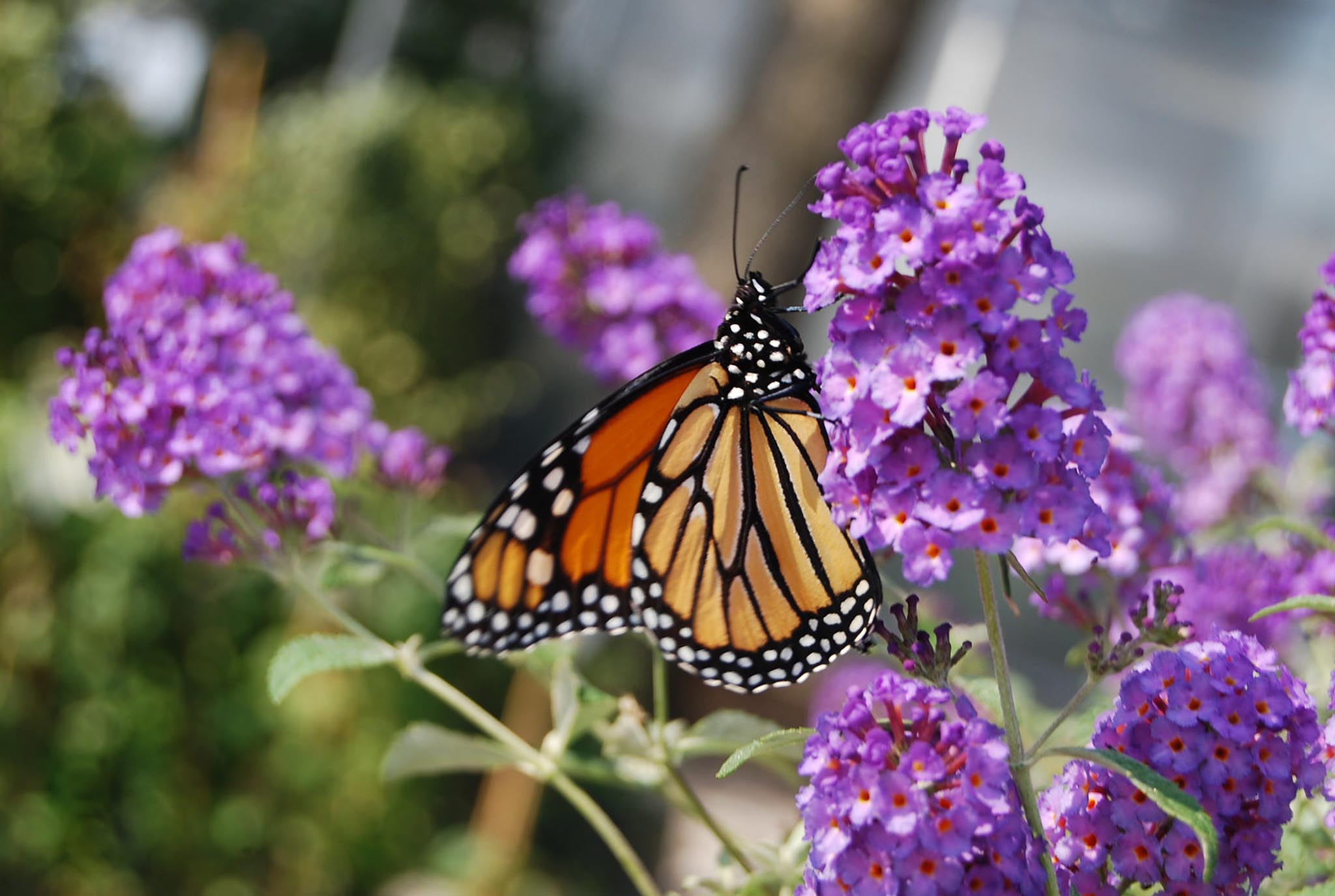
By Paul James
At a press conference in Mexico City last January, scientists cheered when the official eastern monarch butterfly population was announced. And with good reason: The numbers were an impressive 144% increase over the previous year, and the highest recorded since 2006. At the same time, however, it was announced that the California western monarch population had declined by a stunning 86%. So what gives?
Most scientists agree that the increase is likely due to favorable weather conditions during the spring and summer breeding seasons and the fall migration. But they warn that one good year, while worthy of celebration, doesn’t mean the population will continue to rise.
“This reprieve from bad news on monarchs is a thank-you from the butterflies to all the people who planted native milkweeds,” said Tierra Curry, a senior scientist at the Center for Biological Diversity. “But one good weather year won’t save the monarch in the long run, and more protections are needed for this migratory wonder and its summer and winter habitats.”
The population figure of the eastern monarch – the one that travels through Oklahoma – is based on how many acres of trees the overwintering butterflies inhabit in the mountain forests of Mexico. In 2018 that number was 14.9 acres; in 2013 it was a mere 1.7 acres. The target for monarch recovery is a sustained 15 acres, but if the past 20 years is any indicator, that may be an elusive goal at best.
But still, there’s hope. Here in Oklahoma, interest in creating and expanding monarch habitat is at an all-time high. Sales of milkweed have skyrocketed, and more gardeners than ever are focusing on plants that attract adult monarchs as well, who need nectar and pollen to survive. (To learn more about how to help ensure thriving monarch migrations for generations to come, consider joining the Oklahoma Monarch and Pollinator Collaborative. For details, go to www.okiesformonarchs.org.)
And every other state in the monarchs’ migratory pathway is doing likewise. So to the extent that these efforts can offset the damage done by pesticides and habitat loss, I’m hopeful that the recovery seen in 2018 is indeed sustainable. After all, I can’t imagine a world without monarch butterflies, and I’m pretty sure you share my sentiment.
Note: Incidentally, the dramatic decline in California’s monarch population – down from 1.2 million two decades ago to a mere 30,000 now — is being attributed in large part to wildfires and the resulting loss of habitat, but pesticide use remains a problem as well. The current numbers mean that the western monarch butterfly, which overwinters in coastal California rather than central Mexico, is on the verge of extinction.
Leaves of Three, Let it Be!
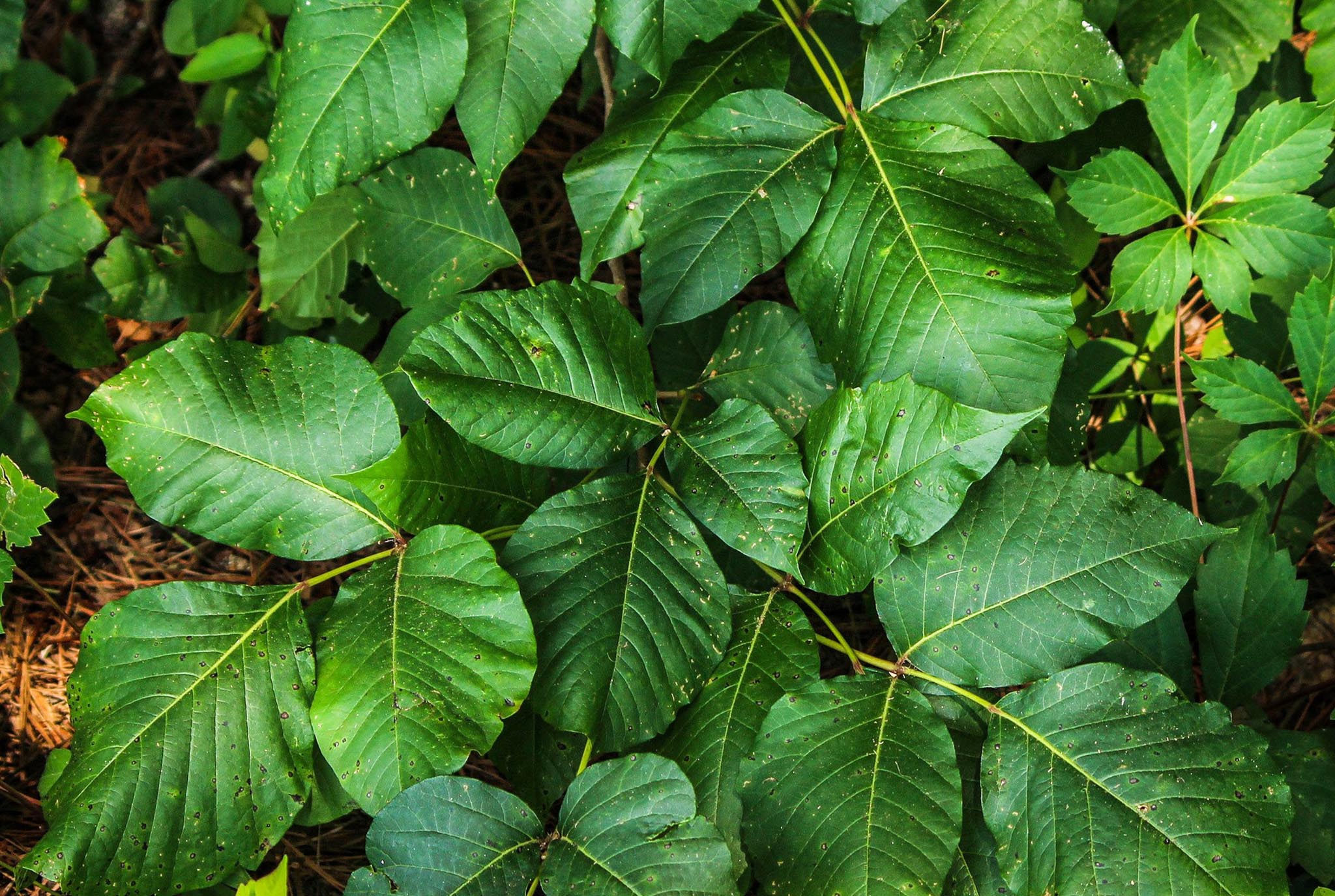
By Paul James
I was hiking with my five-year-old grandson not too long ago, and we came upon a large batch of poison ivy. “Leaves of three, let it be,” I said, to which he replied, “Huh?” I’m pretty sure I had the same puzzled look on my face when my grandfather said the same thing to me 60 years ago. But you’re never too young to learn how to recognize poison ivy, and you’re never too old to learn how to get rid of it.
Oddly enough, poison ivy is related to cashews (I know, that sounds nuts) as well as pistachios, mangos, sumac, and the ornamental smoke tree. It’s a native plant as well, one that grows in every state except California (where they have the dreaded poison oak instead). And although we tend to despise it, poison ivy is important ecologically as a source of food for wildlife. Birds love the fruit it produces, as do deer and mice. And many insects eat the foliage.
About 10 to 15 percent of the human population is immune to poison ivy, or more specifically urushiol, the chemical responsible for giving the rest of us a nasty rash. I know a guy who can sleep in a bed of poison ivy and wake up unfazed. But I’m not that lucky, and chances are neither are you. So when I see poison ivy, all I want to do is get rid of it.
One way to do that is to dig it up, roots and all, but not before donning long pants, a long-sleeved shirt, and gloves, all of which must be washed or tossed immediately after. It’s also a good idea to apply a product called Tecnu (available at drug stores and online) to exposed skin both before and after exposure. And fair warning – if you leave behind one tiny piece of rhizome in the ground, you’ll soon have more poison ivy, which is why you’ll want to dig at least eight-inches deep to get all the roots. When you’re done, bag up the vines and trash them, and wash your tools too.
You can also smother the plants by covering them with cardboard, carpet remnants, or black plastic. It’ll likely take several months to kill the plants outright, but it does tend to minimize your risk of exposure.
Of course, the easiest approach is to rely on an herbicide, preferably one that’s labeled for vines or poison ivy specifically. Most of them contain either glyphosate or triclopyr, both of which are synthetic chemicals. However, there’s an organic alternative called Pulverize Weed, Brush, and Vine Killer that works great as well, although two applications may be necessary to eradicate the vines.
A few things to keep in mind when working around poison ivy: every part of the plant is poisonous; the urushiol is present in the stems even when the plant is dormant; and you can still get a rash long after the plant is dead. Whatever you do, don’t burn the plants because the urushiol can get into your eyes and lungs.
Finally, realize that poison ivy leaves can be dull or shiny, the leaf margins may be smooth or serrated, and the little stems (petioles) that connect the leaves to the main vine may not always be red. In other words, there’s no one poison ivy. In fact, not all species have three leaves. There’s one in Texas that has five leaves, which is no surprise of course, since everything’s bigger in Texas.
Joe Gardener & Me

By Paul James
Late last month, I flew to Atlanta to tape a television show with Joe Lamp’l, host of Growing a Greener World on PBS. In addition to the show, Joe has a huge presence on the web, and his website, joegardener.com, is a treasure trove of excellent information. He also offers online gardening courses, cranks out a regular podcast, and is all over social media. So why did he invite me to be on his show?
Well according to Joe, one of the most frequent questions people ask him when he’s on the road is, “Where in the world is Paul James?” So to let people know that I’m not yet pushing up tulips, I agreed to appear on his program, which was shot over a two-day period at his five-acre property north of Atlanta.
Up to that point, I’d never spent much time with Joe, but I’ve admired his work for years. And I quickly discovered that he’s not only a very kind, generous, and gracious guy – he’s also the real deal. By that I mean he’s a gardener’s gardener (and an organic-gardening purist as well) with an impressive depth of knowledge. For that reason, it made me more than a little proud to hear him say that I had actually inspired him over the years.
I hadn’t taped a 30-minute program since I stopped doing Gardening by the Yard back in 2008, but it didn’t take me long to get up to speed. For one thing, Joe’s small but extremely talented and dedicated crew put me at ease in no time, and his gorgeous garden offered instant inspiration.
We talked at length about all sorts of topics – from gardening to my history with HGTV to my current endeavors – and I have to say I had a blast. That was the first time I’d ever been a guest on someone else’s show, which meant I didn’t have to wear all the hats I once did (writer, producer, director, host). All I had to do was talk, and for me that’s pretty darn easy.
Joe tells me the show will likely air sometime in September or October. I’ll keep you posted. In the meantime, check out what all Joe is up to by clicking these links.
GrowingAGreenerWorld.com
joegardener.com
The joe gardener Show Podcast
Facebook.com/joegardener
facebook.com/GGWTV
twitter.com/joegardener
twitter.com/GGWTV
instagram.com/joegardener

Watering Myths
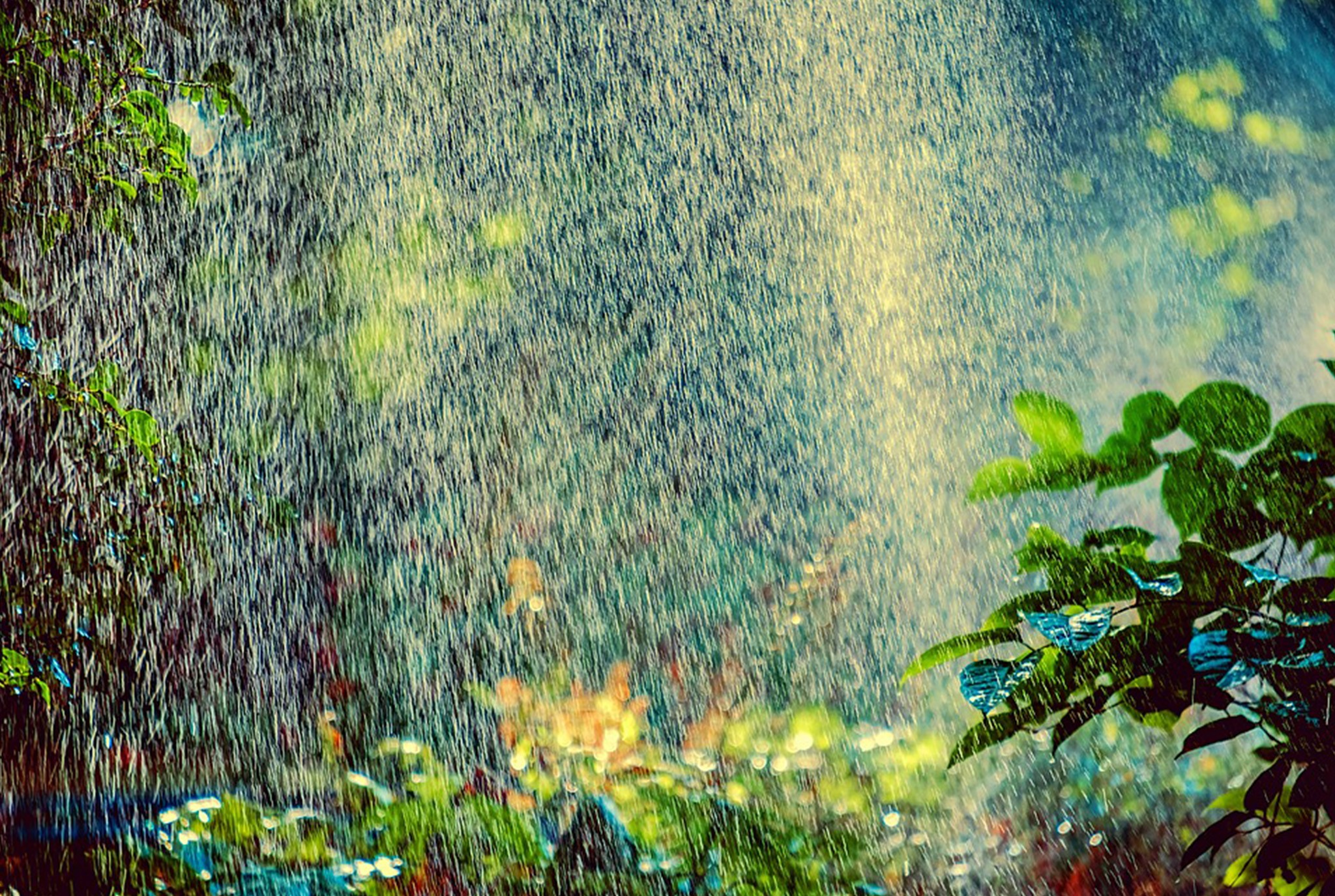
By Paul James
After a week in the mountains around Santa Fe, with lows in the 50s and highs in the 70s, I was less than excited to return home to sweltering heat and humidity. But then it is the middle of July, after all, so I had no reason to be surprised. After unpacking, I headed out to the garden to water, and that got me to thinking about a number of myths I frequently hear about watering. Seven myths to be exact.
MYTH #1: PLANTS REQUIRE ONE INCH OF WATER A WEEK
I’ve never been a fan of this popular recommendation for two reasons. First, how in the world do you know when you’ve delivered an inch of water to plants? And second, it’s just plain bad advice.
Fact is, the moisture needs of plants vary enormously. For example, newly seeded beds, young seedlings, and new transplants need water every day, maybe even twice a day in summer. The same is true of patio pots and hanging baskets (and in my case at least, bonsai).
Newly planted trees and shrubs are sure to die if they receive only an inch of water a week. It’s best to water them with a slow trickle from the hose, moving the hose around the perimeter of the root ball now and then, ideally for about as long as it takes you to casually consume one beer. Or even two. Depending on your soil type, you may need to repeat the process every three or four days.
Mature trees and shrubs, on the other hand, may not need much (if any) supplemental watering even during the summer months. I occasionally water my tree-filled lawn, but in 40 years I’ve never actually watered a mature tree.
And Bermuda grass can get by with as little as an inch of water every four to six weeks. Fescue, however, should be watered every week.
Now in defense of the myth, I suppose that if everything in your landscape is fully established, meaning every plant has been in the ground for at least three years, odds are most everything growing will survive with only an inch of water a week. But I can assure you few things will actually thrive.
MYTH #2: WHEN PLANTS WILT THEY NEED WATER
That certainly can be the case, but wilting may be due to something other than a lack of water. Wilting can also be a sign of overwatering, because water-logged soils can suffocate plants. And even plants that have plenty of moisture available to them can wilt on really hot days, because they tend to lose moisture through their leaves faster than their roots can take it up.
MYTH #3: WATERING ON A SUNNY DAY CAN SCORCH LEAVES
This commonly held notion is ridiculous. Water droplets don’t act as a magnifying glass on plant leaves.
MYTH #4: AUTOMATIC SPRINKLER SYSTEMS ARE THE BEST WAY TO WATER
I would argue the opposite, actually. Not because there are inherent flaws in sprinkler systems, but because at least 75% of the time the systems are set improperly.
The vast majority of sprinkler timers are set by the installer, whose expertise is in irrigation systems, not plants. So the installer sets the timers to run for 10 or 15 minutes in the morning and very often another 10 or 15 minutes in the evening as well. In most cases, and especially if your gardens are well mulched, that’s nowhere near enough time to deliver a sufficient amount of water to the root zones of plants. Instead, it results in water barely percolating into the soil, which means roots hover in that moist, shallow zone rather than reaching farther down into the soil.
I had an irrigation system for 15 years at a previous home, and I never set it to run automatically unless I was on vacation. Instead, I would turn it on manually to water select zones at different times during the week, and I would adjust the run time of each zone depending on what was growing. I suggest you do likewise.
Now I water by hand, which is in my opinion the only way to know with certainty just how much water every plant gets. And as a bonus, it puts me more in touch – and in tune – with my garden.
MYTH #5: OVERHEAD SPRINKLERS ARE BAD
While it’s true that it’s best to water the base of plants rather than the foliage to minimize fungal diseases, there are times when it’s perfectly okay to water plants overhead. As a matter of fact, after prolonged periods of dry, windy days, I prefer to water overhead to knock off all the accumulated dust on leaf surfaces. What’s more, overhead watering helps cool down heat-stressed plants.
MYTH #6: WATER ONLY IN THE MORNING
Sure, it’s best to water in the morning, but not everyone’s schedule allows for what’s best. Basically, you should water whenever you can. And deep soak each time you water.
MYTH #7: DROUGHT-TOLERANT PLANTS DON’T NEED TO BE WATERED
Even cacti and succulents, which are among the most drought-tolerant plants, need water, especially during their first season. Beyond that, they’ll need water less frequently, but they’ll still need to be watered now and then. In my experience, even drought-tolerant plants grow better with a regular supply of moisture.
THE BOTTOM LINE
Ultimately, the only way to know if your plants are getting enough water is to stab a shovel or trowel into the soil, pull it back to reveal the soil profile, and see for yourself just how deep the water is percolating into the soil. It’s not exactly a high tech method, but it is the best method.
Vegetable Origins
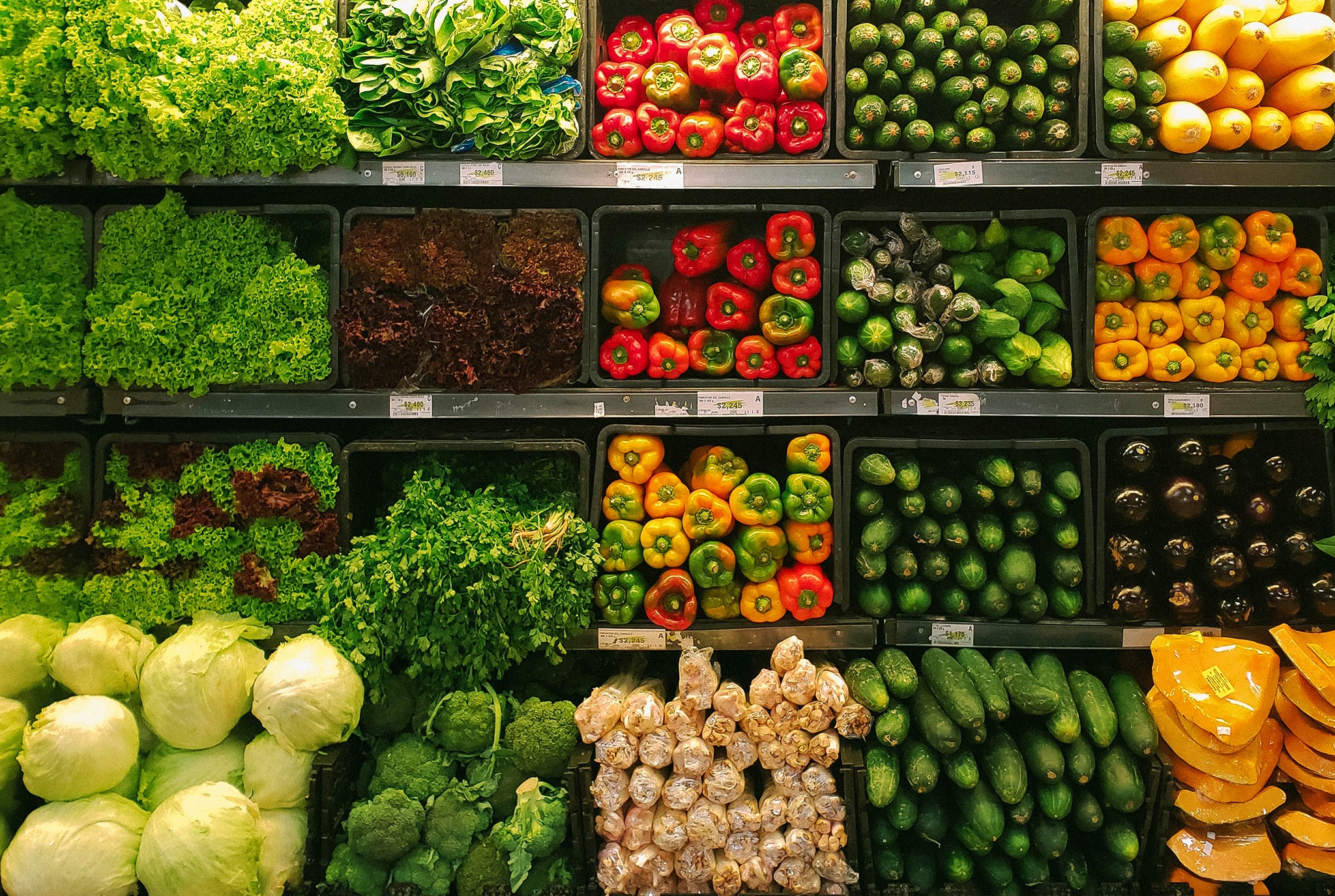
By Paul James
When you sit down to eat, do you ever wonder where the carrots or broccoli or tomatoes on your plate actually came from? Well of course they came from a farm, but that’s not what I’m talking about. I’m talking about where they came from originally and the paths they took to ultimately wind up here. And along the way, who in the world figured out what was edible and what wasn’t?
Ancient hunter-gatherers were the first to experiment with eating plants – leaves, stalks, roots, whatever. It’s certain that not every taste test was successful, and that some were downright fatal. But thankfully, plants that are poisonous typically contain alkaloids that are quite bitter, and that’s one of the ways the hunter-gatherers learned to select what to eat and what not to eat. But still, you gotta wonder how many people croaked when they saw deadly nightshade or water hemlock and thought it might go well with roasted saber-tooth tiger or grilled mastodon.
As for food origins, it turns out we know a great deal about where vegetables came from thanks to ancient texts and archaeological digs. But there’s still a good deal we don’t know.
Take peas, for example. Modern botanists are convinced that peas have their roots in a region extending from the Mediterranean eastward to central Asia. But the only archeological evidence we have of peas is from a cave in Thailand dating back to 9750 B.C. Radishes probably originated just east of the Mediterranean in western Asia, but since so many wild varieties exist even today, it’s hard to pinpoint exactly where they came from originally.
So I’ve chosen to focus on a few vegetables about which we know quite a bit in terms of where they came from and how they got to this country.
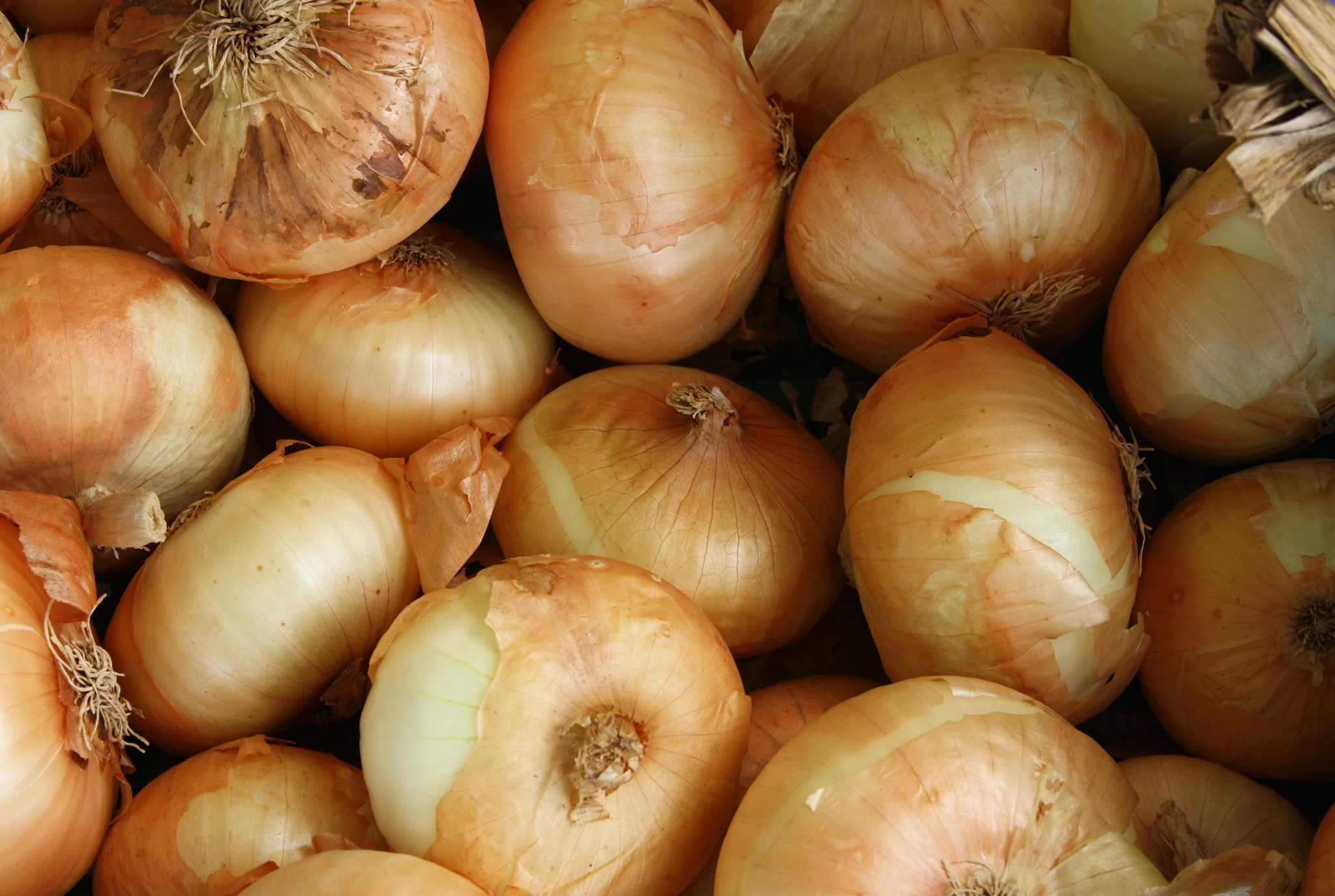
Onion – Allium cepa
Onions are arguably the oldest of the vegetables we eat. The earliest known reference is a Sumerian cuneiform tablet from around 2400 B.C., but they were likely cultivated a century or more before in central Asia.
Onions are immortalized in an inscription at the Great Pyramid at Giza, where laborers were fed onions, radishes, and garlic with every meal. They were also used in the mummification process.
Greeks and Romans also enjoyed onions. In Nero’s Rome, gladiators were massaged with onion juice before entering the arena to keep their bodies firm. And like tomatoes (more on them in a moment), onions were considered powerful aphrodisiacs. A basket of onions was recovered from the ruins of Pompeii in, of all places, the town’s biggest brothel.
By Elizabethan times, onions were being eaten pretty much the world over. They spread rapidly because they kept well in storage.
The domesticated, globe-shaped yellow onions, first cultivated extensively in Spain, came to America on the Mayflower, although wild onions had been growing here long before the settlers arrived. They were an instant hit, however, and were eaten in every way imaginable – roasted, boiled, pickled…even raw. George Washington grew onions, and described them as “the most favored food that grows.”
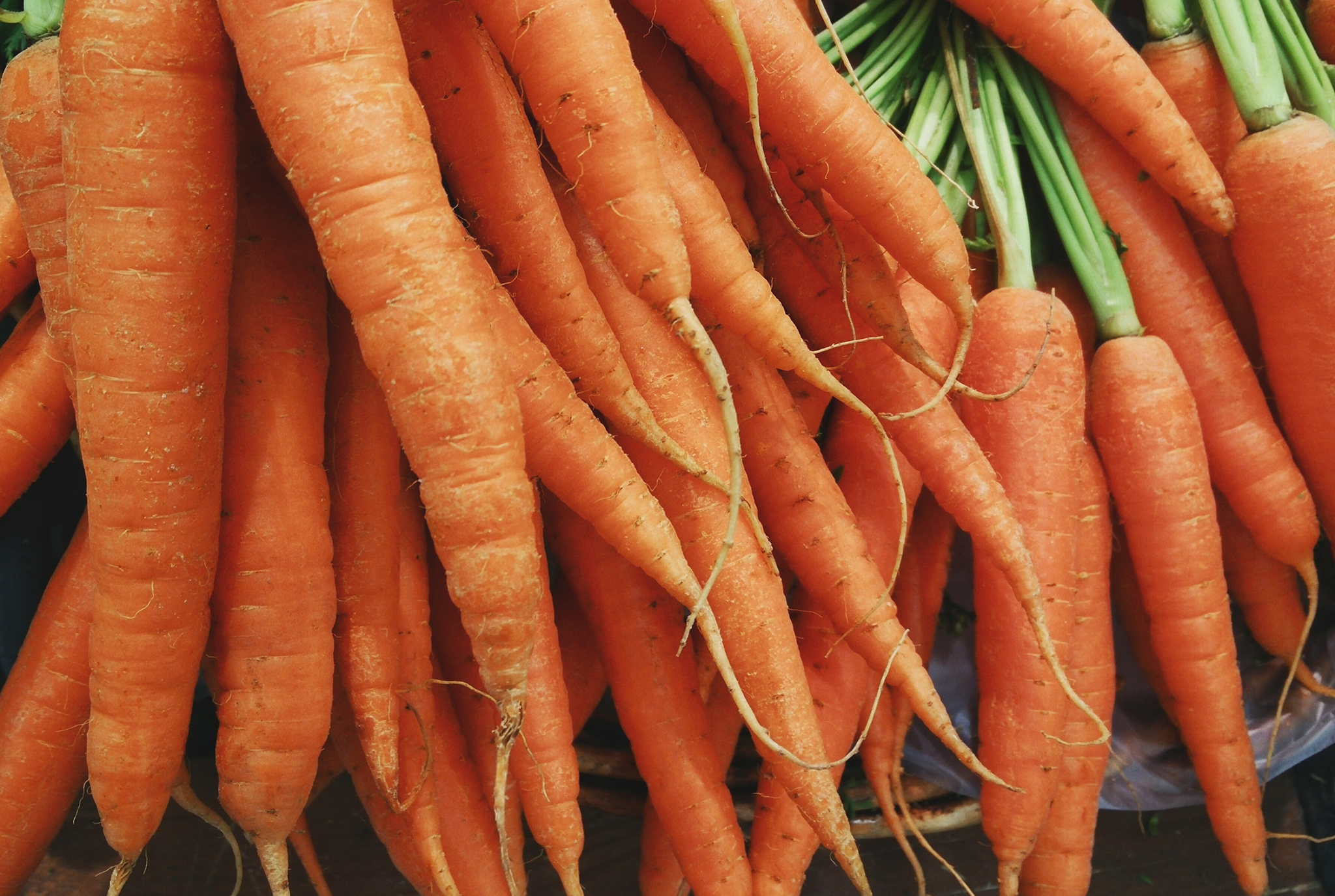
Carrot – Daucus carota
The first carrot wasn’t orange. It was purple. And it was hardly the plump, uniform shape we enjoy today. In fact, carrots were gnarly, misshapen, and scrawny. However, they were edible, and in ancient Afghanistan, home of the original carrot, they provided sustenance.
By the time carrots reached ancient Greece and Rome, and thanks to natural selection, they were larger and fleshier, but they were still highly branched.
The familiar conical root we know today showed up in the 10th or 11th century in Asia Minor, and arrived in Spain in the 12th century by way of the marauding Moors. By that time, thanks to a pigment known as anthocyanin, there were purple, violet, red, and even black carrots. A pale yellow carrot arrived on the scene 400 years later. But even in the 16th century, there were no orange carrots.
Finally, in the 17th century, a Dutch carrot breeder came across an orange carrot, and the orange carrots we eat today are direct descendants of that 400-year-old discovery.
The carrot arrived in North America with the first settlers of Jamestown. It was popular from day one, although so many people planted them in subsequent years that the domesticated carrot escaped into the wild and reverted to its original form – the weed known as Queen Anne’s lace.

Cabbage (Broccoli and Cauliflower)
Cabbage has been around for thousands of years. The Greeks ate lots of it, and the Romans absolutely loved it. To them, it was a vegetable of status. Its original wild ancestor was a seaside dweller, native to the Mediterranean, which over thousands of years would spawn kale, collards, heading cabbage, kohlrabi, broccoli, cauliflower, and Brussels sprouts.
Heading cabbage didn’t arrive on the scene until around the time Julius Caesar invaded Britain. The Brits took a liking to it, and by the 16th century they were growing at least 16 different varieties, both red and green.
Cabbage arrived in the colonies by way of Canada, actually, and the response was enthusiastic. Thomas Jefferson wrote glowingly of his cabbages, especially the Savoy types.
Both broccoli and cauliflower are edible modifications of the cabbage flower, although botanists can’t agree on which came first. We know broccoli was also around in ancient Rome, but it’s hard to say precisely when. Regardless, it wasn’t as popular as cabbage.
Cauliflower, on the other hand, gained wider acceptance from the start, although it’s hard to say when that was either. There are references to it being eaten in 12th century Syria, however. Cauliflower is considered to be the most intellectual of the cabbage relatives, although Mark Twain dismissed it as “nothing more than cabbage with a college education.”

Spinach – Spinacia oleracea
Spinach hails from Asia, closer to Persia than to China. The Persians sent seeds to the emperor of Nepal as a gift in 647 A.D., where it was known as “Persian herb.” In no time at all it was growing all over China. The Chinese loved spinach and planted it along the edges of their rice paddies. But it was another four hundred years before it would arrive in Europe by way of the Moor’s conquest of Spain.
Spinach reached northern Europe in the 16th century, and quickly spread throughout the rest of Europe. Much like children today, people either loved it or hated it. Thankfully, among those who loved it was Catherine de Medici, so much so that the French phrase, a la Florentine, means spinach, in honor of Catherine’s home town of Florence.
Spinach arrived in North America in the early 17th century, but it didn’t catch on all that quickly with colonial gardeners. Then in 1784, David Landreth of the Landreth seed company of Philadelphia – whose customers included George Washington, John Adams, Thomas Jefferson, and James Monroe – developed a slow-bolting spinach called Bloomsdale, which is to this day the go-to spinach of American gardeners.

Tomatoes – Solanum lycopersicum
Given their enormous popularity – not just here in the states but around the world – it’s hard to believe that at one time tomatoes were considered unfit to eat.
The tomato is native to western South America – Chile, Peru, Bolivia, and Ecuador, as well as much of Central America, including Mexico. They still grow in the wild as weedy, aggressive, ground-hugging vines. Invading Spaniards first saw them growing in Montezuma’s gardens in 1519. Cortez arrived back in Spain with seeds, and plants were soon growing all over that country. And interestingly, thanks to generations of natural selection and selective breeding, the fruits were similar to many of today’s heirloom varieties – not round, but ribbed or lobed. They called tomatoes Mala Peruviana, the apple of Peru.
From Spain, the conquering Moors took tomatoes to Morocco, and Italian sailors hauled theirs home to Italy, where tomatoes were well received in some circles but regarded with suspicion by most. They were called pomo doro, or golden apple, which suggests that the most popular tomatoes were yellow. Arriving in France a few years later, they were called pomme d’amour or love apple, largely because they were regarded as sensationally effective aphrodisiacs, and for that reason their popularity began to rise throughout Europe. But tomatoes still got a lot of bad press in Europe, primarily because they were considered poisonous, and in fact the vines are. A clever Italian herbalist in 1544 linked them botanically to deadly nightshade, which is a relative of the tomato. He called them wolf peaches, the Latinized version of which is Lycopersicon, which is essentially the current species name of the tomato.
Ultimately, however, the Italians embraced the tomato, and by the late 1500s chefs and home cooks were perfecting red sauces across the country. The French soon followed the Italian lead, and within 50 years or so no less than Henry VIII was growing tomatoes in his royal garden.
When tomatoes finally arrived in America in the mid-1600s, they were quickly condemned by ministers and physicians. The pilgrims considered them an abomination akin to dancing and card-playing. Thankfully, however, reason triumphed on behalf of the tomato thanks to Thomas Jefferson, who grew tomatoes at his Monticello farm. His own records show that he was especially fond of yellow tomatoes, which he used to make a tasty preserve.
But it wasn’t until 1820 that tomatoes gained broad acceptance in this country. Now think about that for a moment. What is today the most popular vegetable in America has only been consumed on a regular basis for 200 years.
And notice that I’ve referred to the tomato as a vegetable. Well, botanically there’s really no such thing as a vegetable. Technically, the tomato is a fruit, but if you want to get really technical, it’s actually a berry.
Regardless, the tomato is the only vegetable with a legal definition. In the United States, back in 1883, there was a 10-percent tariff on imported vegetables. A guy named John Nix refused to pay the tariff on a boatload of tomatoes from the Caribbean, insisting that they were, botanically speaking, fruits. Ten years later the Supreme Court ruled that while Nix was correct botanically speaking, in the common language of the people the tomato was nevertheless a vegetable, and Nix was ordered to pay the tariff.
Today, there are over 500 tomato cultivars on the market, but sadly, none of them are named Nix.
One more thing: modern linguists insist that the correct pronunciation is indeed to-mah-to, from the Spanish tomate. But we of course say to-may-to, and any way you slice it, at this point it’s too darn late to call the whole thing off.
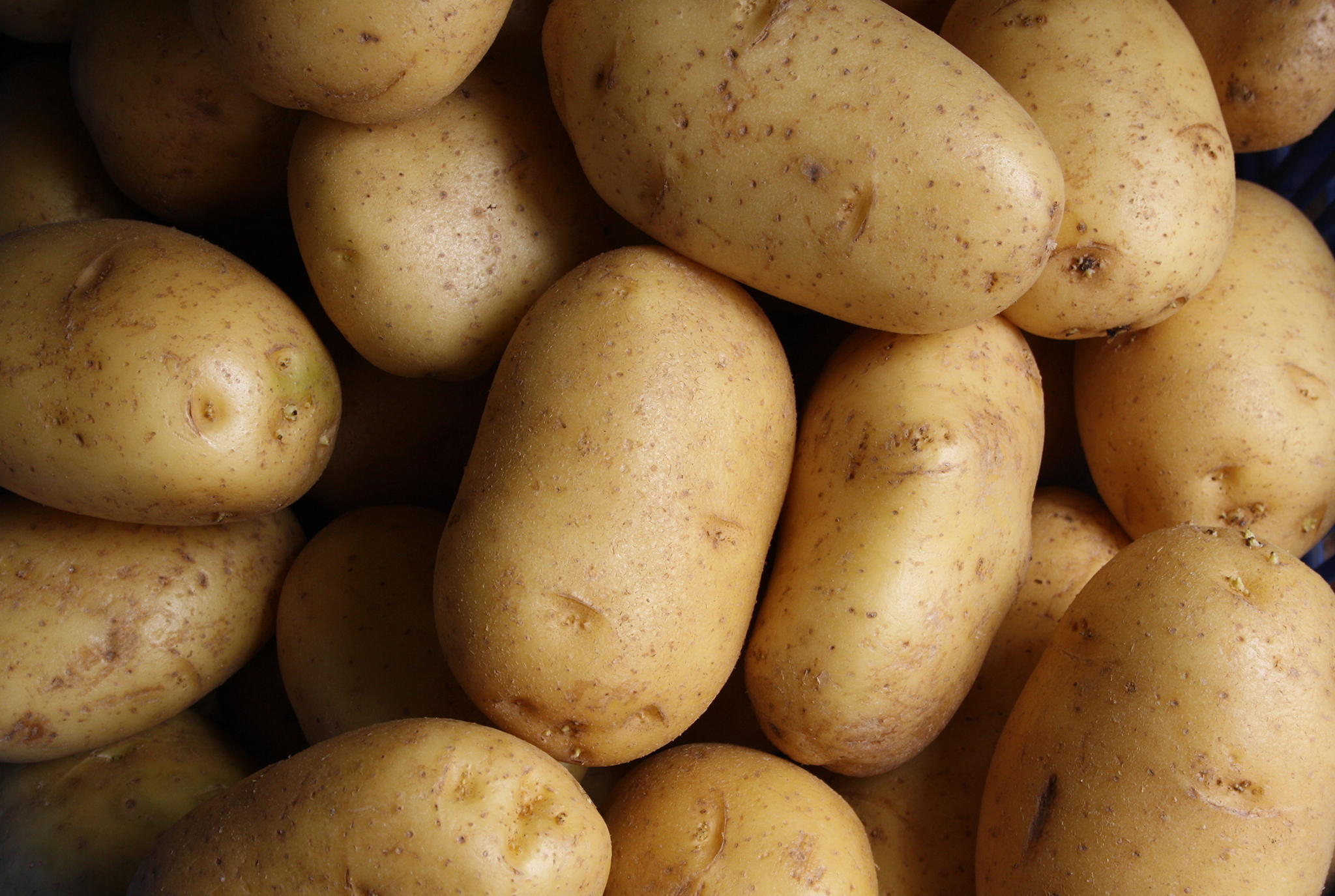
Potatoes – Solanum tuberosum
Native to the Andes of South America, and capable of growing at an elevation of 15,000 feet, the first potatoes were cultivated by Peruvians – Incans, to be exact – over 6,000 years ago. These were small potatoes, ranging in size from a peanut to a plum.
The Spanish explorer Pizzaro came across the potato while pillaging for gold and other treasure in Ecuador back in the 16th century. He took a boatload of the tasty tubers back to Spain, where the harvest was used not for human consumption but rather as cattle fodder. What a shame, huh?
From Spain, potatoes made their way to Italy and France, where they were rejected on the grounds that the knobby tubers resembled the hands and feet of lepers.
The English were introduced to potatoes by way of Sir Francis Drake, who scored a shipment of them in Cartagena, Colombia. Drake gave the potatoes to his buddy Sir Walter Raleigh, who planted them at his estate near Cork, Ireland. Raleigh then gave several potato plants to Queen Elizabeth I, who gave them to her cooks to prepare. Unfortunately, the cooks prepared the poisonous vines of the plant, not the tubers, which gave the queen’s dinner guests a royal stomachache. It would be another two centuries before potatoes caught on in England.
Here in the states – just colonies at the time, actually – potatoes were anything but an instant hit when they arrived in 1622. There are a few obscure references that suggest they were planted in New Hampshire, Connecticut, and Rhode Island a hundred years later, but not in any significant quantities. Basically, the potato was thought of as something you ate when there was nothing else to eat. John Adams described them in a letter to Abigail as “the worst of all vegetables.”
Meanwhile, back in France, there was a turn of events.
In the late 1750s, a French military pharmacist named Antoine Parmentier was captured in Germany during the Seven Years’ War, and while in captivity he subsisted on a diet made up of mostly potatoes. When he finally gained his freedom, he returned to France to sing the praises of potatoes for the next 30 years.
In 1785, he finally achieved his greatest success. On August 23rd of that year, in celebration of King Louis XVI’s 31st birthday, Parmentier presented the King with a bouquet of potato flowers. The King stuck one in his lapel, Marie Antoinette stuck one in her hair, and from that day forward, the potato was formally accepted as a vegetable worthy of kings, queens, and commoners alike.
Meanwhile, back in this country, potatoes were beginning to take off, again thanks to the efforts of Thomas Jefferson, among others. But it was the Irish who were responsible for its meteoric rise in popularity. The Irish Potato Famine of 1846 was responsible for the death of 1.5 million people. It also led to 1.5 million Irish men, women, and children immigrating to the United States. And those immigrants brought with them their love of potatoes. In fact, the Irish also brought with them the word spud, which comes from the Gaelic word spade.
So the next time you sit down to eat carrots or broccoli or tomatoes or whatever – I hope you’ll appreciate the circuitous and fascinating journey those and other vegetables have taken to arrive on your plate.
Shrooms in Bloom!
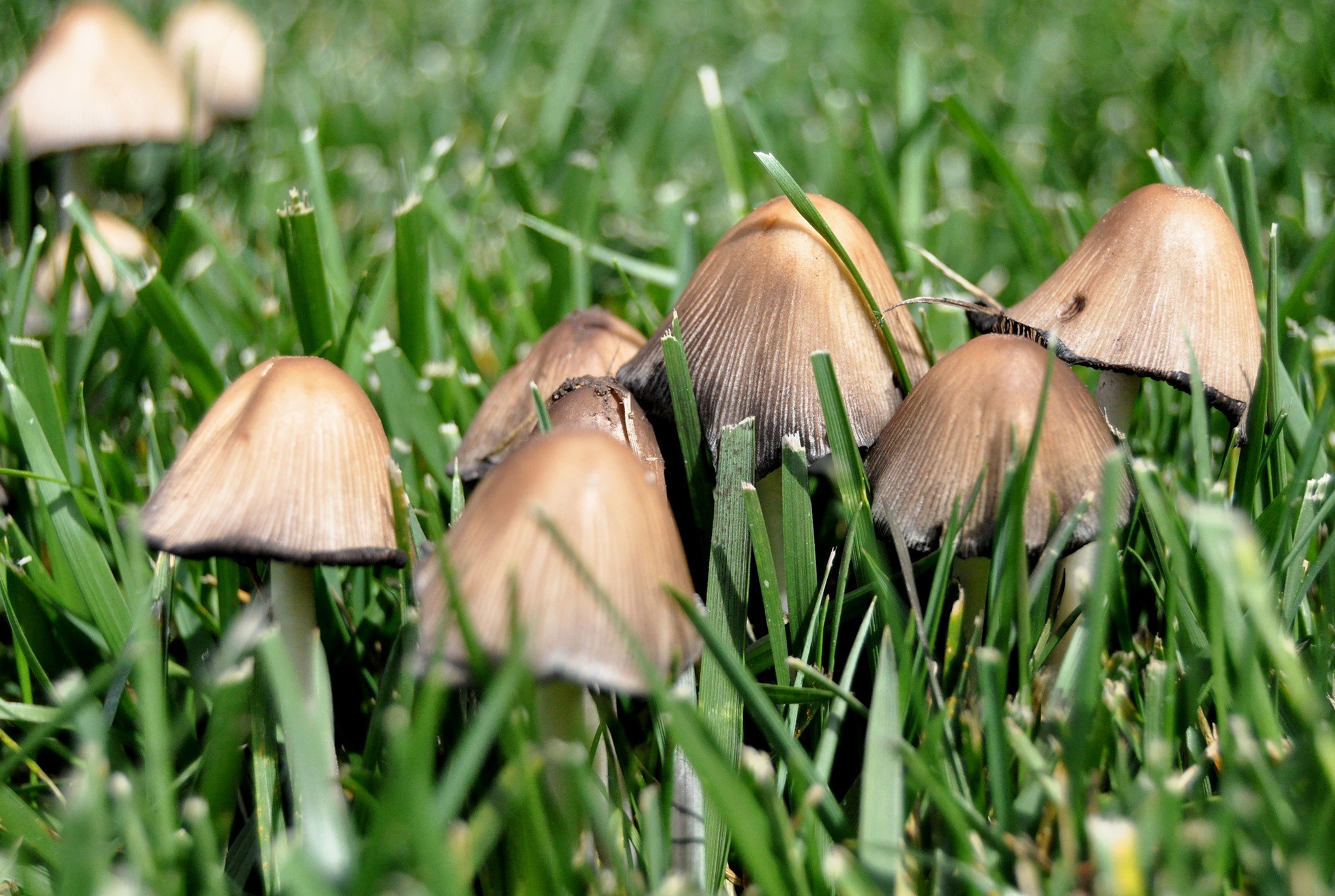
By Paul James
Mushrooms have been popping up in lawns all over town, and their presence causes many a homeowner to panic and wonder how best to destroy them – some sort of fungicidal spray or powder, or perhaps a pitching wedge? Well you might be surprised to learn that my approach to dealing with mushrooms in the lawn is much simpler.
That’s because I do absolutely nothing.
Truth is, I enjoy seeing the fruiting bodies of various fungi aboveground because it tells me that belowground their hyphae and mycelia (fungal roots, if you will) are busy feeding on and helping decompose little chunks of wood, old roots, and other organic matter and turning it into soil. And in the process, they’re releasing nutrients that feed the soil and plants. In other words, they’re part of a healthy soil ecosystem. Besides, fungicides absolutely will not control them, and a pitching wedge will likely do more harm to your grass than a million mushrooms ever could.
The presence of mushrooms in the lawn can tell you something about the condition of your soil, because most mushrooms prefer to grow in soils that don’t drain well. But even in soils that do drain well, excessive rainfall or overwatering can trigger their arrival.
There are a few destructive varieties of mushrooms, notably those that attack oak trees. The culprit is actually related to the shitake mushroom, but sadly once they show up at the base of a tree, there’s nothing that can be done to save it. Fairy ring mushrooms can cause damage to lawns, but if you’ll aerate and fertilize the affected area your turf should bounce back.
And of course there are poisonous mushrooms, though they’re rarely found in the lawn. Still, if you have young children or pets, you might want to remove mushrooms in the lawn just to be on the safe side. (Truth be told, I’ve never actually done what I just said.)
Finally, unless you’re a trained mycologist or experienced amateur, you should never, ever eat wild mushrooms. Again, chances are the mushrooms in your lawn aren’t poisonous, but according to a friend who is a trained mycologist, most of them either have no taste at all or taste awful.
And that’s reason enough not to even think about eating them.
Some Like it Hot!
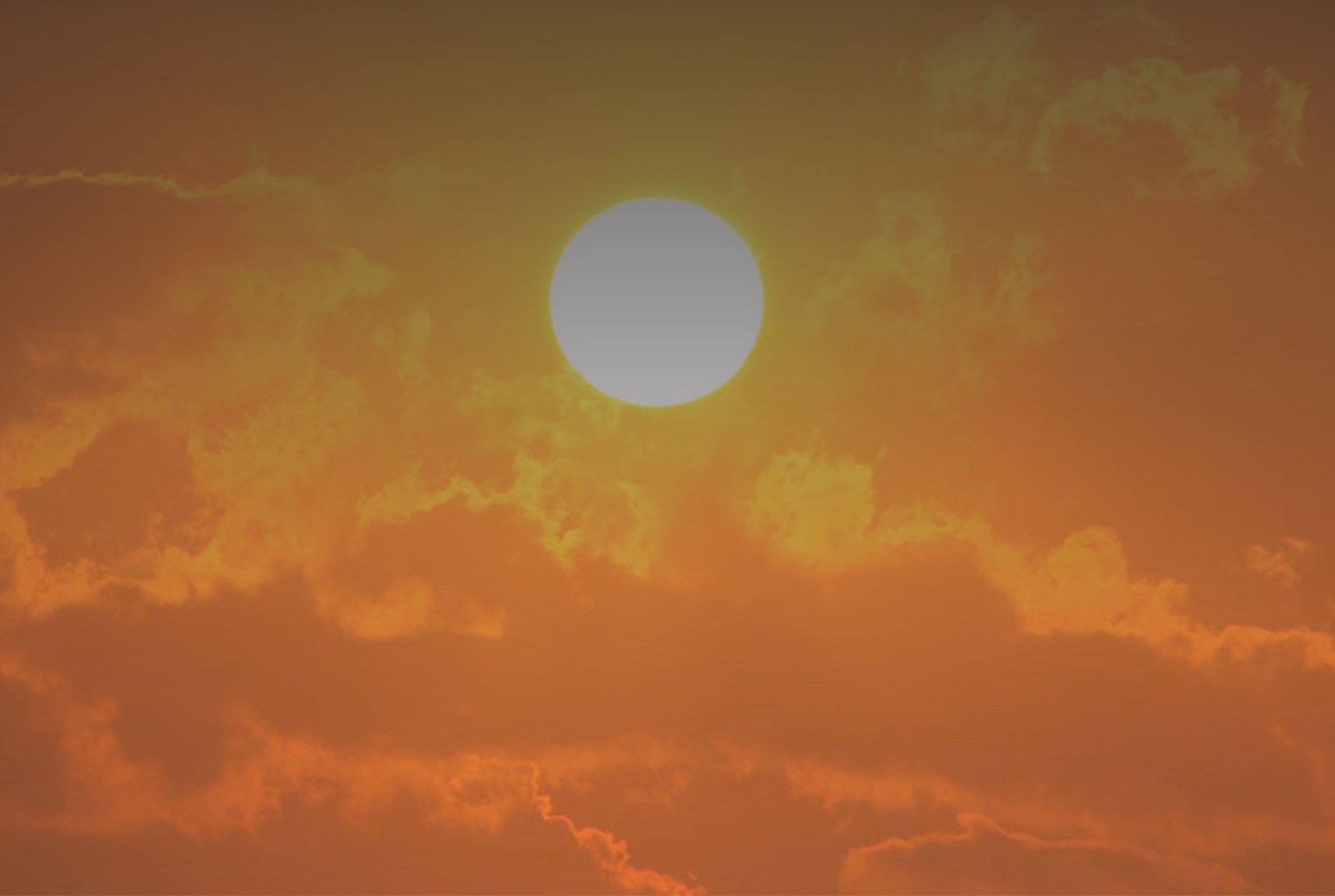
By Paul James
It’s safe to assume that in the weeks ahead, it’s gonna get hotter. Probably a whole lot hotter. And that can take some of the fun out of gardening, which is why I tend to get things done early in the morning. But unlike me, a considerable number of plants truly love the heat of summer, and here are some of the best to consider planting now…or at least early in the morning.
Annuals
Fact is, nearly all popular annuals used for seasonal color do well in the heat — both in the ground and in containers – but the standouts include Angelonia, Crossandra, Dichondra, Lantana, Pentas, Petunias, Portulaca, Scaevola, Sweet Potato Vine, Vinca, and Zinnia. And as luck would have it, many of them combine together beautifully and attract pollinators.
Perennials
This list is even longer, and includes Agastache (Hyssop), Alliums, Armeria, Artemesia, Asclepias (Butterfly Weed), Baptisia, Bee Balm, Coreopsis, Delosperma (Ice Plant), Dianthus, Echinacea (Coneflowers), Gaillardia, Gaura, Iris, Kniphofia (Red Hot Poker), Liriope, Nepeta (Catmint), Ornamental Grasses, Penstemon, Phlox, Rudbeckia (Black-Eyed Susan),Salvia, Sedums, Sempervivums, and Yarrow. And as luck would have it, many of them combine together beautifully, attract pollinators, and last for years.
Trees and Shrubs
In this category, darn near everything qualifies as heat tolerant, but some are exceptionally so, such as Abelia, Althea (Rose of Sharon), Barberry, Crape Myrtle, Desert Willow, Junipers, Oakleaf Hydrangea, Spirea, Viburnum, Vitex (Chaste Tree), Wax Myrtle, and Yucca. Pretty much every popular landscape tree qualifies as well. And as luck would have it, many of them combine together beautifully, attract pollinators, last for years, and are incredibly carefree.
And One More Thing
When I refer to plants as being heat-tolerant, I’m talking only about their ability to withstand the high ambient air temperatures we typically experience in July and August and much of September. I’m not necessarily talking about plants that thrive in full sun, because some of those I’ve included actually grow best with some afternoon shade or dappled light all day. Nor am I suggesting these plants are drought tolerant; in fact, many of them grow best in moist soil, and all of them require routine watering.
But you can plant with confidence anything and everything I’ve listed, knowing that when the intense heat of summer arrives and you’re chilling inside, what’s growing outside will be just fine.
Attack of the Aphids!
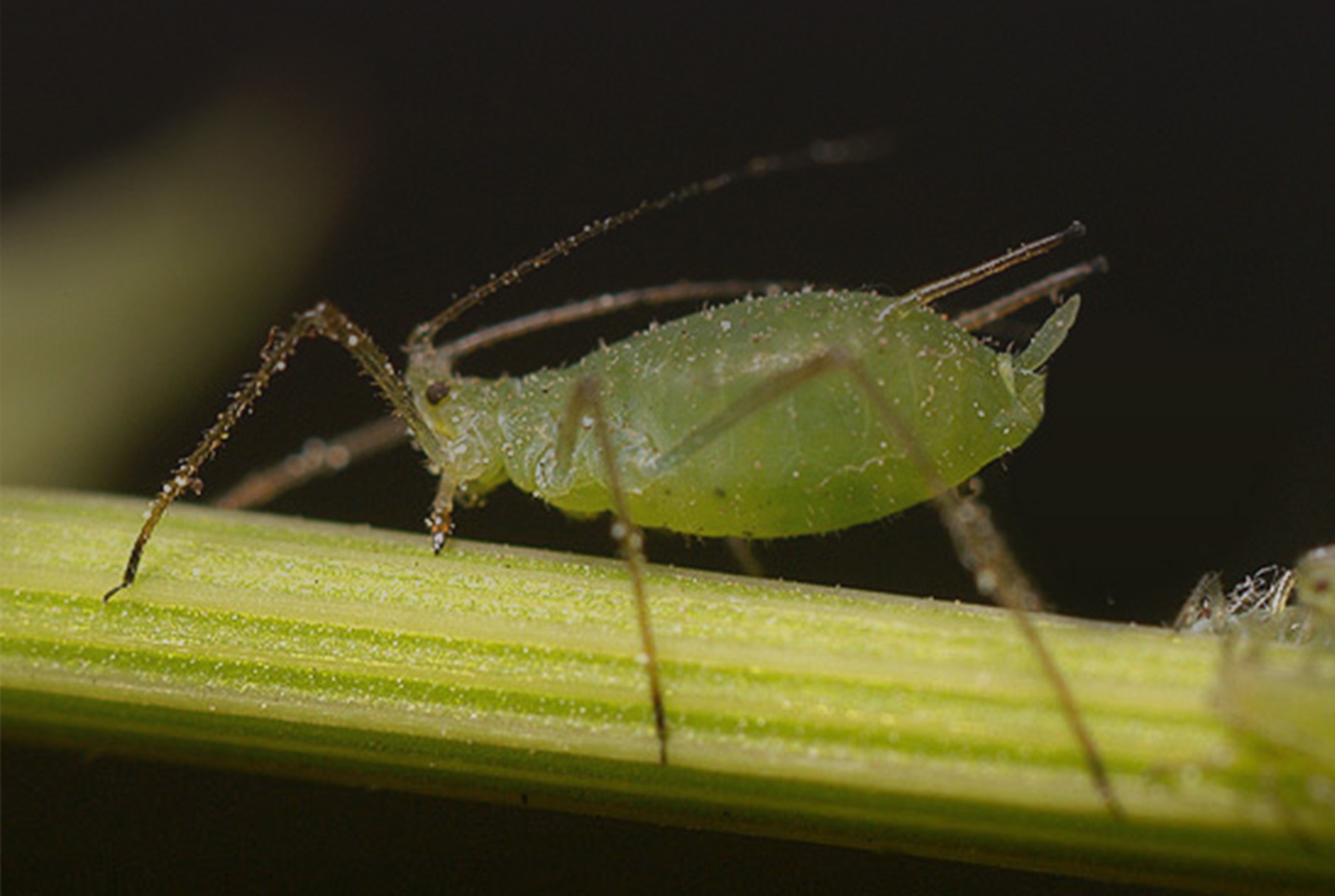
By Paul James
Last Sunday morning I headed out to the garden to harvest potatoes, and as I walked past my tomato plants I noticed that they were covered with aphids. Rest assured, I didn’t waste time dealing with them, because aphids can do serious damage by sucking the sap (and the life) out of plants, and they can spread nasty diseases in the process. Worse still, they reproduce at a rate – and in a fashion – that’s truly mind blowing.
Consider this: Although aphids only live a month or so, a single female can potentially produce 600 billion descendents! That’s reason enough to declare war on them at first sight, because they survive – and thrive – by the sheer force of their numbers. It’s also why it’s often said that if aphids are good at one thing, it’s reproducing.
But it’s how they reproduce that’s so fascinating, because it almost always takes place without a male mate. In biology, this reproductive method is known as parthenogenesis (meaning virgin birth), and it’s a form of asexual reproduction that’s pretty bizarre, yet very beneficial if you’re an aphid.
Here’s how it works. Female aphids produce live offspring (again, without a mate) by basically cloning themselves. That’s kind of weird, I’ll admit. But it gets weirder, because each of the female’s offspring is born pregnant! And that’s precisely how they reproduce throughout most of the spring, summer, and early fall. So by skipping the time required for an egg to hatch and develop into a sexually (or asexually) mature female, their numbers increase at an astounding rate. They also don’t waste going out on potentially awkward dinner dates.
In fact, the only time female aphids take on a male partner is in the fall. And where do the males come from? Turns out a switch turns on late in the year that enables the females to produce a few male offspring. At that point, aphids reproduce sexually (way to go, guys!) so that the females can produce eggs that are capable of surviving the winter. And guess what? The eggs that hatch the following spring are 100% female, meaning a male aphid can’t produce sons. It’s crazy, right?
So much for the sex life (or non-sex life) of aphids. The big question now is, How in the world do you control them?
And thankfully, that’s fairly simple if you get a jump on things. Releasing ladybeetles will help, but one ladybeetle can only eat about 60 aphids a day, and I’m guessing there were at least a few thousand aphids on my tomatoes. That’s why I opted to use insecticidal soap, although I might just as well have used horticultural oil or Neem oil. I sprayed the plants thoroughly, especially the undersides of the leaves where most bugs tend to hide, and later that day the aphids were dead.
But one thing’s for certain – they’ll be back. If not on my tomatoes, then on something else in my garden. After all, there are at least 250 species of aphids that prey on plants.
Here Come the Skeeters!

By Paul James
Last week I wrote about the need to fertilize plants because all the rain we’ve had lately has leached valuable nutrients out of the soil. This week I’ve got another rain-related issue to discuss, one that poses a serious risk to people, not plants. And that’s mosquitoes, the deadliest animal on the planet.
(I first posted this back in May of 2017, but the information is still solid…and timely.)
A small percentage of people on the planet don’t get mosquito bites. I’m one of them. My daughter in law and granddaughter, on the other hand, can be sitting right next to me on the patio and get two dozen bites in five minutes. So what gives? And what can they do to protect themselves?
First, the what gives. Turns out mosquitoes don’t like the way I smell, and according to microbiologists who study such things, that’s due to a particular scent emitted by the trillion or so bacteria that inhabit my skin. (And for the record, most people think I smell just fine, thank you.)
But the bacteria that live on my daughter’s and granddaughter’s skin emit an odor that’s apparently and unfortunately attractive to mosquitoes, which explains why they’re both basically mosquito magnets. And by the way, there’s nothing they can do to change that.
Now let’s talk protection. First and foremost, you have to eliminate the habitat mosquitoes love, and that’s standing water – in plant saucers, in wheelbarrows, in clogged or sagging gutters, in kiddy pools – anywhere and everywhere water remains for more than a few hours. And you’ve got to encourage your neighbors to do likewise, because mosquitoes can and most likely will travel from their yard to yours.
Bt dunks, donuts, or granules should be used in birdbaths, water features, holes in trees where water collects, and anywhere else standing water can’t be eliminated. The particular type of Bt (Bacillus thuringiensis israelensis) used to control mosquitoes is an all-natural biological control that targets only mosquito larvae. It’s extremely effective and safe to use around people and pets.
Beyond that, you need to rely on repellents, of which there are many. When trying to control mosquitoes on the patio, options include citronella candles (which may also contain rosemary, thyme, and other oils), incense sticks that also contain those and other oils, and various sprays. Deet is still the most effective spray, but a lot of folks think it’s harmful, despite considerable research to the contrary. Picaridin, an alternative to Deet that was developed in Australia, has for decades been used there and throughout Europe with no reported health risks. Plants such as citronella and lemon grass, despite what you may have heard or read, simply do not work unless you crush the leaves and rub them on your skin. However, a powerful fan will work because mosquitoes can’t fly in winds above 7mph.
For broader control, there are also repellents that contain various natural oils, are pleasantly scented, and can be applied as granules or sprays to the entire yard. Many of them last for up to three weeks depending on rainfall. And there are chemical foggers, including automated systems that spray chemicals in the air at preset intervals. I’m not too keen on having chemicals in the air while I’m hanging out in the yard, but then I’m the guy who doesn’t attract mosquitoes.
As for installing bat and purple martin houses, research makes it clear that while both critters do indeed eat mosquitoes, neither can eat enough in a day to make a noticeable dent in the population. After all, even though female mosquitoes generally don’t live longer than a week, they lay up to 300 eggs a day.
And finally, there’s one sure way to actually attract mosquitoes, and that’s to drink a beer. Mosquitoes are attracted to carbon dioxide, and there’s plenty of that in the beer and the belches that invariably follow.
It’s Time to Fertilize!
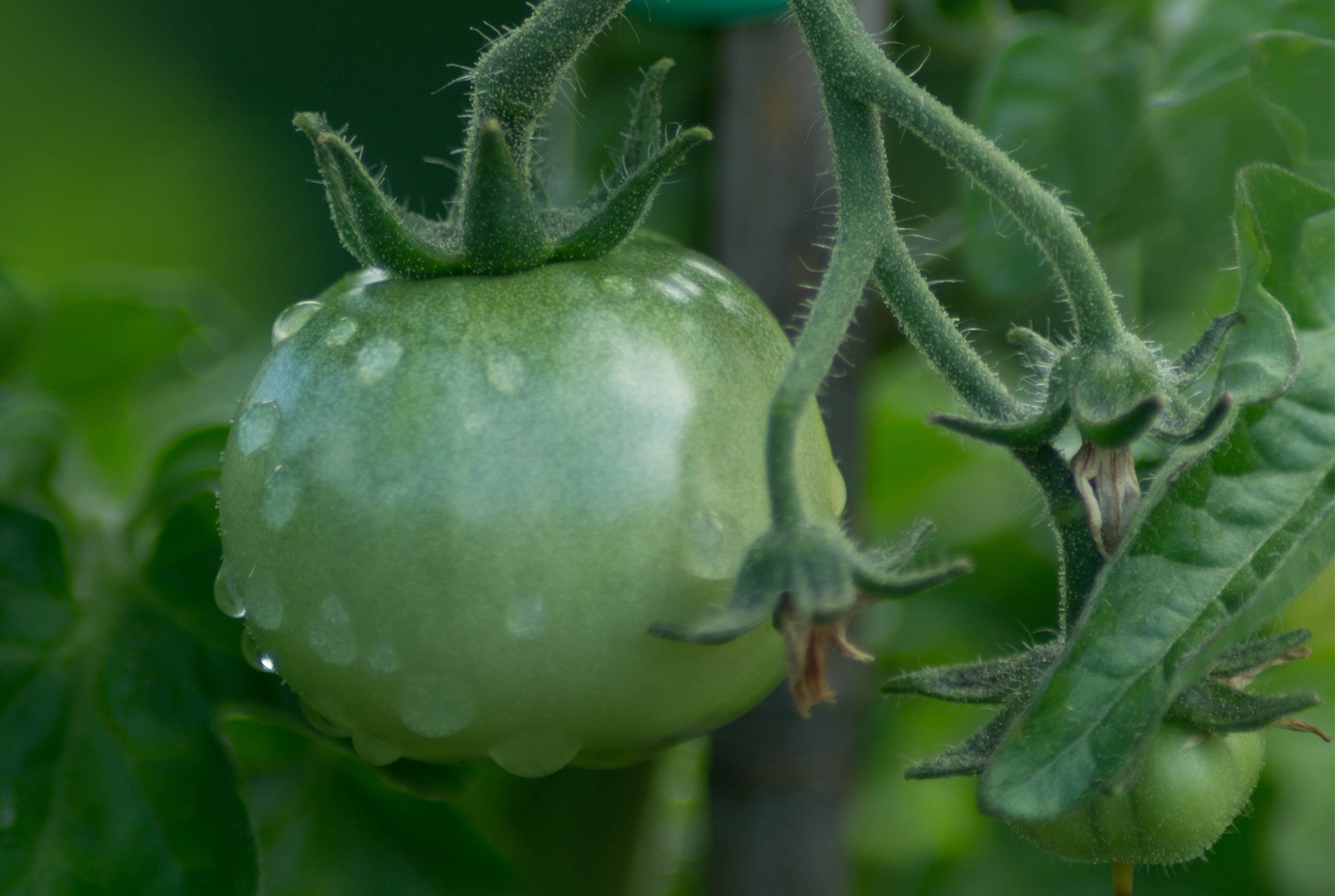
By Paul James
The relentless storms have taken their toll on area gardens, and while much of the damage is visible – flooding, downed trees, and so on – it’s what you can’t see that concerns me, and that’s the leaching of nutrients through the soil as a result of torrential and incessant rains.
Leaching occurs when water moves down through the soil and carries with it many of the nutrients that plants need to survive. And given all the rain we’ve had lately, it’s a safe bet that whatever the nutrient levels were in your soil at the beginning of May, they’re a tiny fraction of that now. That’s especially true of nitrogen and sulfur, but my guess is several micro- and secondary-nutrient levels have dropped as well, perhaps even significantly in some cases.
And that’s why you need to fertilize. I strongly recommend the use of slow-release fertilizers because they’re not particularly water soluble. As a result, they release their nutrients slowly over time. Most slow-release fertilizers are also all-natural or organic – Milorganite is a good example, as are various products made by Espoma – but there’s also Osmocote, a synthetic fertilizer that’s coated with a material that dissolves slowly and releases nutrients over a period of months. And don’t forget good old compost, whether homemade or store bought.
And just when should you fertilize? Well, now would be a good time.
Enough Already!
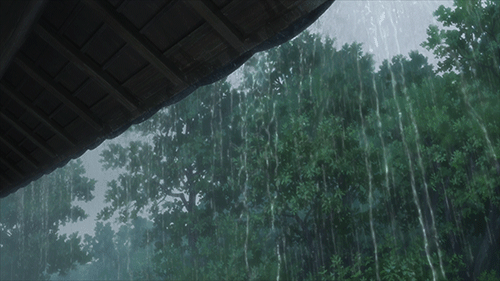
By Paul James
I love rain, especially when it follows a long day of planting or starts right after I’ve finished mowing the lawn. But too much of a good thing is rarely a good thing, and too much rain can wreak havoc in the garden, often in some rather unsuspected ways.
Perhaps the biggest problem is that too much rain can actually drown plants, because all that water in the soil fills spaces that would otherwise contain oxygen. When that happens, plants aren’t able to respire (or breathe, if you will) and therefore suffocate. Carbon dioxide and ethylene gases can also accumulate, both of which can be toxic to plants.
Symptoms of waterlogged soils include plant leaves turning yellow or brown or wilting suddenly. Die back of new shoots is also fairly common. And unfortunately, short of waiting for the soil to dry out, there’s not a lot you can do to reverse the situation. Pulling back the mulch from around plants (or the entire garden) will facilitate drying somewhat, as will stabbing a garden fork in the soil, which also allows oxygen to reach into the soil.
Too much rain can also leach essential nutrients out of the soil, especially nitrogen, so once the soil dries out a bit, consider applying a fertilizer such as Espoma Plant-Tone, Milorganite, or Osmocote, or simply topdress plants with compost.
Dirt and mud that splash onto leaves and stems may – and often do — harbor fungal spores, which is why it’s a good (if not counterintuitive) idea to wash the entire plant with a gentle mist. And on plants that are susceptible to fungal diseases – tomatoes in particular – you might want to apply a fungicide such as all-natural Serenade as a preventive measure.
But be careful where you walk! Your weight – regardless what it is – can cause severe compaction in wet soils, and compaction is the enemy of plants. If you have to work in the garden, place a board on the ground first and walk on it to minimize compaction. Walking in wet soil can also hasten the spread of fungal diseases, especially on beans.
Pollination can also be affected by heavy rains, in part because pollinators have a tough time flying in the rain, but also because heavy, wet pollen simply isn’t as effective at doing its thing. There’s not much you can do to remedy the problem short of waiting for the weather to change.
And finally, we’ve all been frustrated during those times when frequent rains make it impossible to get out and mow the lawn, and by the time it’s dry enough to mow the grass is overgrown. About the only way around the problem is to double cut: raise the deck to its highest notch, mow, then drop the deck height to your preferred level and mow again.
So there you have what you need to know about dealing with too much rain in the garden. Now I’m going to write a piece for the coming months on how to deal with drought.
Here Come the Hummers!
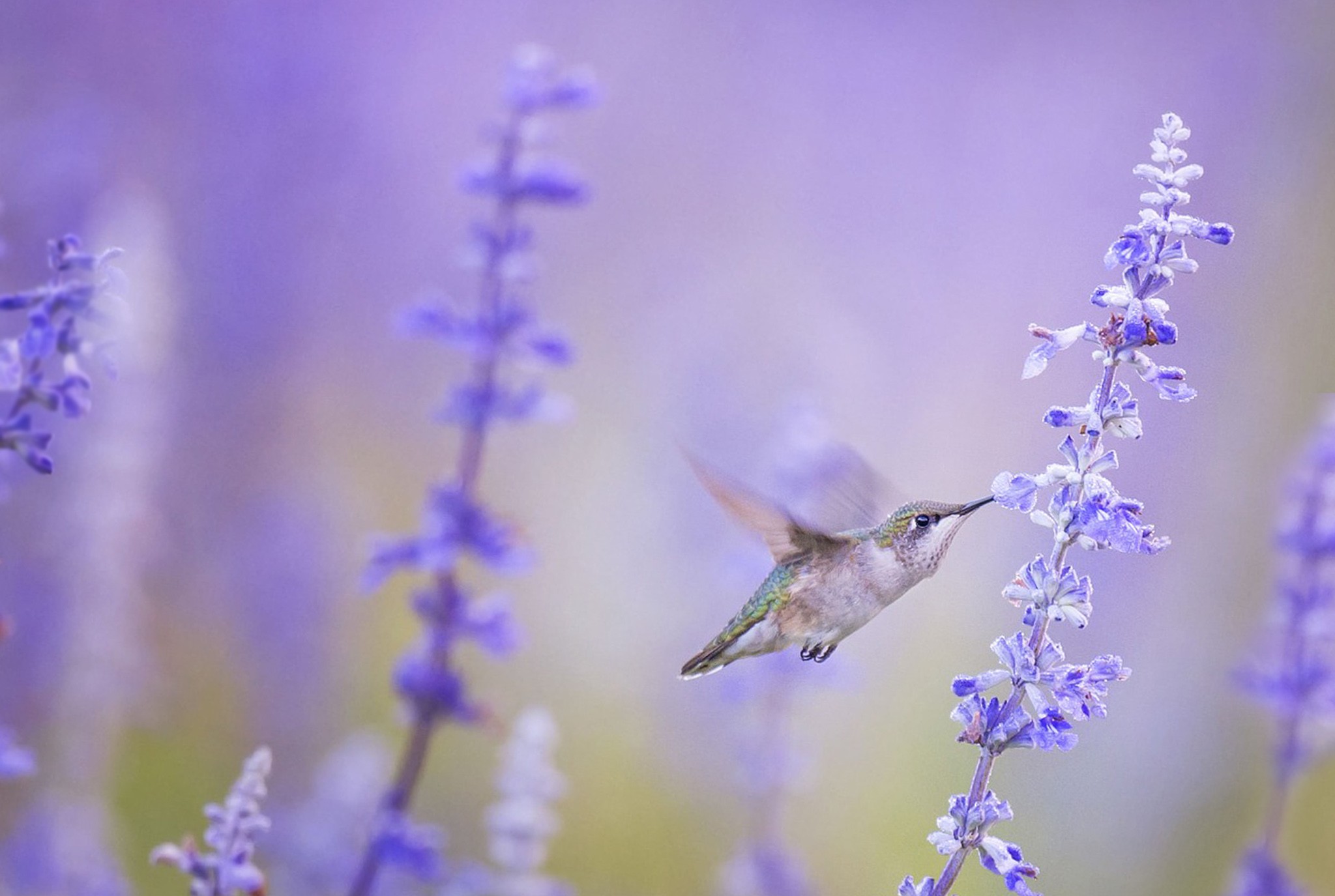
By Paul James
I saw my first hummingbird of the season last Monday, and it prompted me to think not only about cleaning and setting out my feeders, but also adding a few more Hummer-friendly plants in my landscape. And for those of you who are considering doing the same thing, here’s a list of plants preferred by 10 out of 10 hummingbirds.
One of the great things about this list is that not every plant blooms at the same time, which means Hummers will be hanging out in your yard for several months to come. And that’s important, because to sustain their supercharged metabolisms, they must eat once every 10 to 15 minutes and visit between 1,000 and 2,000 flowers a day!
And I thought I was a glutton.
What’s up with pH?

By Paul James
At some point, all gardeners hear the term pH, perhaps most frequently when they’re trying to change the color of their hydrangeas from pink to blue or vice versa, because the only way to do that is by changing the pH of the soil. But what the heck is pH, anyway?
Without getting too technical, pH refers to the relative acidity or alkalinity of a substance and is measured on a scale of 0 to 14. Anything with a pH less than 7.0 is considered acidic, whereas anything with a pH above 7.0 is considered alkaline, and a substance with a pH of 7.0 is considered neutral. To understand the scale in more familiar terms, here are the pH values of some common household items.

The ideal soil pH for the vast majority of plants is close to or just below neutral, with 6.5 to 6.8 being the sweet spot. Exceptions include so-called acid-loving plants such as pin oaks, azaleas, blueberries, and gardenias, all of which prefer a pH of slightly above or below 5.0. There are also plants that do well in alkaline soils, including burr oak, barberry, Spirea, junipers, Viburnums, yews, geraniums, yarrow, daylilies, and honeysuckle, just to name a few.
If a plant isn’t growing in a soil with the ideal pH, its roots may not be able to take up important nutrients, even if the soil is loaded with nutrients, and that can lead to everything from a lack of vigor to discoloring of leaves to the outright death of the plant. A pH that is either too low or too high can also cause a toxic buildup of certain elements, including manganese in low pH soils and aluminum in high pH soils.
Thankfully, raising or lowering pH is pretty simple. To make soils more acidic (to lower the pH) you add sulfur, and to make soils more alkaline (to raise the pH) you add limestone, preferably in the form of dolomitic limestone. Neither is soluble in water, so it’ll take at least a couple of weeks for them to have an effect on your soil’s pH.
And just how do you determine the pH of your soil? The most accurate test is one done by a lab, which technicians at OSU will perform for $10. You’ll also get measurements of the amount of nitrogen, phosphorous, and potassium in your soil. Just take a soil sample to a county extension office and they’ll mail it to the lab. (Click here to learn how to properly prepare a sample.) You can also buy inexpensive kits, which are nowhere near as accurate, but will at least let you know if you soil is within an acceptable range.
I suppose I could have started this blog by explaining that pH is the negative of the base 10 logarithm of the hydrogen ion activity at 25-degrees Celsius and measured in moles per liter. But then, I actually wanted you to read beyond the first paragraph.
And by the way, to change the color of your hydrangea flowers from pink to blue, you need to acidify the soil. To change them from blue to pink, you need to make the soil more alkaline. If you prefer a mix of pink and blue, shoot for a neutral pH.
Caring for Azaleas
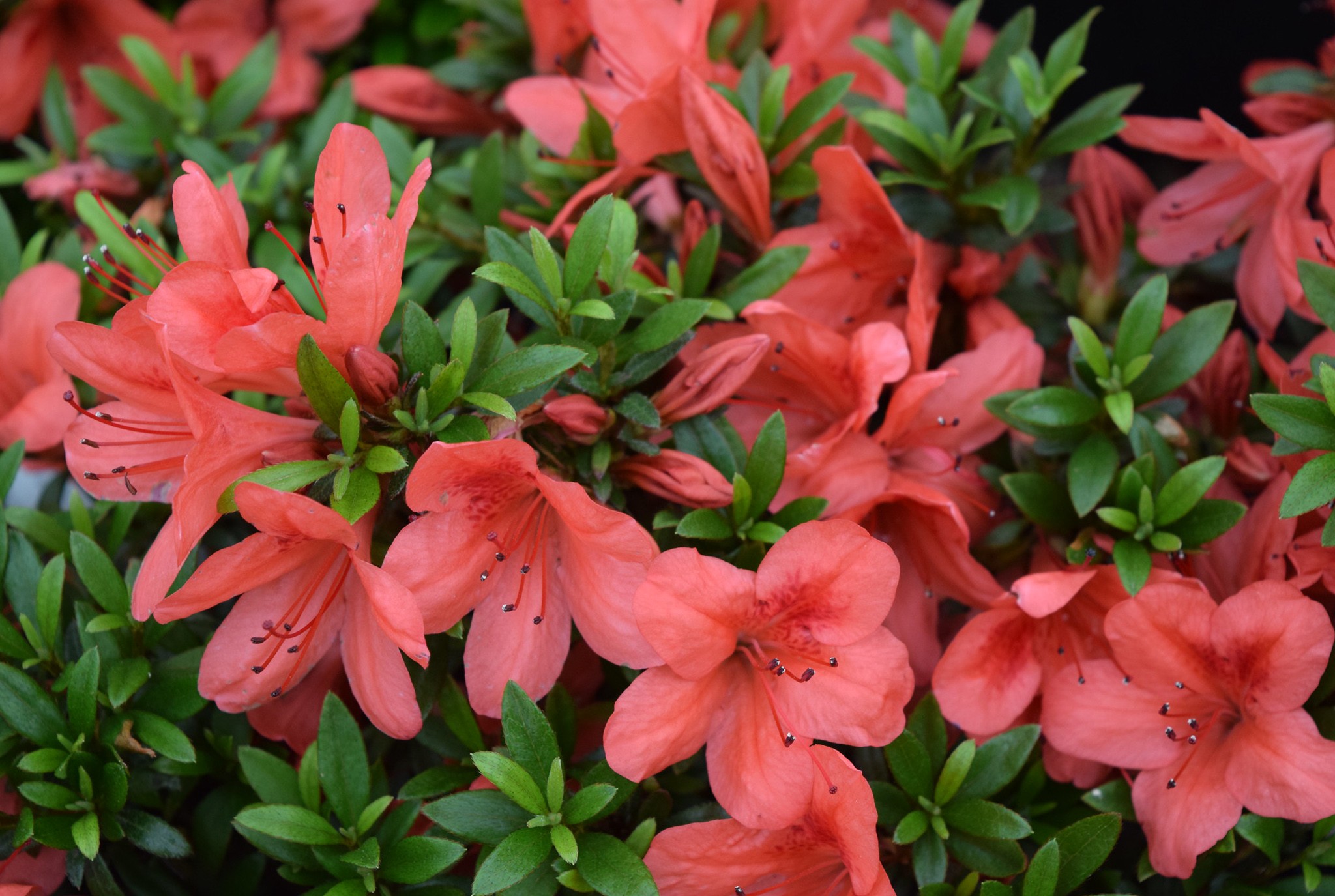
By Paul James
The azalea show this spring has been nothing short of spectacular, thanks to near-perfect weather conditions. But as the flowers begin to fade, it’s time to take care of the plants’ nutrient needs, as well as things such as pruning, watering, and monitoring the plants for signs of insect invasion.
And by the way, the following suggestions apply both to traditional and to repeat-blooming azaleas. In other words, treat the latter as if they were the former.
Fertilizing and Pruning
Blooming zaps a lot of energy out of a plant, and azaleas are no exception. That’s why it’s best to fertilize them after they bloom. Products that combine essential nutrients with soil acidifiers to lower the pH are ideal, and one of the best is Espoma Holly-Tone. A dose of iron is a good idea too, especially if you notice the leaves turning yellow.
You should also prune right after flowering in spring, although the fact is azaleas rarely need pruning beyond removing deadwood and crossing branches.
Pest Problems
Shortly after the bloom period, be on the lookout for lace bugs, little critters that hide under the leaves. They can be a major pest, but thankfully they’re also fairly easy to control.
Lace bugs overwinter as eggs. Adult females insert their eggs into the leaf tissue and then cover them a dark splotch of a varnish-like material that seals the egg into the leaf. This, along with their shiny black droppings gives the underside of the leaves a “fly-specked” appearance. There can be more than one generation a year in Oklahoma.
To control lace bugs, thoroughly spray leaf surfaces (upper and especially lower) with insecticidal soap, horticultural oil, Neem, or a product that contains Spinosad, such as Captain Jack’s Dead Bug Brew. All are all-natural products, but they should be sprayed after sunset to avoid harming honeybees and other beneficial insects.
Mites
Spider mites are not insects, but are more closely related to spiders. They’re typically found on the underside of leaves as well. The most common type in this area is the red spider mite, and like the lace bugs, spider mites suck plant sap and cause the leaves to change color from bright to dull green, and with a heavy infestation, leaves may turn gray-green or bronze-green. Leaves may also be covered with webbing. Control them using the same products recommended for lace bugs.
Mulch
Because they are shallow rooted, azaleas benefit greatly from a thick layer of mulch, whether chipped or shredded wood products, or pine straw. Maintain a two- to four-inch layer. Replenish each spring and fall.
Water
One inch of water per week should be enough to keep azaleas healthy. Watch for signs of dryness with newly planted azaleas, especially if they were planted high or located in a windy area. Drooping leaves indicate the need for supplemental watering well before the plant dries out completely. Water slowly and deeply to ensure the rootball gets plenty of moisture and the plant should rebound quickly.
In Praise of Japanese Maples
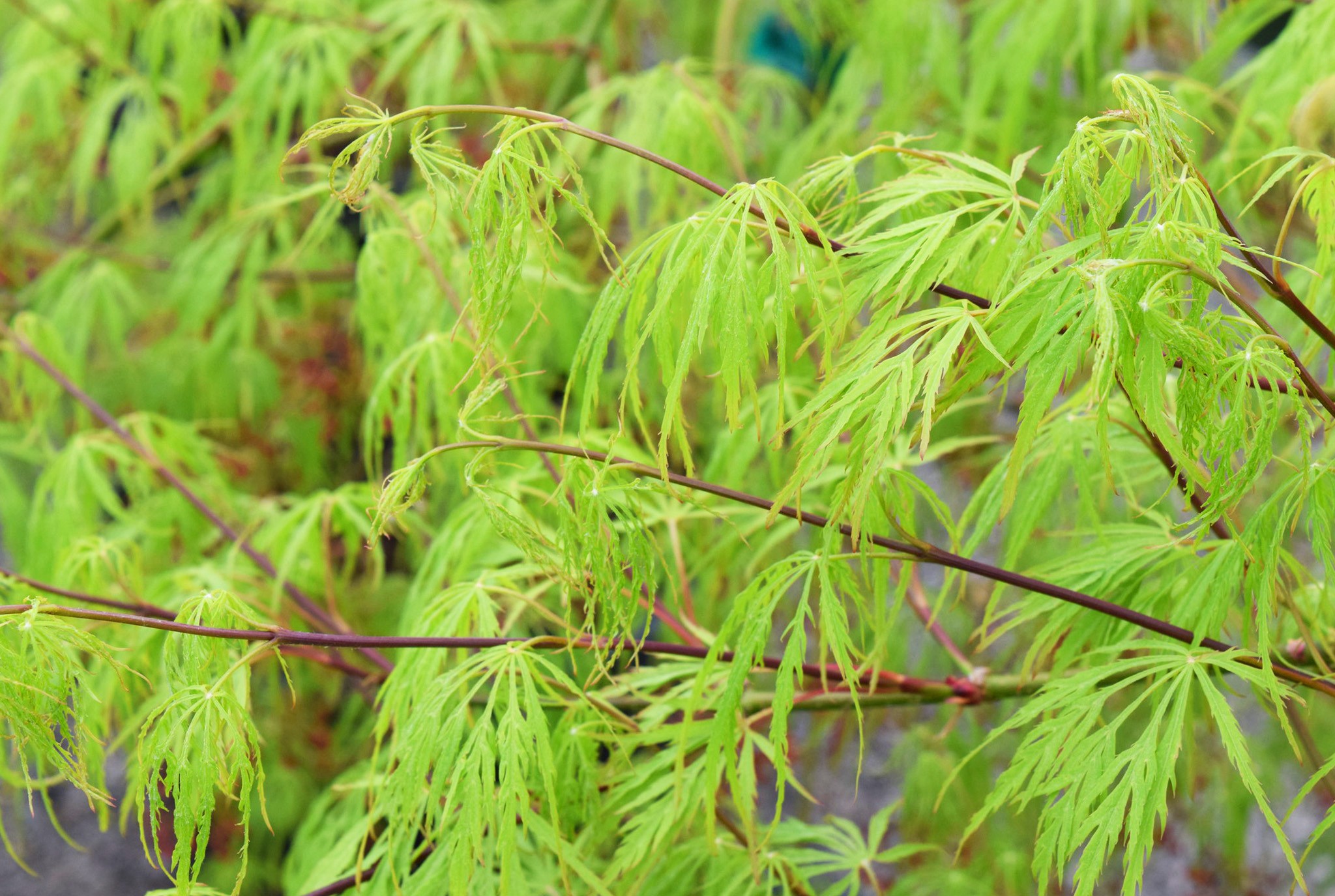
By Paul James
For years, I’ve been asked repeatedly, “What’s your favorite plant”? It’s a difficult question to answer, because there are so many incredible candidates. But the other day, while pruning my Acer palmatum ‘Shishigashira’ bonsai, I came to the realization that my favorite plant – or more specifically plant group – would have to be Japanese maples.
I’ve always been captivated by their amazing diversity in terms of leaf color and shape, range of sizes, and by their many and varied forms, whether upright or weeping. And I’ve always been impressed by how incredibly tough they are, despite their seemingly delicate appearance.
Best of all, perhaps, is the fact that they’re easy to grow, provided you plant them in the right spot to begin with. That means an area where the soil contains a decent amount of organic matter and drains well, and ideally gets just a few hours of morning sun followed by shade the rest of the day, or dappled light throughout the day.
Beyond that, Japanese maples don’t require that much attention. The weeping varieties do need light pruning to remove deadwood in their interior, and the upright forms may need a touch up every other year or so, but it’s best to keep pruning to a minimum. The same is true of fertilizer: Japanese maples simply don’t need much of a nutrient boost beyond a topdressing of compost twice a year, or a light application of a slow-release, low-nitrogen organic fertilizer in spring and fall.
However, because they have shallow root systems, plan on applying a thick – as in 3-inch – layer of bark mulch around the base of each tree to maintain fairly even moisture, something all Japanese maples require.
I could provide you with a long list of species and varieties of Japanese maples I adore, but I won’t. Instead, I would encourage you to discover for yourself the ones you like best, knowing that at the end of the day, you really can’t go wrong with whatever you choose.
Mulch – Like Icing on the Cake
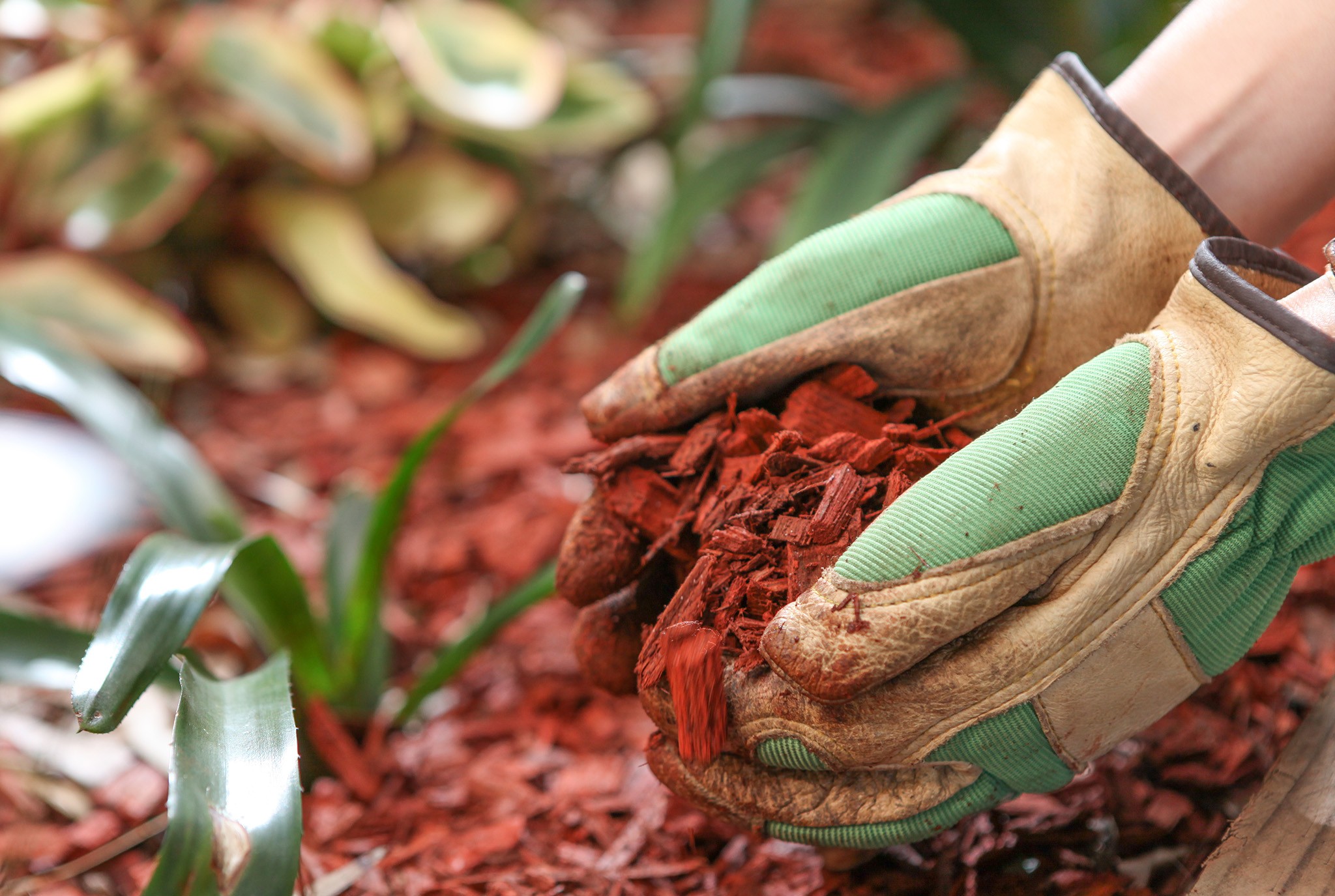
By Paul James
If you consider the money you spend on plants as an investment of sorts (and you really should), then you should also know that the smartest way to protect and insure a return on your investment is to apply mulch to your garden beds. Here’s why.
By using mulch in the garden, you’re mimicking what nature has been doing for eons – covering, and thereby protecting and enriching the soil with organic matter. Deciduous trees and shrubs blanket the forest floor with leaves that prevent erosion, maintain soil moisture, and prevent noxious weeds from germinating. As those leaves decompose, they provide nutrients to plants and food for soil-dwelling critters, especially earthworms, and they improve the soil’s structure and tilth. When you mulch at home, you’re doing essentially the same thing. And you get an aesthetic bonus too, because mulch is beautiful. To me, it’s like icing on the cake.
There are lots of different organic mulches on the market, and you really can’t go wrong with any of them. Chipped or shredded wood mulches are by far the most common. Pine needles are big in the south, and are gaining in popularity here as well. But mulch can also be nothing more than a layer of shredded leaves, compost, or any number of bagged products sold as soil conditioners.
Whatever you choose to use, a two- to four-inch layer is ideal, and ideally applied in spring and again in late fall. Spread the mulch evenly, tucking it up to the base of plants without covering their crowns to discourage rot. Don’t create pyramids of mulch at the base of trees – not only can that cause serious pest and disease problems, it also looks weird. (I sure hope my neighbor is reading this!)
And speaking of weird, don’t freak out if you see white strands of fungus growing in your wood-based mulch. That’s actually a beneficial fungi that’s helping break down the wood and converting it into plant nutrients.
The only possible downside to mulching heavily and regularly is that you may have to water a little more each time you water, because the water has to percolate through the mulch to get to the roots of plants. But you can also water less frequently. Which means it all comes out in the wash, so to speak.
Soil is Alive!
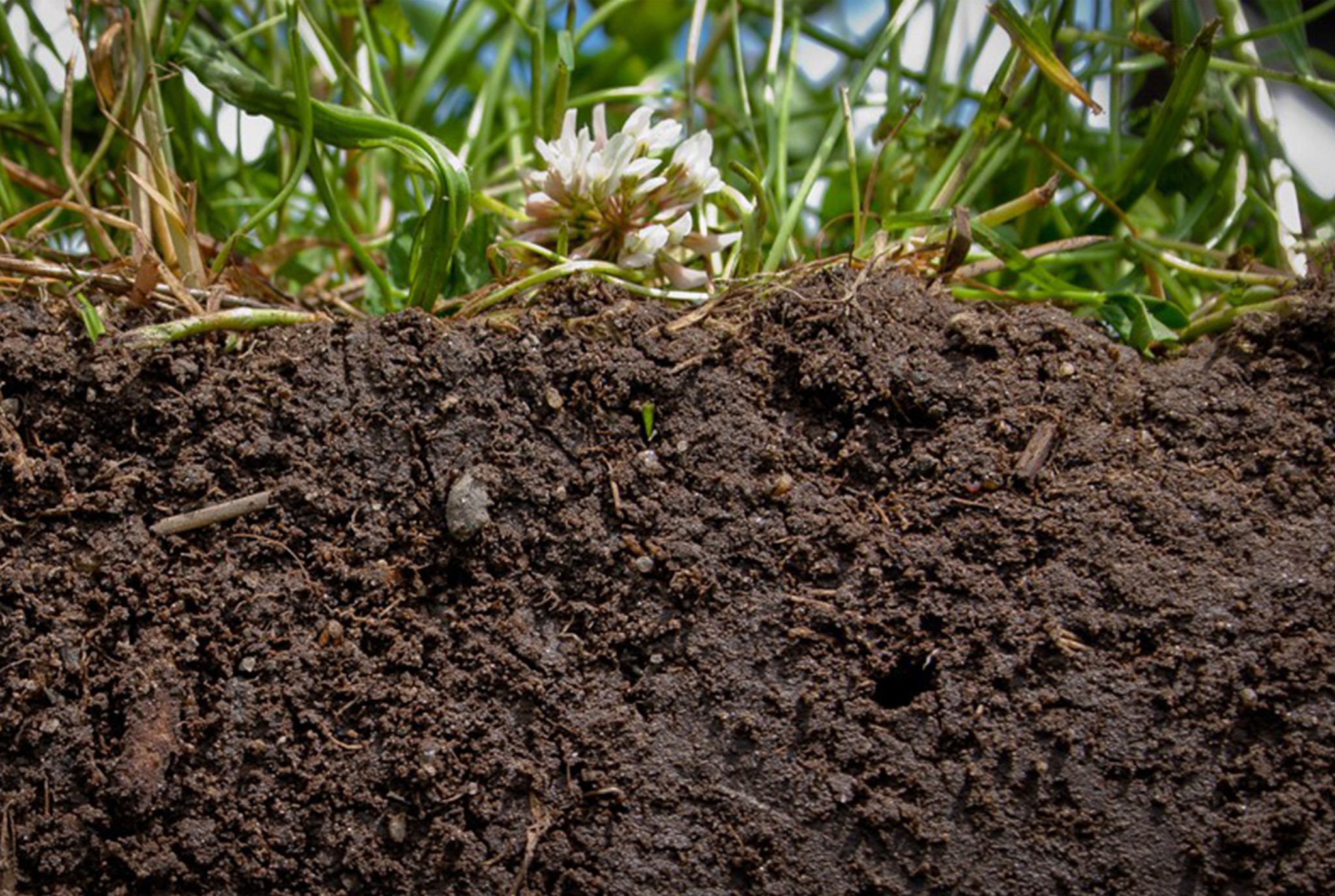
By Paul James
That’s right. Soil is alive. It’s a living organism. And until you get your head around that concept, you’ll never really get gardening. Sorry, but it’s true. So make those three words your gardening mantra. Carve them into the handle of your favorite shovel. Paint them graffiti-style on your fence. Shout them out at the top of your lungs for all your neighbors to hear!
But just what do I mean when I say soil is alive? Well, consider the following.
More organisms occur in soil than in all other ecosystems combined. In fact, in just one tablespoon of soil there are more living things than there are people on the planet. (You might want to read that sentence again. It’s pretty mind blowing.) And in that one tablespoon lives a diverse and dynamic community composed of all sorts of critters, some of which you can see, most of which you can’t. But all play a vital role in keeping the soil healthy…and alive.
Soil Mates
I want you to meet these critters, and learn to appreciate all they do for us, which is a lot. After all, without them, life as we know it would cease to exist. Seriously. They’re that important.
Bacteria
In one teaspoon of soil, there are as many as 100 million bacteria, most of which reside in the top six inches. These single-celled microorganisms reproduce by cellular division at an astounding rate. In fact, a single bacterium can produce 47 million descendants in 12 hours! Their population tends to remain fairly stable simply because they die at a rapid rate as well, and because many of the other critters you’re about to meet like to eat them.
Bacteria are responsible for such things as nitrogen fixation and sulfur oxidation, processes that make essential nutrients available to plant roots. They also aid in the decomposition of organic matter. Without them, plants simply cannot grow.
However, there are harmful bacteria as well, namely those that cause annoying and difficult to control plant diseases such as blight, leaf spot, and certain cankers. But hey, you’ve got to take the good with the bad.
Fungi
Fungi are multicellular organisms that account for the greatest amount of living mass in soil. And within the world of fungi, there are the good, the bad, and the downright ugly.
Most gardeners, when they hear the term fungi, think of those that are harmful to plants, from powdery mildew on cucumbers to rust on roses to fusarium wilt on tomatoes. But there are all kinds of beneficial fungi as well. Many of them are saprophytic scavengers (they feed on all those dead bacteria), but their varied diet also includes leaf litter and other organic matter. There are also fungi such as mycorrhizae that enter into a symbiotic (mutually beneficial) relationship with the roots of plants to facilitate nutrient uptake.
So not all fungi are bad. In fact, some are quite good, especially mushrooms, morels, and truffles. Yummy!
Actinomycetes
Ever wonder what makes soil smell sweet? Or why the air smells so good after a spring rain? Well, it’s all due to Actinomycetes, a sort of cross between bacteria and fungi. These single-celled organisms devour the tough, woody stuff in the soil – chitin, lignin, and cellulose – as well as phospholipids (a fancy word for fats). In the process, they produce geosmin, the compound that gives the soil its distinctive, earthy smell. That smell is so enticing that geosmin is sometimes added to perfumes to give them an alluring earthiness. Eau de Compost, anyone?
Chances are you’ve seen Actinomycetes colonies in your own soil or mulch or compost pile. They look like grayish-white spider webs, and they’re a sign that your soil is healthy. So don’t freak out.
Actinomycetes also have antibacterial properties, which explains why Streptomycin and related antibiotics come directly from Actinomycetes.
Algae
Algae are bit players, really. They primarily live on rather than in the soil, because they contain chlorophyll and therefore need light to grow. Other critters dine on them.
Protozoa
These “animals” include amoeba and paramecium, both of which you probably observed under a microscope in science class. They reside in the top six inches of soil, where they graze on bacteria while other critters graze on them.
Nematodes
Again, most gardeners think of nematodes as bad guys, and some are. But soil is full of beneficial nematodes, and they comprise as much as 90 percent of the multicellular invertebrates in the soil. Millions can be found in a single shovel-full of good garden soil. Think of them as microscopic roundworms, chomping on fungi and recycling nutrients into the soil.
Bigger Critters
This group includes the more familiar forms of life – ants, beetles, crickets, earthworms, grubs, millipedes, mites, slugs, and so on. Collectively, you can think of these guys and gals (or in some cases, both) as nature’s rototillers, because as they move through the soil in search of food, they aerate it. They also leave behind their nutrient-rich poop.
But just what do they – and all their fellow soil mates – actually eat, besides each other? Organic matter in its myriad forms, that’s what. And that’s why the only way to keep soil alive is by adding lots of organic matter – shredded leaves, grass clippings, homemade compost, barnyard manures, or bagged products from Fox Farm, Back to Nature, and other companies committed to keeping soil healthy…and alive.
Damage Assessment
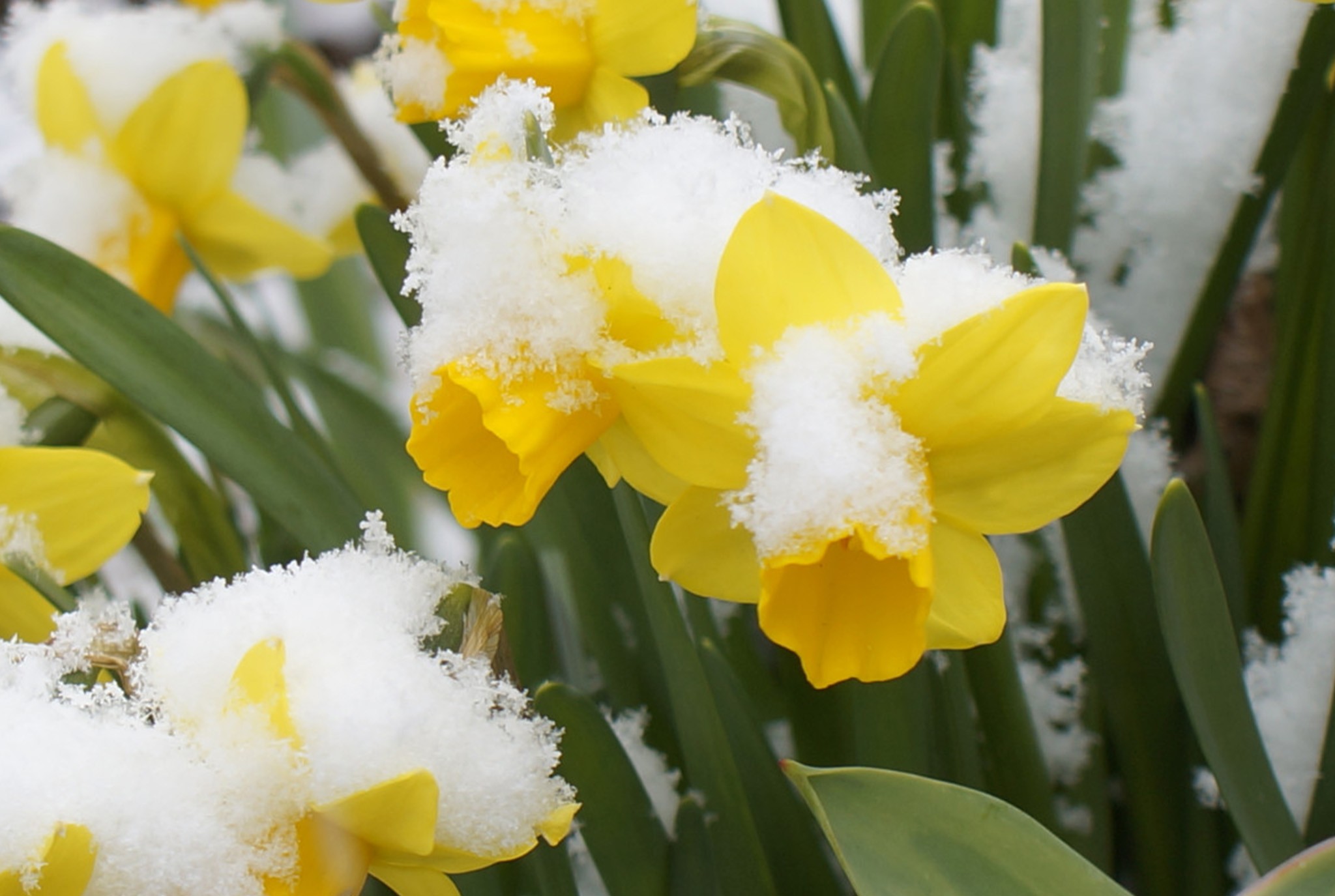
By Paul James
Morning lows earlier this week were colder than a polar bear’s paws. As a result I had at least a dozen friends ask me what effect, if any, the way-below-freezing temperatures might have had on landscape plants. My responses ranged from “We’ll have to wait and see” to “It’s a goner” depending on the plant in question. Here’s why.
Sometimes freeze damage on a plant is obvious – the plant wilts, and its leaf tissue turns from green to black to mushy. It’s not a pretty sight. That’s precisely what happened to tender vegetation, especially vegetables and herbs that were just emerging or recently transplanted. Those plants are goners, but there’s still plenty of time to replant. What’s growing below ground, such as potatoes or asparagus, will be just fine.
Sometimes a plant will wilt but show no obvious signs of tissue damage. For example, I saw wilt on the terminal growth of Photinias all over town. If it doesn’t bounce back by the weekend, you should consider pruning the tips back several inches. Aucubas look as though they’re dead already, but they’ll recover nicely.
In many cases the effects of freeze damage can be delayed for several weeks, and that’s definitely going to be the case with many early-spring bloomers, including forsythia, saucer magnolia, quince, fruit trees, and maybe even redbud and dogwood. Their flower buds may well have been zapped, but the plants themselves will recover. And by the way, azaleas and hydrangeas should be fine, both foliage and flowers.
I actually expected to see a fair amount of damage on daffodils, but mine – and those throughout my neighborhood – look great. The foliage shows no signs of tissue damage, and even the flowers appear to be just fine.
The bottom line is that 99.9% of all landscape plants were unscathed by the weather, largely because they’re plenty hardy but also because they’re still dormant. Let’s just hope we don’t see any hard freezes this spring.
Moles on the Move!
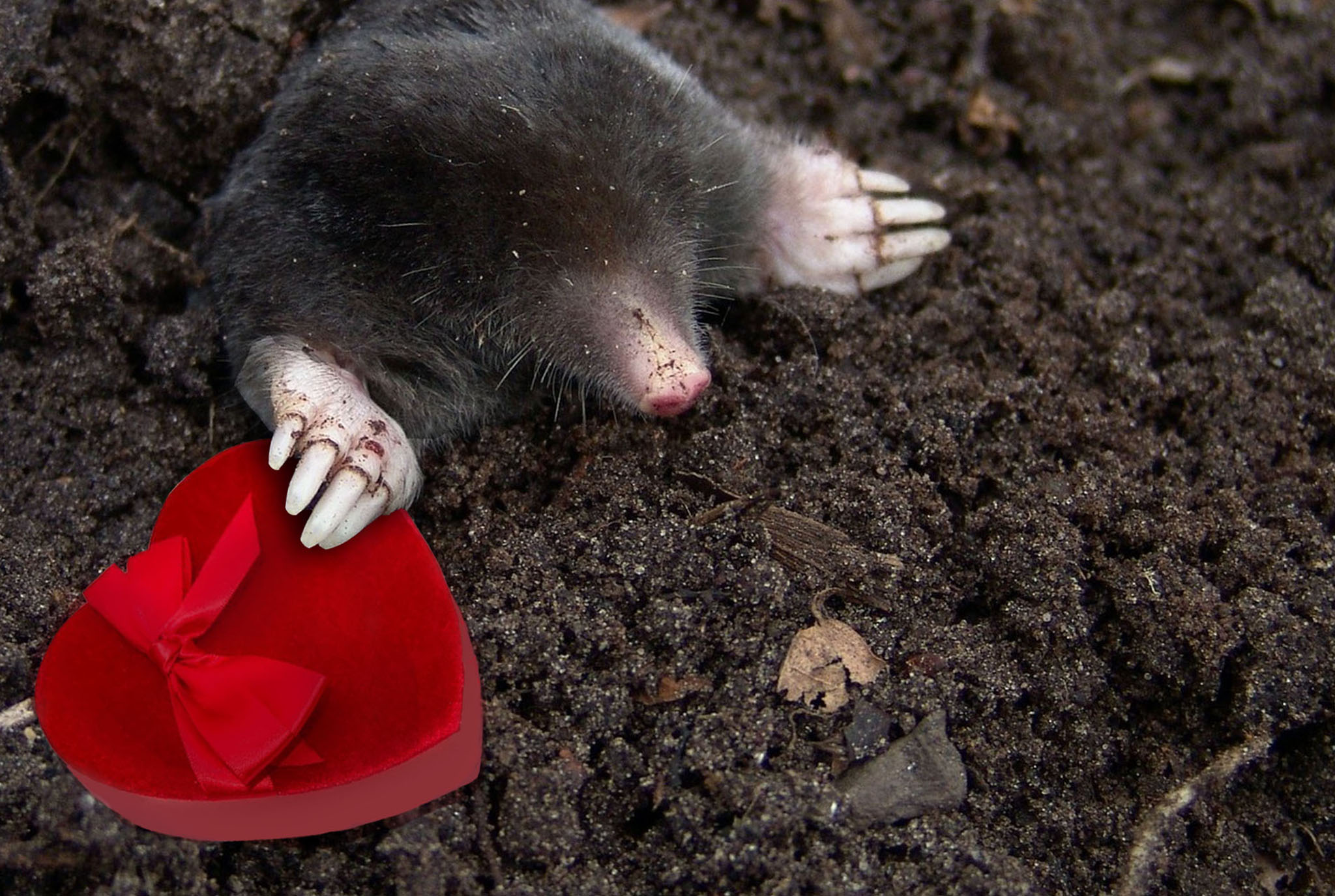
By Paul James
A post about moles may seem decidedly unromantic on Valentine’s Day, but bear with me. You see moles are making their moves, so to speak, evidenced by their extensive tunneling. And while they’re certainly on the hunt for food, they’re also hunting for a mate. Yes, my friends, it’s mole mating season, the most romantic time of the year for moles.
The tunnels you see aboveground are known as runways, in which moles feed and also use as pathways to deeper tunnels and their lairs. They may use the runways for several days so long as food is present, or they might abandon them after only one day of digging if food isn’t present, only to immediately create another.
Fortunately, moles don’t eat plants (voles and gophers do, but that’s another story). Instead, they prefer a steady diet of primarily white grubs and earthworms, which they consume in huge quantities as they tunnel through lawns and gardens.
A vast array of runways may cause you to think that there are dozens of moles in your yard, but in fact moles are very territorial, and rarely are there more than three in an entire acre (except perhaps this time of year) so typically the average-size yard is harboring only one. Of course, even one can be a nuisance.
So just how do you go about controlling moles? Well you could do nothing, and embrace the mole’s presence, knowing that he or she is gobbling up the grubs that might ultimately become Japanese beetles and attack your roses, and aerating the soil in the process.
You could try repellents, nearly all of which contain castor oil and do a pretty good job of moving moles elsewhere assuming you follow the label instructions to the letter and reapply after heavy rains. I’ve actually had excellent results with repellents.
You could use harpoon-style traps, which if placed properly can be highly effective, if not a tad gruesome.
You could hire an exterminator. They don’t come cheap, and some don’t even guarantee that they’ll be successful, but folks in my neighborhood who’ve relied on their services have been pleased with the results.
You could try poisons, but realize that moles aren’t likely to eat anything that doesn’t resemble a grub or earthworm, so poisons that control mice and other critters won’t work. Even the poison “worms” are only marginally effective at best, because moles can tell the difference between real and fake worms.
And finally, you could consider any number of different home remedies, from stuffing tunnels with dog or cat hair to flooding the tunnels to using Juicy Fruit gum (which the moles are said to eat, but are unable to digest). Just keep in mind that the effectiveness of these approaches is purely anecdotal, with no basis whatsoever in science.
Regardless of the method you try, you don’t want to wait much longer. That’s because the gestation period for a female mole is about 45 days, which means a new generation of moles will be here around April 1. No fooling.
Beyond the Bouquet

By Paul James
I’ve never swooned my sweetie with cut flowers on Valentine’s Day, because I don’t want to express my love with something that’s here today, gone tomorrow. And a dozen, grossly overpriced (and often fragrance-free) roses always struck me as a predictable, last-minute decision. That’s why I prefer to go beyond the bouquet and give live plants instead.
And thankfully, there are dozens of great choices, especially among flowering houseplants. Here are a few of my favorites.
There are also dozens of great choices among foliage plants, including the oh-so-very-easy-to-grow ZZ plant, Chinese evergreen, Snake plant (Sansevieria), Spider plant, Aloe Vera, Pothos ivy, Dumbcane (Dieffenbachia), and Pony-Tail palm.
I haven’t decided which plant to get my wife, Carrie, this year. But one thing’s for sure – I won’t be giving her a bouquet.
A Perfect Weekend for Gardening!

By Paul James
The forecast for this weekend looks absolutely fantastic for getting things done in the yard. And you can bet your begonias I’ll be taking advantage of the warmer-than-average temperatures by tackling more than a few tasks. In case you plan on doing likewise, here’s a list of things to consider.
Plant Trees, Shrubs, and Roses
It’s the perfect time to get deciduous trees and shrubs, including roses, in the ground. And now is also the best time to see their “bones” or bare branches. I actually prefer to select these plants on the basis of their branching alone, because it gives me a better idea of what they’re going to look like once they’re loaded with leaves.
Prune
I plan on pruning several small trees and shrubs with an eye toward removing dead or crossing branches, and opening up the interior of the plants. I’ll also be trimming ornamental grasses and cutting back a few perennials. I’ll wait until we get closer to spring to prune evergreens and conifers.
Plant from Seed
Sowing from seed indoors, whether flowers or vegetables or both, is a lot of fun, and you typically have more choices available. What’s more, it’s extremely economical. We’ve got pretty much everything you need to get started, including biodegradable and plastic pots, trays (even self-watering versions), heating mats to boost germination and seedling growth, lights, potting mixes…and seeds, of course!
Water!
I’m going to deep soak everything in my landscape on Sunday afternoon, including the lawn, and especially evergreens. It hasn’t been all that dry this winter, but I plan on seizing the opportunity to water anyway.
Weed Control
Want to control pesky weeds in the lawn? Now is the time to do just that by applying a non-selective herbicide (on dormant Bermuda grass only) or a pre-emergent herbicide. We’ve got several products to choose from, but keep in mind that different products control different weeds, and timing their application is fairly critical, so visit our Solution Center to find out which one is right for you.
Make the Most of Leaves
If you’ve still got leaves lying around, do a final cleanup. Use a mulching mower to shred leaves into fine particles, which will add organic matter and nutrients to your lawn. Rake leaves in your flower beds and toss them into your existing compost pile, or use them to start a new one. Composted leaves are the greatest soil amendment money can’t buy, and ultimately they can transform any soil type – from heavy clay to pure sand – into something plants will love to call home.
Get Equipment Repaired
Beat the spring rush by having your power equipment serviced now. If you wait another month, you’ll wind up waiting weeks rather than a few days to get your mower or blower back, and by then it’ll be time to mow and blow.
Clean Garden Tools
Use a steel brush to knock dirt and rust off metal surfaces, then apply a thin layer of oil (Canola works great) and rub it in with a cloth. Rub wooden handles of tools with boiled linseed oil and they’ll last for years to come. And finally, sharpen shovels, hoes, pruners and other cutting tools with a file, or check out the sharpening gizmos we carry.
Plant Veggies?
I’m tempted to plant potatoes and onions this weekend, but I can’t in good faith suggest you do the same. I might even stick a few cole crops –broccoli, cabbage, cauliflower – in the ground, knowing that there’s a good chance I’ll have to cover them once or twice in the weeks ahead. But because the long-range weather forecast looks pretty mild, and because my raised beds warm up quickly on sunny days, I’m probably going to take a chance on getting a few things in earlier than usual.
And if all goes well, I’ll be harvesting earlier than usual too. Yippee!
Soil Test, Anyone?
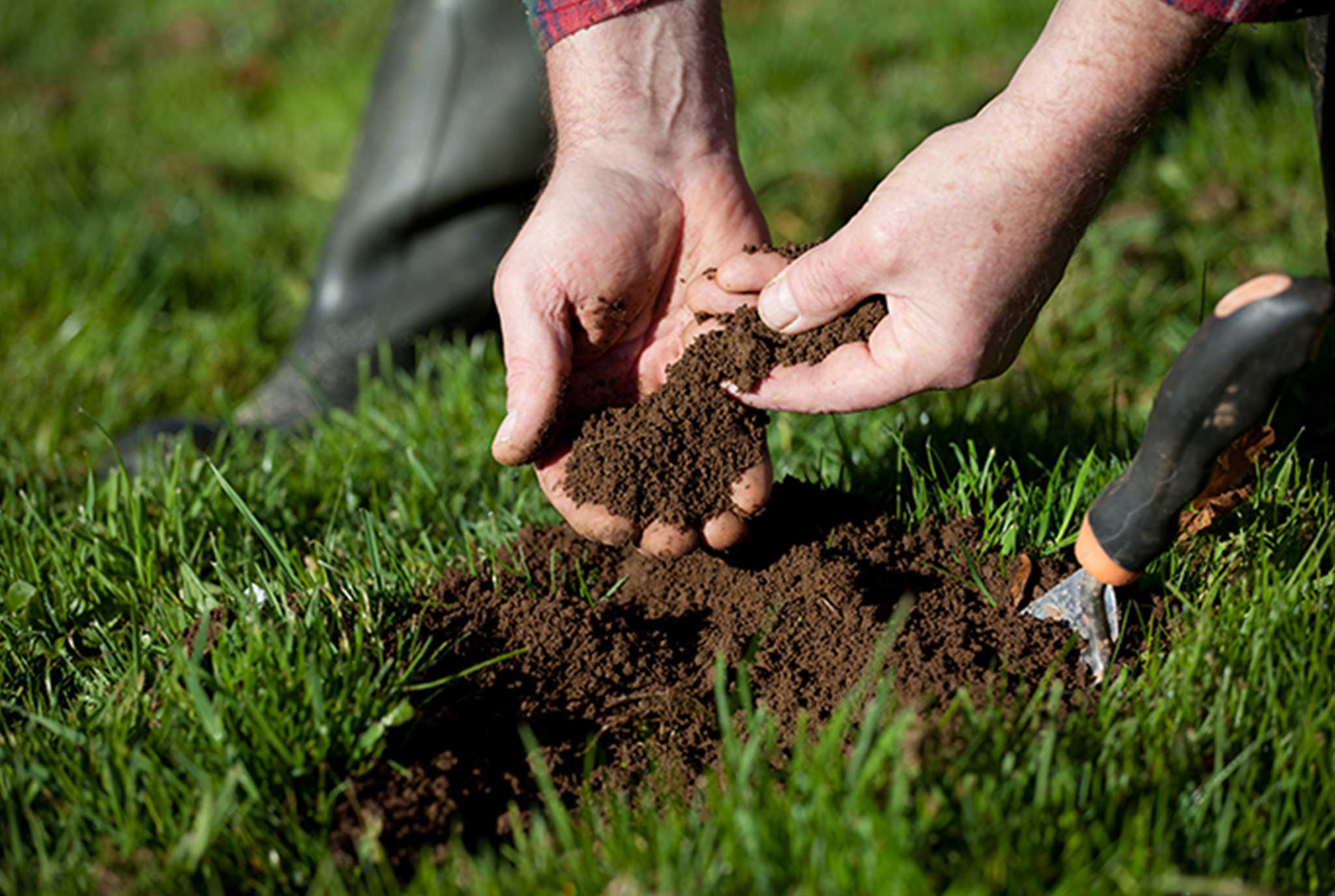
By Paul James
When is the last time you had your soil tested? Or perhaps more to the point, have you ever had your soil tested? Chances are the answer to the first question is “Can’t remember,” and the answer to the second is “No.” And that’s too bad, because a soil test can reveal problems you never knew you had and make a huge difference in how well your plants grow.
Thankfully, getting a soil test is a pretty simple and inexpensive procedure, and you don’t have to study for it. What’s more, it’s not something you need to do every year. Actually, I’d suggest you consider testing only every three to five years or so, because changes in soil chemistry generally don’t occur very rapidly.
A basic soil test performed by folks at OSU’s Soil Science Lab will reveal four things about your soil: its nitrogen, phosphorous, and potassium (or NPK) levels, and its pH. That’ll cost you $10. You can pay more to get more, including such things as secondary and micronutrient levels, and well as organic matter content, but those tests aren’t all that necessary for homeowners.
To prepare a soil sample, you’ll need a clean trowel, a bucket, and a one-quart zip-lock plastic bag. Use the trowel to dig up the soil to a depth of roughly six inches, and collect at least a dozen or so two- or three-tablespoon samples from several locations in your lawn, flower bed, or veggie garden. (Consider each location as a separate test.) Drop the samples in the bucket as you go, then mix the soil well and remove any sticks or other debris.
Fill the plastic bag with the mixed soil, and take the sample to the OSU Extension office at 4116 East 15th Street. Within two or three weeks, you’ll receive the test results along with recommendations on the nutrients you need to add and how much. You might even learn that you should stop adding certain nutrients.
Fair warning: Interpreting the test results can be a bit confusing, but don’t let that discourage you. Just bring the information to our Solution Center, and let Jennifer or Taylor give you step by step instructions on how to make the necessary adjustments to your soil’s NPK and pH levels so that your plants will be healthy and happy all season long.
Do Bugs Survive Winter?
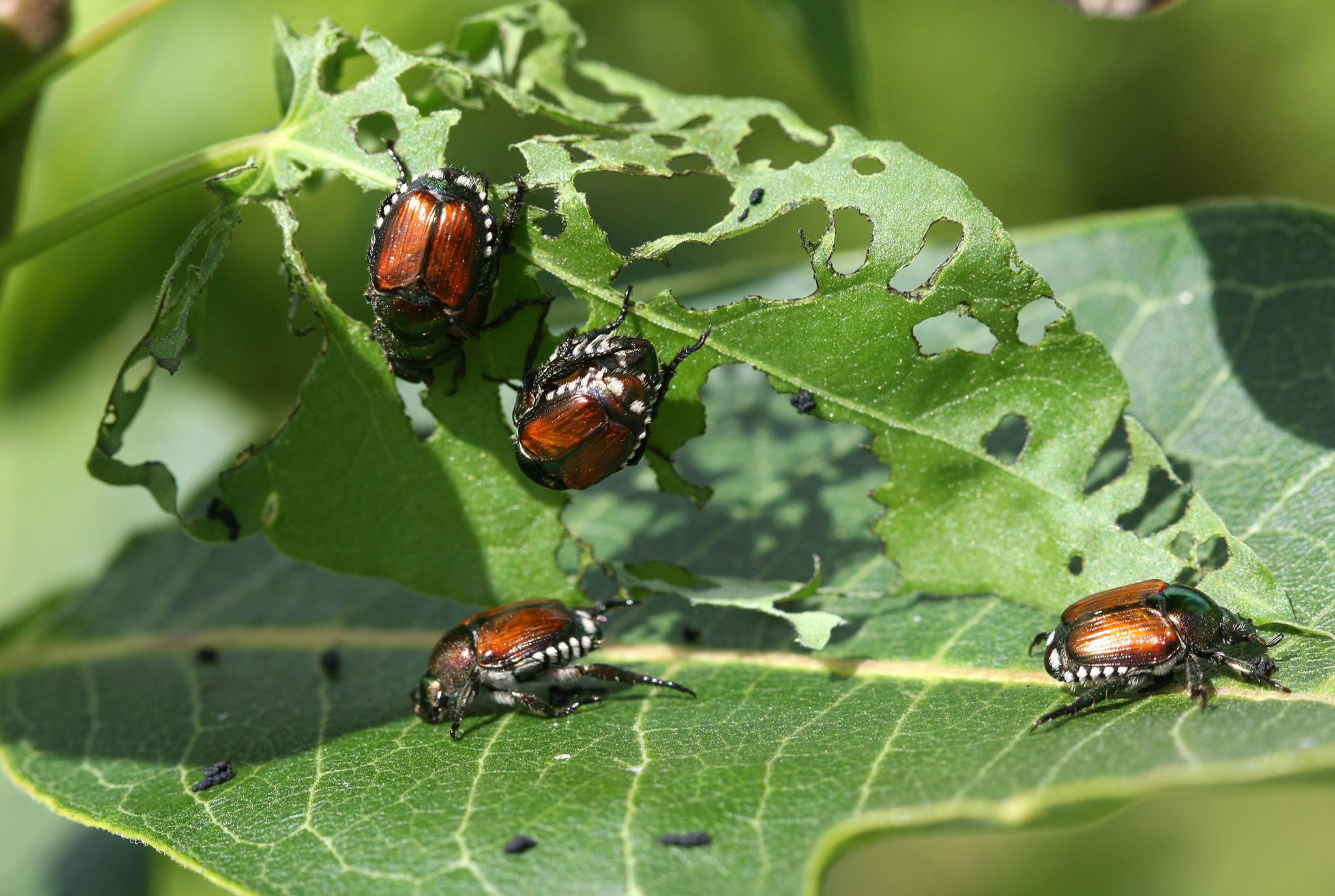
By Paul James
A lot of folks claim that freezing temperatures reduce insect populations. But does that claim have any basis in fact? Not really. Yes, a few bugs will bite the dust, but most have developed truly remarkable (and downright cool) ways of protecting themselves and furthering their progeny.
The simplest way insects beat the cold is by migrating to a warmer spot, just as Monarch butterflies do. Moving into your house is another common means of survival for numerous insects including crickets, ants, ladybugs, stink bugs, moths, and even wasps.
Insects that can’t survive cold temperatures – both those that prey on plants as well as their beneficial counterparts — at least know how to sustain their populations by laying eggs underground, in leaf litter or garden refuse, and in buildings.
And what about fleas and ticks and mosquitoes? Sorry. More not-so-great news.
Fleas are clever enough to find ways to stay warm, whether on wild or domesticated animals or in garages, under decks, and around foundations.
Ticks begin a process of acclimation long before winter arrives by moving water out of their cells before it freezes and crystallizes, thereby allowing them to survive freezing temperatures. They also escape the cold beneath leaf litter and other warm spots.
Mosquitoes actually hibernate both inside and out. They also lay eggs in the fall that can survive the cold – even in frozen water — and remain dormant until spring.
And there are some insects – the Emerald Ash Borer for example, as well as some mosquitoes – that produce a sort of antifreeze in their blood called glycerol, which enables them to survive freezing temperatures in a state of suspended animation. It’s insect cryogenics, basically.
Let’s face it. Insects have been around for millions of years, and rarely do we hear of them becoming extinct. They’ve survived predators, pesticides, an asteroid that killed off the dinosaurs, and yes, even nuclear explosions. Among living things, they are the ultimate survivors.
And you think something like a little cold weather is going to affect them?
Winter Houseplant Care
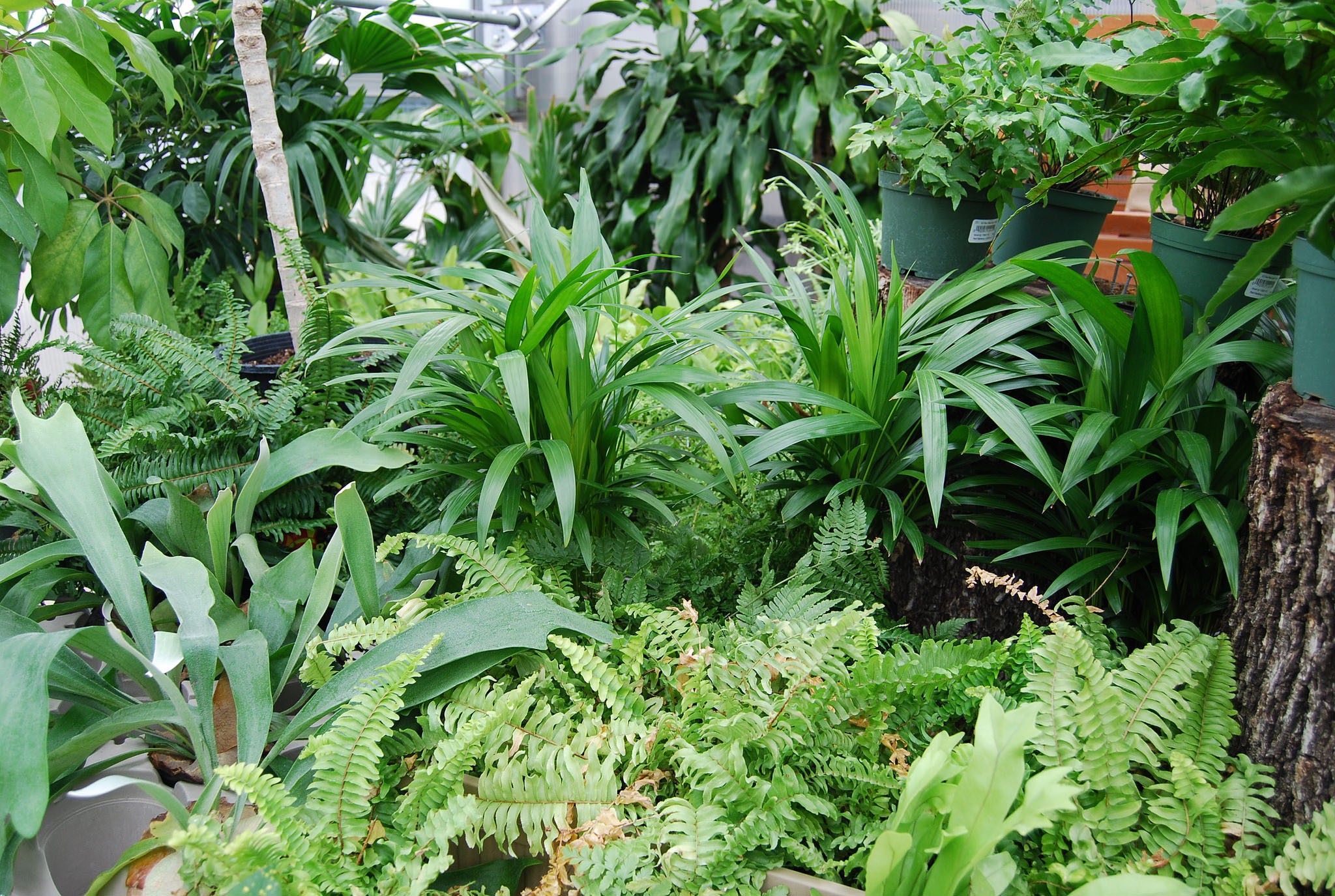
By Paul James
Winter can be a tough time for tropical houseplants. Light levels indoors are less intense. Humidity levels typically drop way below the comfort level of most plants. But perhaps most critically, folks tend to water and fertilize their houseplants in winter the same way they do throughout the rest of the year. And that’s a big boo-boo.
Light
Because of the sun’s lower angle in winter, light levels indoors can drop a whopping 50%, so plan on moving plants closer to windows or to an area that gets more light (such as a southern or western exposure). Just make sure plant leaves don’t touch the glass. Also, consider cleaning you windows to maximize light transmission, dusting plant leaves so they can absorb all the light available, and rotating plants a quarter turn each week for even light distribution.
If your plants need more light than is naturally available, add artificial light in the form of standard fluorescent tubes or lights made specifically for growing plants, such as high output LEDs.
Humidity
The majority of houseplants prefer humidity levels of around 50%, yet in most homes in winter humidity typically hovers around 10%. The most common sign of plant stress resulting from low humidity is browning on leaf margins. Spider mites might also rear their ugly heads.
The surest way to increase humidity is to mist plants often – at least once, maybe even twice a day. Placing plants on a tray filled with moist pebbles also works well. But the simplest and most effective solution is a small humidifier – Duh! Just run it once or twice a day for half an hour or so and your plants will love it. As a bonus, the higher the humidity, the less you’ll have to water.
Water
Without a doubt, the most common cause of houseplant failure is overwatering, and the most common season for failure is winter. Here’s why.
During most of the year, houseplants are actively growing and therefore need regular watering. But growth slows down considerably in winter, so you need to adjust your watering schedule. In the case of most houseplants, it’s best to let the soil dry out almost completely before watering (exceptions would be ferns and citrus, which need steady moisture).
But exactly how do you know when to water? Just poke your finger two inches into the soil. If it’s dry, go ahead and water.
Fertilizer
Again, because plants grow very slowly in winter, they don’t need much if any fertilizer. And applying fertilizer at a time when plants don’t need it is more than just a waste of money – it can also lead to burning of the roots and a buildup of salts in the soil.
Repotting
Finally, and again because houseplants go partially dormant in winter, it’s best to hold off on repotting until spring, when active growth begins. That’s also when you should begin fertilizing again and watering more frequently.
Let it Snow?
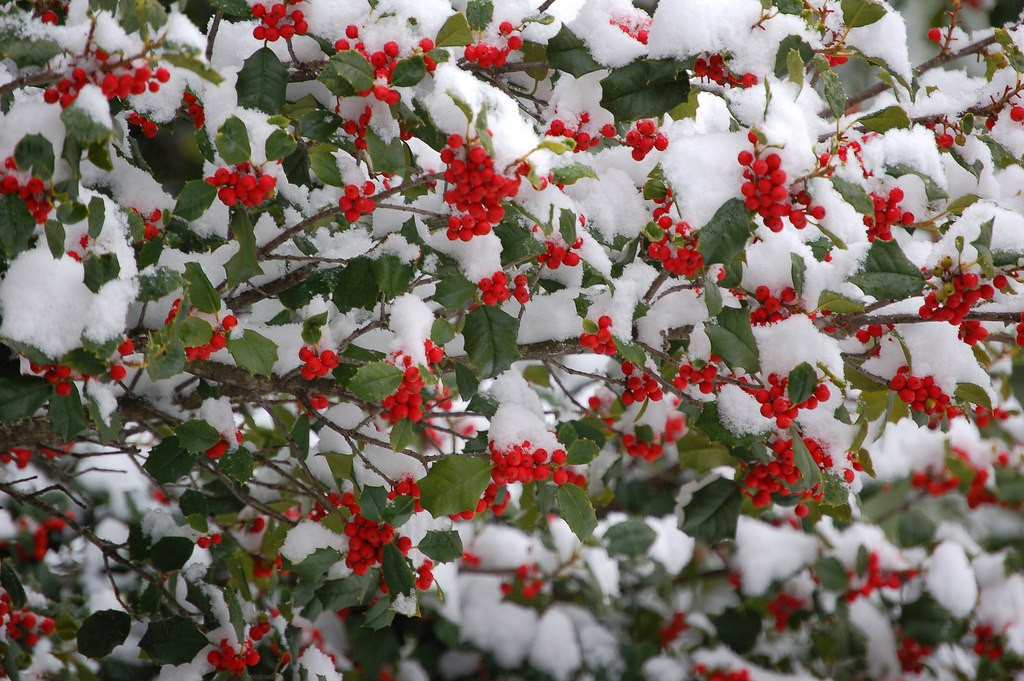
By Paul James
It looks as though we could be in for a doozey of a winter storm this weekend that may include ice and snow. So what effect, if any, could freezing precipitation have on landscape plants, and is there anything you need to do in preparation for the storm? Glad you asked.
For the most part, snow is a good thing. Snow is mostly air trapped in ice crystals, and that trapped air acts as an insulator, preventing plant tissues from dropping below freezing. It insulates the soil in the same way, keeping it at or above freezing even when air temperatures plunge.
Wet, heavy snow may bend the branches of evergreens, but as bad as it looks, most of the time the branches will spring back once the snow melts.
Snow has even been called “Poor Man’s Fertilizer,” because as it falls through the atmosphere, nitrogen and sulfur attach to the flakes. That’s actually true, but rain and lightning contain even more nitrogen. And come spring you’ll still need to fertilize.
And yes, snow provides moisture, but not as much as you might think: ten inches of snow equals about an inch of water.
Ice is another story. It sucks. And it can do serious damage. It does insulate plant tissues in a manner similar to snow, but the weight of even a quarter inch of ice can be devastating, as anyone who was around here in 2007 can attest. Whatever you do, don’t try to knock ice off of branches with a stick because you may (and probably will) do far more harm than good.
In terms of preparing for the storm, I’d suggest a trip to your favorite grocer. The weekend looks ideal for cooking beef bourguignon, ragu Bolognese, or maybe a big old pot of chili, all of which freeze well. And don’t forget the vino.
You Gotta Water in Winter!
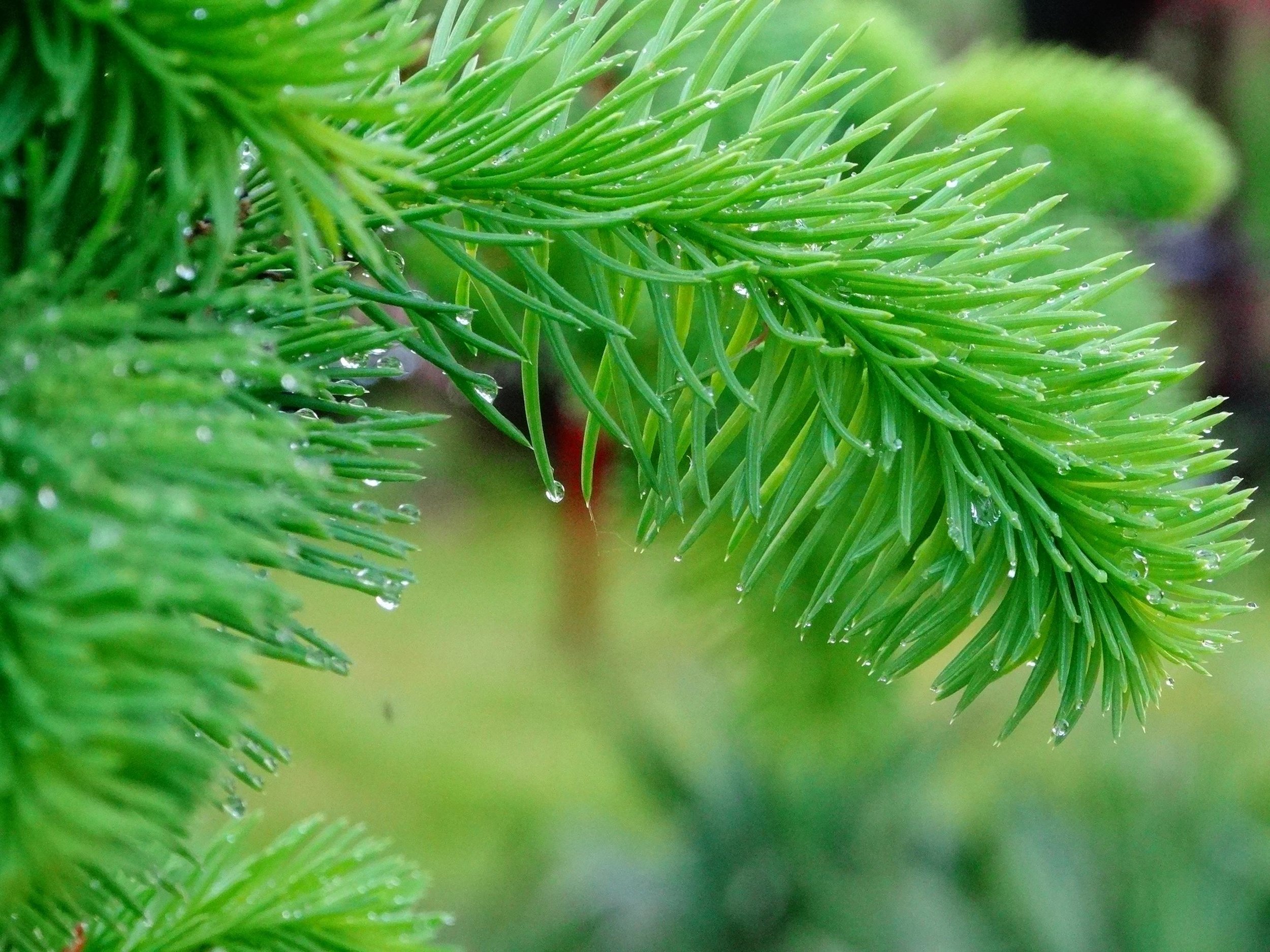
By Paul James
Although it may seem somewhat counterintuitive, it’s crucial that you water landscape plants during the winter months. The combination of dry soil and cold air temperatures can be especially tough on even the hardiest plants, both deciduous and evergreen. So keep these basic watering tips in mind.
First, realize that I’m not suggesting you water all that often during the winter months. Typically once a month will do the trick, although if it’s bone dry in December and January you may need to water twice a month. Pick a day when the temperature is above freezing and the overnight low is forecasted to be above freezing as well. Those conditions happen more often than you might imagine, and on those days you should seize the opportunity to deep soak everything.
Evergreens and conifers need more water than their deciduous counterparts because they continue to grow, albeit ever so slowly, during the winter. And many of them, including azaleas, arborvitaes, pines, spruces, junipers, Euonymus, and Oregon grape have shallow roots and are therefore more susceptible to drying out. But even deciduous plants need water in the winter to prevent their roots from becoming desiccated.
The same is true of cool-season turf grasses such as fescue and rye, both of which continue to grow in winter. Dormant perennials should be watered as well to keep their roots hydrated. And spring-flowering bulbs, which store lots of water in advance of blooming, absolutely must be watered during dry winters.
Of course, if we get plenty of rain this winter you can skip watering altogether, but the extended forecast looks pretty dry. There is rain in the forecast for tomorrow night, but it’s anybody’s guess just how much we’ll get. And if it doesn’t amount to at least a half-inch total, I’m going to water this weekend. You should too.
Poinsettia Pointers
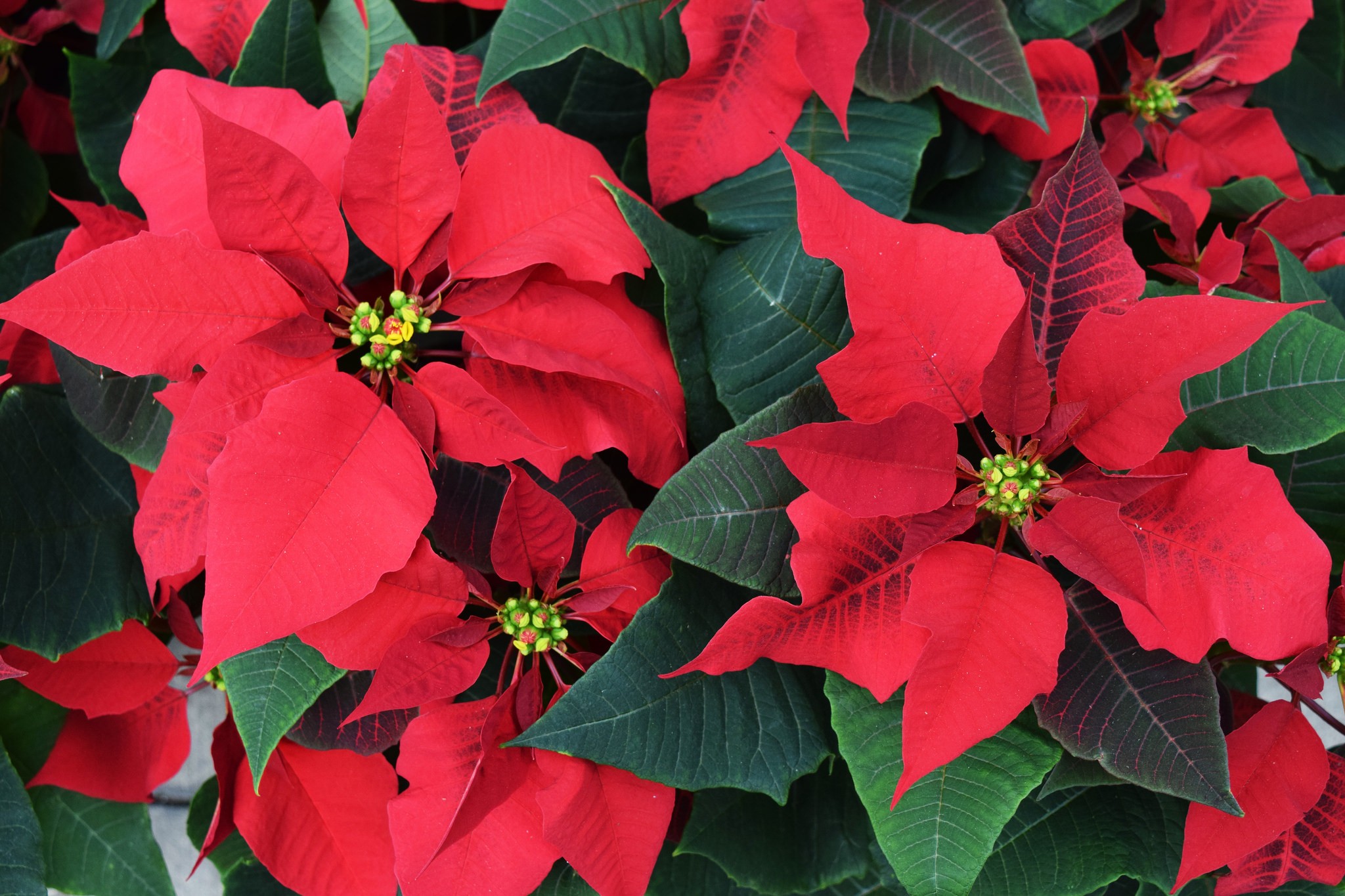
By Paul James
Sales of Poinsettias in the U.S. will top $250 million in the six weeks leading up to Christmas. That’s a lot of green spent on a plant most people toss in the trash after the holidays. But then again, can you imagine Christmas without Poinsettias?
So the goal, then, is to keep your Poinsettias healthy and happy for at least six weeks. And here’s how to do just that.
Try to buy your Poinsettias on a day when temperatures are well above freezing, and make sure they’re wrapped regardless of the temp. Exposure to low temperatures even for a few minutes can permanently damage the plants. And don’t leave your plants in the car while you do more shopping. Depending on the weather, it may be too cold – or perhaps even too hot – inside your car.
Once home, carefully unwrap your Poinsettias and place them in an area that gets roughly six hours of indirect light a day. Most often, that’s an eastern or southern exposure. Keep the plants away from warm or cold drafts from air registers or open doors or windows.
Thankfully, Poinsettias are happy with the same daytime temperatures people are – 60 to 70 degrees during the day, and a bit cooler at night. Temps above 70 degrees will shorten the plant’s lifespan.
Check the soil daily, and water to maintain even soil moisture. If your plants are wrapped in foil, punch holes in the foil so water can drain into a saucer. Discard excess water in the saucer shortly after watering. Keep in mind that soggy soil will lead to root rot.
Do all that, and your Poinsettias should last at least six to eight weeks indoors.
Shrubs for Fall Color
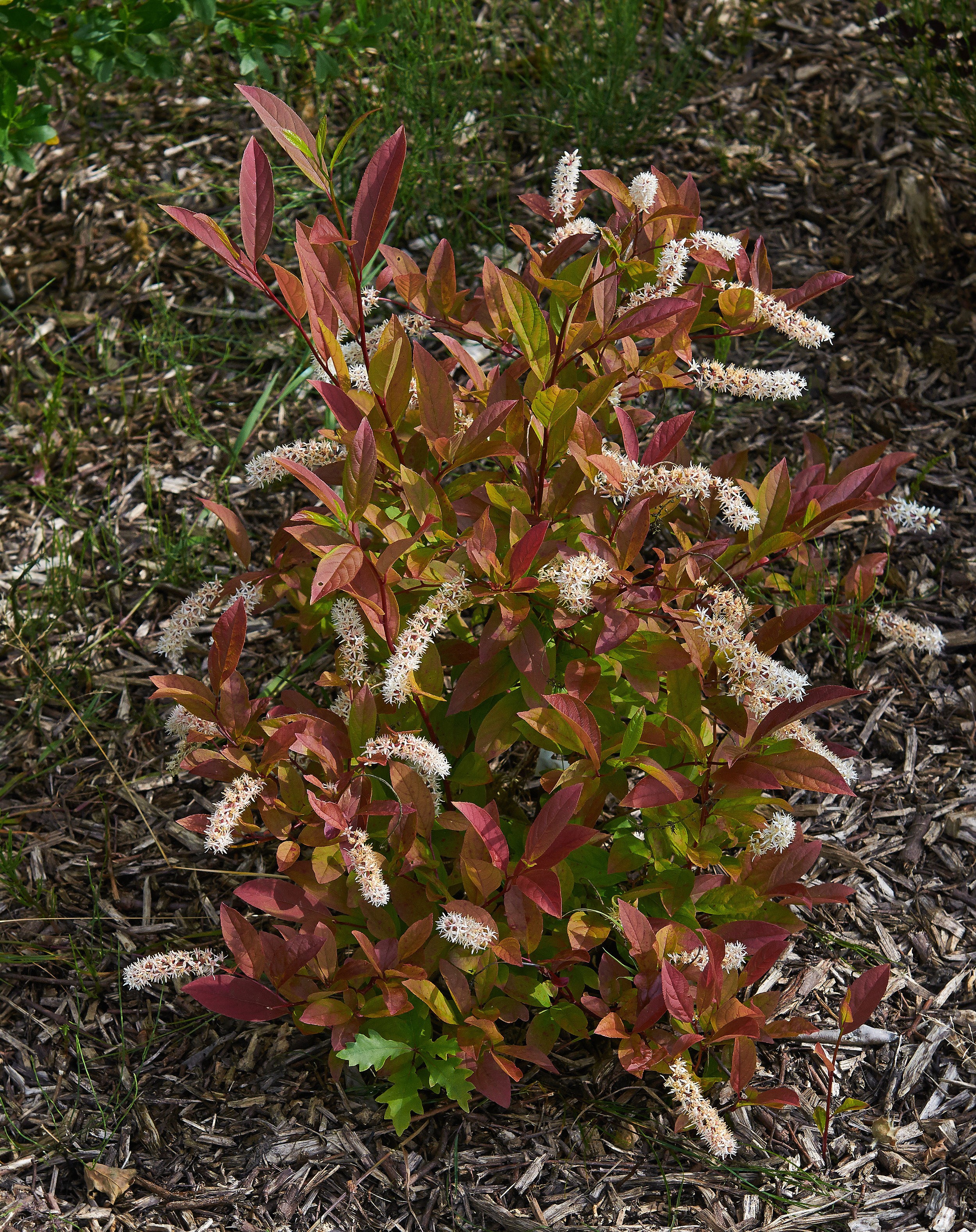
Bulbs – Get ‘Em in the Ground!
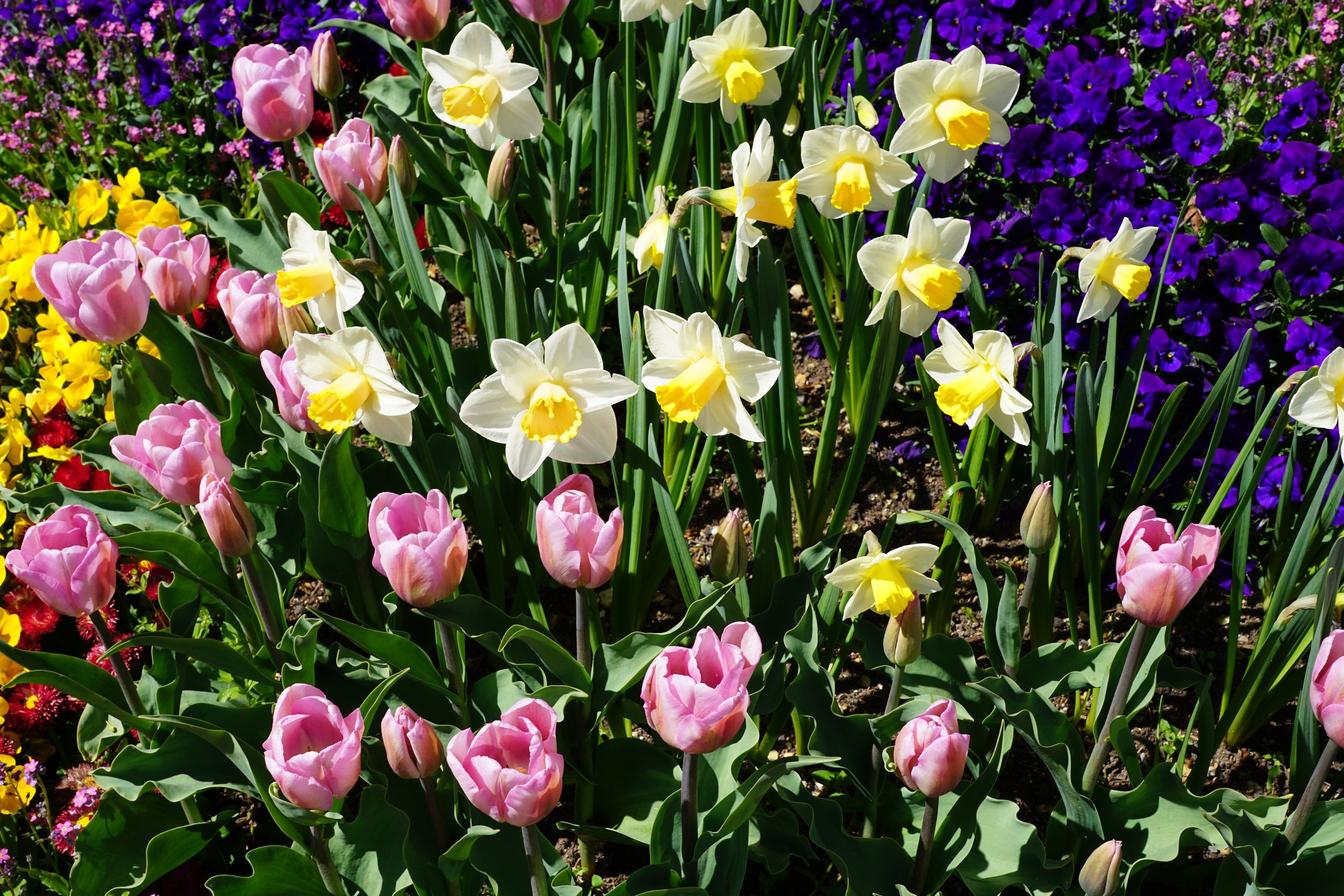
By Paul James
Next spring, will you be one of thousands of people who, while driving or taking a walk, can’t help but notice all the daffodils, tulips, and other beautiful bulbs in bloom, and kick yourself in the butt for not planting them at your place the previous fall? Don’t suffer another spring of frustration due to your procrastination! It’s fall. Time to plant.
Spring-flowering bulbs are a bargain, and they reward you with years – even decades – of blooms. Okay, so tulips often don’t come back, but even they are worth the effort given how gorgeous (and inexpensive) they are. And planting bulbs is really simple – dig a hole, plant the bulb pointy side up, cover, and water. Boom! You’re done. A bulb auger attached to a drill makes the job even easier, enabling you to plant up to 100 bulbs in less than an hour.
But you have to get them in the ground now, or at least now through November. That’s because the bulbs have to be exposed to cold soil temperatures for several weeks to trigger the changes that cause them to bloom in spring. In other words, they have to chill or they won’t thrill.
So, sound the alarm. Tell your friends and neighbors. The time to plant bulbs is now. Or this weekend, anyway. After all, the forecast looks amazing.
Southwood Grown
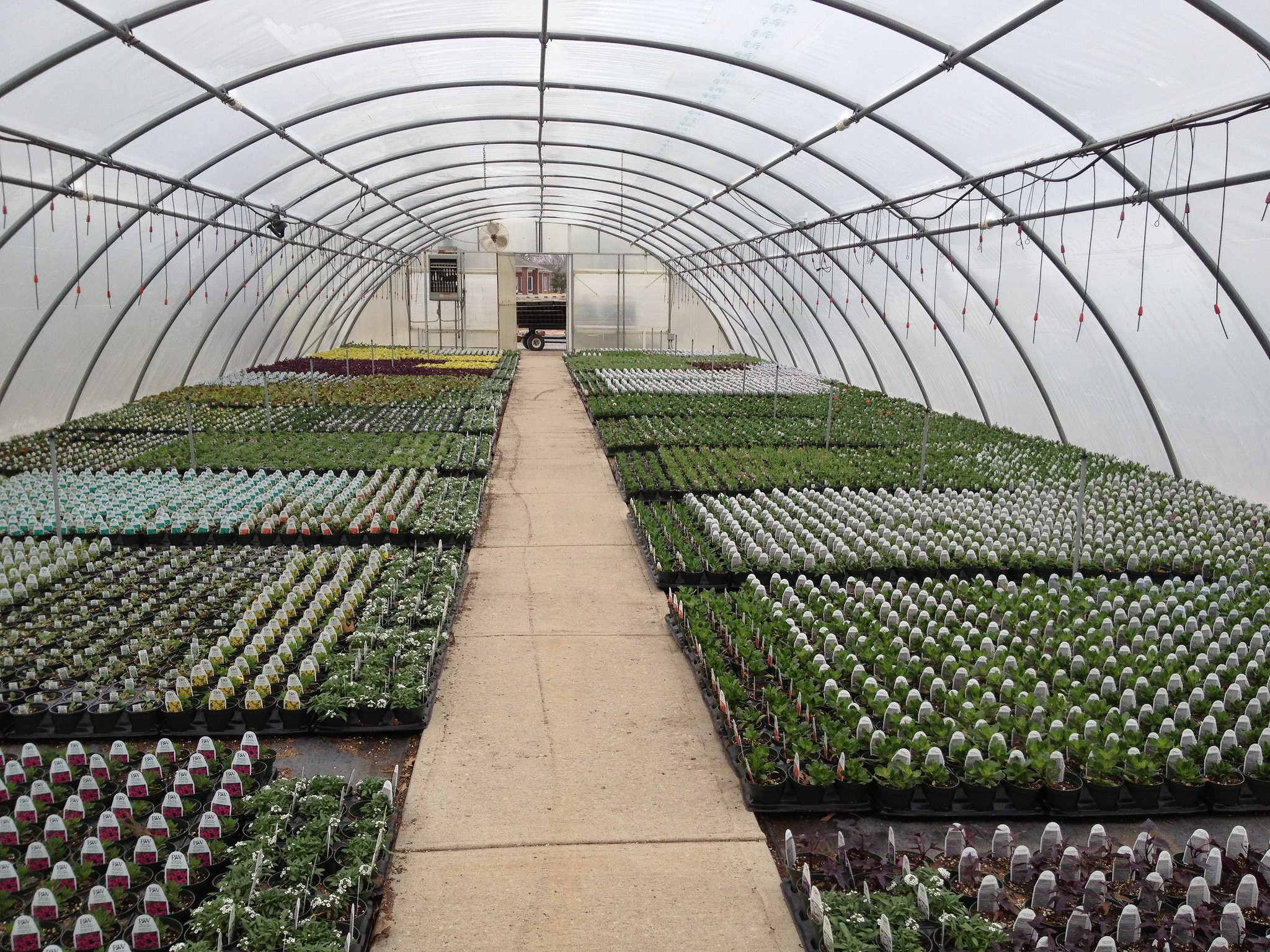
Local is a powerful buzzword these days. It resonates with people of all ages who are concerned about where the products and services they buy actually come from. And for that reason, all kinds of companies try to convince folks that what they have to offer is local. But just how “local” is local?
In the case of Southwood Grown products – annuals, mums, pansies, ornamental grasses, vegetables and herbs, and so much more – you can’t get any more local. After all, our Delaware Production Greenhouses are just over a mile down the road at 108th and Delaware.
So what does that mean to you? In a word, quality. In two words, unsurpassed quality. You think pansies grown in Michigan and trucked a thousand miles are going to be of the same quality as those grown right here in Tulsa? Not a chance. And what about mums? We dare you to compare the quality (and price) of our mums with those at box stores or your neighborhood grocer.
Southwood Grown plants are grown to our exacting standards, and we’re pretty darn picky. They’re acclimated to our local climate, which means they have a far better chance of surviving whatever nature has to throw at them. And because of the close proximity of our production facility, the carbon footprint associated with transporting them is practically nil.
Now that’s local. And that’s Southwood Grown.
It’s Fall – Time to Plant!
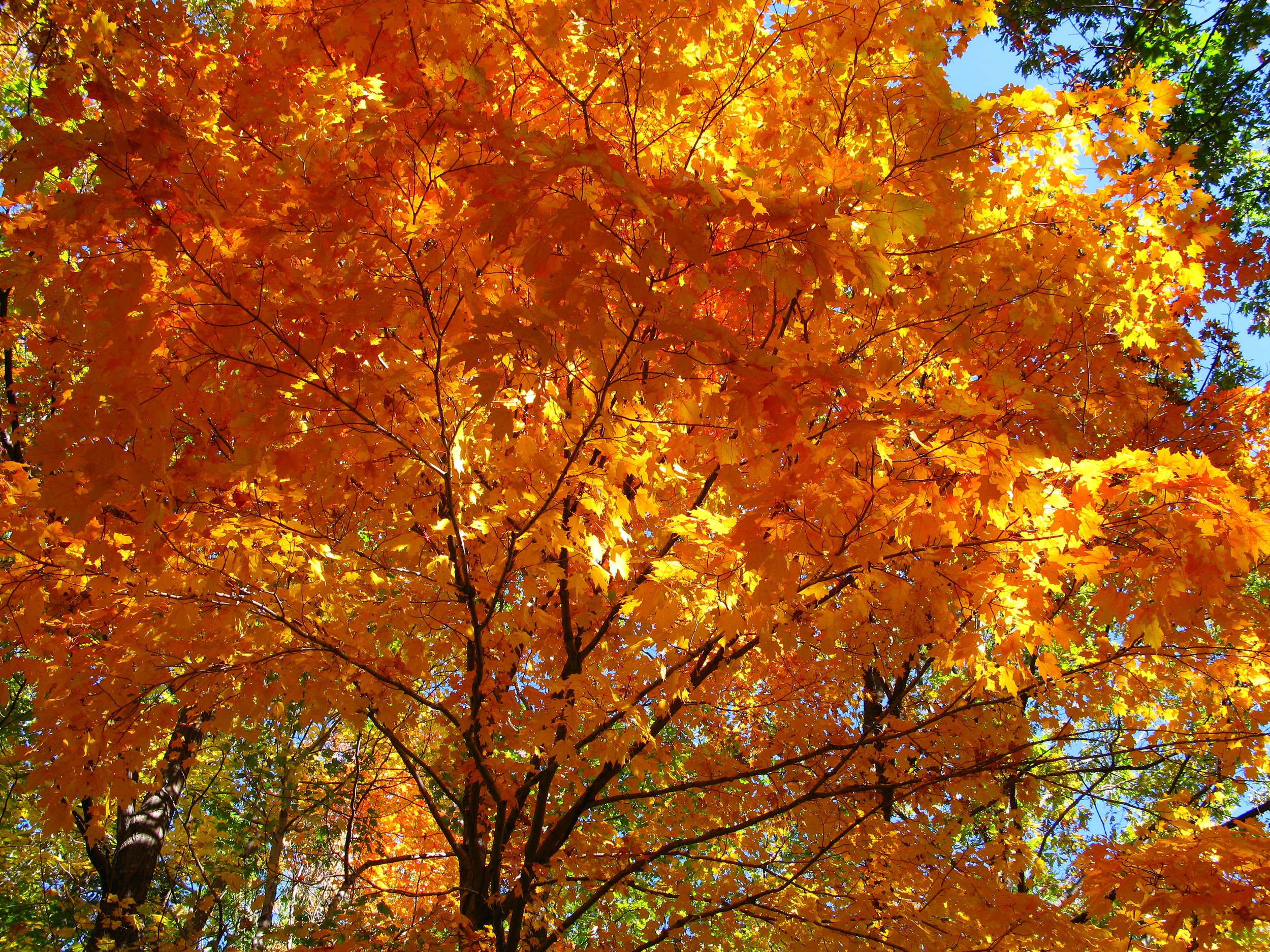
By Paul James
Every year I get on my soapbox to remind people that now is the perfect time to plant all kinds of things, and this year is no different. But to be clear, I’m not talking about things that most folks know to plant in fall – mums, pansies, asters, ornamental kale and cabbage, cool-season veggies, fescue and rye grasses, spring-flowering bulbs – the stuff that practically defines fall planting. I’m talking about practically everything else, in particular trees, shrubs, and perennials.
The reason I’ve harped on the subject for so long is that I’ve witnessed firsthand for decades the enormous difference fall planting makes. Allow me to explain by getting to the root (or rather, roots) of the matter.
Planting in the fall gives roots a chance to grow quickly, because the plant isn’t forced to devote near as much energy toward producing foliage or flowers or fruit as it is in spring. Instead, it devotes nearly all of its energy into producing roots, a process that continues for weeks, even months. The reverse is generally true in the spring – a plant’s energy is devoted to new top growth at the expense of root growth.
Consequently, what you plant in fall will be far more prepared for the surge of new growth in spring, and be far better equipped to handle the heat of summer, thanks to its larger root mass. And fall planting greatly reduces the chance of transplant shock, largely because air temperatures are cooler and rainfall is more dependable.
Don’t get me wrong: I’m not saying you shouldn’t plant trees, shrubs, and perennials in spring. But I am saying that given a choice, I’d opt to plant the vast majority of plants from those categories in fall. And so should you.
Fall is for Fescue!
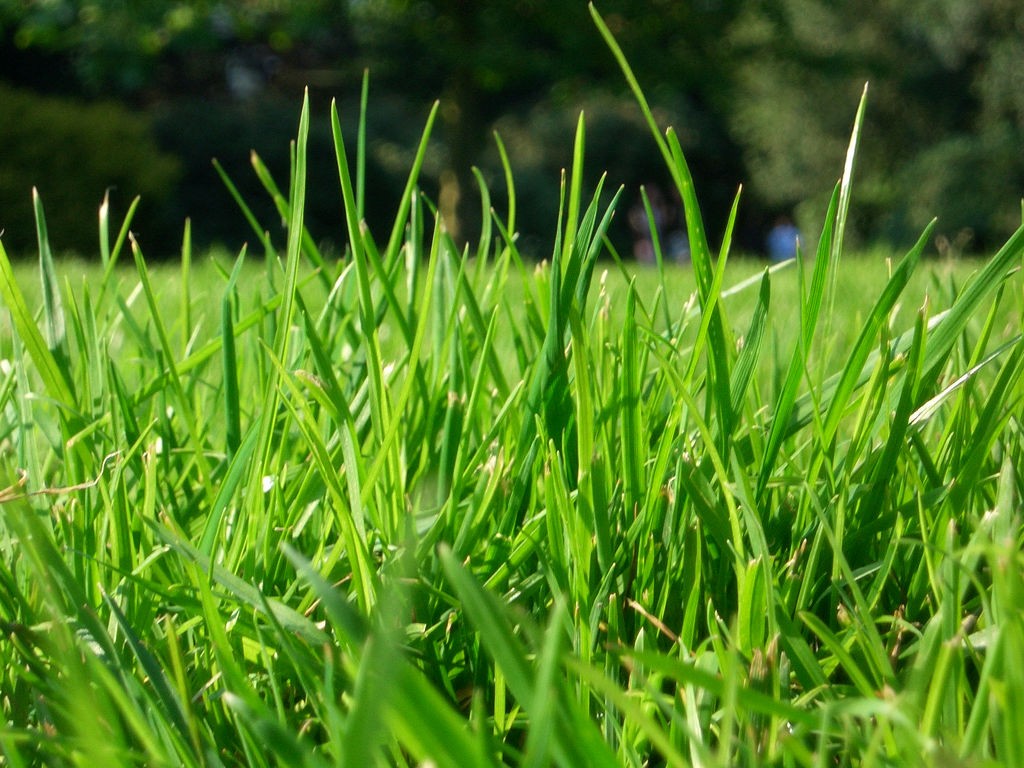
By Paul James
Fescue is originally from Europe. It didn’t arrive in this country until the mid-19th century, but it’s been happy here ever since, first as a pasture grass and later as a turf grass in lawns across America. Here in Green Country, fescue is the go-to turf for shady spots, where it thrives with a little fertilizer and regular watering.
Because it’s a cool-season grass, fescue must be planted in spring or fall. Lots of diehard lawn lovers plant it twice a year and that’s not a bad idea, but fall planting tends to yield better results. Planting from seed is a simple, straightforward, and relatively inexpensive process that requires little effort.
It’s best to use a blend of seeds that contains only tall fescues, or one that contains tall fescues blended with fine fescues, Kentucky bluegrass, or even ryegrass in varying percentages, rather than rely on a single variety. I’ve tried dozens of blends over the years, and while I’ve seen subtle differences in them, I truly believe that the best way to choose one over another is a coin toss.
To prepare your lawn for seeding, begin by cleaning up any sticks, leaves, or other debris, then mow the lawn one notch lower than usual. In areas where the existing grass is really thin or there’s bare soil, use a metal rake to gently loosen the soil. Sow the seed with a drop or broadcast spreader (or by hand if the area is small), being careful not to get seed in adjacent flower beds. Consider saving a pound of seed (which, by the way, is equal to 275,000 seeds!) to fill in any spots you might have missed – they’ll be obvious after the grass is up and growing.
The most important consideration when getting seed to germinate is even moisture, because dry seed simply will not sprout. Typically, that means watering every day (perhaps twice a day) just enough to keep the top ¼-inch or so of soil moist. You should see germination within seven to ten days.
Once the grass is up and growing, lightly fertilize and begin mowing when the leaf blades are about four-inches tall. Routinely rake or blow leaves as they fall so they don’t matt down and smother the grass.
Do all that, and you’ll be able to enjoy the green, green grass of home all winter long.
The Beauty of Bulbs
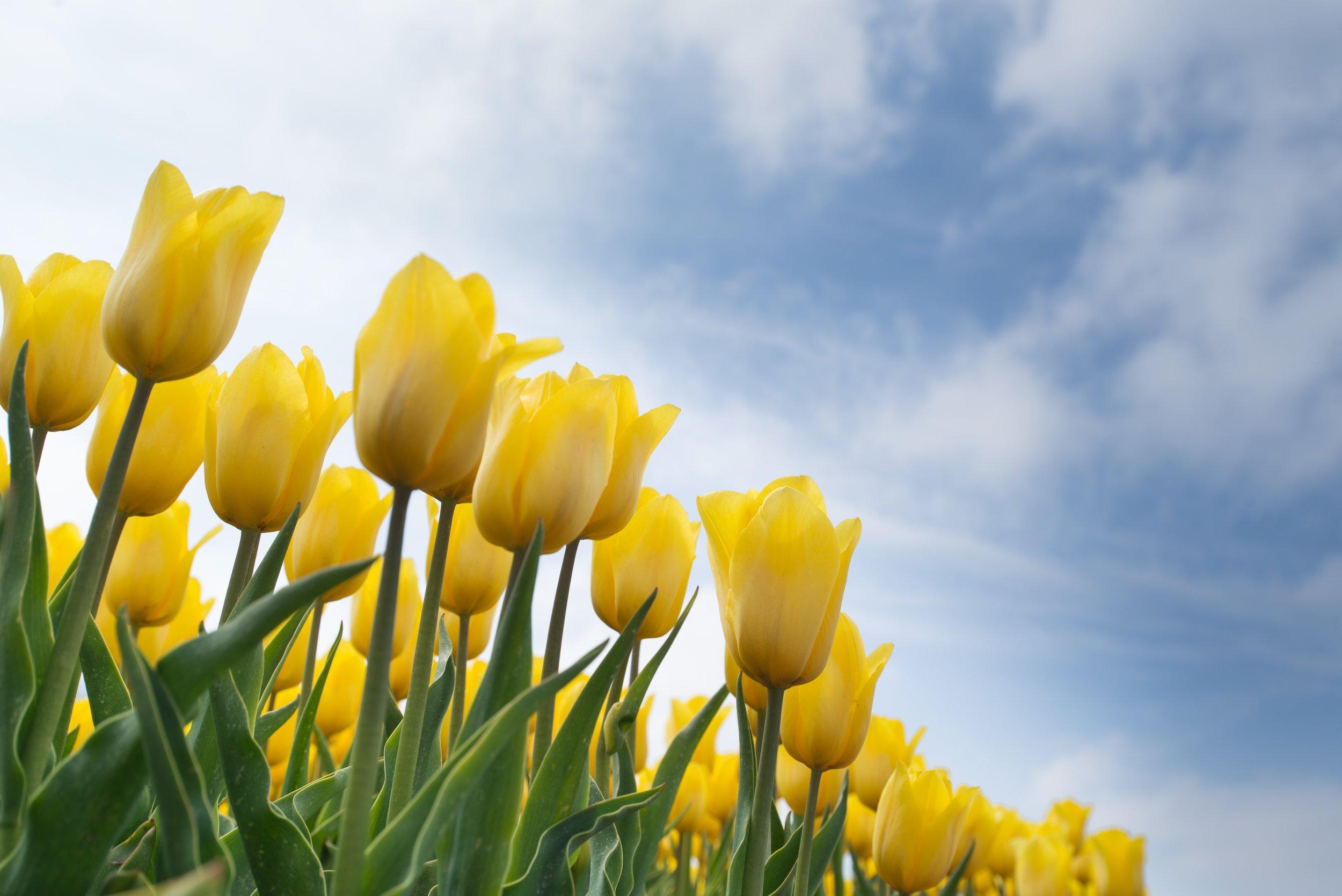
By Paul James
No other plant on the planet gives you more bang for your buck than a single, solitary, spring-flowering bulb. Think about it: in most cases you shell out less than a buck per bulb and in a few months you wind up with a gorgeous flower that’ll return year after year for decades. And in that time all the plant requires is an occasional drink and a light snack.
Spring-flowering bulbs are, in fact, among the most carefree plants you can grow, and they’re pretty much pest and disease free. They’re also a snap to plant with a trowel, mattock, auger bit, or specialty bulb planter. Once you get a rhythm going, you’ll be amazed at how fast you can get them in the ground.
Bulbs typically begin arriving in nurseries a month or so before the ideal planting time, and it pays to shop early to make sure you get what you want. Just store them in the garage in a paper bag and they’ll be fine for up to a month. As for planting times, I usually start around the first week of October and finish by early November.
And just what do I plant? Well, I’ve always been partial to daffodils. They come in a dizzying array of sizes, colors, and bloom periods, and they’re one of the few bulbs gophers won’t eat. Best of all, they spread, but in a good way. I also love crocuses, both spring and fall bloomers, and fritillarias. In recent years I’ve grown fond of the alliums for the big, bold statements they make, and the pollinators they attract.
And then there are tulips. There was a time when tulips weren’t my thing, largely because with the exception of the Darwin hybrids, they tend to behave as annuals. But I’ve changed my tune in recent years. After all, even if they don’t come back, they’re so spectacularly beautiful that having the opportunity to enjoy them for a few weeks is better than not enjoying them at all.
There are also lots of so-called lesser or minor bulbs to consider as well, including Alliums, Fritillarias, Galanthus (Snowdrops), Leucojum (Summer Snowflake), Scilla (Siberian Squill), Puschkinia (Squill), and, my favorite, Camassia. If you’re planting bulbs anyway, you really should try a few of these not-so-well-known but beautiful bulbs.
Conifers & Evergreens
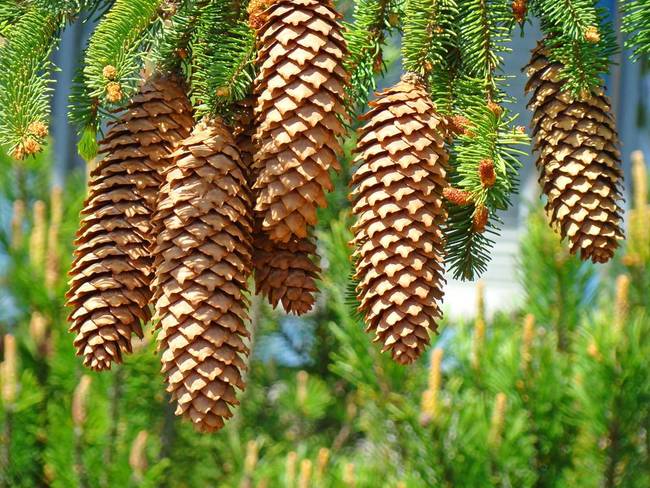
By Paul James
Is there a difference between conifers and evergreens? You bet there is. And at the risk of making your head spin, let me make one critical distinction right off the bat by saying not all conifers are evergreens and not all evergreens are conifers. How’s that for clarifying the matter? Hey, I don’t make the rules!
So here’s the deal — a conifer is any plant that produces cones. Simple enough, right? The most familiar in area gardens are arborvitaes, cedars, cypresses (and false cypresses), junipers, pines, spruces, and yews, but in other parts of the country you’ll also find firs, hemlocks, and redwoods. And because these particular conifers keep their leaves (or needles) throughout the winter, we commonly refer to them as evergreens (even though their foliage may be blue or golden-yellow or even bronze).
And that’s all well and good up to a point. Problem is, some conifers – ginkgoes and bald cypresses, for example — are deciduous, meaning they lose their leaves in winter. It’s no wonder folks get confused!
Now consider azaleas and hollies. They’re evergreens, but they don’t produce cones. The same is true of aucubas, laurels, magnolias, and photinias. Collectively, those plants are generally referred to as broad-leaf evergreens, whereas conifers are often called needle-leaf evergreens, even though not all conifer leaves are needles.
And now that you know the difference between conifers and evergreens, allow me to focus for a moment on the former, because it’s no secret that I’m a conifer geek.
One of the reasons I’m drawn to conifers is that they’ve been on the planet for so long, at least 250 million years in some cases. And they managed to survive a devastating asteroid that wiped out just about every other living thing on earth, including 75% of plant life and all the dinosaurs (but sadly, not cockroaches). I think that’s cool.
Beyond their history, however, I’m fascinated by their diversity. To my mind, no other plant group offers so many varied sizes, shapes, and textures. There are conifers that never grow taller than a few inches, and others that become giants. There are globe-shaped conifers, pencil-thin conifers, and conifers that are so distorted and contorted that only a geek like me would grow them. And there are conifers with stiff foliage (ouch!) and others with foliage so soft it was once used as bedding material.
Years ago I read that landscapes should include at least 30% evergreens so that they’re not so drab in winter. I’d bump that figure to at least 60%, with the majority of them conifers. Evergreen conifers, that is.
Countdown to Fall…Finally!
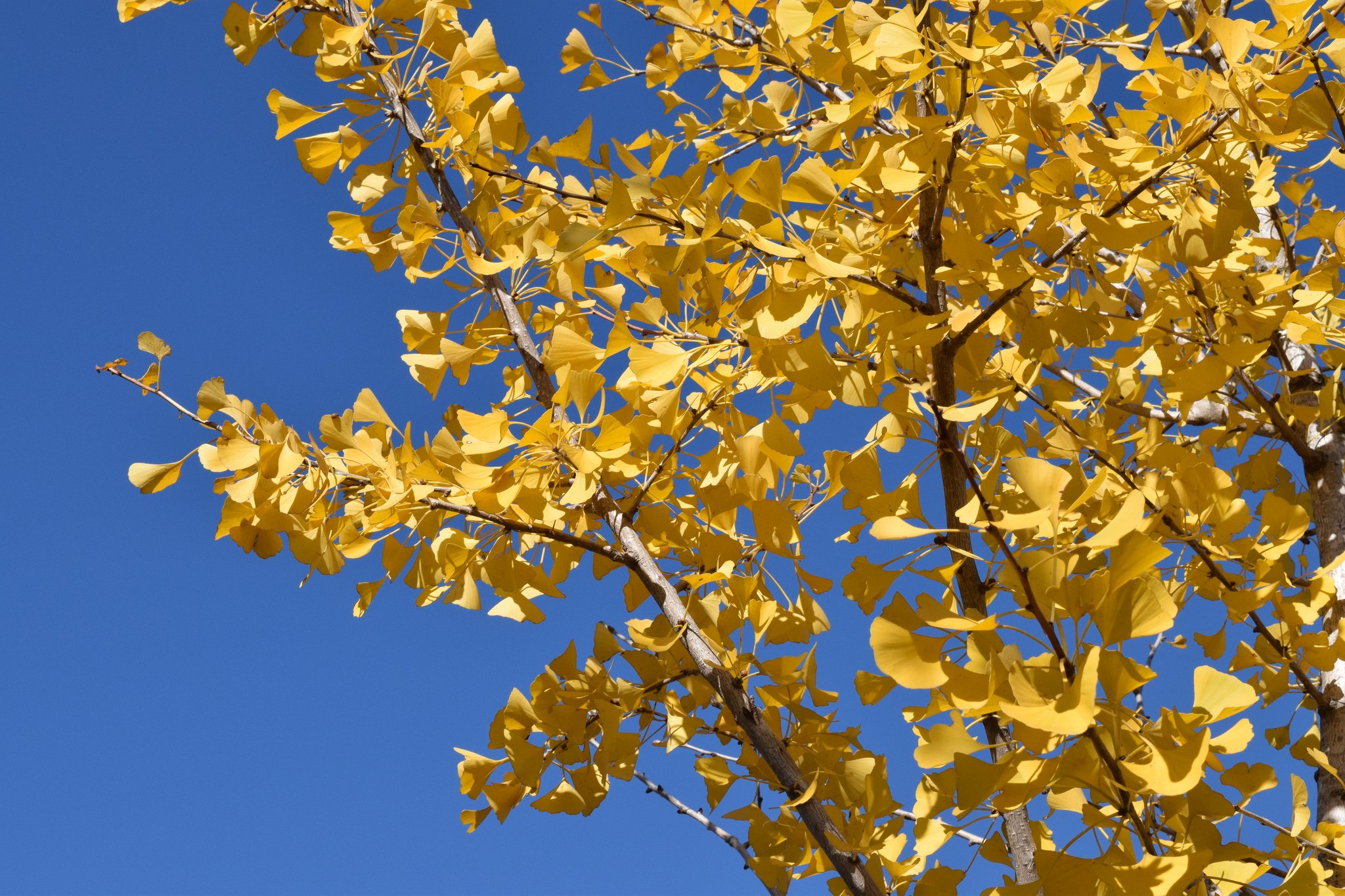
By Paul James
Despite this week’s heat wave, we all know that cooler temps are on the way and we’ll return soon to working in our gardens blissfully rather than gloomily. And I can’t wait for two reasons. One, I don’t enjoy gardening in the heat of summer. And two, fall is for planting!
That’s right. Fall is the absolute best time to plant a number of things, and in the weeks to come I’ll explain exactly why that is. But for now I want to get you thinking about what to plant this fall.
Trees and Shrubs
Starting now and continuing until the ground freezes (assuming it ever does), focus on planting most deciduous and evergreen trees and shrubs, including conifers. Seriously, folks, do yourselves a favor and get your trees and shrubs in the ground soon.
Perennials
You absolutely can and should get perennials in the ground as well, and that includes both herbaceous and woody types. Plant now and they’ll come on strong in spring; plant in spring and they’ll just sit there for weeks.
Turf Grass
Cool-season turf grasses such as fescue and rye can be planted from seed in the spring and fall, but fall is definitely the better of the two seasons, typically from mid-September to mid-October. Sowing from seed is simple and much cheaper than sod.
Fall Veggies
If you never had a fall vegetable garden, you’re missing out! As for what to plant (beginning now and continuing through at least September), go with everything you planted in spring, focusing especially on greens such as lettuce, spinach, kale, and so on, as well as root crops – beets, carrots, and turnips.
Mums, Pansies, and Assorted Annuals
Fall gardening is practically defined by mums and pansies, but keep in mind that lots of annuals are actually quite hardy, including Portulaca, Marigolds, and Petunias. And don’t forget ornamental Cabbage and Kale, both of which can handle temps in the mid-20s.
Bulbs
Planting time is still a month away, but planning time starts now. Have a close look at your existing flower beds and identify spots where a few bulbs would make a big difference in spring, or consider replacing large swaths of lawn with a sea of spring-flowering bulbs.
Organic Matter Matters
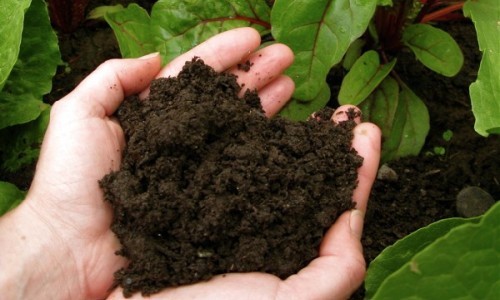
By Paul James
I love to watch folks at the nursery as they check out just to see what they’ve got in their carts. Sometimes I try to imagine where the conifers or ornamental grasses or whatever else they bought will wind up in their landscape. Mostly I just get excited knowing that every plant that goes out the door will soon be set free from the confines of its pot and given a permanent home.
But I’m more than occasionally disturbed by what I don’t see in customers’ carts, namely soil amendments, a catchall term that refers to any number of different products (usually sold in bags) that contain organic matter. Because without organic matter, you won’t have healthy soil. And without healthy soil, you won’t have healthy plants. That’s just the way it is.
So what is organic matter, and why does it matter so much? Organic matter includes leaves, grass clippings, plant refuse, composted animal manures, agricultural byproducts (such as cotton burrs and alfalfa meal) – pretty much any organic material that decomposes. It matters because it’s the source of food for all the critters that inhabit the soil. As they feed on the organic matter in the soil and leave their deposits behind, they improve the soil’s structure, tilth, water-holding capacity, nutrient content, biological activity, and so on. In other words, they keep the soil alive.
There are lots of ways to add organic matter to soil. Using a mulching mower is a great way to add a steady dose to the lawn, and mulching leaves directly into the lawn in fall works wonders. In flower and vegetable gardens, as well as the lawn, a two-inch topdressing of organic matter in the form of homemade compost, shredded leaves, or a bagged, composted product will in time transform so-so soil into super soil.
So whether you opt for a store-bought, bagged product or your own homemade compost, make the addition of organic matter to your soil a routine – as in once or twice a year — practice. Your plants will be far healthier as a result, which means they’ll be far less likely to be attacked by pests and diseases, which means you’ll have a better looking garden. And that matters, too.
Fall in Love with Fall Gardening!
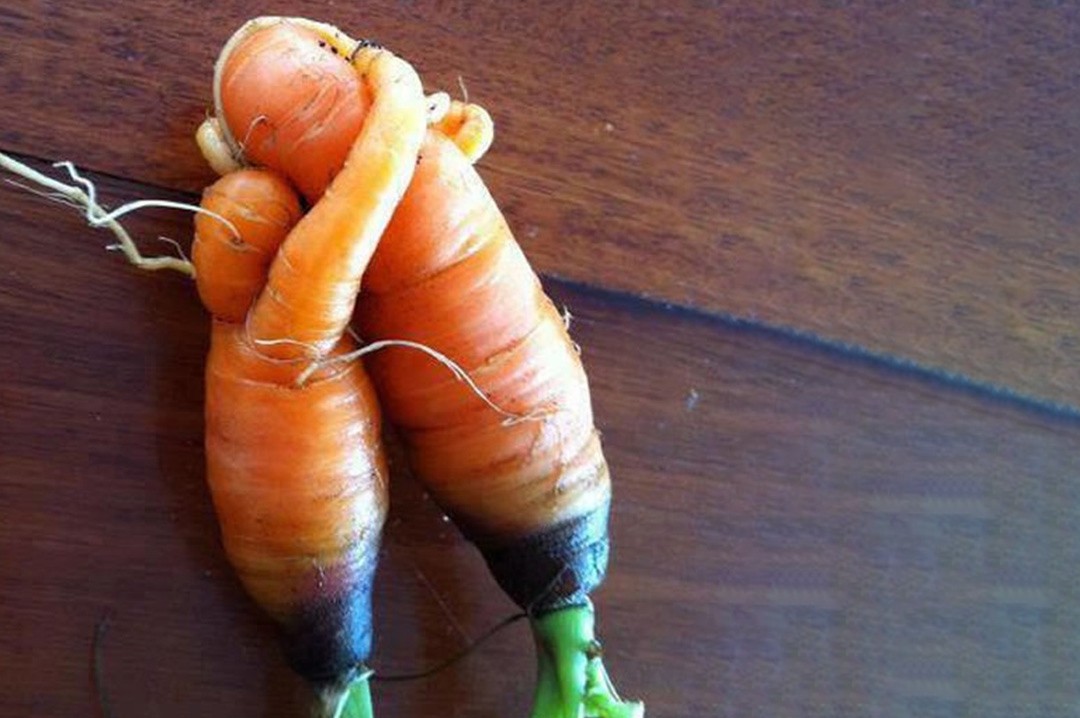
By Paul James
If I had only one season in which to plant a vegetable garden, it would be fall. No doubt about it. And the reason is simple: vegetables harvested in the fall taste better. No doubt about that either. And just what will I be planting, you ask?
Well pretty much everything I plant every spring, with the exception of asparagus, and that’s a long list, one that I now present in alphabetical order. The asterisk indicates those that I stick in the ground as transplants. All others I direct sow in the garden from seed.
Arugula Kohlrabi
Beets Lettuce
*Broccoli Mustard Greens
*Brussels Sprouts Onions
*Cabbage Potatoes
Carrots Spinach
*Cauliflower Swiss Chard
Collards Radishes
Kale Turnips
Planting veggies in the fall is a tad tricky, because everything on my list is a cool-season crop, yet it’s anything but cool this time of year. And it’s not just the air temperature that presents a problem – it’s the soil temp as well. So here’s what you need to do to ensure a successful fall planting.
1. Start planting now, and make successive sowings into mid-September or beyond.
2. Plant seeds and transplants late in the day, so they aren’t subjected to the hot sun immediately after planting, or wait for an overcast day to plant.
3. Plant seeds roughly twice as deep as you would in spring (check the seed packet for planting depth). It may take them longer to germinate, but they’ll be fine.
4. Water every morning and again every evening. Water just enough to keep the top inch or so of soil moist and cool. If you’ve got a drip irrigation system, good for you. Follow the same schedule.
5. Spread a light layer of mulch over the planting area to conserve moisture. Grass clippings work great, as do hay, compost, or bagged products such as Happy Frog or Coco Loco soil conditioners.
6. As seeds begin to germinate, water a little longer, but continue to water twice a day until plants are established and temperatures begin to cool off a bit, then water only as needed.
Do all that, and you should have plenty of tasty veggies to enjoy for weeks on end. And don’t worry too much about frosts. Everything on my list is not only frost tolerant (down to about 27 degrees or so), but their flavor actually improves when they get nipped by frost (the plants produce more sugars in response to colder temperatures). In fact, I’ve harvested carrots and spinach and beets and kale on Christmas morning many a year, and that’s about as good a present as I could hope for.
Success with Succulents
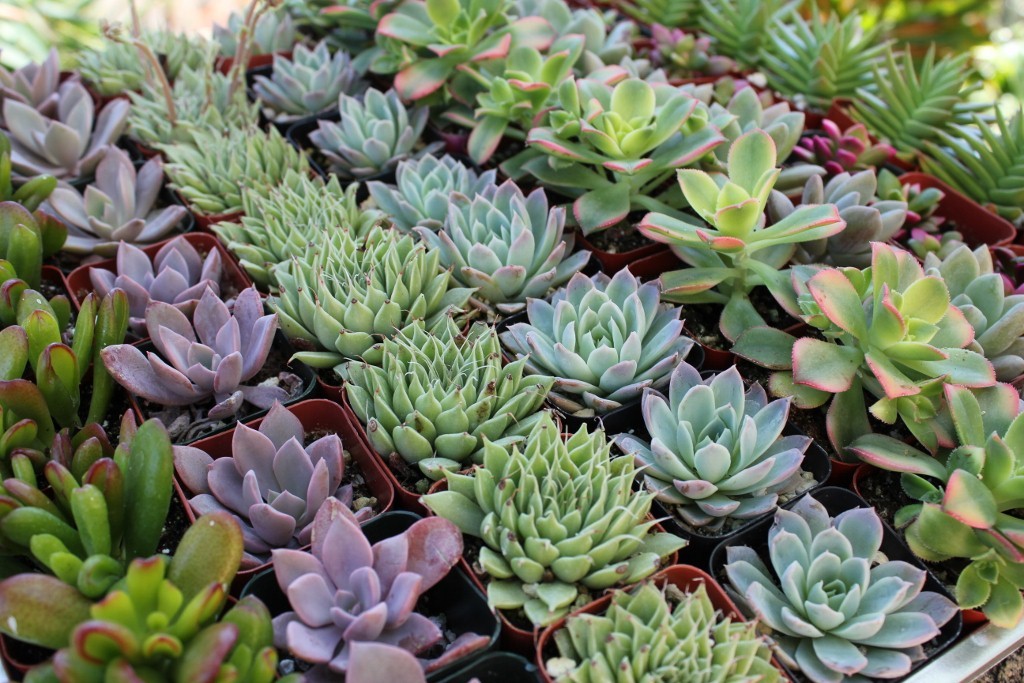
By Paul James
Twenty years ago, I spotted a sign on a variety of sedum called ‘Autumn Joy’ that claimed the plant would “thrive on neglect.” Convinced the phrase was nothing more than marketing blather, I took one home, stuck it in a one-gallon terra cotta pot, and vowed never to water it, fertilize it, or intervene in its life in any way. I figured it might last a year, maybe two. I was wrong.
Because today, that same sedum is still going strong, and if that isn’t testament to the toughness of the plant, I don’t know what is. After all, it’s been through every temperature extreme imaginable, including single-digit cold and triple-digit heat. It’s been covered in ice and snow again and again. It’s been rain soaked and sitting in soggy soil for days on end.
Guests have poured their drinks on it. Dogs have hiked their legs on it. And I’m pretty sure that one night, after partying a bit too hard, I also might have…well, never mind.
The point is succulents — and sedum (also called stonecrop) is a type of succulent — actually do thrive on neglect, and that includes all succulents, both indoor and outdoor varieties, as well as cacti. Of course, I’d never suggest you put them to the test the way I did, but I would suggest you not intervene too much in their lives, and follow these simple suggestions for succulent success.
DON’T OVERWATER. From late spring to late summer, water indoor succulents no more than once a week. From fall through early spring, water maybe once every three or four weeks. Except during extreme periods of drought, outdoor varieties rarely need to be watered. In fact, overwatering is the fastest way to kill them.
THINK TWICE BEFORE FERTILIZING. Truth is, succulents will be perfectly happy without any fertilizer, and if you feed them too much or too often, they’ll croak. At the most, fertilize once a month during spring and summer, and not at all during fall and winter.
GIVE THEM PLENTY OF LIGHT. Although most succulents are native to desert regions of the world, they actually do best outdoors in this area when protected from late afternoon sun. Too much light – combined with hot temps — can lead to sunscald. Indoors, they need at least a half day of bright, indirect light.
REPOT ROUTINELY. Succulents respond well to annual repotting with a mix specifically blended for them. Espoma makes one that’s ideal. Best time to repot is spring.
Enjoy your succulents. Just remember not to kill them with kindness.
Mosquito Alert!
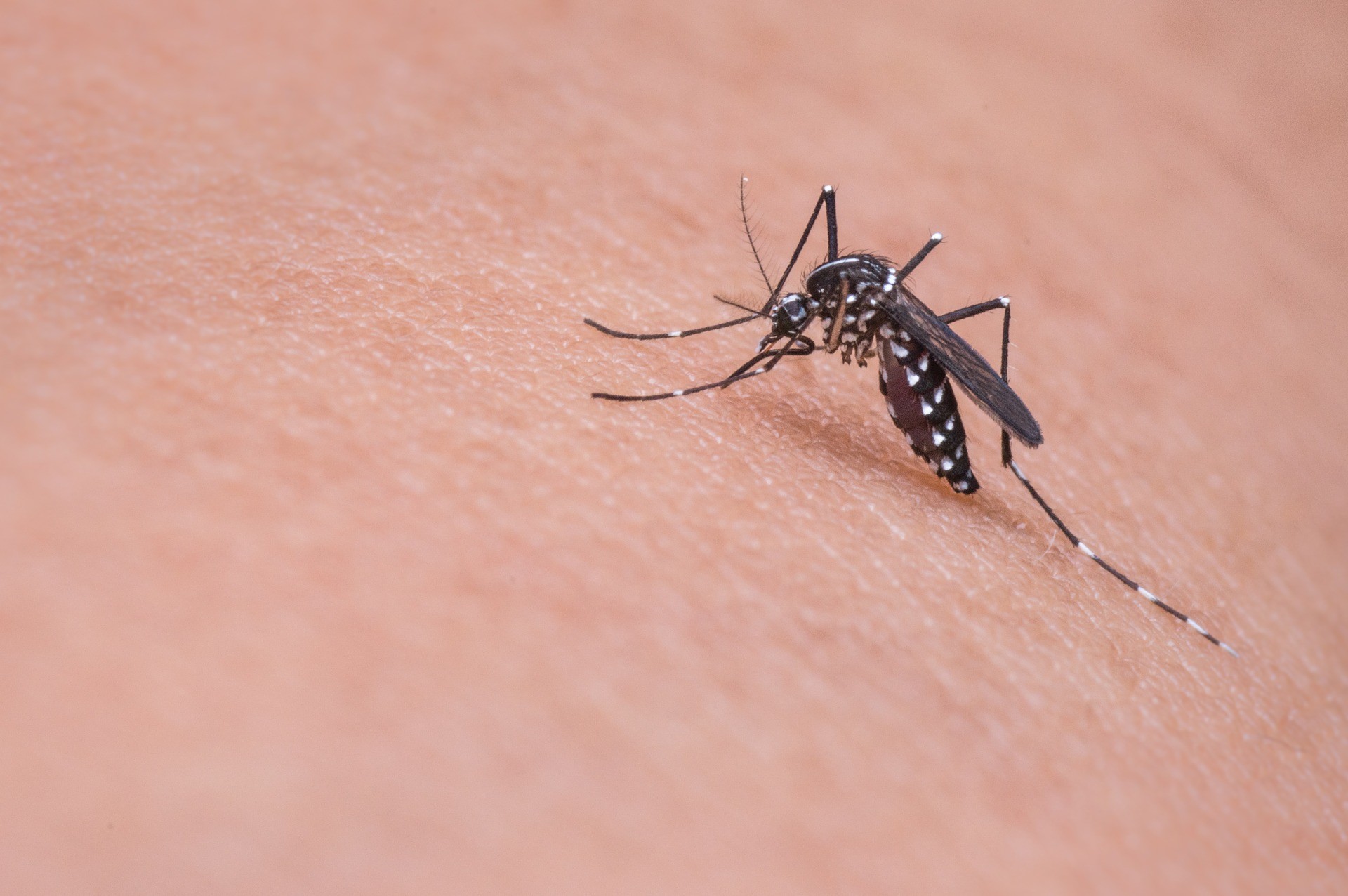
By Paul James
A small percentage of people on the planet don’t get mosquito bites. I’m one of them. My daughter in law and granddaughter, on the other hand, can be sitting right next to me on the patio and get two dozen bites in five minutes. So what gives? And what can they do to protect themselves?
First, the what gives. Turns out mosquitoes don’t like the way I smell, and according to microbiologists who study such things, that’s due to a particular scent emitted by the trillion or so bacteria that inhabit my skin. (And for the record, most people think I smell just fine, thank you.)
But the bacteria that live on my daughter’s and granddaughter’s skin emit an odor that’s apparently and unfortunately attractive to mosquitoes, which explains why they’re both basically mosquito magnets. And by the way, there’s nothing they can do to change that.
Now let’s talk protection. First and foremost, you have to eliminate the habitat mosquitoes love, and that’s standing water – in plant saucers, in wheelbarrows, in clogged or sagging gutters, in kiddy pools – anywhere and everywhere water remains for more than a few hours. And you’ve got to encourage your neighbors to do likewise, because mosquitoes can travel from their yard to yours.
Bt dunks, donuts, or granules should be used in birdbaths, water features, holes in trees where water collects, and anywhere else standing water can’t be eliminated. Bt (Bacillus thuringiensis israelensis) is an all-natural biological control that targets only mosquito larvae, and it’s extremely effective.
Beyond that, you need to rely on repellents, of which there are many. When trying to control mosquitoes on the patio, options include citronella candles (which may also contain rosemary, thyme, and other oils), incense sticks that also contain those and other oils, and various sprays. Deet is still the most effective spray, but a lot of folks think it’s harmful, despite considerable research to the contrary. Picaridin, an alternative to Deet that was developed in Australia, has for decades been used there and throughout Europe with no reported health risks. Plants such as citronella and lemon grass, despite what you may have heard or read, simply do not work unless you crush the leaves and rub them on your skin. However, a powerful fan will work because mosquitoes can’t fly in winds above 7mph.
For broader control, there are also repellents that contain various natural oils, are pleasantly scented, and can be applied as granules or sprays to the entire yard. Many of them last for up to three weeks depending on rainfall. And there are chemical foggers, including automated systems that spray chemicals in the air at preset intervals. I’m not too keen on having chemicals in the air while I’m hanging out in the yard, but then I’m the guy who doesn’t attract mosquitoes.
As for bat and purple martin houses, research makes it clear that while they do indeed eat mosquitoes, neither can eat enough in a day to make a noticeable dent in the population. After all, even though female mosquitoes generally don’t live longer than a week, they lay up to 300 eggs a day.
And finally, there’s one sure way to attract mosquitoes, and that’s to drink a beer. Mosquitoes are attracted to carbon dioxide, and there’s plenty of that in the beer and in the belches that invariably follow.
What’s in a Name?
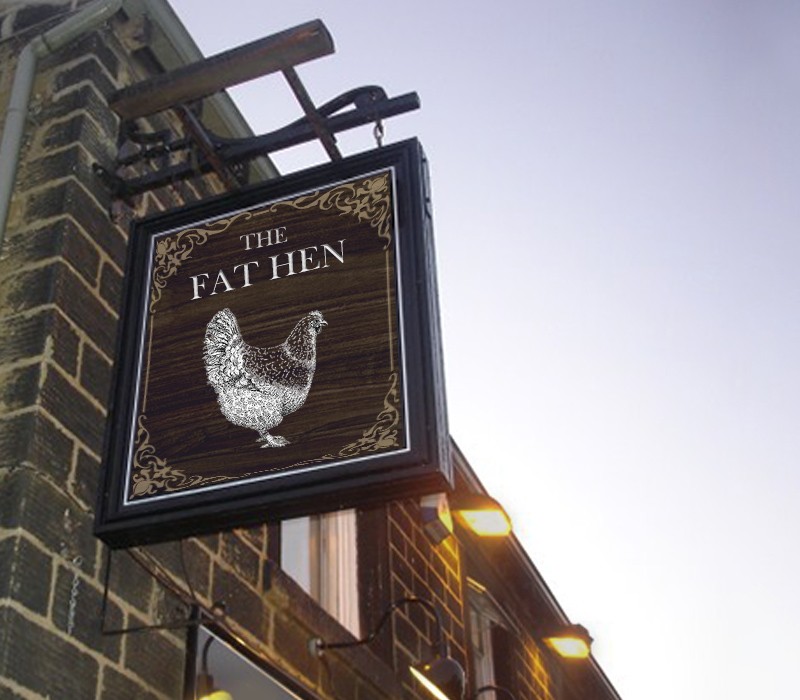
By Paul James
Ever heard of a Gallant Soldier, Fat Hen, or Good King Henry? Although they could pass for the names of British pubs, they are in fact common names of plants. And like most common names, they typically require some explanation. Take, for example, the tomato known as ‘Radiator Charlie’s Mortgage Lifter.’
During the Great Depression, Marshall Cletis Byles of Logan, West Virginia, owned a radiator shop cleverly situated at the bottom of a steep hill where trucks regularly overheated. In his spare time, Byles – who went by the moniker Radiator Charlie — experimented with cross pollinating tomatoes, and after six years of breeding he wound up with his prize: a disease-resistant tomato capable of producing four-pound fruits that were downright delicious. Word quickly spread about ‘Radiator Charlie’s’ tomatoes, which he sold for a whopping $1 each, and over the next six years he was able to pay off his mortgage with the proceeds, at which point he changed the tomato’s name to ‘Radiator Charlie’s Mortgage Lifter.’ And by the way, the variety is easy to find to this day and is definitely worth growing.
Other oddly named veggies include ‘Howling Mob’ corn, a turn-of-the-century variety that was named by the breeder after he’d sold out of seed one day at the market, which caused customers to get quite unruly. Then there’s ‘Lazy Housewife,’ one of the first stringless pole beans that saved time and effort in preparation. The names ‘Mostoller Wild Goose’ and ‘Turkey Craw’ beans have similar origins, as both were found in the gullets of birds that had been shot for dinner. And another tomato, ‘Myona,’ was brought to America by an Italian immigrant who sold his prized crop from a pushcart on the streets of New York. When asked if the variety had a name, he replied, with a thick accent, “It’s a my own a.”
Among flowers, the aforementioned Gallant Soldier, a member of the daisy family is a corruption of its botanic name, Galinsoga. Fat Hen is another name for Lamb’s Quarter, a common weed that chickens and turkeys are known to gobble up. And Good King Henry is a species of goosefoot that’s also called Poor Man’s Asparagus, Lincolnshire Spinach, Markery, and English Mercury.
Then there’s Bastard Toadflax, Butter and Eggs (AKA Yellow Toadflax or Brideweed), Turkey Corn (a type of bleeding heart), Mother-in-Law’s Cushion (a cactus!), Kiss-Me-Over-the-Garden-Gate (prized by Thomas Jefferson, it’s a pretty member of the genus Persicaria, and can be invasive), and Love-in-a-Puff (whose seed pods burst to reveal a heart-shaped internal structure).
And yes, there are numerous common names that have been around for centuries, but which might cause more than a few readers to blush, as they refer to various body parts, both male and female. I’ll leave you to do your own research into the naughty ones. There are also legitimate botanical names that have entered the lexicon and continue to cause a stir, notably (and my personal favorite) the Latin name of a flowering shrub that is a Heath, but which is known taxonomically as Erica canaliculata.
Honestly, I’m not making this up.
Ants: Friends or Foes?
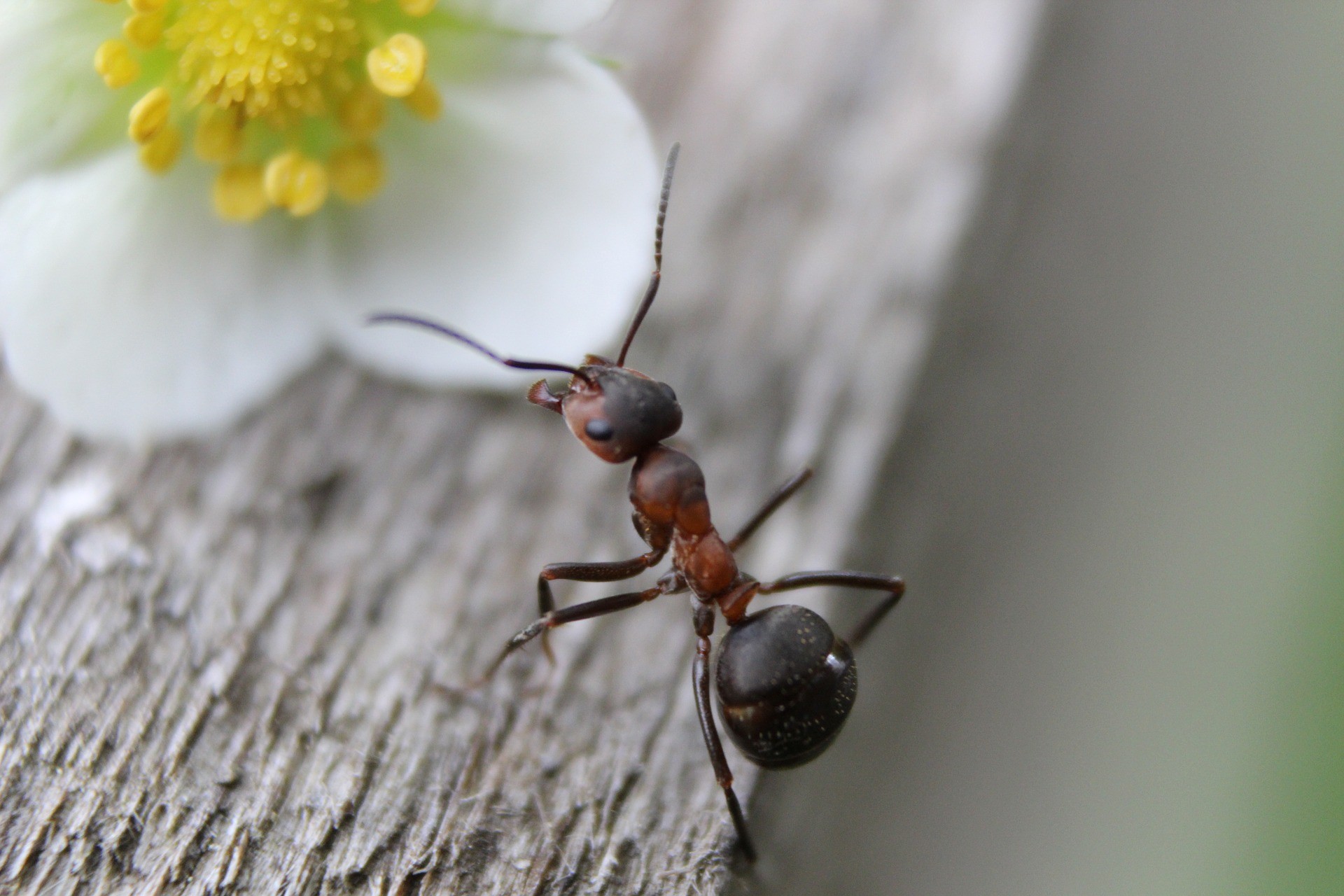
By Paul James
I get asked so many questions about ants that some days I just want to scream, “Uncle!” So let me just say right off the top that most ants aren’t bad. In fact, most ants are enormously important little critters. And rather than seeing them as pests in the garden, I suggest you think of them as partners. Here’s why.
Ants are recyclers. Red and black tunneling ants commonly found in lawns and gardens scavenge the soil in search of dead insects and a host of other organic nibbles and turn them into fertilizer. They also aerate the soil and redistribute nutrients along the way.
Ants are predators. Several species of ants feed on fleas, fly larvae, and termites, as well as the larval and adult forms of numerous garden pests.
Ants disperse seeds. A number of wildflowers depend exclusively on ants for dispersal of their seeds, including bleeding hearts, bloodroot, trillium, trout lily, wild ginger, and violets. In fact, these plants are thought to actually time their bloom period for when ants are most active.
Ants protect plants. Ants are attracted to the sweet nectar found on plant stems and the bases of flowers, and while feeding they also patrol the plants and keep insects from attacking them. A familiar example of this is seen on peonies in late spring. Ants crawl all over the sticky flower buds devouring the sweet nectar, and in return they protect the peony from potential pests. (There is disagreement over the popular notion that ants actually help the flowers open.)
Ants are custodians. Leave a few crumbs or other morsels on a picnic table, and overnight they’ll likely be gone thanks in part to ants, who are extraordinarily gifted at finding and hauling away scraps of just about any and every food type.
Ants are food for others. Let’s not forget the way the food chain works – sometimes you’re predator, sometimes you’re prey. And ants are an important food source for other insects, spiders, frogs, lizards, birds, fish, some mammals, and even people (don’t knock them ‘til you’ve tried them).
Of the nearly three dozen ant species in Oklahoma, only two are cause for concern. Carpenter ants (red or black) are one of the largest species common in our area, and over long periods of time they can cause damage to trees and wooden structures, including homes. They don’t actually eat wood, but they do chew it as they tunnel. They probably should be controlled, especially when populations get out of control.
And of course there is the red imported fire ant that lives outdoors and whose sting packs a mighty wallop. They’ve been sighted in Tulsa and a few surrounding counties, and they’ve become prevalent in southern Oklahoma. If you suspect these little monsters have inhabited your yard, you definitely want to take steps to get rid of them.
In the home, I can see how most people might view them as pests. But in all fairness, household ant invasions are largely the result of our own doing, meaning they aren’t likely to stick around if food sources aren’t available (juice spills on countertops, grease on stovetops, ripe fruit sitting out, for example.)
If you’re compelled to get rid of ants, there are several effective products on the market, most of which contain some form of boric acid (Borax) or synthetic pyrethroid. Diatomaceous earth is an excellent organic alternative.
The Wacky World of Gardening
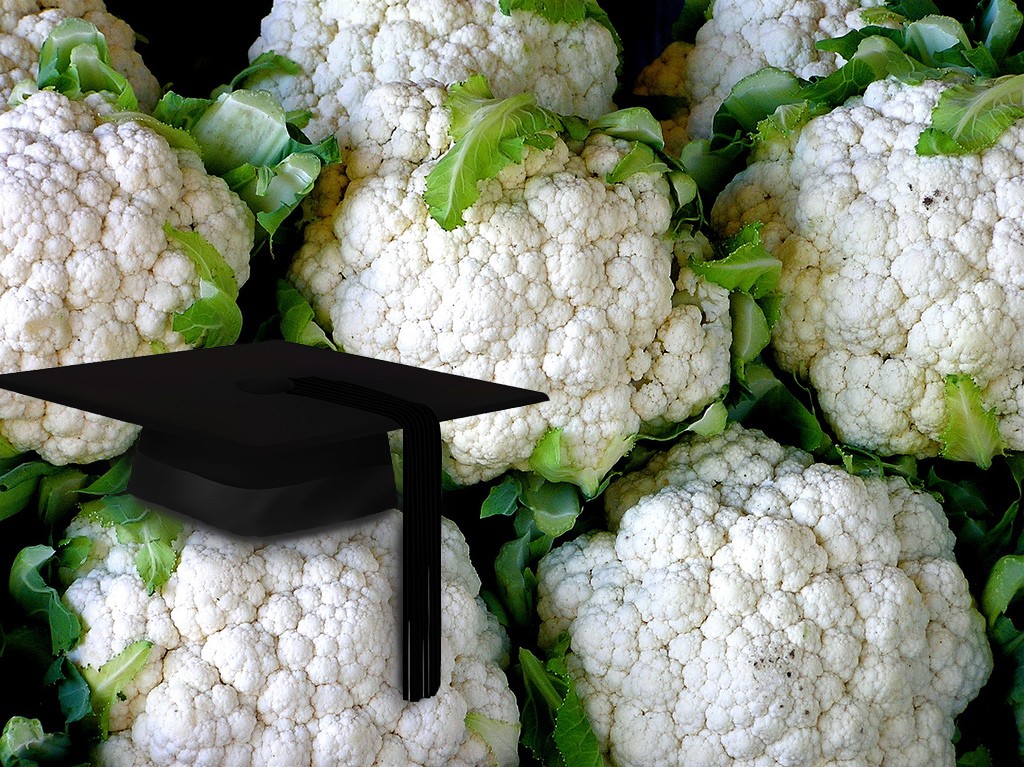
By Paul James
Bermuda grass isn’t from Bermuda. Jerusalem artichokes aren’t from Jerusalem (they aren’t even artichokes!) The eastern red cedar seen throughout Green Country isn’t a cedar at all. And cauliflower has been described as “cabbage with a college education.” Oh, how I love the wacky work of gardening. But wait…there’s more!
All in the Family
Poison ivy is in the cashew family. Keep that in mind the next time you get an itch for those tasty nuts (which by the way aren’t nuts in the botanical sense – read on). Also in the family are pistachios, mangos, sumacs, and yes, even smoke trees. Wacky, huh?
Hops, a key ingredient in making beer, are in the same family as marijuana. So is our native hackberry tree.
Nearly all the fruits we commonly grow (and eat) are in the rose family, including apples, apricots, blackberries, cherries, peaches, pears, and raspberries. Even almonds are in the rose family, because they’re basically itty bitty peaches before their outer flesh is removed to reveal the nut, which – you guessed it – isn’t a nut!
Fruits and Nuts
A true nut, botanically speaking, is a hard-shelled pod that contains both the fruit and seed of the plant. Examples include chestnuts, hazelnuts, and acorns. Walnuts, cashews, pecans, pistachios, and almonds are actually a type of fruit known as a drupe. But peaches, plums, and cherries are also drupes. In the case of the former, we eat the seed, and in case of the latter, we eat the flesh and discard the seed.
Peanuts aren’t nuts either. They’re legumes, like beans and peas. The “nut” we eat is a seed.
And to mess with you even more, in many cases what we call vegetables are in fact fruits. The word vegetable is a generic term rooted in culinary tradition, not a botanical one. It’s used to describe plants that produce edible leaves (lettuce), stems (rhubarb), stalks (asparagus), bulbs (onions), flowers (broccoli) and roots (carrots).
But while you may also think of squash or okra or beans as vegetables, they are technically fruits (beans, of course, being the most melodic of them all). And some common “vegetables” are technically berries, among them tomatoes, cucumbers, and eggplant. Even grapes and bananas are berries. But, strange as it may seem strawberries aren’t berries at all (they’re known as aggregate fruits).
Confused? Of course you are! You’d be nuts if you weren’t. But I’m not done yet.
Cabbage, broccoli, cauliflower, kale, and Brussels sprouts are all the same species of plant, but they’ve been so selectively bred over the years that they hardly resemble one another. Perhaps that’s why Samuel Clemens described cauliflower as “cabbage with a college education.”
And that takes us back to my first paragraph. Bermuda grass is from Africa, not Bermuda. It arrived in the U.S. as a result of the grass being used as a bedding material on slave ships. Jerusalem artichokes are actually native to this country, and are a type of sunflower. The Italian word for sunflower is girasole, and through several slips of the tongue over the years, girasole became Jerusalem. And finally, the eastern red cedar is, in fact, a juniper. No matter what you call it, however, farmers and ranchers tend to despise it as a weed tree.
Oh how I love the wacky world of gardening!
We’re Having a Heat Wave!

By Paul James
Recent rains were a nice respite, but now it looks as though we’re heading into an extended period of hot weather, with heat indices climbing well into the 100s and few chances for additional rain. That’s hardly surprising, given that it’s officially summer. And with that in mind, here are the two most important words to keep in mind – mulch and water.
Mulch – A thick layer of mulch is great for maintaining even soil moisture and soil temperature, two things plants love. Mulch also prevents annoying summer weeds from popping up all over. And on top of all that, it looks great. Choose from among chipped or shredded wood products, or try pine needles. A two- to four-inch layer is ideal, but keep mulch a few inches away from the base of plants to avoid rot and damage by mice, who love to chew on bark in search of moisture.
Water – Of course you have to water, but how much and how often? That’s one of the toughest questions to answer, because there are so many variables to consider. But in general, annuals, perennials, and turf grasses need at least one inch of water every week, and the way to measure that amount is about as low tech as it gets. Place a straight-sided can (I use a tuna can) in the garden bed or lawn, turn on the sprinkler, and determine how much time it takes to fill the can with water up to an inch. That’s how long you need to water every week. As temperatures climb in to the mid 90s and beyond, you might want to water twice a week.
Trees and shrubs up to six-feet tall need roughly three gallons of water a week, whereas larger ones need up to 10 gallons. Time how long it takes to fill a one-gallon watering can at a slow trickle from the hose, and multiply by three or 10 to determine how long you’ll need to leave the water running. And while it’s running, move the hose in a circular pattern several feet away from the base of the plant for even distribution.
If you rely on an automatic sprinkler system, use the tuna can test to determine how long you’ll need to run the system, but be prepared to water trees and shrubs by hand regardless.
And finally, plan on watering patio pots and hanging baskets at least once a day, maybe twice a day if they’re in direct sun.
Beyond taking care of your plants, be sure to take care of yourself. Stay hydrated, take frequent breaks, wear sunscreen and mosquito repellent, and try to avoid working in the garden during the hottest part of the day.
Summer Vegetable Tips
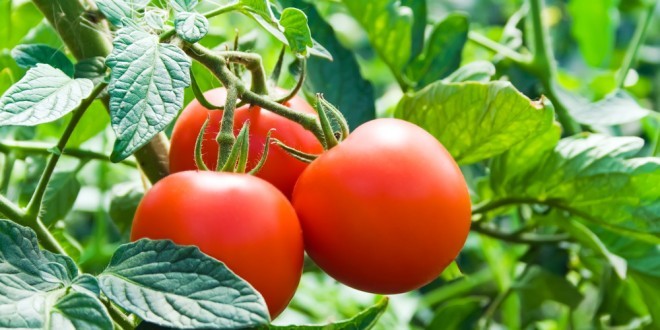
By Paul James
This is a time of transition in the vegetable garden, and I face it with mixed emotions. I’m forced to rip out lettuce, spinach, and other greens (no more fresh salads!) that have bolted due to the heat, but I look forward to harvesting tomatoes, peppers, cucumbers and the like. And here’s what I’m doing now to make sure all goes according to plan.
Beans – Harvest often, perhaps even daily, but don’t worry about fertilizing. Beans are legumes, which means they fix nitrogen from the air and store it in root nodules. Bean beetles, which look sort of like ladybeetles but with yellowish green to light orange bodies, can be a nuisance; control them with a product containing Spinosad (I like Captain Jack’s Dead Bug Brew).
Corn – The real trick to getting a good crop of corn in a small veggie garden is to shake the stalks regularly so that the pollen at the top of the plants drops down to the silks on the cobs. Corn is pollinated by wind, not insects, and in a small plot it often needs our help. Once the silks have begun to brown, add a few drops of Bt, an all natural insecticide, to the tips of the cobs to control earworms, ugly caterpillars that always seem to find their way into corn and leave behind a gross mess.
Cucumbers – Cukes need lots of moisture and sunlight, and they should be fertilized as fruits begin to grow. Espoma Plant-Tone provides all the nutrients they need. Watch out for cucumber beetles, which also look like ladybeetles but have bright yellow bodies with black spots or stripes; treat plants with Spinosad.
Eggplant – To maximize production, fertilize when flowers appear and harvest often. Smaller fruits tend to have far fewer seeds and are less bitter. Be on the lookout for shotgun-like holes in the leaves caused by flea beetles. Treat with Spinosad.
Garlic – Assuming you planted garlic last fall, it should be close to harvest time. If scapes have formed (curly stems with a flower bud at the end), remove them to force more energy into bulb development (and either grill them or use them to make pesto!). Once a half dozen or so of the lower leaves have turned brown, carefully lift the plants out of the ground and store them in a shady spot that gets good air circulation. In about ten days, cut the top growth and store the now cured bulbs in a cool, dry place.
Okra – Just keep it watered. That’s about all there is to it. Harvest when the pods are roughly three-inches long, and plan on harvesting darn near every day.
Peppers – Provided they get lots and lots of sun, peppers generally aren’t bothered by pests and diseases. Try not to overwater them, however, especially if growing hot varieties. Periods of drought tend to make them hotter.
Potatoes – Although a cool-season crop, potatoes are usually harvested in early summer. Once flowers appear, you can begin harvesting new potatoes. If you let the vines turn brown before harvesting, the tubers will last longer in storage.
Squash – Squash is so often ravaged by squash beetles and squash vine borers that for me anyway it’s the toughest veggie to grow. Still, I plant a few hills every year and hope for the best. Squash bugs can be controlled with pesticides if you catch them in their nymph stage, but adults are a different story. Look for reddish-brown egg masses on the underside of leaves and “squash” them to reduce the population. Female squash vine borers look like red and black wasps. They lay their eggs in the vine or stem of the plant, and the emerging caterpillars feed from the inside, making them hard to detect, often until it’s too late. If you see “frass” (caterpillar poop) on the main stems, that’s a sure sign that your squash is in trouble. Make a small slit in the stem and pour some Bt into it, then cover with soil and cross your fingers.
Melons – Melons can be tricky to grow as well, because they’re susceptible to various insects and fungal diseases. But they’re still easier than squash! Make sure you’ve got Spinosad on hand for the bugs and a great, all natural fungicide called Serenade for the diseases. Harvest watermelon and cantaloupe when the underside turns from white to pale yellow and the melon feels heavier than you would expect.
Tomatoes – Despite their enormous popularity, tomatoes can be challenging to grow thanks to bugs, viral and bacterial diseases, birds and squirrels, and excessive heat, which can shut down fruit production. Still, I doubt there’s anything I could say to discourage you from trying, right? Perhaps the most important thing to do is water frequently. Erratic swings in the moisture level can cause blossom-end rot and cracking.
And don’t forget the next transition – from summer to fall – when planting starts all over again!
Creating a Pollinator Garden
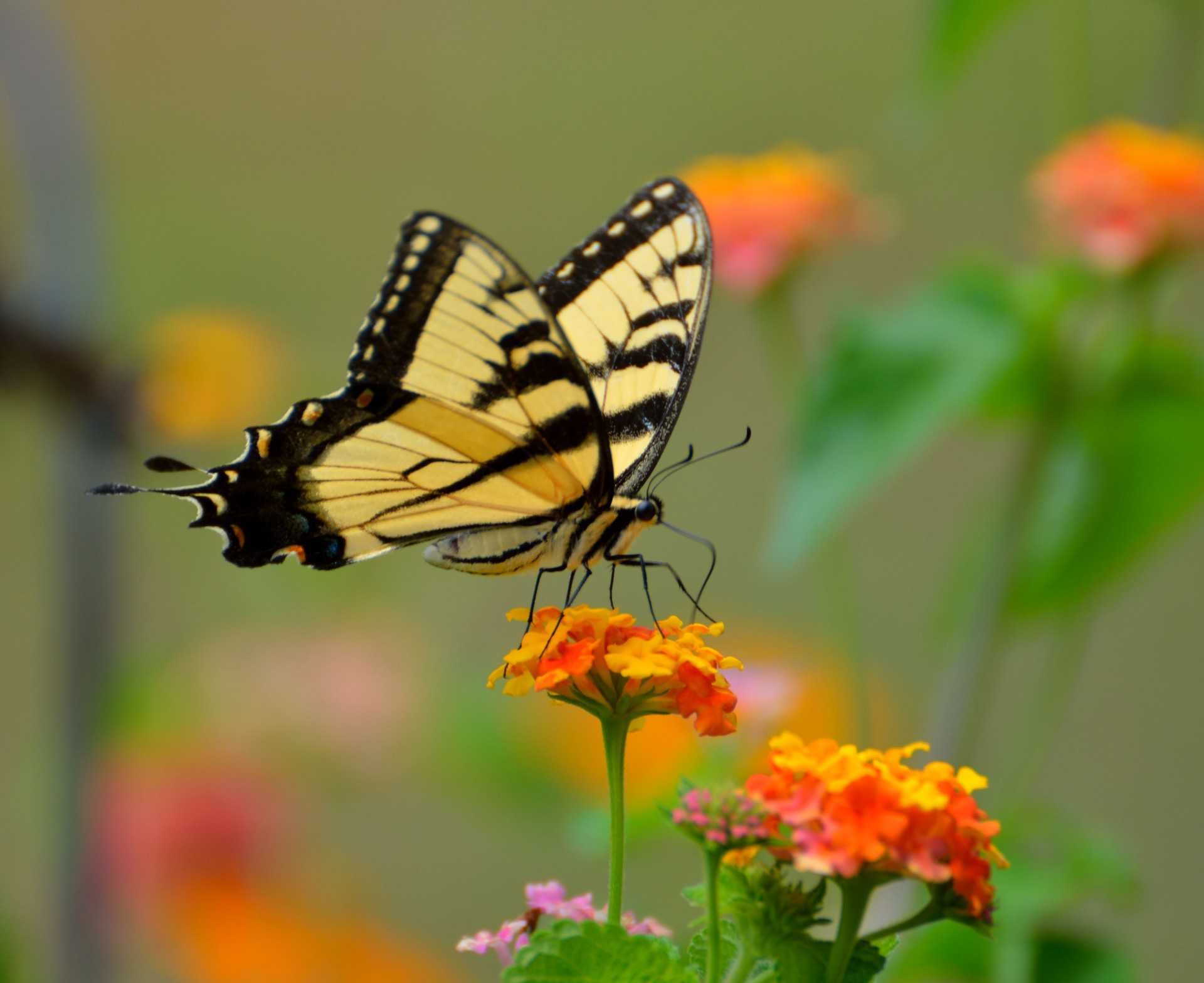
By Paul James
Pollinator gardens are all the rage these days, thanks largely to the concern over the future of honeybees and Monarch butterflies, whose populations have been in decline in recent years. That’s made them the poster children for the pollinator movement, and that’s a good thing. But there are lots of other critters that pollinate our gardens, and they deserve attention too.
Among them are several other species of native bees, including bumblebees, mason bees, solitary bees, and sweat bees (honeybees aren’t native – they’re from Europe). And while there are about 750 species of butterflies in North America, there are over 11,000 moth species! Due to their numbers, a lot of winged insects we think are butterflies are actually moths, and they pollinate a considerable number of plants, both during the day and at night.
Other effective pollinators includes various flies, wasps, beetles, dragonflies, ants, male mosquitoes (they don’t need blood like the females do – they need nectar), and of course hummingbirds.
So how do you attract pollinators to your garden? Well the short answer is to include lots of flowers of various colors and shapes, but there’s more to it than that. You also need to eliminate the use of broad-spectrum insecticides, opting instead to use products that target only the pest you’re trying to control. And you need to provide a source of water such as a bowl or birdbath filled with stones to provide perches, especially for butterflies and moths.
As for plants, choose a wide variety, especially natives, and plant them in clumps rather than as single plants to provide large landing zones for pollinators. Try to overlap flowering times between seasons, from early spring into fall. And mix up the colors and flower forms. Butterflies are attracted to red, orange, and yellow and usually prefer flat, open flowers. Hummingbirds also love the color red as well as fuchsia and purple, and they prefer tubular flowers.
Here are a couple of partial lists of great perennial pollinator plants to help you get started. Keep in mind the fact that there are many more, including numerous annuals, trees, shrubs, and fruits.
To Attract Bees & Butterflies
- Achillea (Yarrow)
- Agastache (Hyssop)
- Asclepias (Milkweed)
- Aster
- Caryopteris
- Coreopsis (Tickseed)
- Echinacea (Coneflower)
- Gaillardia (Blanket Flower)
- Gaura
- Soldago (Goldenrod)
- Lavender
- Monarda (Bee Balm)
- Penstemon (Beardtongue)
- Perovskia (Russian Sage)
- Phlox
- Rudbeckia (Black-Eyed Susan)
- Salvia (Sage)
And don’t forget to consider a Vitex (Chaste Tree). It’s a shrub, but it’s quite possibly the greatest pollinator magnet of all.
To Attract Hummingbirds
- Agastache (Hyssop)
- Ajuga
- Gaillardia (Blanket Flower)
- Heuchera (Coral Bells)
- Lantana
- Monarda (Bee Balm)
- Penstemon (Beardtongue)
- Phlox
- Salvia (Sage)
- Verbena
Living with Latin
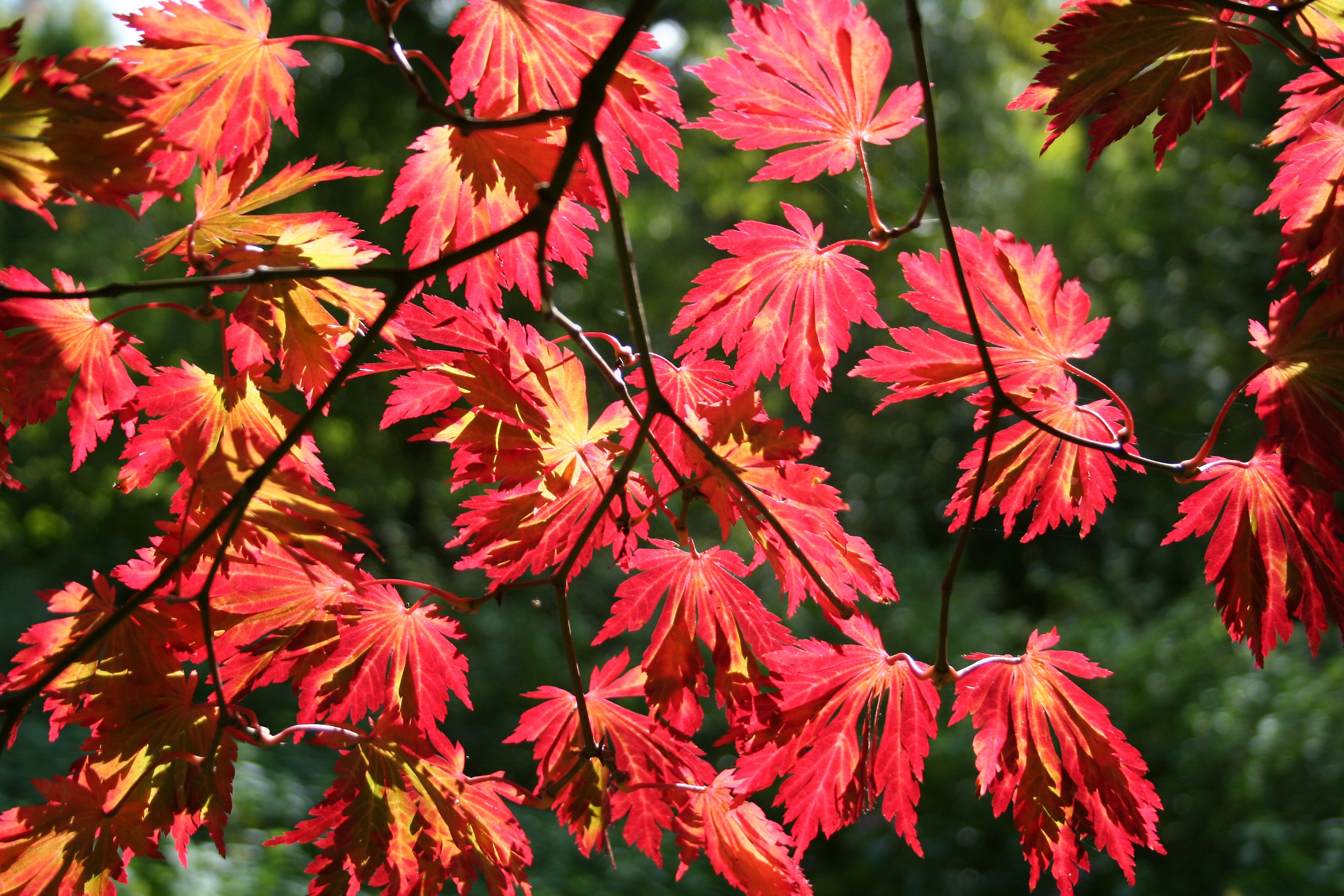
By Paul James
When my daughter was 12 or 13, she commented on how pretty a particular tree was as we strolled through the garden. “What’s it called?” she asked. “It’s Acer japonicum aconitifolium,” I said. She then repeated those three words three times, and now nearly 15 years later she can still pronounce the Latin name of the Full Moon Japanese maple perfectly. But why didn’t I just call it that in the first place?
Gardening geeks like me are sometimes accused of being pretentious when we use the Latin names of plants. But the truth is, all gardeners use Latin names routinely whether they realize it or not. For example, Begonia, Clematis, Crocus, Forsythia, Gardenia, Ginkgo, Hibiscus, Hosta, Hydrangea, and Iris, and Viburnum are all Latin names.
So here’s the deal: using the Latin name of a plant is the only way to positively identify the plant. Common names can be confusing because they may refer to more than one plant and often vary from one part of the country to another. As a result, if you were to ask for a ‘Snowball Bush’ at a nursery, the salesperson can’t be sure whether you’re asking for a particular type of Viburnum or a Hydrangea.
The method we use to name plants – known as binomial nomenclature — was developed in 1753 by Carolus Linnaeus, a Swedish naturalist who described and named thousands of plants and animals. In its simplest form, it consists of a genus name and a species name, although it may also include other descriptors.
Thus, in the case of the Full Moon Japanese maple, Acer is the genus for all maples, japonicum means it comes from Japan, and aconitifolium refers to the shape of its leaves (resembling those of another plant called monkshood, which is in the genus Aconitum).
Actually, learning a little Latin can be helpful, because the species names in particular can tell you something about a plant – its color, where it comes from, how it grows, etc. Here are a few are the more common species names used to describe plants.
alba — white
aurea – golden or yellow
canadensis – from Canada
chinensis – from China
densiflora – dense flowered
grandiflora – large flowered
macrophylla – large leaves
pendula – hanging
rotundifolia – round leaves
viridis – green
vulgaris — common
My favorite plant name has always been Ilex vomitoria, the Latin name for Yaupon Holly. Ilex is the genus for hollies, and vomitoria refers to the fact that a tea brewed from its leaves can make you quite sick. Who says botanists don’t have a sense of humor?
Is Laurel Hardy?

By Paul James
I sometimes chuckle when someone asks me if a plant is hardy, because often what they’re actually asking me is if a plant is tough enough to survive Oklahoma summers. And that’s not what hardiness is all about. Hardiness has to do with a plant’s ability to survive the winter in a given area, and Hardiness Zones are established by the USDA based on historical weather data. So, do you know which Zone you’re in?
Before answering that question, I should explain that Plant Hardiness Zones are first numerically divided into 10-degree increments, and there are 13 of them (Zone 1 is bone-chilling cold, whereas Zone 13 is tropical). They’re then further divided into 5-degree “a” and “b” increments. The numbers and letters represent the average annual extreme minimum temperature for a given area. The key word here is average, because the zone designations do not reflect the coldest temperature ever recorded at a specific location.
(FYI – the coldest temperature ever recorded in Tulsa was 16-below zero, set in 1930. In 2011, we hit minus 12.)
Most of Oklahoma consists of three Zones that run somewhat parallel from east to west. Zone 6b (-5 to 0 degrees) is in the northernmost area of the state, roughly from just south of Bartlesville to the Kansas border. Zone 7a (0 to 5 degrees) includes Tulsa and extends south just beyond Okmulgee. And Zone 7b (5 to 10 degrees) covers an area from just north of McAlester to the Texas border.
Other than annuals – which by definition aren’t hardy – and tropicals, which I wish were hardy, it’s safe to assume that fully 99% of the plants sold by nurseries in your area, including here at Southwood, are hardy. Otherwise, they (and we) would have to deal with a lot of angry customers returning plants that didn’t make it through the winter.
But circling back to my first sentence, just because a plant is hardy in the winter here doesn’t necessarily mean it’ll survive the summer. Take hemlock, for example, one of my favorite conifers. It’s perfectly hardy (down to minus 30!), but it can’t take the heat in our neck of the woods. Ditto firs, many rhododendrons, and a host of other plants.
The American Horticultural Society years ago developed a Heat Zone Map that shows whether a plant is likely to survive the summer, but it never really caught on, perhaps because people just zoned out due to the confusion created by having to understand not one but two zone maps. Still, it’s a useful tool that you can find online at http://ahsgardening.org/gardening-resources/gardening-maps/heat-zone-map. (And by the way, we’re in Zone 8 in terms of heat).
Fortunately for us, we live in an area where we can grow a staggering number of plants that are dependably hardy. And yes, that includes laurels.
Kids and Gardening

By Paul James
Getting kids interested in gardening is really quite simple — just think like a kid! That means forgetting about everything being neat and tidy and orderly and exact. In fact, it often means doing quite the opposite. My first suggestion? Let them get filthy dirty like my grandson pictured here. Does he look happy or what?!
Years ago I did an episode of “Gardening by the Yard” that was all about kids and gardening. I recruited 20 or so of my own kids’ friends – most were between 4 and 8 years of age – and we spent the better part of a day playing in the yard and completing a variety of projects.
The first was making mud pies. I gave each kid an aluminum pie pan and had them fill it with mud that I’d prepared in advance. Then I told them to wander about the yard and decorate their pies with seeds, berries, flowers, leaves, and stones – pretty much anything that caught their eyes while also reminding them not to put anything in their mouths. The results, for the most part anyway, were beautiful.
Over the course of several hours, we planted beans from seed by throwing the seeds into a prepared bed in the most haphazard way imaginable, and planting them where they fell. We turned the compost pile in search of earthworms and other critters, and discovered a nest of garter snakes. We made transfers of tree bark on paper, released lady beetles and tied praying mantis egg cases to the branches of various shrubs, harvested strawberries and doused them (and each other) with canned whipped cream, and picked lettuce and spinach straight from the garden for lunch (I had PB&Js standing by).
But one of my favorite projects was planting broccoli. I gave each of the kids a transplant (for instant gratification) and showed them the bed where I wanted them planted. Then I showed them how to carefully remove the transplants from the pot and tease the roots before planting. When they were finished, I asked them if they liked broccoli, and most said only if it was covered with cheese sauce. So I went inside, grabbed a package of shredded cheddar cheese, and had the kids sprinkle each transplant with cheese.
All the kids, quite unknowingly, connected to the natural world around them. And to this day many of them – now in their 20s and 30s and avid gardeners – tell me how much fun they had that day. I had fun too, especially when I sent all the kids home to their parents filthy dirty and soaking wet.
The Sun/Shade Dilemma
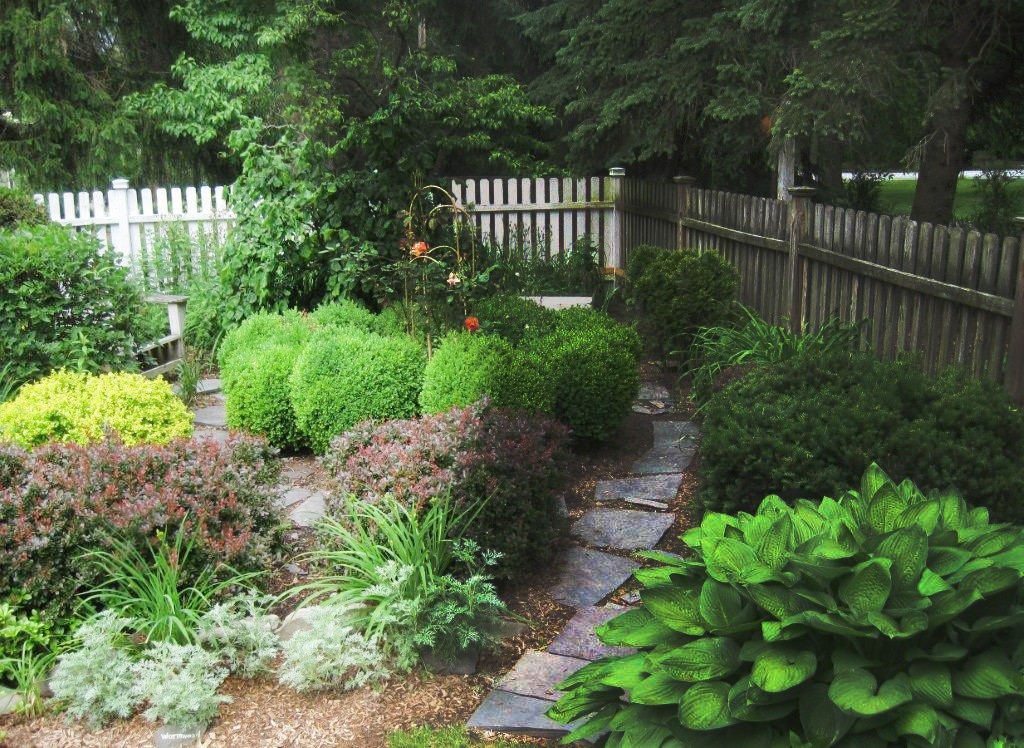
By Paul James
When shopping for plants, one of the first and most important questions you’ll likely be asked is, Will they be growing in sun or shade? And often it’s one or the other. But that’s not always the case. Truth is, the whole sun and shade discussion can get rather confusing, but it’s a critical consideration when it comes to picking the right plants.
First, realize that telling the salesperson that your house faces east or west (or any other direction) isn’t specific enough. For example, most people would assume that a south- or west-facing property gets lots of afternoon sun. But if the property is loaded with mature trees, it may actually get very little sun, so make sure you convey that information.
Figuring out how best to describe your particular situation means you’ll carefully have to observe when and where the sun is shining throughout the day. And why is it so important to make such a determination? Simple. Plants that require full sun won’t grow well in the shade. They may survive, but they won’t thrive, and they’ll forever lack the vigor that they would otherwise have. However, they may do just fine in dappled light, or a spot that gets some sun throughout the day. Plants that require full shade will croak in the sun. Period.
Here are the most common sun/shade situations and suggestions on how to select the right plants for each.
Morning Sun/Afternoon Shade
Lucky you, because this situation gives you lots of choices, depending on exactly how much morning sun the area gets. If it’s just two or three hours worth, then you should consider Azaleas, Hydrangeas, Yews, Japanese Maples, and Dogwoods, plus all annuals and perennials that are considered shade tolerant. If it gets sun until midday or later, you should opt for plants that prefer full sun.
Morning Shade/Afternoon Sun
In this situation, your best bet is to go with plants that require full sun, because the shade-tolerant plants mentioned above cannot handle afternoon sun. Still, the list of plants that will adapt to such a situation is a long one, and includes nearly all flowering annuals and perennials as well as trees and shrubs.
Partial Sun/Partial Shade
This situation is also called “dappled light,” and here things get a little tricky. But generally speaking, if there’s more sun than shade, go with plants that require full sun, and if there’s more shade than sun, choose plants that prefer shade. If there are roughly equal amounts of sun and shade throughout the day, you can plant pretty much anything you want.
Following these guidelines, you may not be successful 100% of the time, but then no gardener has that kind of success, including me.
Debunking Garden Myths
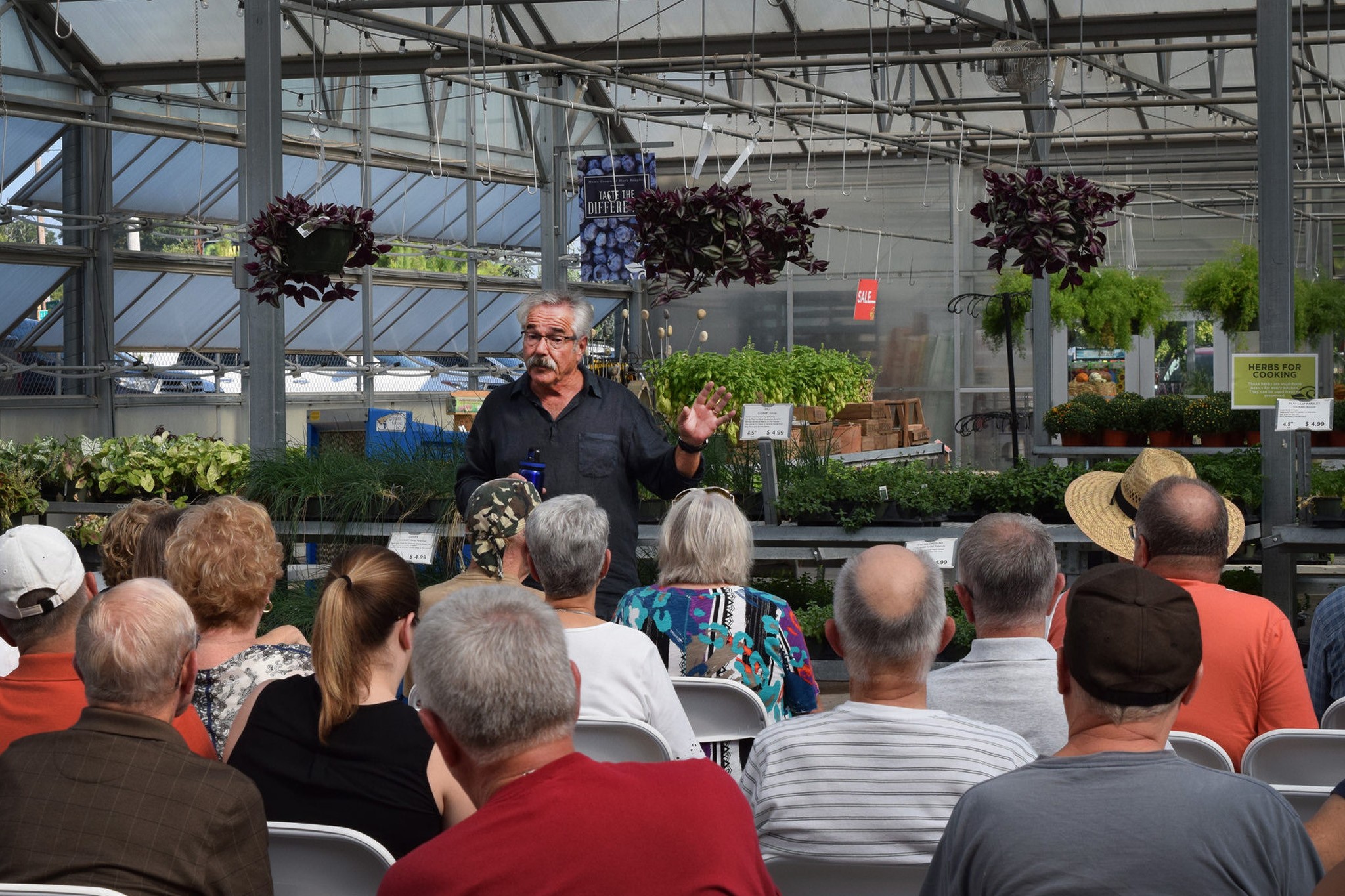
By Paul James
When I speak at gardening events across the country, the format I prefer is a simple Q&A. It engages the audience, it helps me understand exactly what gardeners are interested in, and it allows me to perform my shtick. It also gives me the opportunity to debunk common and persistent garden myths, including many that never seem to go away.
Newly Planted Trees Must be Staked
There are only two times to stake a tree. One is if it’s been planted as a bare-root tree and therefore lacks sufficient root mass to keep it upright. And the other is if you live on a hilltop where strong winds blow. Otherwise, there’s no real benefit to staking a tree. Ideally, trees should be left to sway in the wind because that helps them develop stronger trunks. If you do stake a tree, remember to remove the stake after the first year.
Stressed Plants Should be Fertilized
When a plant looks sickly, your first instinct may be to fertilize it. But that’s often the last thing you should do. A plant in poor health absorbs fewer nutrients than a healthy plant, so adding fertilizer can actually backfire by leading to an accumulation of excess nutrients and salts in the soil that can burn tender roots and cause leaf discoloration.
Instead, you should first try to zero on what the real problem is, including pH imbalance, pest or disease problems, drainage issues, poor watering practices, and so on, all of which can inhibit the absorption of nutrients, making the addition of fertilizer a complete waste of money.
Add Gravel to Bottom of Pots
This one’s been around for years, unfortunately. The idea behind it is that gravel at the bottom of the pot improves drainage and reduces the likelihood of root rot. But in fact, it actually increases the chance of root rot, because water doesn’t move easily through the potting mix to the gravel. As a result, water builds up in the potting mix and is only released into the gravel when it’s saturated, like a sponge that can’t hold any more water. So when planting things in a pot, use only potting mix.
(The technique, by the way, is known as crocking, and soil scientists have known for over a hundred years that it doesn’t work. Said another way, crocking is a crock.)
Pruning Paints
The idea behind the use of pruning paints is simple enough: the cut surface of a stem or branch is like an open wound, and by sealing the wound the threat of rot or disease is eliminated. But in fact, pruning paints actually increase the threat by interfering with the natural healing processes.
When a stem or branch is cut, trees form scar tissue to keep pathogens out. Not only do pruning paints prevent the formation of scar tissue, they can also seal in water along with various pathogens that can lead to decay.
Amend Clay Soil with Sand
If you mix clay with sand and add water, you get something akin to a brick, and that’s not a good thing, unless of course you’re building a home. In the garden, the only way to improve clay soil is by adding organic matter – compost, shredded leaves, grass clippings, barnyard manures, and so on. It may take several seasons and repeated applications to truly transform a clay soil into something akin to loam, but you’ll get there.
Organic Pesticides aren’t Chemicals
It’s common these days for people to refer to natural pesticides as “organic” and synthetic pesticides as “chemicals.” But that’s ridiculous, because all pesticides are chemicals. Period. Organic products are derived from natural sources (such as plants, animal byproducts, and bacteria), whereas synthetic products are manmade. But they’re all chemicals, and there’s no getting around that fact.
Best. Trees. Ever.
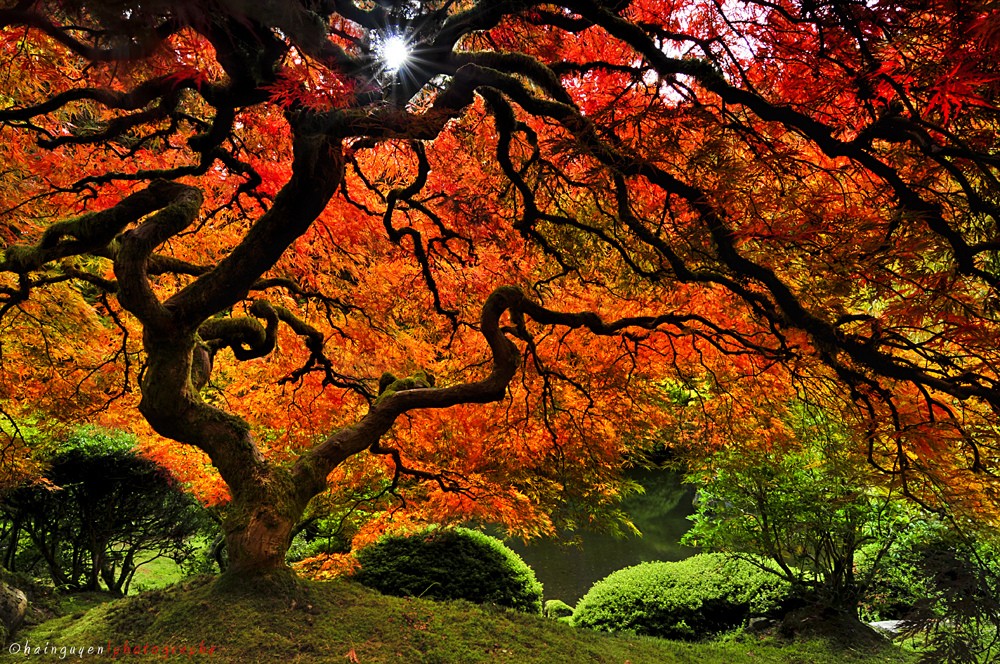 By Paul James
I don’t just love Japanese maples. I adore them. Have for decades. To me, they’re the most beautiful of all trees. Interestingly, although they appear delicate, they’re actually tough as nails, and rarely suffer from pest or disease problems. I don’t think I’m going out on a limb when I say every landscape should have at least one of them.
Japanese maples grow extremely well in this area, assuming they’re planted in the right location. That generally means a spot that gets just a few hours of morning sun followed by shade the rest of the day, or dappled light throughout the day. That can be a challenge for many homeowners, so your decision as to which one to buy may come down to this: red-leaf varieties will color up best when they get morning sun, whereas green-leaf varieties will do fine in all-day shade. If all you’ve got is all-day sun, plant something else. Sorry.
Ideally, the soil should hold moisture but drain well, but I’ve grown Japanese maples successfully in fairly heavy soils as well by planting them such that at least a third of the rootball is above grade. They thrive in acidic soils, witnessed by the fact that they’re often combined with azaleas, but they’re happy in soils with a near neutral pH.
Try to plant them in an area that’s protected from hot summer winds to avoid leaf scorch. And during the first two years after planting, keep them well watered. Once established, Japanese maples are fairly drought tolerant, but it’s best to give them a deep soaking once a week, especially during the summer months.
Japanese maples make stunning specimens in the landscape, and the choices available – in terms of size, shape, and leaf color — are staggering. There are upright and weeping forms. There are varieties that can reach 25-feet tall or more and others that top out at only three or four feet. In addition to red and green leaves, there are those with yellow to orange leaves (which may turn green in summer). And the fall color of nearly all Japanese maples borders on the spectacular.
One more thing to keep in mind: You can also grow Japanese maples in containers. And because they actually prefer to be somewhat pot bound, you don’t need an especially large pot. I’ve been growing three different varieties in 18-inch pots for over eight years now, and they look great.
And finally, just in case I haven’t convinced you in words to plant a Japanese maple at your place, perhaps these pictures will change your mind.
By Paul James
I don’t just love Japanese maples. I adore them. Have for decades. To me, they’re the most beautiful of all trees. Interestingly, although they appear delicate, they’re actually tough as nails, and rarely suffer from pest or disease problems. I don’t think I’m going out on a limb when I say every landscape should have at least one of them.
Japanese maples grow extremely well in this area, assuming they’re planted in the right location. That generally means a spot that gets just a few hours of morning sun followed by shade the rest of the day, or dappled light throughout the day. That can be a challenge for many homeowners, so your decision as to which one to buy may come down to this: red-leaf varieties will color up best when they get morning sun, whereas green-leaf varieties will do fine in all-day shade. If all you’ve got is all-day sun, plant something else. Sorry.
Ideally, the soil should hold moisture but drain well, but I’ve grown Japanese maples successfully in fairly heavy soils as well by planting them such that at least a third of the rootball is above grade. They thrive in acidic soils, witnessed by the fact that they’re often combined with azaleas, but they’re happy in soils with a near neutral pH.
Try to plant them in an area that’s protected from hot summer winds to avoid leaf scorch. And during the first two years after planting, keep them well watered. Once established, Japanese maples are fairly drought tolerant, but it’s best to give them a deep soaking once a week, especially during the summer months.
Japanese maples make stunning specimens in the landscape, and the choices available – in terms of size, shape, and leaf color — are staggering. There are upright and weeping forms. There are varieties that can reach 25-feet tall or more and others that top out at only three or four feet. In addition to red and green leaves, there are those with yellow to orange leaves (which may turn green in summer). And the fall color of nearly all Japanese maples borders on the spectacular.
One more thing to keep in mind: You can also grow Japanese maples in containers. And because they actually prefer to be somewhat pot bound, you don’t need an especially large pot. I’ve been growing three different varieties in 18-inch pots for over eight years now, and they look great.
And finally, just in case I haven’t convinced you in words to plant a Japanese maple at your place, perhaps these pictures will change your mind.
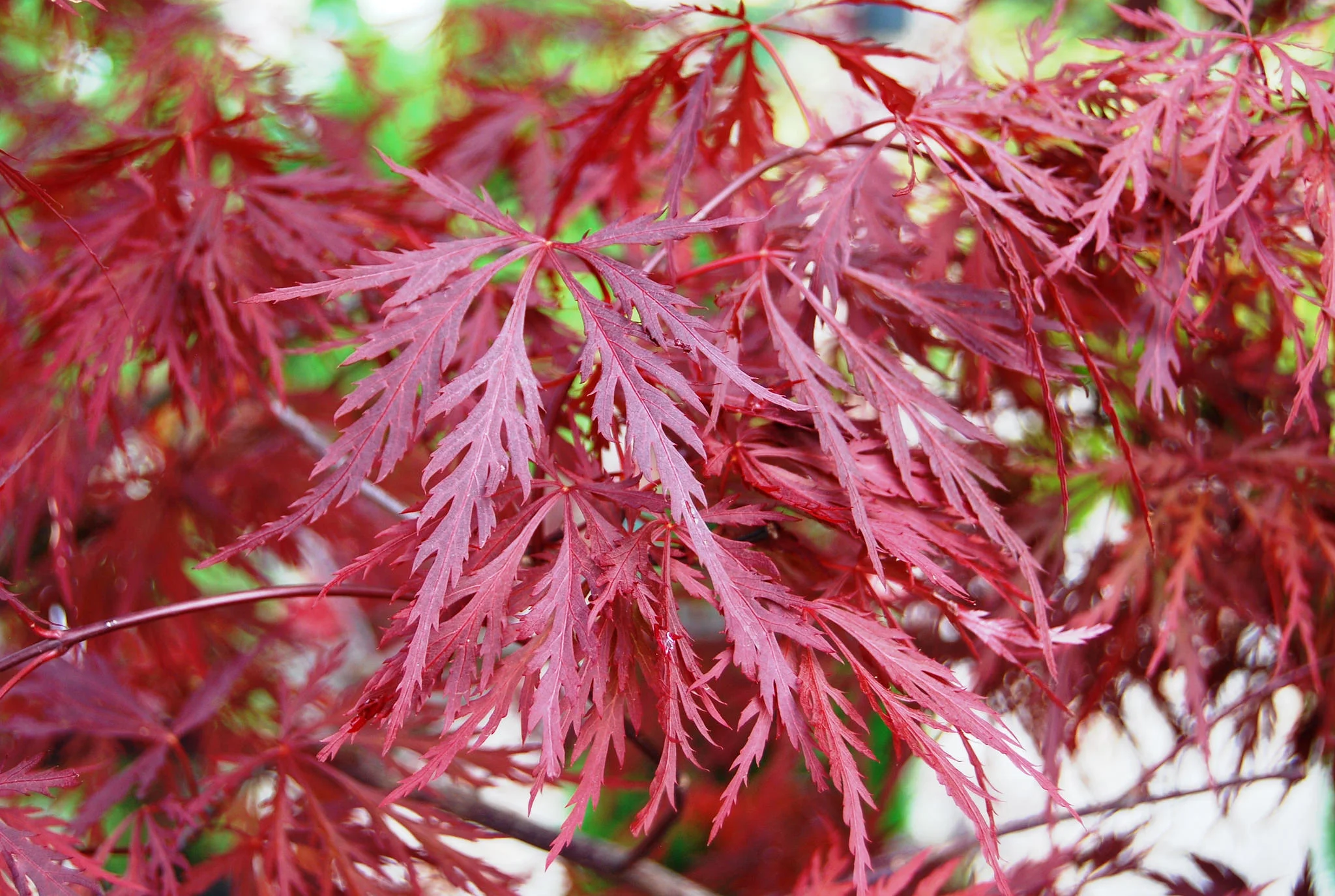
Let’s Plant!
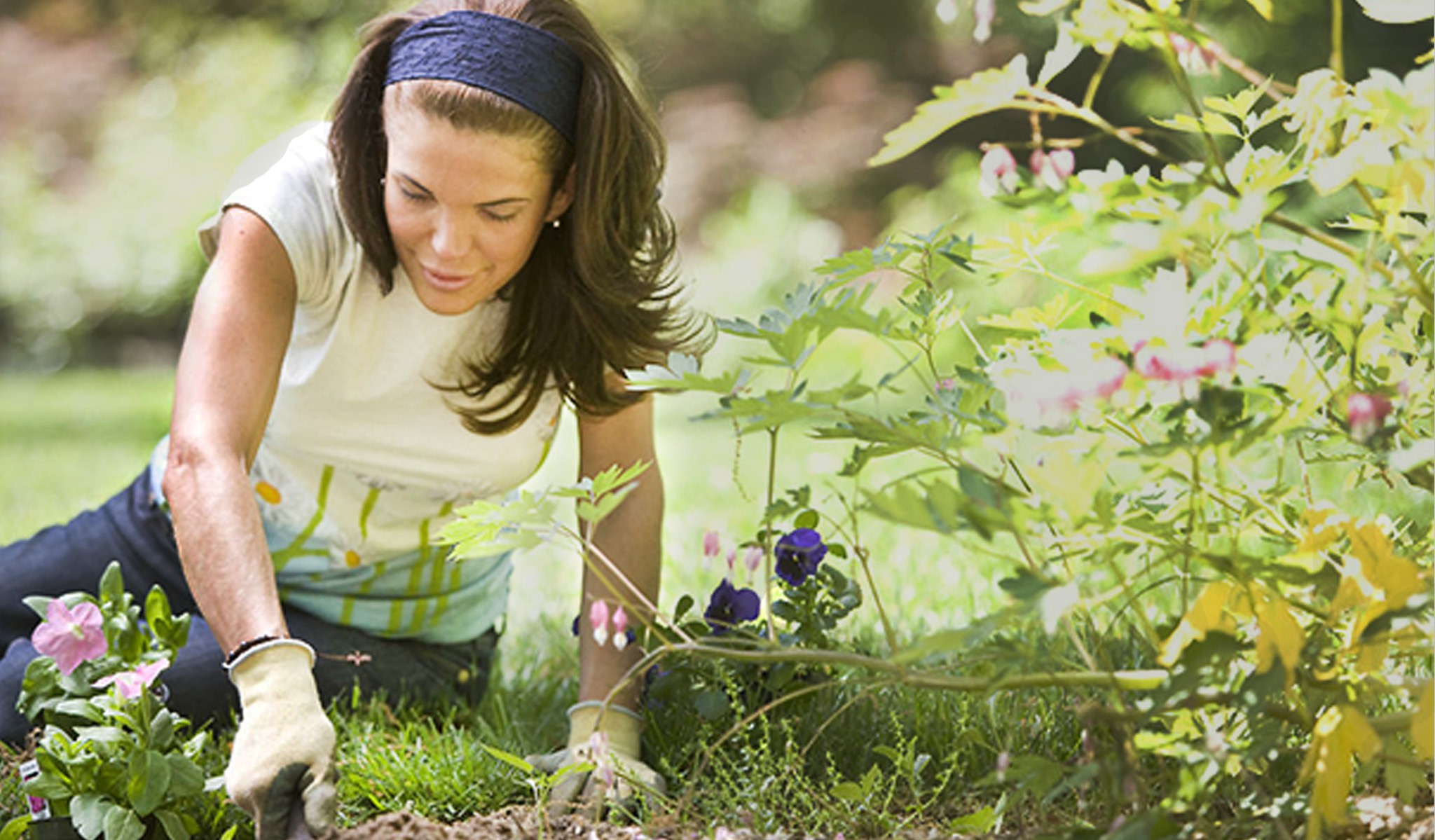
By Paul James
I think I speak for most gardeners– okay, maybe all – when I say, “What the heck. Let’s plant!” After all, it finally looks as though the cold temps are behind us, soil temps are steadily climbing, and I know we’re all dying to dig in the dirt. Plus, the forecast for next week looks downright perfect. In fact, the only thing I’d wait another week to plant would be caladium bulbs. So what the heck. Let’s plant! And that concludes my shortest post ever.
Controlling Pests & Diseases
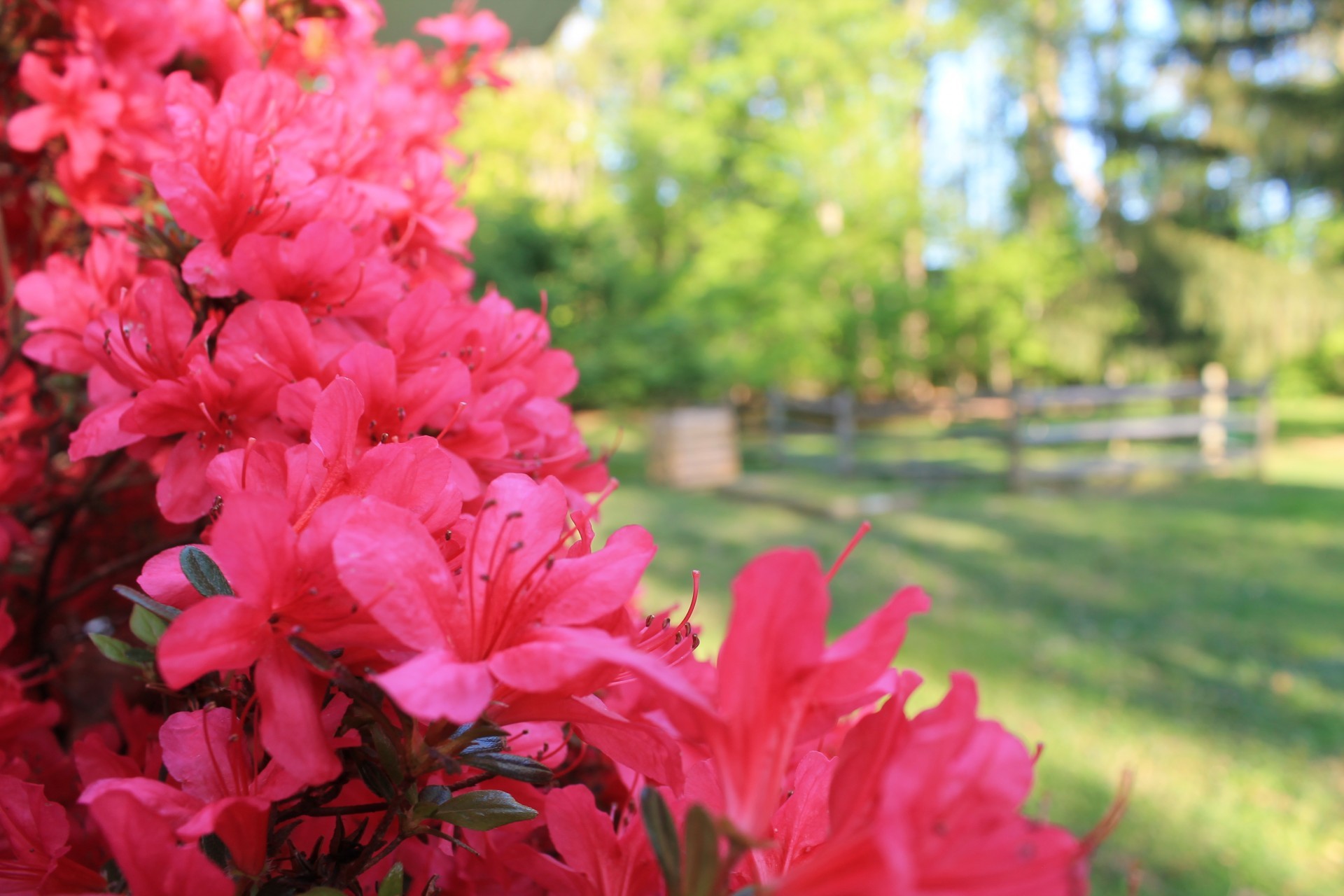
By Paul James
There’s no getting around it, folks…sooner or later some of our favorite plants get attacked by pests or diseases or both. Sometimes the invaders are relatively easy to control, although that’s not always the case, which is why there are dozens of products on the market aimed at targeting and destroying them. But what if I told you there are several things you can do to discourage pests and diseases from showing up in the first place?
The most important thing you can do is maintain healthy soil, because plants grown in healthy soil will be healthy too, which means they’ll be better equipped to resist invasions by pests and diseases. It’s much the same with humans; when our immune system is compromised we’re more likely to get sick. And creating healthy soil is simple – get in the habit of routinely adding compost (whether store-bought or homemade) to your soil. Just top off your beds with a two-inch layer of the stuff or place it around the perimeter of individual plants at least once or twice a year and your plants will thank you.
Now repeat the mantra – Right Place, Right Plant – over and over again, because it’s vitally important. When you plant something in the proper place you greatly increase its chances of remaining healthy. But if a plant requires well drained soil and you plant it in clay, or if it requires shade and you plant it in sun, you have only yourself to blame if it doesn’t do well and succumbs to pests and diseases.
Providing good air circulation can go a long way toward preventing problems, especially fungal diseases, so don’t crowd plants too close together or plant them directly against the house or fence. That’s especially important in the case of roses and Photinia.
Mulch can actually help keep fungal diseases at bay as well, because it smothers fungal spores in the ground and prevents them from splashing onto leaf surfaces when it rains or when you water.
And speaking of water, avoid watering late in the day so leaf surfaces have a chance to dry out completely. If they remain wet overnight, they’re prone to attack by fungal diseases. And regardless of when you water, soak the base of the plant rather than the leaves for the same reason.
Finally, try to keep your garden relatively tidy. Pests love to hide in garden debris, especially in piles of leaves and under boards or stones.
By doing all these things you’ll likely be pleasantly surprised by how much healthier your plants are. Of course, that doesn’t mean they’ll be immune to attack by pests and diseases, but it does mean they’ll be better equipped to withstand them.
Plant for Spring Color Now
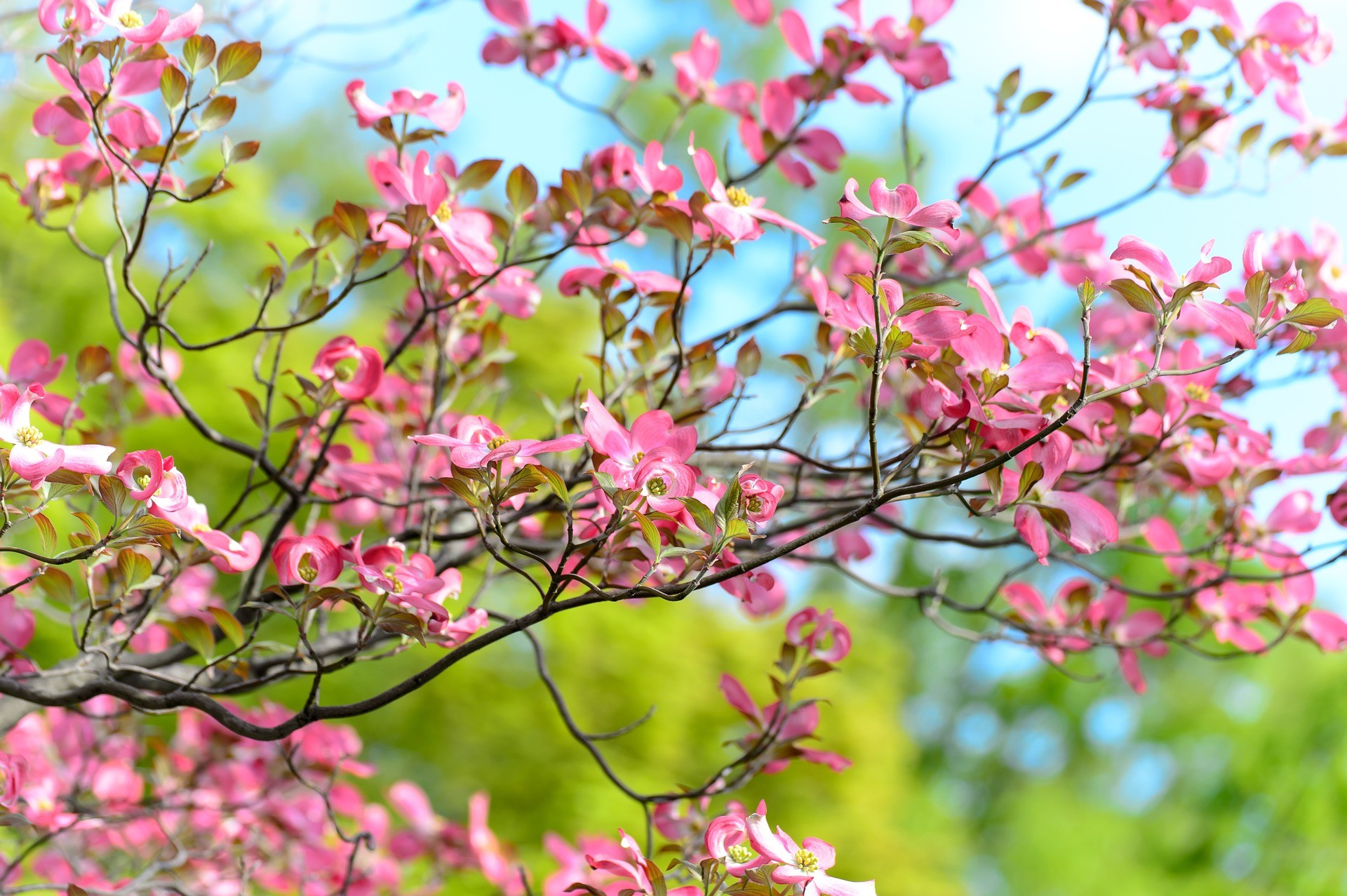
By Paul James
Funny thing about people’s plant buying habits – they tend to buy things when they’re in full bloom. That’s perfectly understandable. But if you want to enjoy the blooms over a longer period of time, you really should consider planting much earlier. And for some of the most colorful harbingers of spring, that means now.
For example, let’s say you’ve been thinking of buying a dogwood. Well then chances are you know what a dogwood in flower looks like, right? But have you ever seen how those flowers develop, first as tight buds on branch tips that open slowly, often changing colors slightly along the way, until they finally open fully to reveal the familiar flower that made you want a dogwood in the first place? The process is, to my mind, every bit as interesting as the final result. And you miss that when you buy a dogwood that’s already in full bloom. What’s more, you cut short the time you get to appreciate the tree in bloom.
The same goes for other stars of spring such as azaleas, cherries, crabapples, redbuds, and serviceberries, just to name a few, all of which will be blooming soon, perhaps even as early as next week in the case of crabapples.
Don’t get me wrong: I’m not suggesting you shouldn’t plant something that’s already in bloom. But if you’re buying something primarily for the beauty of its flowers, why not enjoy them from beginning to end? Said another way, why not plant now? After all, the weekend forecast looks awesome.
The Other Beautiful Bulbs
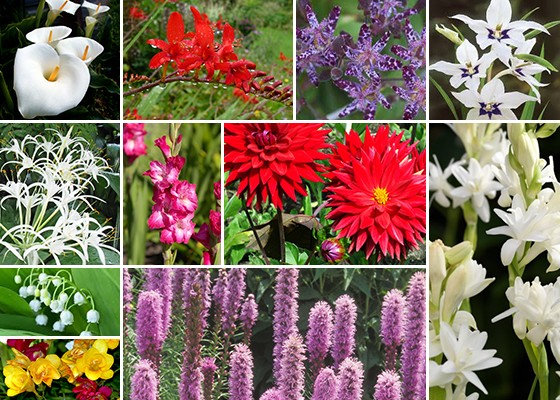
By Paul James
When you hear the word bulb, you more than likely think of those that bloom in late winter to early spring – daffodils, tulips, and hyacinths, for example. But there’s another group of bulbs that you actually plant in spring for a summer show, and they’re among the most beautiful bulbs of all.
In fact, in many cases, you must plant them from bulbs (or corms or tubers or rhizomes), because they aren’t available as transplants. So, consider the following choices, knowing that you can’t go wrong with any of them, whether planted in the ground or in containers.
The Time to Plant is Now!
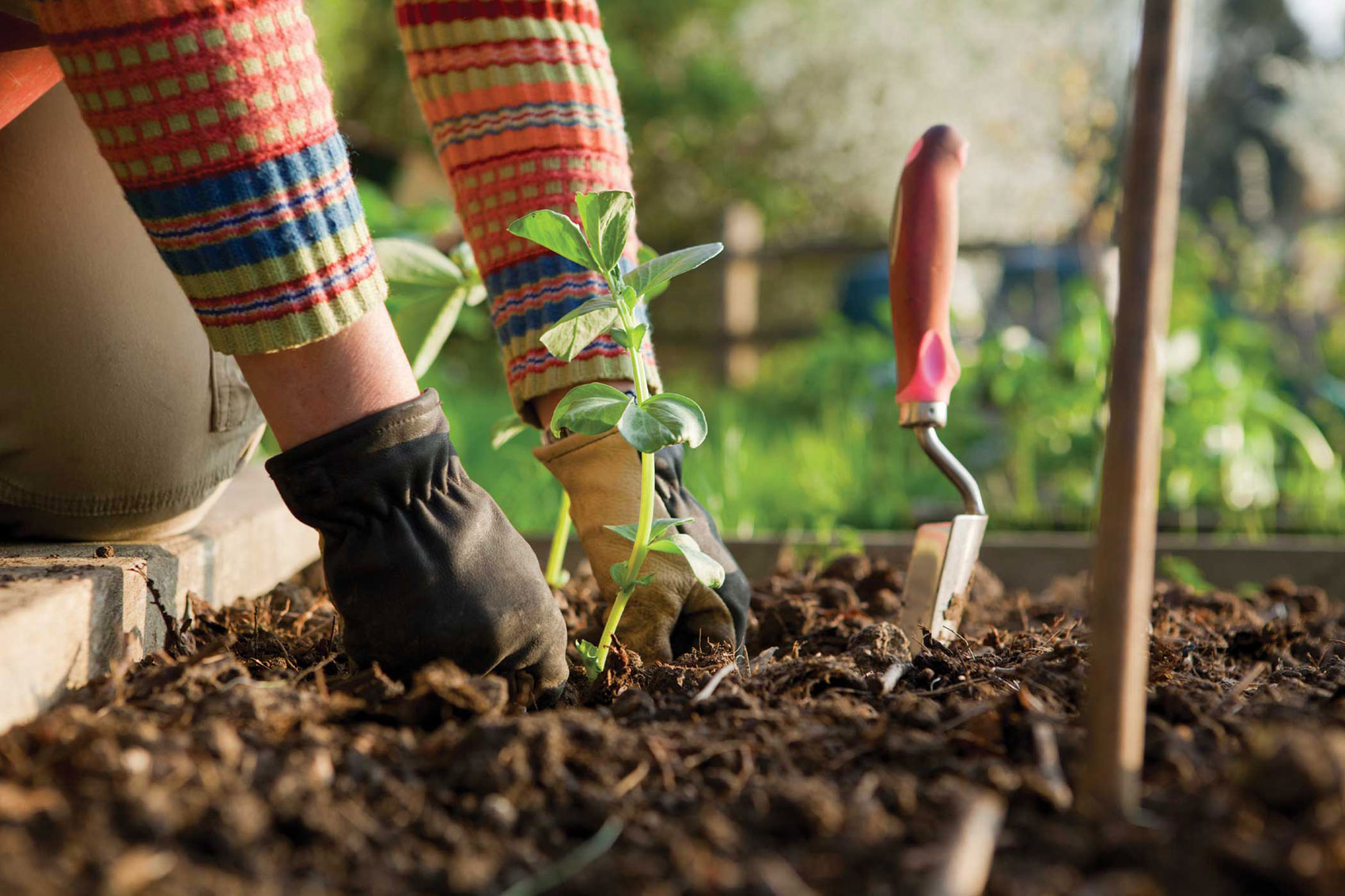
By Paul James
Two significant events occur this month: daylight saving time begins on the 11th; and spring begins on the 20th. That means there’ll be more daylight in the evenings and the days will be getting longer, so we’ll all have more time to garden. Yippee! But what, exactly, should we be planting this month?
Well the easy answer to that question is darn near everything (I‘ll get to the exceptions in a moment).
For starters, think trees and shrubs, both deciduous and evergreen. The sooner you get them in the ground the better so they’ll have time to focus on root development before top growth emerges, or in the case of conifers and evergreens, before they begin rapid growth.
Likewise, this is the perfect month to plant fruit trees, cane fruits (raspberries, blackberries, etc.), blueberries, and strawberries.
Perennials can go in the ground this month, and they too will benefit from putting on roots before their top growth takes off. Start early in the month with the woody types like Russian sage and Salvia greggii such as ‘Furman’s Red,’ as well as tough stuff such as hostas and daylilies. By the middle of the month go ahead and plant pretty much everything else.
It’s time to plant cool-season vegetables and most culinary herbs (basil is an exception – wait until the end of the month unless you plant in a container that can be moved indoors if temps drop below 45 degrees of so). Here’s a list of veggies to plant now.
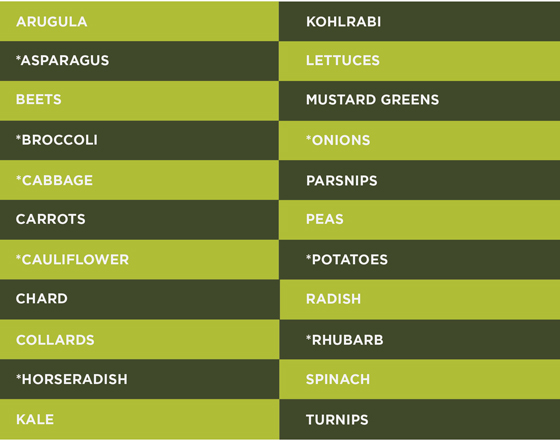
*Plant as roots, sets, transplants, or tubers. Plant everything else from seed.
And don’t forget fescue and rye. Both are cool-season turf grasses, so go ahead and seed new lawns or overseed existing lawns.
It’s still a tad early to plant most annuals, but before the end of the month, assuming the weather cooperates, they should be good to go in the ground or in containers.
And speaking of weather, I’d be remiss if I didn’t throw in this quick caveat. Yes, it’s possible, and perhaps even likely, that we’ll see a freeze this month, and perhaps even next month. So be prepared to cover sensitive plants. But realize too that the vast majority of landscape plants – trees, shrubs, perennials, as well as fescue and rye — won’t be affected by freezing temps. And nearly all veggies and herbs can tolerate temps in the mid to upper 20s.
So get out there and garden, because the time to plant is now.
Gardening as Exercise

By Paul James
Last Sunday I spent six hours in the garden, planting 60 hills of potatoes, 80 leeks, and 120 onions, among other things. Monday morning I had a tough time getting out of bed. But I must say the discomfort I felt was strangely gratifying, because not only did I get a lot of gardening done, I also burned a lot of calories. Just how many calories, you ask?
Probably a lot more than you might have guessed. Consider this: Ten minutes of shoveling burns as many calories as ten minutes on the treadmill at high speed. While shoveling – or raking or weeding – you experience a range of motion unlike any traditional exercise routine. And all that bending and stooping and twisting is good for muscles and joints, assuming you’re in decent shape to begin with and don’t overdo it.
So here’s a look at how many calories you can burn per hour while performing a variety of gardening tasks.
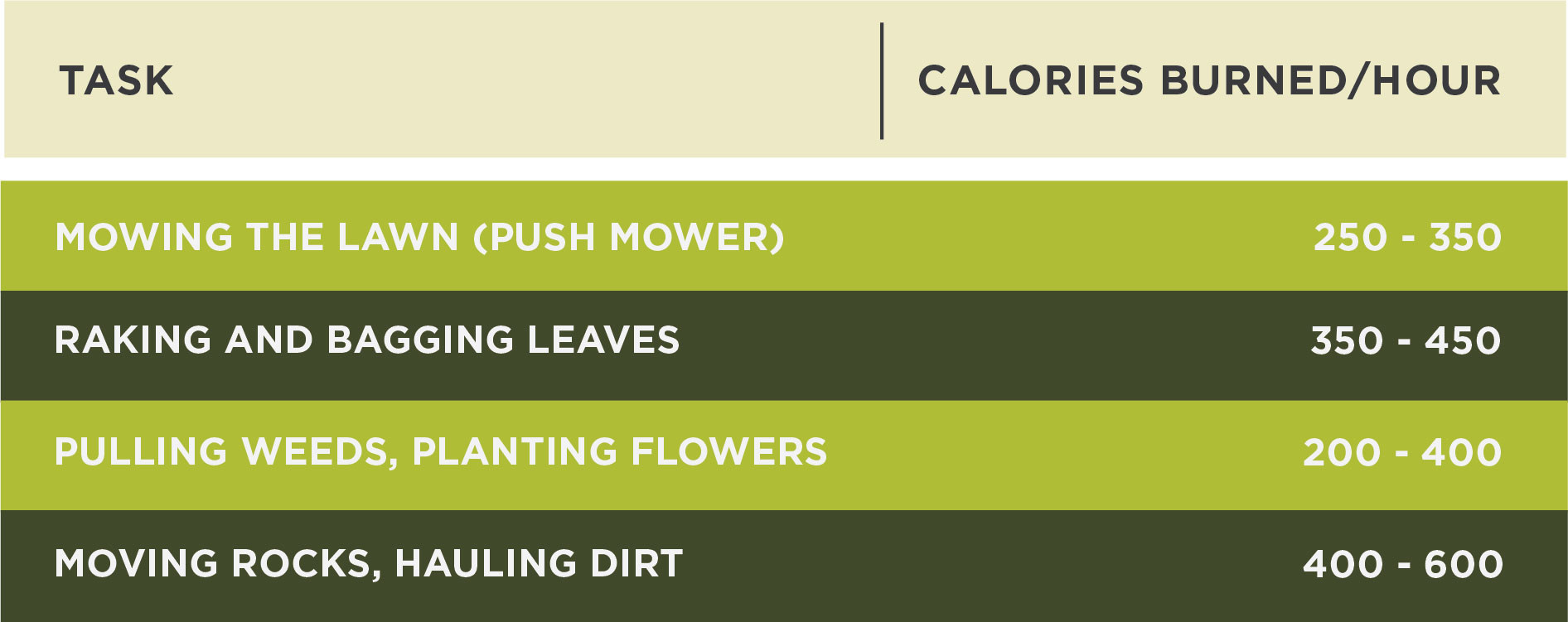
Now, someone who weighs 125 pounds won’t burn as many calories as someone who weighs 185, but any way you slice it, you’re burning calories and building muscle strength.
I calculated that last Sunday I probably burned about 1,000 calories, or roughly the number of calories in an incredibly large slice of cheesecake, which I ate later that evening, followed by two Aleve PM.
Soil Temps & Taters
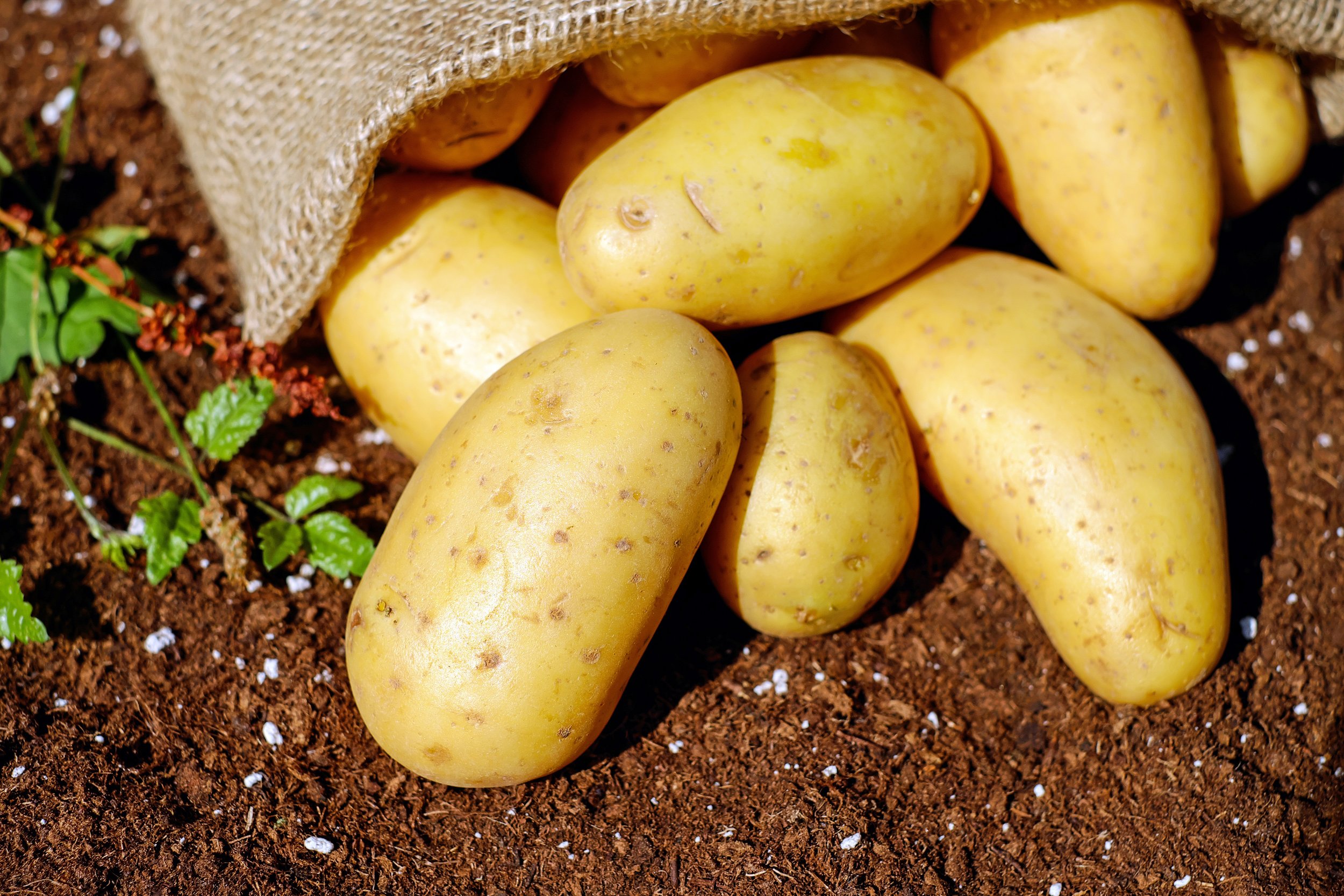
By Paul James
The other night my son asked me if it was time to plant potatoes. I paused momentarily to soak in the pride I felt knowing that he, along with his younger brother, have made gardening a part of their lives. (I’m sure their sister will do likewise once she moves out of her tiny apartment in Queens, NY.) Then I turned to him and said, “Check the four-inch soil temperature.”
“What’s that going to tell me?” he asked. “It’s going to tell you when you can plant potatoes,” I said.
Savvy veggie gardeners know that deciding when to plant is tricky. On the one hand, an early start means an early harvest, and cool-season vegetable crops do best when grown under cool conditions. On the other hand, getting started too early can lead to crop failure if temperatures nose dive.
However, because potatoes are planted below ground, deciding when to plant is based not on air temperatures but rather on soil temperatures, and when the soil temp hits 40 degrees (technically, when the four-inch bare-soil temp hits 40), you can plant away. The same is true of asparagus, rhubarb, and horseradish because they too are planted below ground, where they’re safely insulated from the cold.
Truth is, you can use soil temperatures to decide when to plant any and all veggies from seed. At 45 degrees, it’s safe to sow cool-season crops such as beets, carrots, lettuce, radishes, and spinach. But for warm-season crops it’s best to wait until soil temps are at or near 70 degrees (think beans, cucumbers, peppers, tomatoes, melons, and such).
And just how do you know what the four-inch soil temperature is? That’s easy. Go online to Oklahoma Mesonet www.mesonet.org or install the app on your phone. The Oklahoma Mesonet is a world-class network of 110 environmental monitoring stations scattered across the state, and it’s run by scientists from OU and OSU. The site displays real-time weather information of all kinds, and detailed maps of soil temperatures.
Of course, there’s always the possibility that air temperatures may plummet once everything is up and growing, and depending on how low they go your crops could take a hit. But that’s the chance we all take. Or, said another way, that’s gardening.
Do Freezing Temps Kill Bugs?
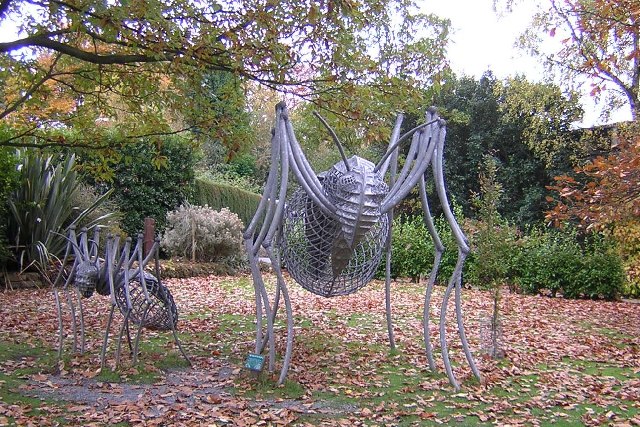
By Paul James
In the past few weeks, I’ve repeatedly heard the claim that the recent snap of cold weather means the bugs won’t be bad this year. The idea of course is that bugs can’t survive prolonged cold temperatures and therefore their populations will be greatly reduced if not eliminated entirely. But does that claim have any basis in fact?
Sorry, no. While it’s true that a number of bugs can’t survive freezing temperatures, they’ve developed truly remarkable ways of protecting themselves and furthering their progeny.
The simplest way to beat the cold is to migrate to a warmer spot, just as Monarch butterflies do. Moving into your house is another common means of survival for numerous insects including crickets, ants, ladybugs, stink bugs, moths, and even wasps.
Insects that can’t survive cold temperatures at least know how to sustain their populations by laying eggs underground, in leaf litter or garden refuse, and in buildings.
And what about fleas and ticks and mosquitoes? Again, sorry.
Fleas are clever enough to find ways to stay warm, whether on wild or domesticated animals or in garages, under decks, and around foundations.
Ticks begin a process of acclimation long before winter arrives by moving water out of their cells before it freezes and crystallizes, thereby allowing them to survive freezing temperatures. They also escape the cold beneath leaf litter and other warm spots.
Mosquitoes actually hibernate both inside and out. They also lay eggs in the fall that can survive the cold – even in frozen water — and remain dormant until spring.
And there are some insects – the Emerald Ash Borer for example, as well as some mosquitoes – that produce a sort of antifreeze in their blood called glycerol, which enables them to survive freezing temperatures in a state of suspended animation. It’s insect cryogenics, basically.
Let’s face it. Insects have been around for millions of years, and rarely do we hear of them becoming extinct. They’ve survived predators, pesticides, an asteroid that killed off the dinosaurs, and yes, even nuclear explosions. Among living things, they are the ultimate survivors.
And you think something like a little cold weather is going to affect them?
Gardening From the Inside Out
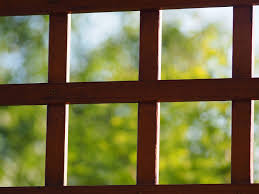
By Paul James
I know. It’s been colder than a well-digger’s foot lately, and for that reason I haven’t spent much time in the garden since the holidays. But I have been thinking a lot about my garden and trying to imagine what changes I want to make once the weather warms up. And thankfully, finally, it looks as though it’s about to do just that.
What I’ve been thinking about most is how to improve the look of my garden from the inside looking out, so that as I stare out the windows while sipping my morning coffee or evening cocktail, or even just stroll past a window, I’m pleased by what I see. Too often people focus exclusively on what their landscape looks like from the point of view of the street, looking back toward their house. That’s certainly important, but it’s only half the picture. Besides, we spend far more time looking out onto our gardens from our house than actually looking at our house!
For example, there’s a large bay window in my living room that looks out onto my back yard. The view is okay, but it’s missing something, and I’ve decided that what it’s missing is a small- to medium-sized tree with great fall color and a branching pattern that isn’t too dense so I can still see through it and beyond. So I’m going to plant a new – and very cool — Japanese maple called ‘Jack Frost.’ Problem solved.
I’ve got three large windows in my office that also provide a view of the backyard, but when I’m sitting at my desk and looking out all I see is sky. So I’m going to plant one Hinoki Cypress tree at the base of each window so that when I look out I’ll see green year ‘round with the sky as a backdrop. Another problem solved.
Then there’s the sliding glass door that leads out to my covered patio. I pass by the door dozens of time a day, and while the view out into the yard is nice, I’ve always felt it needed something. And the other day it hit me. It needs foreground in the form of two large, strongly vertical pots flanking the door in which I routinely or at least seasonally rotate shade tolerant plants – large ferns, various upright tropicals, maybe even yews if I decide on a more permanent solution. Once again, problem solved.
Given the forecast, it looks like I may be able to get back in the garden this weekend. But given that it’s still winter, I’m sure I’ll have plenty more time to solve my gardening problems from the inside looking out. I encourage you to do likewise. Enjoy your coffee…or cocktail.
You Gotta Water in Winter!
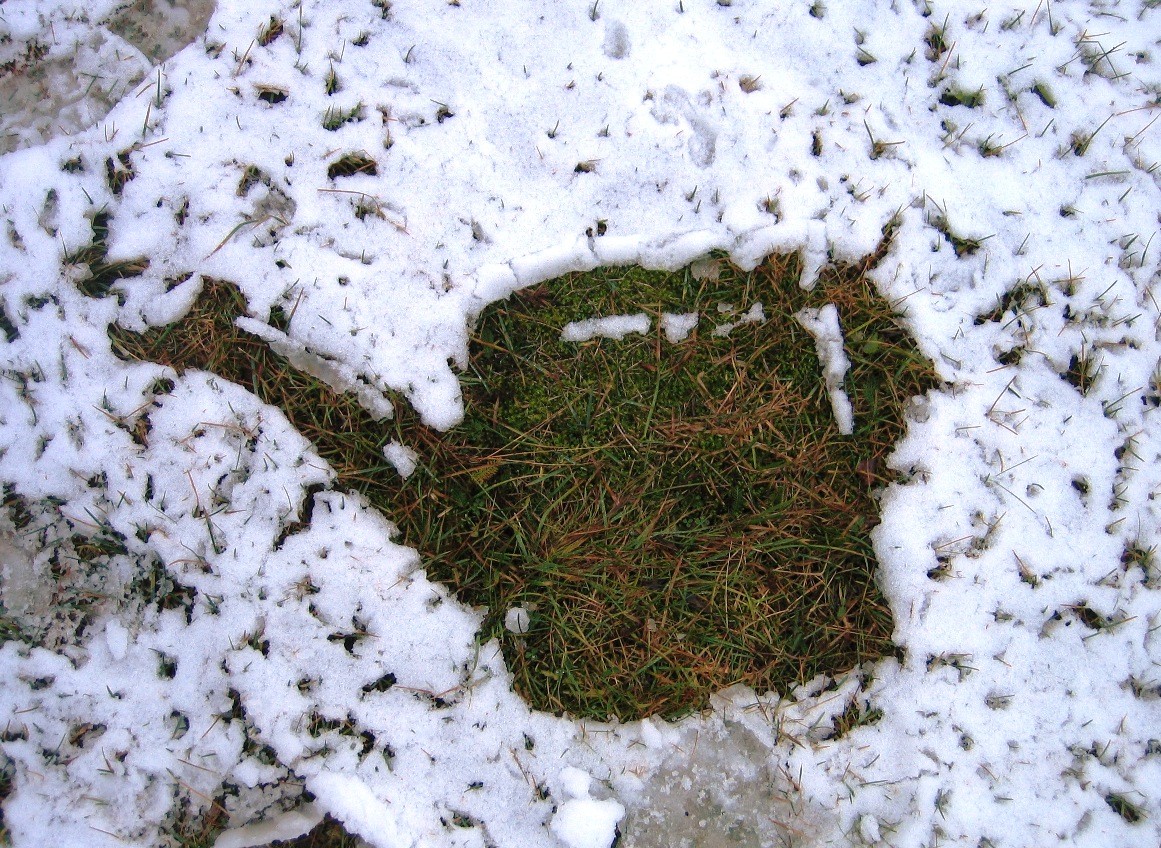
By Paul James
Although it may seem somewhat counterintuitive, it’s crucial that you water landscape plants during the winter months. The combination of dry soil and cold air temperatures can be especially tough on even the hardiest plants, both deciduous and evergreen. So keep these basic watering tips in mind.
First, realize that I’m not suggesting you water all that often during the winter months. Typically once a month will do the trick, although if it’s bone dry in December and January you may need to water twice a month. Pick a day when the temperature is above freezing and the overnight low is forecasted to be above freezing as well. Those conditions happen more often than you might imagine, and on those days you should seize the opportunity.
Deep soak each time you water, but avoid watering the base of trees and shrubs, because if water freezes around the trunk it can damage the bark. Instead water halfway between the plant and just beyond the outer stretch of branches (also known as the “drip Line”).
Evergreens and conifers need more water than their deciduous counterparts because they continue to grow, albeit ever so slowly, during the winter. And many of them, including azaleas, arborvitaes, pines, spruces, junipers, Euonymus, and Oregon grape have shallow roots and are therefore more susceptible to drying out. But even deciduous plants need water in the winter to prevent their roots from becoming desiccated.
The same is true of cool-season turf grasses such as fescue and rye, both of which continue to grow in winter.
Dormant perennials should be watered as well to keep their roots hydrated. And spring-flowering bulbs, which store lots of water in advance of blooming, absolutely must be watered during dry winters.
Of course, if we get plenty of rain this winter you can skip watering altogether, but the extended forecast looks pretty dry. And November was one of the driest on record. This weekend, however, looks beautiful. And you can bet I’m going to water.
The Beauty of Bark
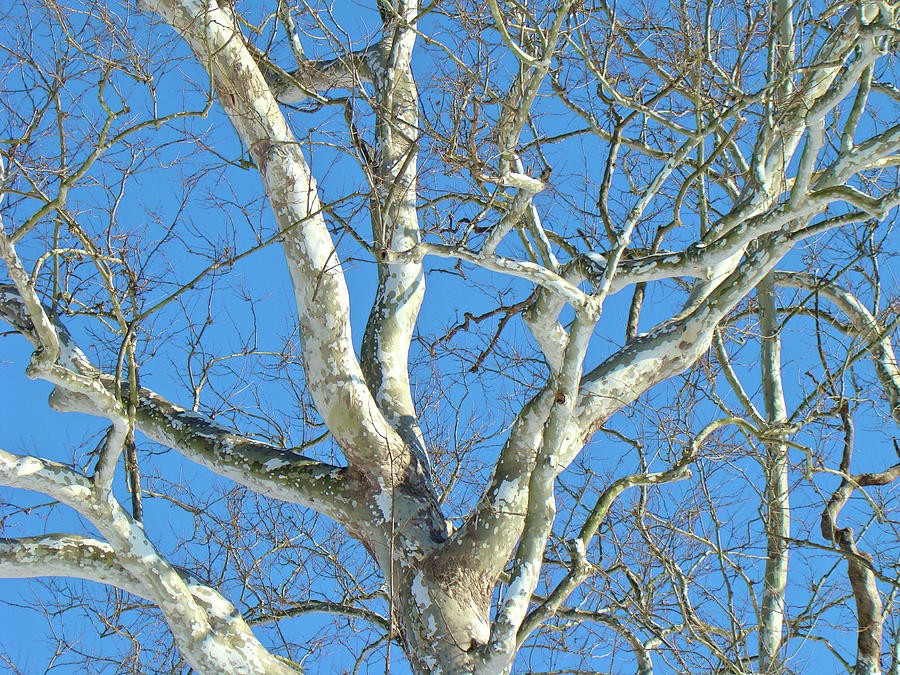
By Paul James
When choosing a tree for your landscape, what attributes appeal to you most? Overall size and shape, growth rate, or maybe fall color? Those are all important considerations for sure, but what is often the most overlooked attribute happens to be my favorite – bark.
Bark is basically dead tissue. It protects a tree’s vascular system, which lies just below the bark layer. And it comes in many textures – smooth or rough, shallow or deep fissured, and exfoliating, just to name a few. On a clear winter day, bark is basically all you see, so why not plant a tree with interesting bark? And with that in mind, here are several trees whose bark I find especially attractive.
Shantung Maple – I like this tree a lot. It’s not as well known as other maples, but it’s gaining in popularity. Like most maples, it produces gorgeous fall color. But unlike most maples, its bark isn’t smooth. Instead, it has a texture that’s best described as cantaloupe skin. Very cool.
Coral Bark Maple – The contrast of its light green leaves against its coral-red bark is striking during the growing season, but the bark makes a statement of its own in winter, especially when planted in front of evergreens or a light-colored wall.
Sycamore – Yes, this tree can be a tad messy, but the bark is so beautiful that it makes it worth growing, especially on a large property. Its brown bark peels away to reveal a white inner bark, which against a clear blue sky is an awesome sight.
Lacebark Elm – This is a great tree that adapts to just about any soil type, and its mottled, multicolored exfoliating bark makes it standout in any yard. The bark of mature trees puts on a beautiful display of red, brown, green, and gray.
River Birch – Another exfoliating bark beauty, river birch grows well in moist soils yet is very drought tolerant once established. Its cinnamon-colored bark peels away in spectacular fashion.
Crape Myrtle –Some crape myrtles are more interesting than others when it comes to their bark, but the old ‘Natchez’ variety is still the best of the lot. Its gray bark peels to reveal an eye-catching cinnamon layer.
Kousa Dogwood – The bark of this Asian dogwood (which by the way tends to flower about a month later than the native species) produces a stunning patchwork of gray, tan, brown, and orange.
Tupelo – This is one of the best trees for fall color, but even after its leaves have fallen, you’re left with a distinctive bark that’s often described as alligator skin.
Dawn Redwood – The deep fissured bark of this deciduous conifer peels away in dark, orange-brown strips that are a sight to behold.
Frost and Freeze Alert
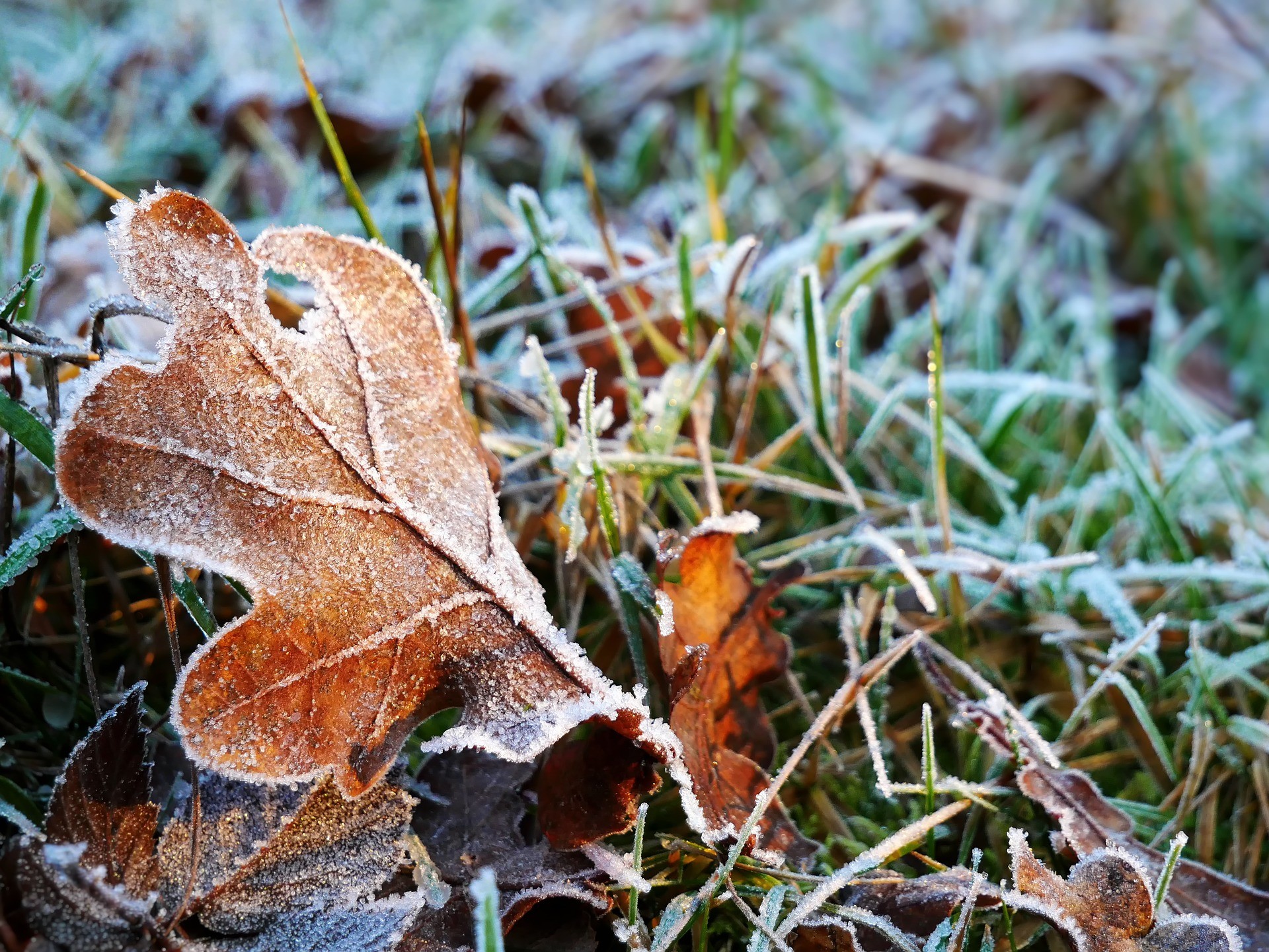
By Paul James
It looks as though the overnight lows both Saturday and Sunday could hover at or dip below freezing throughout the area. But given that it’s late October, that shouldn’t come as a surprise to anyone. The real question is what effect, if any, will the cold temperatures have on plants?
And the answer is, not much. Landscape plants – deciduous and evergreen trees and shrubs and perennials — won’t be fazed at all, so there’s no need to cover anything.
Mums and pansies – whether in the ground or in containers – will also be fine.
Fall vegetables and most herbs will be okay too, although if you’ve still got summer crops such as tomatoes and peppers, they aren’t likely to survive even with protection. The same is true of basil and cilantro. But lettuce, spinach, and other greens, as well as broccoli, Brussel sprouts, cabbage, cauliflower, carrots, kale, and onions will actually benefit from a cold snap because it concentrates their sugars (and makes them taste even better!).
Of course you will need to bring in any tropicals that you’ve had growing in containers outside, assuming you haven’t done so already. You can move them in temporarily, that is until overnight temperatures warm up a bit, but at this time of year you really should consider moving them in for the winter anyway.
So just kick back and relax, knowing all your plants will be just fine. Or said another way, about the only thing you need to do in response to the frost and freeze alert is chill.
Fall Color at its Best
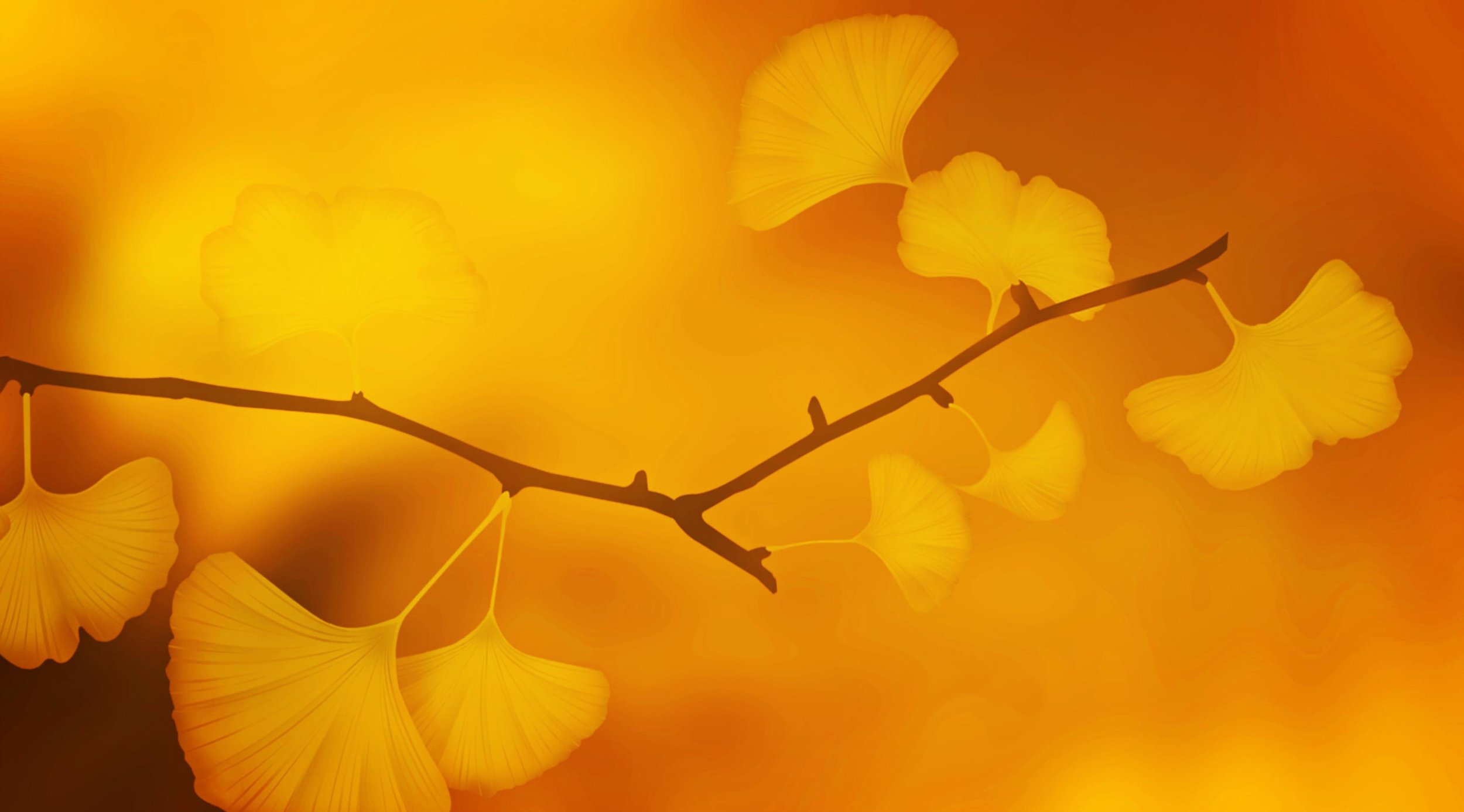
By Paul James
Looking for trees and shrubs that’ll produce jaw-dropping, car-stopping fall color? Well after careful consideration and discussions with several fellow plant geeks whose opinions I respect, I came up with a list of three trees and three shrubs that’ll do just that. And here they are.
Sure, there are many, many more trees and shrubs that I could add to the list, but assuming you’re interested in giving your place a pop of color this fall, I wanted to simplify the decision-making process. And the simple truth is, you can’t go wrong with any of those on the list.
Bulbs – Beyond Tulips & Daffodils
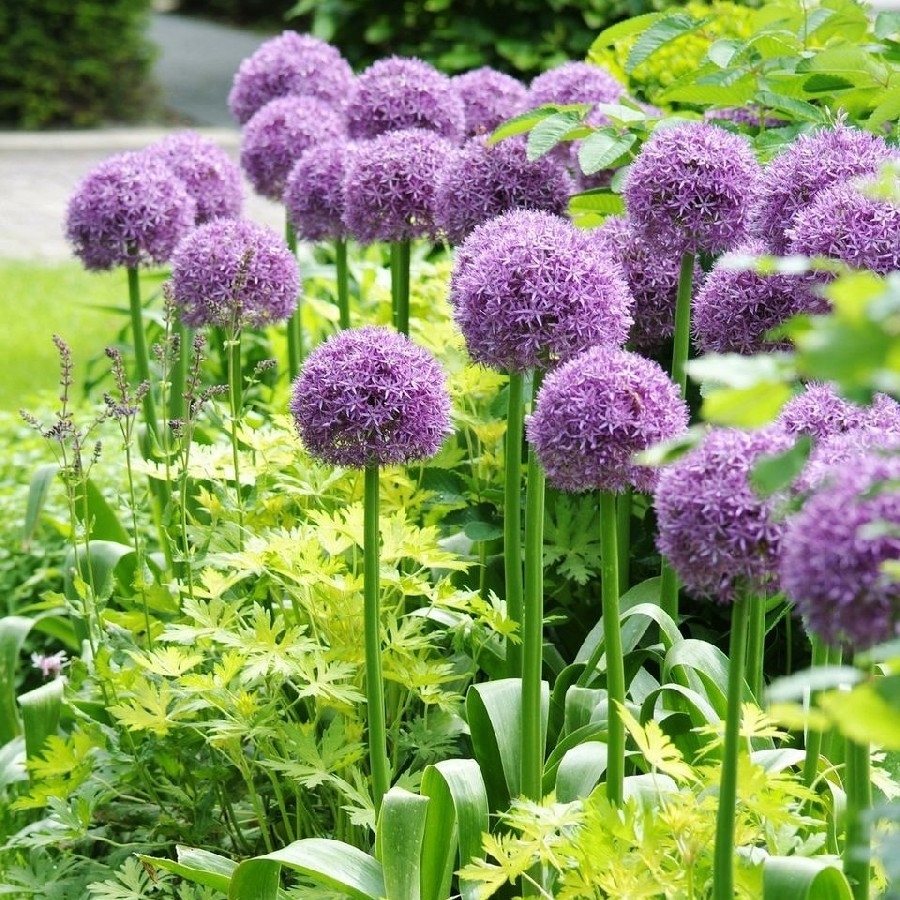
By Paul James
When it comes to spring-flowering bulbs, the stars of the show are daffodils, tulips, crocuses, and hyacinths. But the supporting cast of players, although less familiar, are no less beautiful and deserve a spot in every garden. So when shopping for bulbs this month, you owe it to yourself to consider the following, all of which are easy to grow and come back year after year.
It’s Planting Time!
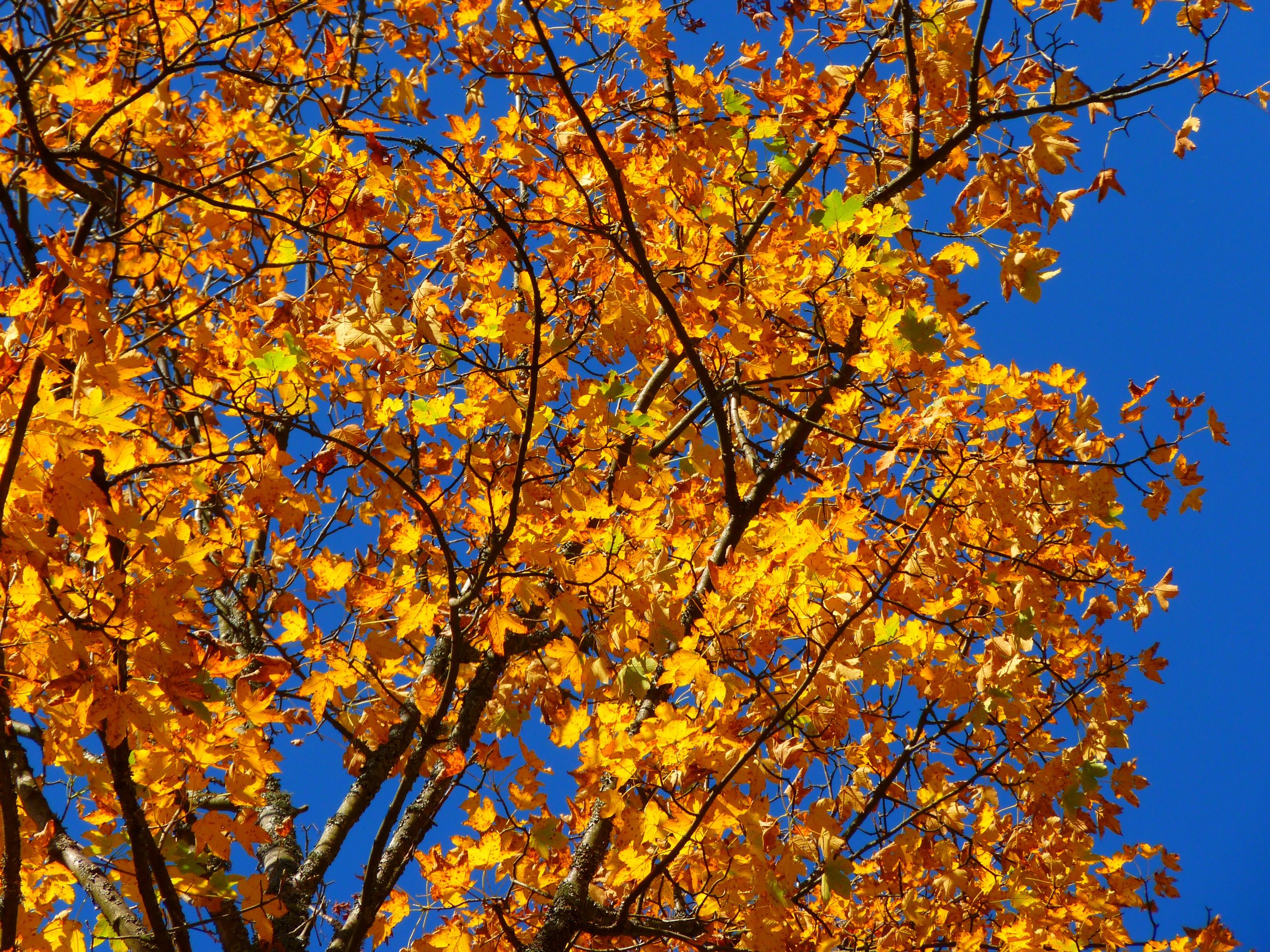
By Paul James
Every year for the past 30 years or more, I’ve tried to convince my friends and fellow gardeners that now is the perfect time to plant all kinds of things. So here I go again. But to be clear, I’m not talking about things that most folks know to plant in fall – mums, pansies, asters, ornamental kale and cabbage, cool-season veggies, fescue and rye grasses, spring-flowering bulbs – the stuff that practically defines fall planting. I’m talking about practically everything else, in particular trees, shrubs, and perennials.
The reason I’ve harped on the subject for so long is that I’ve witnessed firsthand for decades the enormous difference fall planting makes. Allow me to explain by getting to the root (or rather, roots) of the matter.
Planting in the fall gives roots a chance to grow quickly, because the plant isn’t forced to devote near as much energy toward producing foliage or flowers or fruit as it is in spring. Instead, it devotes nearly all of its energy into producing roots, a process that continues for weeks, even months. The reverse is generally true in the spring – a plant’s energy is devoted to new top growth at the expense of root growth.
Consequently, what you plant in fall will be far more prepared for the surge of new growth in spring, and be far better equipped to handle the heat of summer, thanks to its larger root mass. And fall planting greatly reduces the chance of transplant shock, largely because air temperatures are cooler and rainfall is more dependable.
Don’t get me wrong: I’m not saying you shouldn’t plant trees, shrubs, and perennials in spring. But I am saying that given a choice, I’d opt to plant the vast majority of plants from those categories in fall. And so should you.
The Beauty of Bulbs
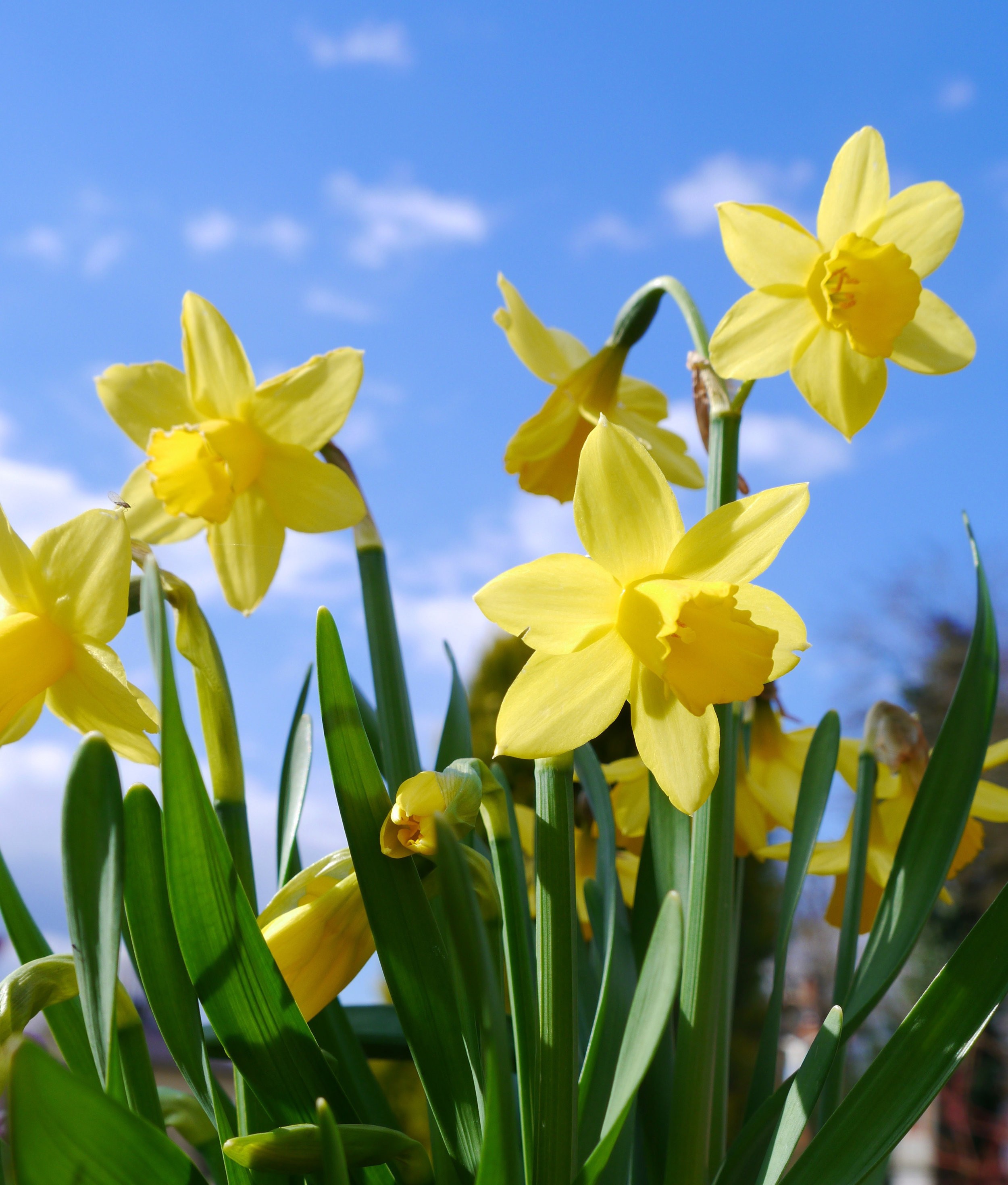
By Paul James
No other plant on the planet gives you more bang for your buck than a single, solitary, spring-flowering bulb, be it a daffodil or a hyacinth or a crocus or whatever. (Yes, I intentionally excluded tulips for the moment – more on them later.)Think about it: in most cases you shell out less than a buck for a gorgeous flower that will return year after year for decades. And in that time all the plant requires is an occasional drink and a light snack.
Spring-flowering bulbs are, in fact, among the most carefree plants you can grow, and they’re pretty much pest and disease free. They’re also a snap to plant with a trowel, mattock, auger bit, or specialty bulb planter. Once you get a rhythm going, you’ll be amazed at how fast you can get them in the ground.
Bulbs typically begin arriving in nurseries a month or so before the ideal planting time, and it pays to shop early to make sure you get what you want. Just store them in the garage in a paper bag and they’ll be fine for a month. As for planting times, I usually start around the middle of October and finish by early November.
And just what do I plant? Well, I’ve always been partial to daffodils. They come in a dizzying array of sizes, colors, and bloom periods, and they’re one of the few bulbs gophers won’t eat. I also love crocuses, especially the fall bloomers, and fritillarias. In recent years I’ve grown fond of the alliums for the big, bold statement they make, and pollinators love their flowers.
As for tulips, well, they aren’t among my favorites, although there’s no denying their beauty. For me, the problem is that they don’t dependably behave as perennials, although some – namely the Darwin hybrids and species tulips – do better than others. However, recent research by the folks at Longwood Gardens suggests that by planting tulip bulbs deeper than usual, as in up to a foot deep, you can get them to return for a few years. I plan on trying that trick this year.
After all, what have I got to lose?
It’s Fescue Time!
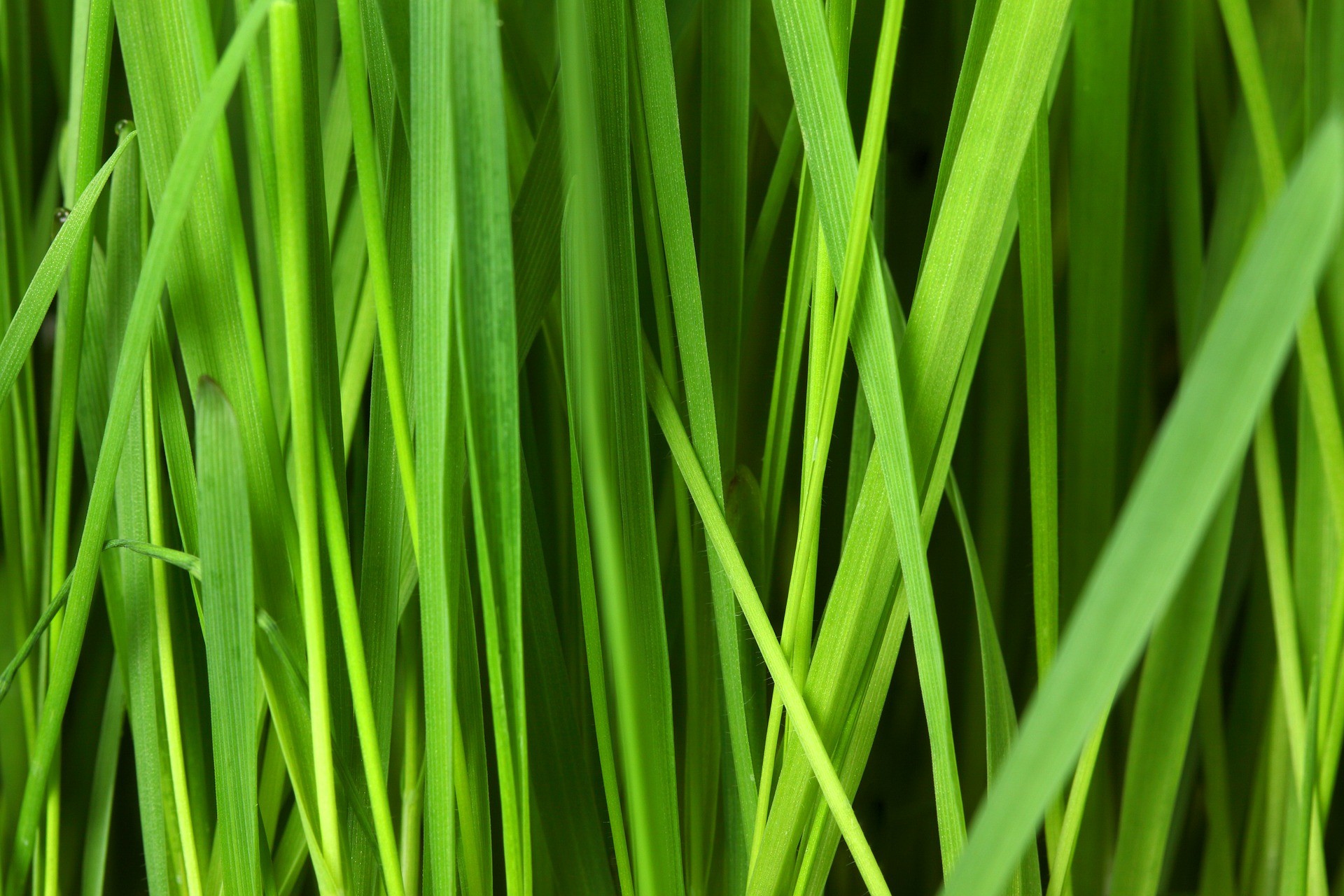
By Paul James
Fescue is originally from Europe. It didn’t actually arrive in this country until the mid-19th century, but it’s been happy here ever since, first as a pasture grass and later as a turf grass in lawns across America, including Alaska and Hawaii. It’s even planted on the South Lawn of the White House. And here in Green Country, fescue is the go-to turf for shady spots, where it thrives with a little fertilizer and regular watering.
That’s not to say fescue is perfect, because it isn’t. It tends to thin out during really hot summers, it doesn’t grow all that well in the deep shade beneath large trees, and it needs not only regular watering, but quite a bit of water as well. Still, it performs well throughout most of the year, and it stays green during the winter months.
Fescue must be planted in spring or fall. Lots of diehard lawn lovers plant it twice a year and that’s fine, but fall planting tends to yield better results. Planting from seed is a simple, straightforward, and relatively inexpensive process that requires little effort. It’s best to use a blend of seeds that contains only tall fescues, or one that contains tall fescues blended with fine fescues, Kentucky bluegrass, or even ryegrass in varying percentages, rather than rely on a single variety. I’ve tried dozens of blends over the years, and while I’ve seen subtle differences in them, I truly believe that the best way to choose one over another is a coin toss.
The most important consideration when getting seed to germinate is even moisture, because dry seed simply will not sprout. Typically, that means watering every day to keep the top ¼-inch or so of soil moist. Do that, and you should see germination within seven to ten days.
Of course, there’s a lot more to learn about creating a lush fescue lawn, from tips on sowing the seed to weed control to fertilizing to mowing. That’s why I’m presenting a free seminar called “Fall is for Fescue” this Saturday at 10:00 am at Southwood. To register, CLICK HERE.
My First Garden
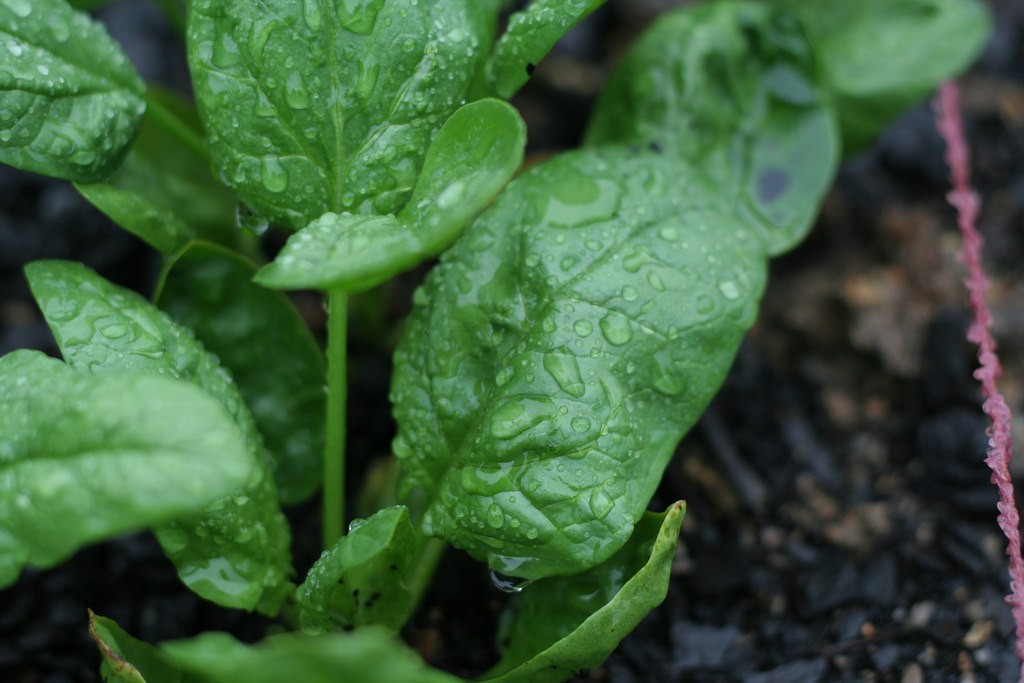
By Paul James
Carrie and I bought our first home in 1979, and before we’d unpacked all the moving boxes I was busy preparing my first vegetable garden. Step one involved removing (by hand) roughly 400 square feet of Bermuda grass, which took two weekends. Step two involved rototilling the entire area. Problem was, I didn’t own a rototiller. Nor did I have a way to transport one.
But fortunately, my father-in-law had a pickup, and a friend’s dad had a rototiller — a huge, fire-engine red Troy-Bilt with all the bells and whistles, including electric start.
So early one Saturday morning, more excited than a gopher in soft dirt, I borrowed the pickup and drove to my friend’s dad’s house to get the tiller. The two of us struggled to get it into the bed of the truck, but we finally got it loaded and secured, and off I went. Driving home, I realized that I hadn’t arranged for any help unloading the tiller, but I convinced myself that I could go it alone.
I was wrong. While attempting to unload the tiller, I lost my balance. I hit the driveway hard, and the tiller came crashing down on me. Thankfully, it fell upside down, which is to say tines side up. Otherwise I probably would have been cut up pretty badly. Instead, I only suffered a broken arm, wrist, thumb, and index finger.
Four or five hours later, back from the hospital with a giant elbow-to-fingertips cast and the calming effects of pain medication, I decided to finish the job I’d started, despite the warning on the pill bottle about operating heavy machinery, which to me at the time sounded more like a tractor than a rototiller.
One of Troy-Bilt’s claims to fame back in the day was that their tillers were so easy to use you could operate them with one hand. I found that to be the case. Within a couple of hours, I’d tilled my new garden and was ready to plant.
The next day I planted peas, potatoes, onions, broccoli and cauliflower, plus a dozen or so different salad greens and some spinach. As the weeks went by I proudly watched my patch of veggies grow and grow, and when it came time to harvest my first batch of spinach, I was just plain giddy. I’d harvested spinach before – in my father’s and grandfather’s gardens – but this was my spinach, and it was the best tasting spinach I’d ever eaten.
This weekend – 38 years after establishing my first garden, and in what will likely be my last garden — I’m going to plant peas, potatoes, onions, broccoli and cauliflower, plus a dozen or so salad greens and some spinach. And you know what? It’ll be the best tasting spinach I’ve ever eaten.
Be Wise – Fertilize
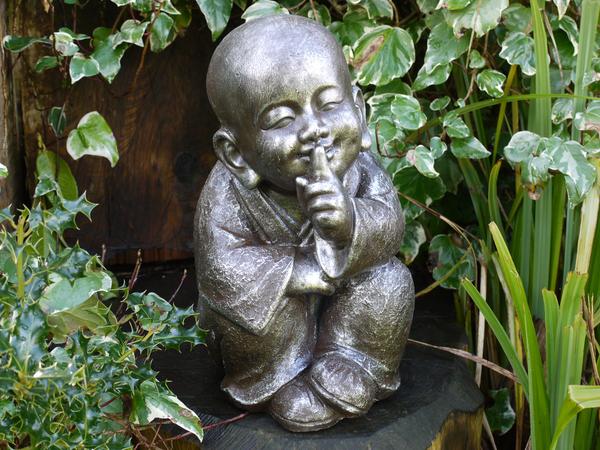
By Paul James
The window between the end of summer and the beginning of fall is the perfect time to fertilize deciduous plants and turf grasses. And the reason is simple: Providing nutrients that have been depleted during the growing season will enable plants to enter the winter months with the food reserves they need to stay healthy and begin robust growth in spring.
In fact, if you can only afford to fertilize once a year, late summer to early fall (as in now through the end of September) is the best time. Focus on deciduous trees and shrubs, perennials, and turf grasses, including warm-season varieties such as Bermuda and zoysia as well as their cool-season counterparts such as fescue and rye.
What you don’t want to fertilize now are evergreens, including azaleas, boxwoods, hollies, photinias, pines, spruces, cedars, junipers and so on. Both broad- and needle-leaved evergreens should be fertilized in early April through the first of July, but no later. Fertilizing this time of year will stimulate new growth that may not have a chance to harden off before freezing temperatures arrive, and that new growth can easily be damaged.
The choices among fertilizers are so vast and varied that it’s hard to make a specific recommendation. But if you stick with well established name brands – Espoma, Scotts, and Milorganite, for example – you really can’t go wrong. Synthetic fertilizers such as those made by Scotts are extremely water soluble, which basically means the nutrients dissolve quickly and produce rapid results. The nutrients in natural fertilizers made by Espoma and Milorganite are not very water soluble, so it may take a week to ten days to see results. However, the results are typically longer lasting.
For at least 30 years, I’ve used nothing but Milorganite on my lawns and gardens. Strictly speaking, it’s not organic, but it is all natural. It’s made from biomass (fancy word for “poop”) from the City of Milwaukee, and it’s one of the greatest and most successful recycled products in horticulture history. Milorganite is a slow-release fertilizer with an analysis of 5-4-0 plus 4% iron (an overlooked element that helps plants green up). It’s also non-burning, which basically means you can sling it on anything that grows (except evergreens this time of year).
Weather in a Word – Wow!

By Paul James
August is ordinarily so hot and dry that I discourage people from planting certain things, in particular large trees and shrubs as well as conifers. But given the current weather pattern we’re in – and the long-range forecast for the rest of the month — I wouldn’t hesitate to plant anything and everything, including large trees and shrubs and yes, even conifers.
After all, we’re seeing well-below average daytime temperatures, cool overnight temperatures, and well-above average rainfall. (The storm that blew through early last Sunday morning dumped twice the average monthly amount of rain in Bixby in only two hours!)In other words, it’s been more like early June or late September than the middle of August.
But it’s not just the daytime temps and rainfall that convince me it’s okay to plant. Most importantly, it’s the overnight temps. We can all recall years past when evenings in August were insufferable, like when the temperature at 10pm was in the mid-90s and the thought of sitting on the patio was the furthest thing from our minds, right? Well I don’t recall an evening this August when Carrie and I weren’t on the patio at night (maybe not at 10pm, however; at our age, we tend to retire closer to 9).
And given a choice, plants much prefer the cooler nighttime temperatures. It enables them to “rest,” and in the process carry out vital physiological processes that only take place at night.
Of course, I’m not saying we won’t see an occasional day in the upper 90s. After all, it is August. But so long as the nights are cool – which means soil temps will be cooler than normal as well and roots will produce new growth – I plan on planting whatever I want. And yes, my list includes conifers.
Ants: Friends or Foes?
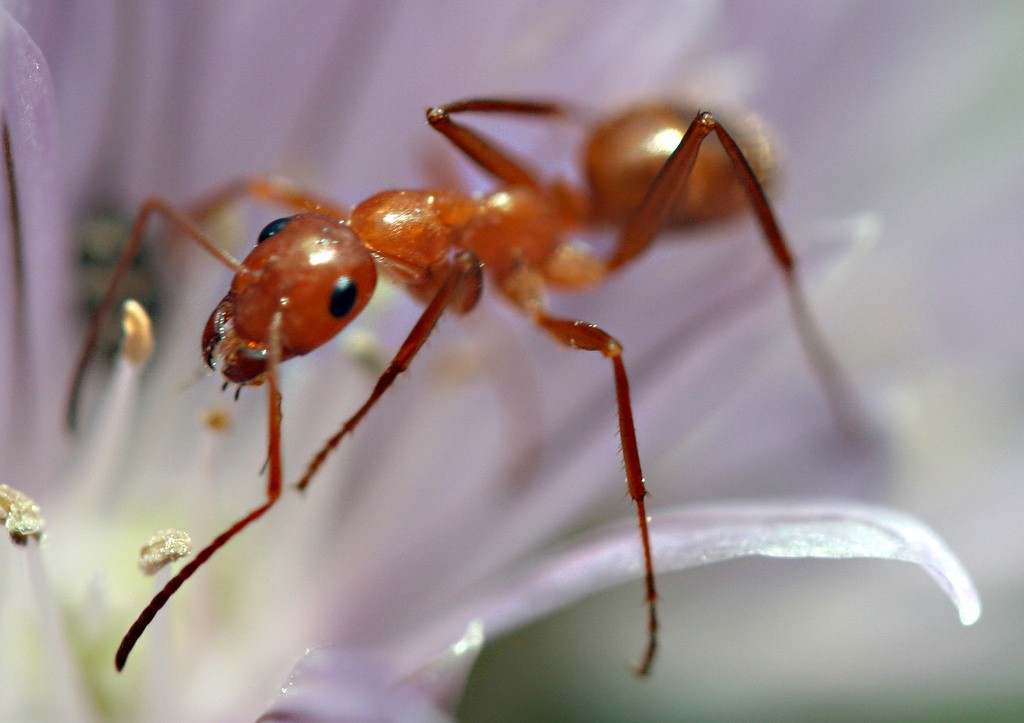
By Paul James
I get asked so many questions about ants that some days I just want to scream, “Uncle!” So let me just say right off the top that most ants aren’t bad. In fact, most ants are enormously important little critters. And rather than seeing them as pests in the garden, I suggest you think of them as partners. Here’s why.
Ants are recyclers. Red and black tunneling ants commonly found in lawns and gardens scavenge the soil in search of dead insects and a host of other organic nibbles and turn them into fertilizer. They also aerate the soil and redistribute nutrients along the way.
Ants are predators. Several species of ants feed on fleas, fly larvae, and termites, as well as the larval and adult forms of numerous garden pests.
Ants disperse seeds. A number of wildflowers depend exclusively on ants for dispersal of their seeds, including bleeding hearts, bloodroot, trillium, trout lily, wild ginger, and violets. In fact, these plants are thought to actually time their bloom period for when ants are most active.
Ants protect plants. Ants are attracted to the sweet nectar found on plant stems and the bases of flowers, and while feeding they also patrol the plants and keep insects from attacking them. A familiar example of this is seen on peonies in late spring. Ants crawl all over the sticky flower buds devouring the sweet nectar, and in return they protect the peony from potential pests. (There is disagreement over the popular notion that ants actually help the flowers open.)
Ants are custodians. Leave a few crumbs or other morsels on a picnic table, and overnight they’ll likely be gone thanks in part to ants, who are extraordinarily gifted at finding and hauling away scraps of just about any and every food type.
Ants are food for others. Let’s not forget the way the food chain works – sometimes you’re predator, sometimes you’re prey. And ants are an important food source for other insects, spiders, frogs, lizards, birds, fish, some mammals, and even people (don’t knock them ‘til you’ve tried them).
Of the nearly three dozen ant species in Oklahoma, only two are cause for concern. Carpenter ants (red or black) are one of the largest species common in our area, and over long periods of time they can cause damage to trees and wooden structures, including homes. They don’t actually eat wood, but they do chew it as they tunnel. They probably should be controlled, especially when populations get out of control.
And of course there is the red imported fire ant that lives outdoors and whose sting packs a mighty wallop. They’ve been sighted in Tulsa and a few surrounding counties, and they’ve become prevalent in southern Oklahoma. If you suspect these little monsters have inhabited your yard, you definitely want to take steps to get rid of them.
In the home, I can see how most people might few them as pests. But in all fairness, household ant invasions are largely the result our own doing, meaning they aren’t likely to stick around if food sources aren’t available (juice spills on countertops, grease on stovetops, ripe fruit sitting out, for example.)
If you’re compelled to get rid of ants, there are several effective products on the market, most of which contain some form of boric acid (Borax) or synthetic pyrethroid. Diatomaceous earth is an excellent organic alternative.
Mushrooms in the Lawn
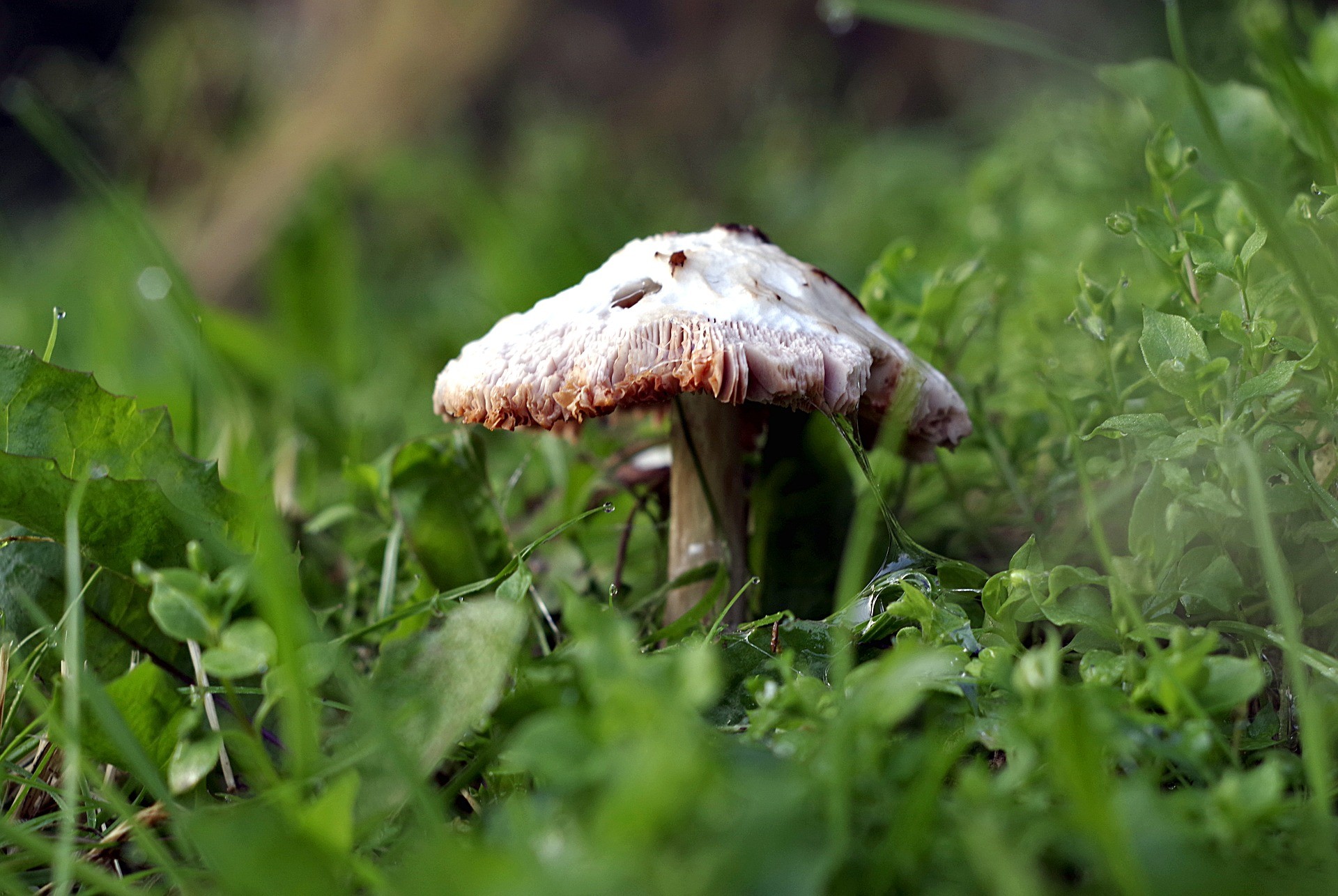
By Paul James
Mushrooms have been popping up in lawns all over town, and their presence causes many a homeowner to panic and wonder how best to destroy them – some sort of fungicidal spray or powder, or perhaps a pitching wedge? Well you might be surprised to learn that my approach to dealing with mushrooms in the lawn is much simpler.
That’s because I do absolutely nothing.
Truth is, I enjoy seeing the fruiting bodies of various fungi aboveground because it tells me that belowground their hyphae and mycelia (fungal roots, if you will) are busy feeding on and helping decompose little chunks of wood, old roots, and other organic matter and turning it into soil. And in the process, they’re releasing nutrients that feed the soil and plants. In other words, they’re part of a healthy soil ecosystem. Besides, fungicides absolutely will not control them, and a pitching wedge will likely do more harm to your grass than a million mushrooms ever could.
The presence of mushrooms in the lawn can tell you something about the condition of your soil, because most mushrooms prefer to grow in soils that don’t drain well. But even in soils that do drain well, excessive rainfall or overwatering can trigger their arrival.
There are a few destructive varieties of mushrooms, notably those that attack oak trees. The culprit is actually related to the shitake mushroom, but sadly once they show up at the base of a tree, there’s nothing that can be done to save the tree.
And of course there are poisonous mushrooms, though they’re rarely found in the lawn. Still, if you have young children or pets, it’s best to remove all mushrooms in the lawn just to be on the safe side.
Finally, unless you’re a trained mycologist or experienced amateur, you should never, ever eat the mushrooms growing in your lawn. Again, chances are the mushrooms in your lawn aren’t poisonous, but according to a friend who is a trained mycologist, most of them either have no taste at all or taste awful. And that’s reason enough not to eat them.
Mole Control

By Paul James
Been noticing a lot of mole tunnels popping up in your yard lately? That’s because a new generation of moles, born in April and May, has matured and is busy staking out new territory. The good news is that moles are very territorial, and rarely are there more than three in an entire acre, except perhaps during the late-winter mating season, so typically the average-size yard is harboring only one. The bad news of course is that even one can be a nuisance.
Fortunately, moles don’t eat plants (voles and gophers do, but that’s another story). Instead, they prefer a steady diet of primarily white grubs and earthworms, which they consume in huge quantities as they tunnel through lawns and gardens. It’s those tunnels – indicated by raised sections of dirt or grass — that announce their presence, although they occasionally leave behind above-ground mounds of dirt as well.
The tunnels you can see are known as runways, in which moles feed and use as pathways to deeper tunnels and their lairs. They may use the runways for several days so long as food is present, or they might abandon them after only one day of digging if food isn’t present, only to immediately create another.
So just how do you go about controlling moles? Well you could do nothing, and embrace the mole’s presence, knowing that he or she is gobbling up the grubs that might ultimately become Japanese beetles and attack your roses, and aerating the soil in the process.
You could try repellents, nearly all of which contain castor oil and do a pretty good job of moving moles elsewhere assuming you follow the label instructions to the letter and reapply after heavy rains. I’ve actually had excellent results with repellents.
You could use harpoon-style traps, which if placed properly can be highly effective, if not a tad gruesome.
You could hire an exterminator. They don’t come cheap, and some don’t even guarantee that they’ll be successful, but folks in my neighborhood who’ve relied on their services have been pleased with the results.
You could try poisons, but realize that moles aren’t likely to eat anything that doesn’t resemble a grub or earthworm, so poisons that control mice and other critters won’t work. Even the poison “worms” are only marginally effective at best, because moles can tell the difference between real and fake worms.
And finally, you consider any number of different home remedies, from stuffing tunnels with dog or cat hair to flooding the tunnels to using Juicy Fruit gum (which the moles are said to eat, but are unable to digest). Just keep in mind that the effectiveness of these approaches is purely anecdotal, with no basis whatsoever in science.
Homegrown Tomatoes
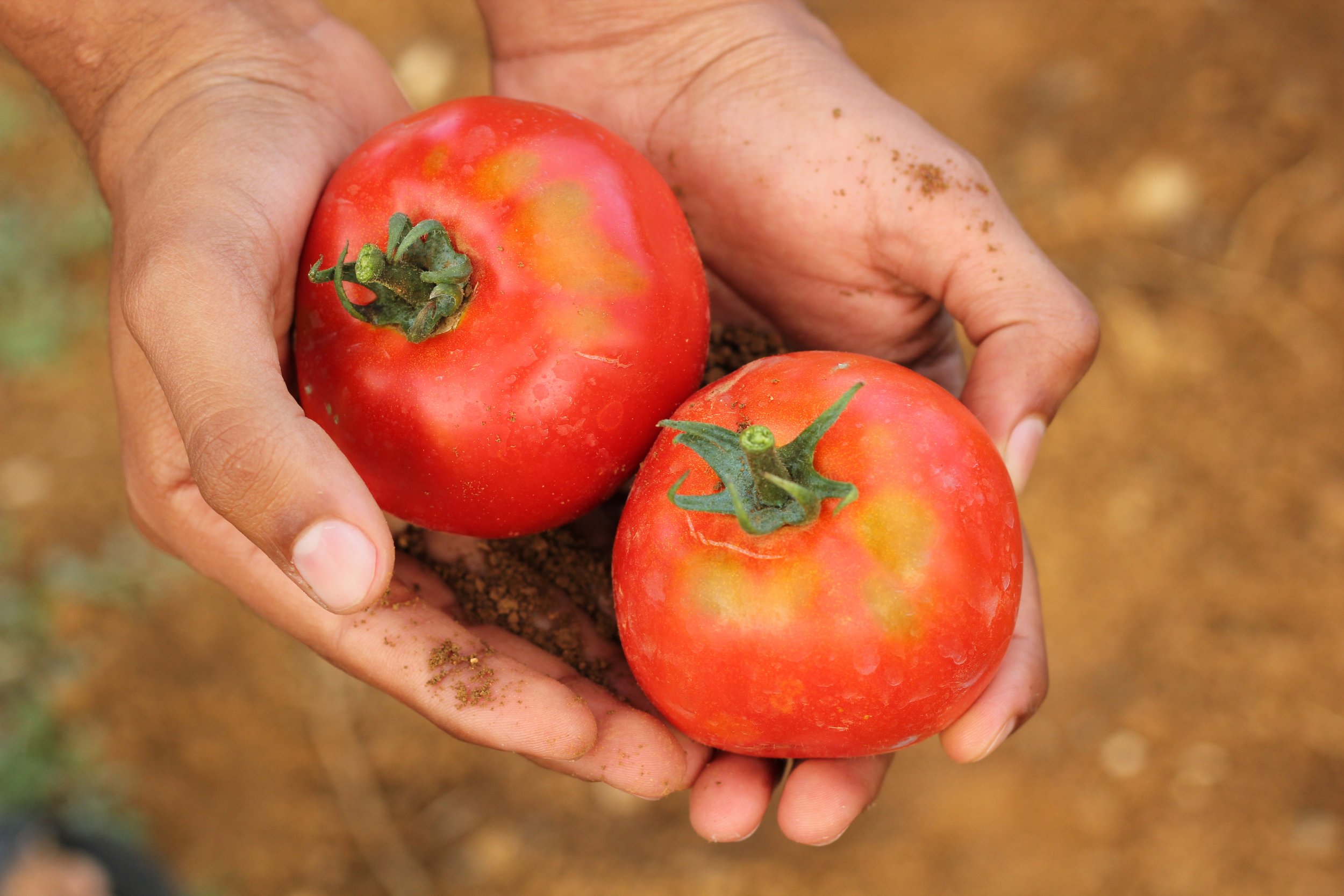
By Paul James
“Only two things money can’t buy. That’s true love, and homegrown tomatoes.” So said the late, great singer/songwriter Guy Clark in his 1983 ode to America’s most popular backyard crop titled, appropriately enough, “Homegrown Tomatoes.” No doubt most of us would agree with him, but getting a good harvest of homegrown tomatoes can be tricky.
After all, tomatoes are vulnerable to a number of diseases, including bacteria, fungi, and viruses. Some diseases prefer cool spring temperatures while others prefer the heat of summer, which means the plants are vulnerable to attack throughout the growing season. And all can be rather nasty and difficult to control. Insects can wreak havoc on tomatoes as well, although they’re generally easier to control than diseases assuming you act before the pest population gets out of control. And there are other issues such as blossom-end rot and cat facing and sunscald, just to name a few.
But for many gardeners, including me, the greatest threats to homegrown tomatoes are squirrels and birds, both of which have the uncanny ability to attack the ripening fruit the day before we intend to harvest.
And yet, despite what seems to be a doomed-to-fail scenario, we continue to grow tomatoes year after year because the lure of getting at least one tasty treat is as powerful as our quest for true love. Or the perfect BLT.
If your tomatoes have fared well so far this year, good for you. Keep in mind, however, that as daytime temperatures exceed 90 and overnight temps remain in the mid 70s, your plants may stop setting fruit. That’s a normal response, and there’s not much you can do about it. The condition tends to affect heirlooms more than hybrids, but in both cases the situation will reverse itself once temperatures moderate. And if temperatures remain mild from late summer to fall, the fruit that develops will have time to ripen.
In the meantime, be on the lookout for pests and diseases, consider fertilizing your plants to replace the nutrients lost in fruit production, water frequently — deep soaking the plants each time while keeping the foliage dry — and mulch heavily. And as you do all that, think of these two lines from the same Guy Clark song.
“Plant ’em in the spring eat ’em in the summer.
All winter without ’em’s a culinary bummer.”
Summer-Blooming Shrubs
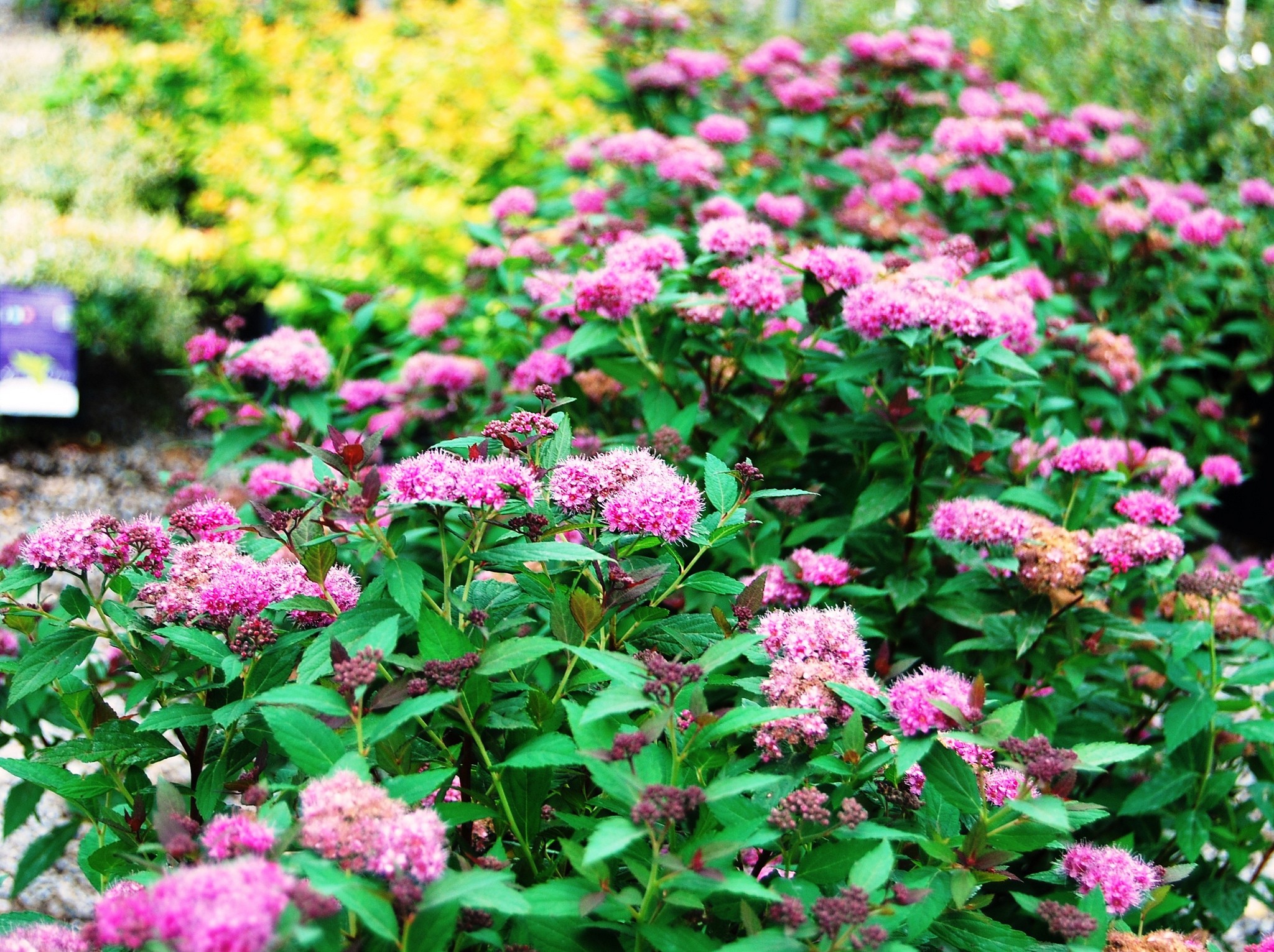
By Paul James
Shrubs rarely get the attention they deserve, and yet they tend to be among the most carefree plants in the landscape. Those that bloom in spring – azaleas and hydrangeas in particular – do briefly bask in the glory while in bloom, but it’s the summer bloomers that I find more rewarding, largely because their bloom period lasts so long. Aside from the obvious – crape myrtles and roses – here are some of my favorite summer-blooming shrubs.
Abelia: There was a time when there was only one Abelia on the market. Thankfully, that’s no longer the case. There are now over a dozen cultivars of this beautiful evergreen summer bloomer, and two in particular – ‘Rose Creek’ and ‘Kaleidoscope’ – are hard to beat. Rose Creek grows to about three-feet tall and wide, has dense green foliage and produces a profusion of white flowers. Kaleidoscope is a variegated variety that’s a tad smaller. It too produces white flowers.
Althea: Better known as Rose of Sharon, this deciduous shrub is as tough as it is beautiful, and its okra-like flowers (it’s actually related to okra) appear non-stop from summer to fall. Flowers are available in a variety of colors, including white, pink, red, violet, and blue. Most will grow to at least eight-feet tall, although dwarf cultivars are available.
Butterfly Bush: These are the most popular butterfly attractors on the market. But even if that weren’t the case, they’d be worth growing for their gorgeous colorful flowers that linger into fall. Plant in full sun, and prune back hard in early spring.
Chaste Tree: I know, I’ve mentioned this shrub in the genus Vitex quite a few times, but that’s only because I adore it. It blooms throughout the summer, and it’s pretty much always covered with bees, bumblebees, butterflies, and moths. And the best news of all? You can get a dwarf variety called ‘Blue Puffball’ that only tops out at three, maybe four feet.
Desert Willow: Blooming from spring through summer with large, orchid-like flowers, this drought-tolerant beauty makes a great specimen. Yes, it can get rather large for a shrub, as in 20-feet tall, but something so beautiful deserves to get big, don’t you think? And by the way, the Desert Willow isn’t a willow at all.
Oak Leaf Hydrangea: Okay, so here’s another shrub I brag about often, but so does just about everyone I know who grows it. Seriously, this is a hydrangea that tolerates sun, produces jaw-dropping white flowers, and is about as easy to grow as crabgrass. Oh yeah, and its fall color is pretty nice, too.
Spirea: Two of the best summer-blooming Spirea are ‘Neon Flash’ and ‘Magic Carpet,’ and you can’t go wrong with either. The former produces neon-red flowers, while the latter boasts rosy-pink blooms. Both are deciduous and grow to about three-feet tall and wide.
Early Summer Things To Do
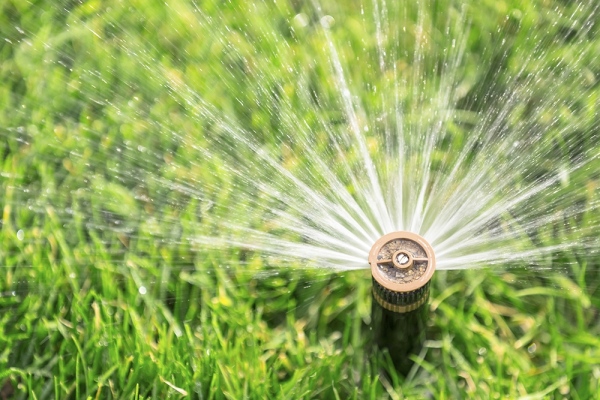
By Paul James
Not sure what you should be doing in the landscape now that summer has officially arrived? Here’s a list of things to consider, all of which will help insure that your lawn and gardens continue to look their best in the months to come.
In the lawn, the most important thing you can do is increase the deck height of your mower by at least one notch. Doing so will promote deeper root growth, keep the soil cooler, and prevent sunlight from reaching dormant weed seeds. Use a mulching mower to return the nutrients in grass clippings back to the soil. And when you mow, try not to remove more than one-third of the leaf blades to reduce stress on the grass.
Continue planting annuals and perennials. Just because it’s getting hotter doesn’t mean you should stop planting. On the contrary, most flowering plants popular in this area are popular because they thrive in the heat. After planting, apply a thick layer of mulch (at least two-inches deep) and water well and often to promote rapid root growth.
Speaking of rapid root growth, there are a number of trees and shrubs whose roots grow best in warm soils, especially Crape Myrtle, Vitex (Chaste Tree), and Desert Willow, just to name a few.
In the veggie garden, consider sowing from seed a second crop of beans, corn, cucumbers, squash, and melons. All are warm-season crops that can take the heat. Keep an eye out for bugs, especially on the undersides of leaves. Use products containing spinosad to control most garden pests. It’s all natural and extremely effective. Apply a thick layer of mulch to tomato plants to lessen the likelihood of blossom-end rot on developing fruits.
Light pruning this time of year is perfectly acceptable, especially if your goal is to reduce the overall size of trees and shrubs or to thin out interior branches. Fruit trees in particular benefit from summer pruning.
And finally, water everything routinely. Container plants, veggies and herbs, and newly planted plants may need to be watered every day. Turf grasses and most ornamental plants need at least one inch of water every week. And trees and shrubs should be deep soaked every week as well.
The Heat is On!
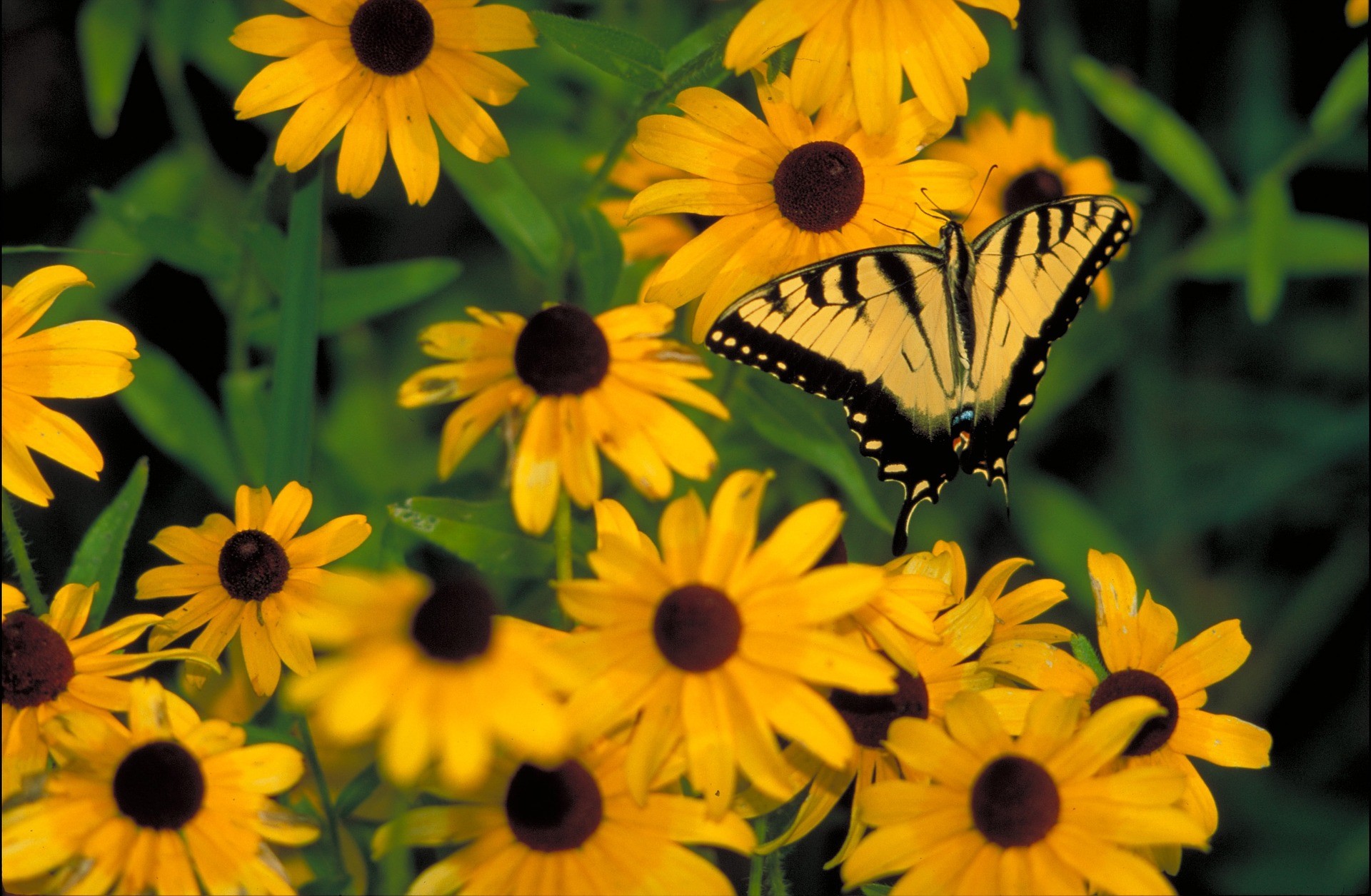
By Paul James
In just about every landscape, there’s a sunny spot that’s not just hot, but crazy, insane, over-the-top hot. It might be an area adjacent to a sidewalk or driveway or concrete patio. It might be near a light-colored brick or stucco wall. It might be in a bed that’s mulched with stone. Regardless, spots like that require plants that can take not only full blazing sun but intense reflective heat as well. And thankfully, quite a few plants fit the bill.
Annuals
Nearly all popular annuals used for seasonal color can take the heat, including Marigolds, Petunias, Vinca, and Zinnias. But two in particular stand out: Lantana and Portulaca. They’ll thrive in the most unforgiving heat imaginable, and both come in several color choices. What’s more, both are great in the ground or in containers.
Perennials
Among perennials, my top picks for the heat are Black-Eyed Susan, Daylilies, Hardy Hibiscus, Ice Plant, Salvia (especially the Salvia greggii selections) and any and all Sedums. They’re all tough as nails, and beautiful to boot.
Shrubs
When it comes to heat tolerance, you can’t go wrong with Althea (Rose of Sharon), Barberry, Crape Myrtle, Spirea, and Vitex. They all welcome the heat with open arms (or branches). Althea and Vitex are especially tolerant of intense heat, and both attract pollinators.
In addition to be able to withstand the heat, these plants look great when combined, which means you can have a beautiful mix of sizes, colors, and textures even in the most inhospitable spot in your landscape. Do keep in mind, however, that while these plants can take the heat, they still need to be watered once a week or so during the summer months. Beyond that, however, they don’t require much care, which means you’ll have more time for fun in the sun.
The Trademark Tree of Tulsa
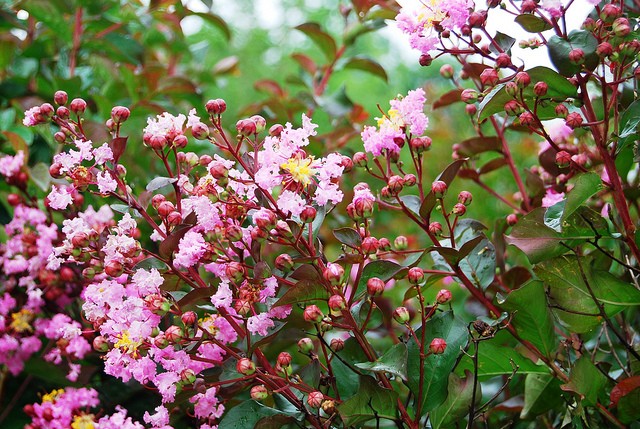
By Paul James
With all due respect to our state tree — the redbud — I think the crape myrtle defines Tulsa and its environs better than any other tree. That’s not to say it’s my favorite tree, because it isn’t, but it’s certainly among my favorites, and it vaults to the top of the list when it’s ablaze in summer blooms.
I remember a time when essentially all crape myrtles on the market were destined to grow at least 15-feet tall, the choices in terms of flower color were limited, and the leaf color was pretty much the same no matter which variety you chose.
All that’s changed. Leaf colors are now available in reddish to purple to almost black, and although the basic colors haven’t changed, the range of hues certainly has.
But the greatest thing about crape myrtles these days, as opposed to just a decade or so ago, is that there are so many sizes available, from less than two-footers to over 20-footers, and just about everything in between. And in addition to the familiar tree forms, there are some awesome shrub forms as well. In other words, there’s a spot somewhere in your garden for a crape myrtle, assuming it gets plenty of sun.
And just in case you’re wondering what is my favorite tree, it’s the Ginkgo. Except when crape myrtles are in full bloom.
Ten Terrific Tropicals
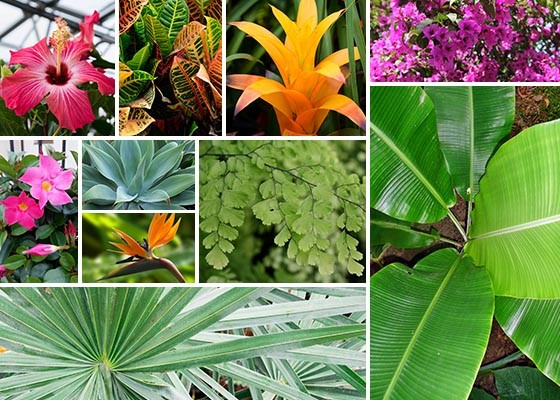
By Paul James
I’ve been growing tropical plants in containers for decades, and this year is no exception. Yes, I know they likely won’t survive past October. And no, I don’t attempt to overwinter them indoors as I once did on a grand scale. But no matter. I love the way they look, and that’s reason enough to plant them.
Here’s a rundown of my favorites, any and all of which love the weather here in summer, and will do wonders to liven up the pool, porch, or patio for several months to come.
And BTW – these plants don’t have to be grown in containers. You can plant them in the ground as well, and create a cool tropical oasis in your own backyard.
Mosquito Alert!
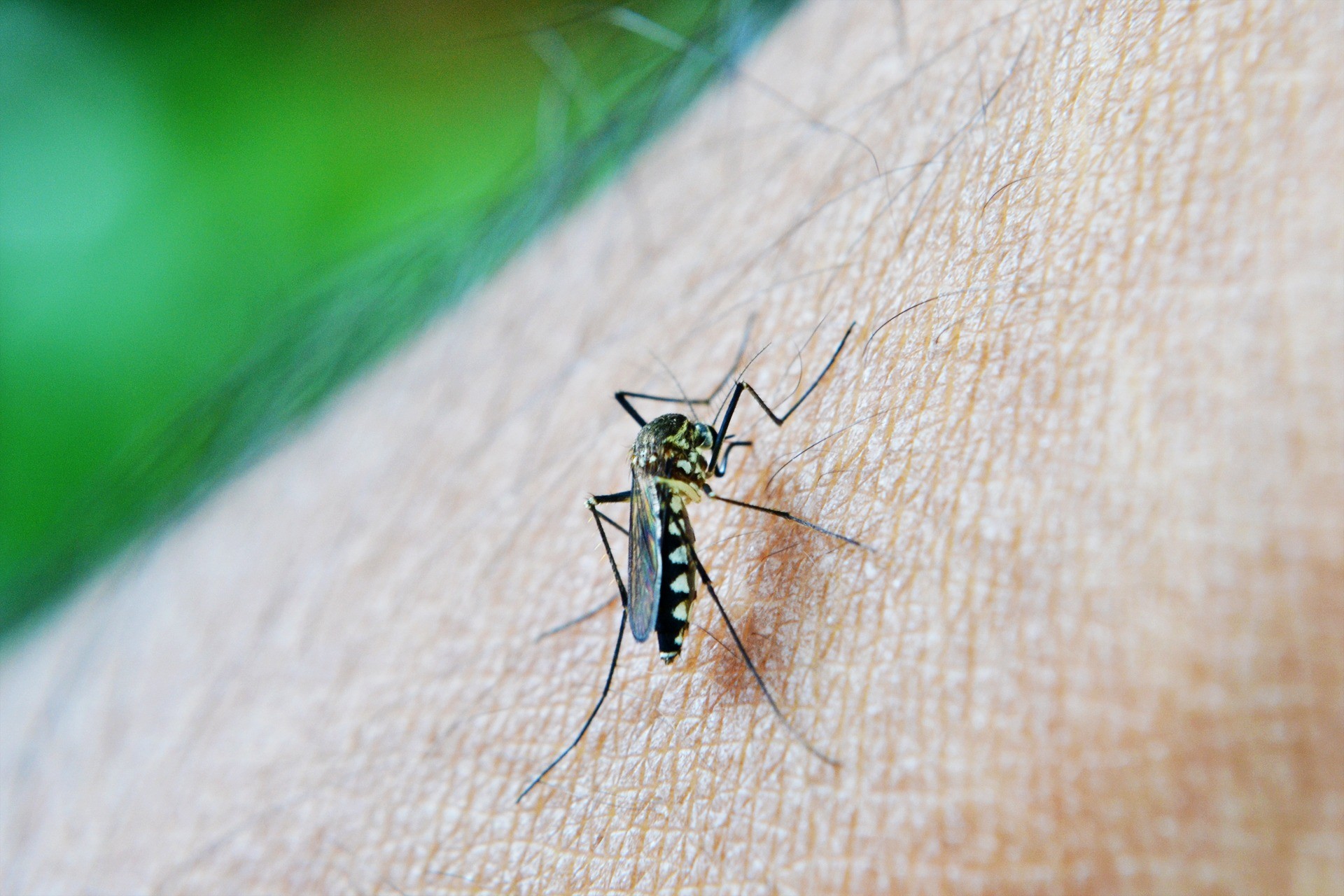
By Paul James
A small percentage of people on the planet don’t get mosquito bites. I’m one of them. My daughter in law and granddaughter, on the other hand, can be sitting right next to me on the patio and get two dozen bites in five minutes. So what gives? And what can they do to protect themselves?
First, the what gives. Turns out mosquitoes don’t like the way I smell, and according to microbiologists who study such things, that’s due to a particular scent emitted by the trillion or so bacteria that inhabit my skin. (And for the record, most people think I smell just fine, thank you. At least most of the time.)
But the bacteria that live on my daughter’s and granddaughter’s skin emit an odor that’s apparently and unfortunately attractive to mosquitoes, which explains why they’re both basically mosquito magnets. And by the way, there’s nothing they can do to change that.
So now let’s talk protection. First and foremost, you have to eliminate the habitat mosquitoes love, and that’s standing water – in plant saucers, in wheelbarrows, in clogged or sagging gutters, in kiddy pools – anywhere and everywhere water remains for more than a few hours. And you’ve got to encourage your neighbors to do likewise, because mosquitoes can travel from their yard to yours.
Bt dunks, donuts, or granules should be used in birdbaths, water features, holes in trees where water collects, and anywhere else standing water can’t be eliminated. Bt (Bacillus thuringiensis israelensis) is an all-natural biological control that targets only mosquitoes, and it’s extremely effective.
Beyond that, you need to rely on repellents, of which there are many. When trying to control mosquitoes on the patio, options include citronella candles (which may also contain rosemary, thyme, and other oils), incense sticks that also contain those and other oils, and various sprays. Deet is still the most effective spray, but a lot of folks think it’s harmful, despite considerable research to the contrary. Picaridin, an alternative to Deet that was developed in Australia, has for decades been used there and throughout Europe with no reported health risks. Plants such as citronella and lemon grass, despite what you may have heard or read, simply do not work unless you crush the leaves and rub them on your skin. However, a powerful fan will work because mosquitoes can’t fly in winds above 15 mph.
For broader control, there are also repellents that contain various natural oils, are pleasantly scented, and can be applied as granules or sprays to the entire yard. Many of them last for up to three weeks depending on rainfall. And there are chemical foggers, including automated systems that spray chemicals in the air at preset intervals. I’m not too keen on having chemicals in the air while I’m hanging out in the yard, but then I’m the guy who doesn’t attract mosquitoes.
As for bat and purple martin houses, research makes it clear that while they do indeed eat mosquitoes, neither can eat enough in a day to make a noticeable dent in the population. After all, even though female mosquitoes generally don’t live longer than a week, they lay up to 300 eggs a day.
And finally, there’s one sure way to attract mosquitoes, and that’s to drink a beer. Mosquitoes are attracted to carbon dioxide, and there’s plenty of that in the beer and in the belches that invariably follow consumption.
Sun or Shade? (Or Something in Between?)
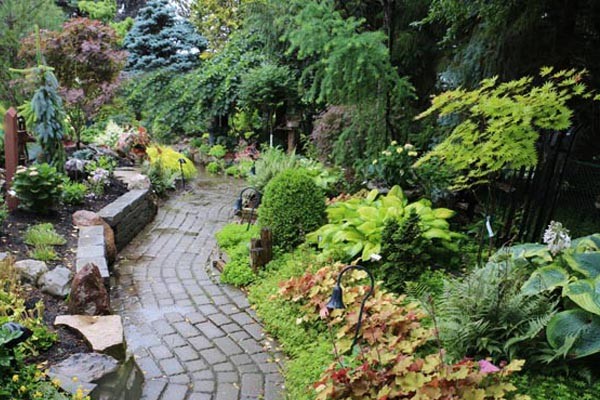
By Paul James
When shopping for plants, one of the first and most important questions you’ll likely be asked is, “Will they be growing in sun or shade?” And most often, it’s one or the other. But that’s not always the case. And the whole sun and shade discussion can sometimes get rather confusing.
After all, there’s morning sun followed by afternoon shade (my favorite) and there’s the exact opposite. There’s the dappled light found beneath large trees, which might also be referred to as part or partial shade, and that may exist even on homes that face west or south, where you would ordinarily expect full blazing sun. Those that face north may actually get a lot of sun depending on the pitch of the roof. And of course there are situations in which the sun (or shade) is in and out throughout the day.
So let’s get one thing clear from the outset: Plants that require full sun won’t grow well in the shade. They may survive, but they won’t thrive, and they’ll forever lack the vigor that they would otherwise have. However, they may do just fine in dappled light, or a spot that gets some sun throughout the day. Plants that require full shade will croak in the sun. Period.
Thankfully, there are plants that will adapt to all situations. The palette of possibilities might be limited, and you may not be able to plant what you want, but a solution exists. What you need to do is actually observe how much light an area is getting throughout the day. Then and only then will you be able to figure out what plants you can and can’t have in your situation.
Finally, I should explain why I’m so fond of morning sun followed by afternoon shade. You see those are the conditions that allow me to grow my favorite plants, including Japanese maples and Japanese forest grass, Hydrangeas, Viburnums, Yews, ferns of all kinds, Hosta, Heuchera, and so many more shady characters.
Put it in a Pot!
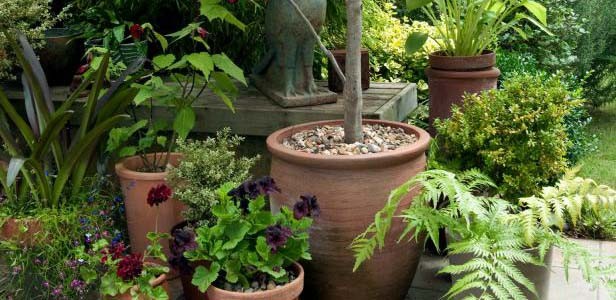
By Paul James
Rains this week have put on damper on gardening, but that doesn’t mean you can’t plant. After all, putting all kinds of things in containers is something you can do regardless of weather – in the garage, on a covered patio, even between downpours. And while obvious choices include flowers and tropicals, there’s a group of plants that’s often overlooked when it comes to container planting.
And that would be trees and shrubs, which can be used in a number of effective and dramatic ways, from formal to funky. For example, to flank the entrance to your home, especially if the surrounding surface is concrete; to use in a spot where nothing will grow due to poor soil or drainage issues; to add a special decorative touch to a garden bed; and to draw attention to a specimen tree or shrub.
Practically any and trees and shrubs are contenders for containers, but here are three things to keep in mind before you make your selections. First, realize that you’ll need to fertilize the tree or shrub more frequently than if it were planted in the ground, because fertilizer leaches more rapidly out of a container. Second, be prepared to top-dress the container with a two- or three-inch layer of fresh potting mix every year. And finally, plan on repotting every three to five years, ideally in mid to late February. The process is straightforward: use a sharp knife to loosen the soil and roots from around the inside of the pot. Gently remove the plant (tipping the container on its side if necessary). Discard (or better yet, compost) the old potting mix. Repot using fresh potting mix.
If you want to return the plant to its original container, prune about a third of its roots. If you want to move the plant into a larger container, simply trim the ends of the roots to encourage new growth before potting up.
One more thing: Try to balance the size of the plant and the pot. A six-foot tree in a 12-inch pot will look weird, and the plant won’t grow well.
I’ve grown dozens upon dozens of trees and shrubs in pots over the years, but among those I like best are Japanese maples, Japanese snowbells, crape myrtles, dogwoods, evergreen conifers of all kinds, and hydrangeas. Of course, there are dozens more trees and shrubs to choose from, and I encourage you to try anything that strikes your fancy. And realize that once you start planting trees and shrubs in containers, you’re likely to discover a whole new world of gardening.
What I’m Diggin’ Now
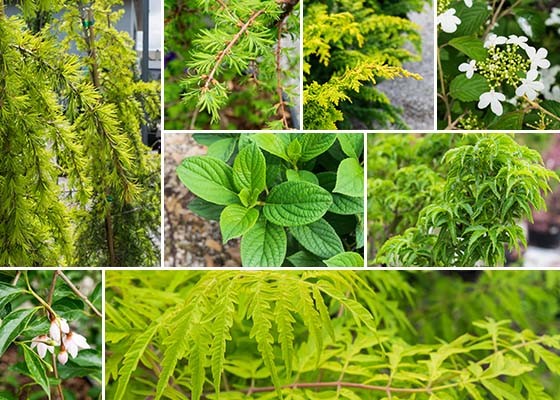
By Paul James
Being a plant geek, I’m always on the lookout for new plants. At the same time I’m drawn to what’s not necessarily new, but just plain cool, and in my opinion overlooked by too many of my fellow gardeners. So with those thoughts in mind, here’s a look at what I’m diggin’ now.
Plant Away!
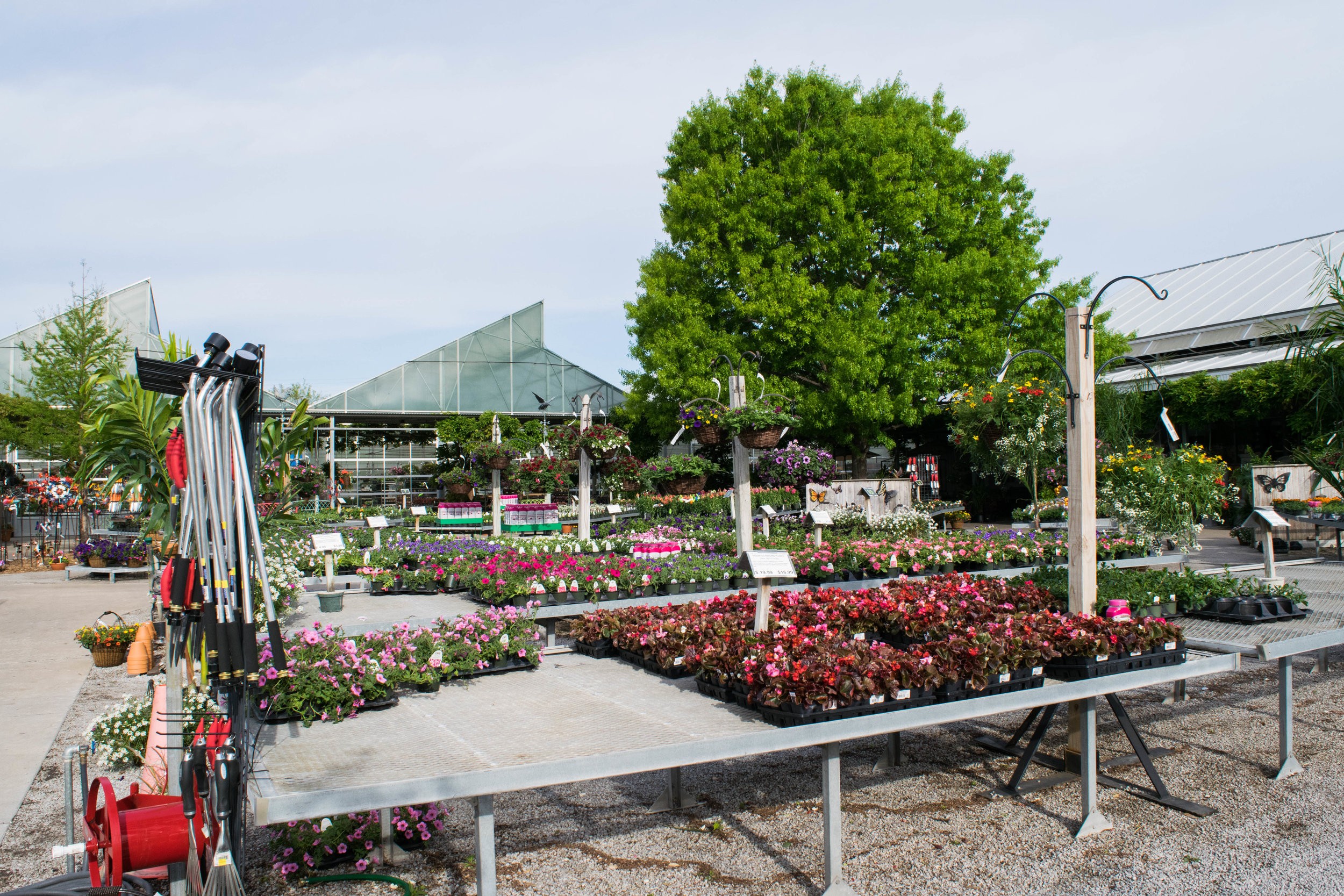
By Paul James
Last Sunday I was having lunch with my father at his assisted living center, when out of nowhere a woman shouted at me from across the dining room. “Is it time to plant tomatoes?” she asked. “Yes, and everything else that grows,” I answered, which prompted a collective chuckle from the diners. And to everyone else who’s asked me that question in the past week – in the grocery store, at the pharmacy, while walking the dog — my answer is the same…but with one caveat.
And that has to do with weather. Because let’s face it, none of us knows what nature has in mind. There’s still the very real, albeit miniscule, chance that we could get a freeze, perhaps even a hard freeze, even into early May.
But that’s always been the case. And the fact is the damage done by a freeze this time of year rarely amounts to much. Sure, you might lose your tomato crop (as well as other warm-season veggies), but most of those can be replanted. Once the leaves of ornamental trees and shrubs have hardened off (which they have for the most part), they can withstand temps in the upper 20s. Even if they lose their first set of leaves, secondary leaf buds will often produce a new flush of growth in no time. The same is true of perennials, whose top growth may take a hit but will invariably reemerge. And even most annuals can withstand those same temperatures for a few hours or so, which is usually about how long the cold snap lasts.
Sure, there are a few plants that you might want to hold off planting for another ten days or so – caladium bulbs come to mind, maybe even basil – and I’d still wait another week or two to move houseplants outside, but pretty much everything can and should be planted now.
That’s why, after saying goodbye to dad, I went straight home and planted my tomatoes…and everything else that grows…even basil.
Mulch Madness
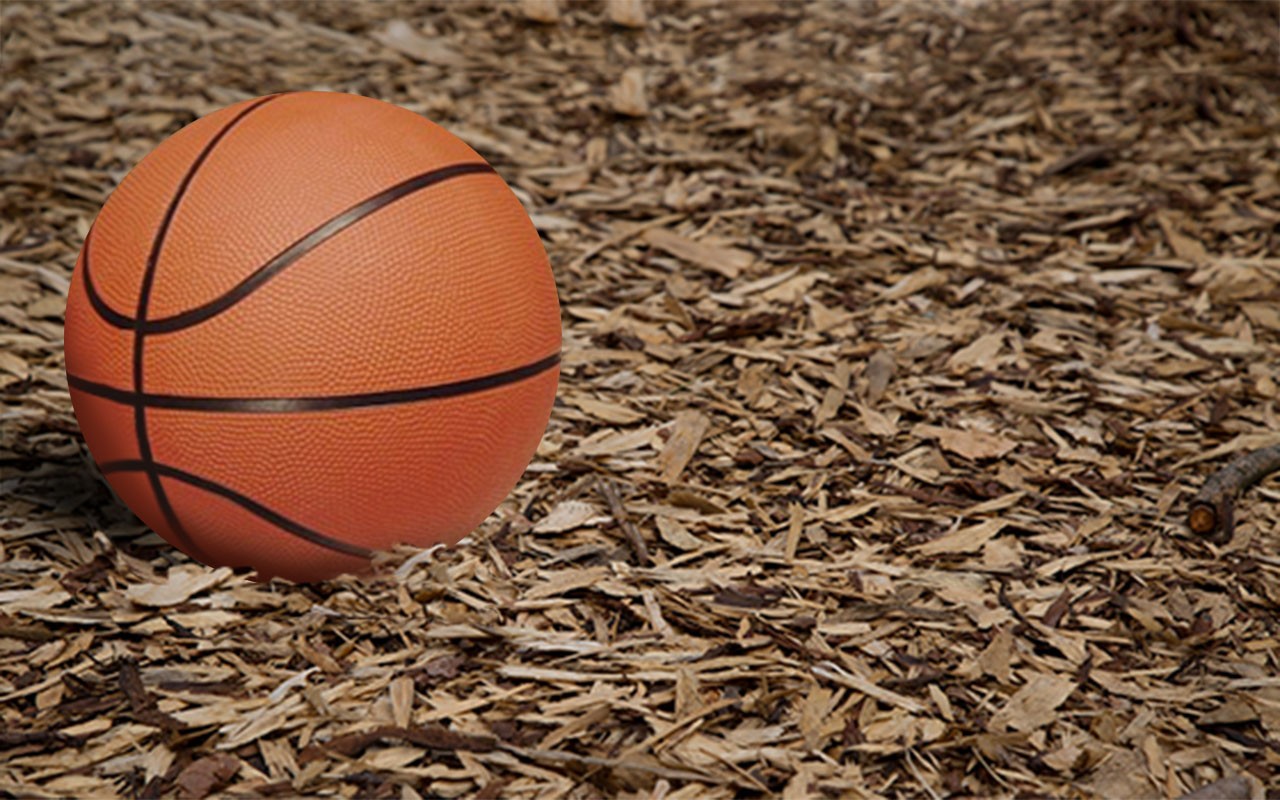
By Paul James
I have a confession to make: I’m a compulsive mulcher. You might even say I’m a mulch maniac. It all started nearly 40 years ago when I used a light layer of straw to cover my first vegetable garden, something I’ve done every year since. A year later, I started using bags of chipped and shredded wood mulch in my ornamental beds, a practice that continues to this day. So clearly, I’m hooked on mulch. And you should be too.
By using mulch in the garden, you’re mimicking what nature has been doing for eons – covering, and thereby protecting and enriching the soil with organic matter. Deciduous trees and shrubs blanket the forest floor with leaves that prevent erosion, maintain soil moisture, and prevent noxious weeds from germinating. As those leaves decompose, they provide nutrients to plants and food for soil-dwelling critters, especially earthworms, and they improve the soil’s structure and tilth. When you mulch at home, you’re doing essentially the same thing. And you get an aesthetic bonus too, because mulch is beautiful. To me, it’s like icing on the cake.
There’s really no such thing as the best mulch. What you choose to use is entirely up to you. These days, pine-bark chips are my favorite for ornamental beds, although for decades I used shredded cedar as well. In my vegetable garden, I use a lot of shredded leaves, homemade compost, and straw. At a previous home, I controlled slugs in a hosta bed using pecan shells. They looked great, and slugs won’t walk across them.
Ideally, you should mulch to a depth of two to four inches for maximum benefit. Keep the mulch off the crowns of annuals and perennials to prevent them from rotting, and several inches away from the base of trees and shrubs to prevent damage by voles and field mice that feel protected under the cover of mulch. Consider “fluffing” the mulch once or twice a year with a metal rake just to loosen it up and bit so that water can easily percolate through it. Beyond that, all you need to do is add a fresh layer every year to maintain the proper depth.
I’m convinced that mulch offers the biggest bang for your buck in the garden, and it protects the investment we gardeners have in our plants. So do yourself and your plants a favor by adding mulch to your garden. But be forewarned: You might soon discover that you too are a mulch maniac.
Foolproof Plants
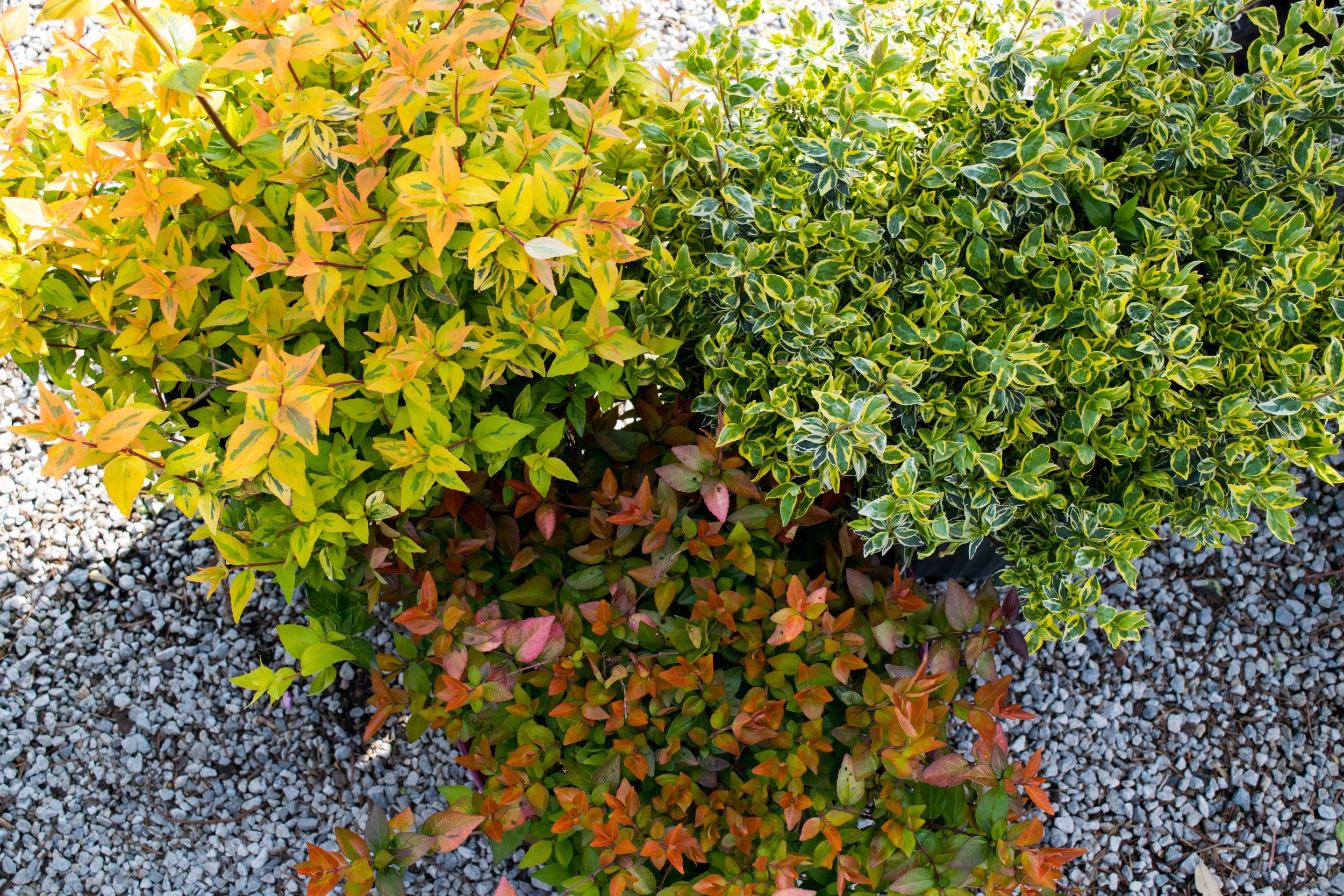
By Paul James
Not everyone fancies themselves a hardcore gardener. I get that. A lot of folks are simply homeowners who want a nice looking landscape but don’t want to spend hours on end taking care of it. That’s why I came up with this list of what I call Foolproof Plants. These are plants that practically thrive on neglect, will tolerate all types of soil, are bothered by few if any pests and diseases, and, as if all that weren’t enough, they’re also beautiful.
But let me be clear: There’s not a plant on the planet that you can just stick in the ground and ignore. All plants must be watered the first year so that they become established, meaning they develop a good root system that’s able to support the plant. Beyond that initial period however, nearly all of the plants that follow will do fine with little if any supplemental watering or fertilization.
Note: Not included in this list are annuals, because few are available at the moment. I’ll present my list of Foolproof annuals in an upcoming post.
Trees and Shrubs
Chinese Pistache, Lacebark Elm, and Shumard Oak are three of the toughest, most adaptable trees you can plant in this area, and you can’t go wrong with any of them.
Virginia Sweetspire is an awesome shrub with four seasons of interest. Lime green leaves emerge in early spring, then turn darker green. White panicles of flowers make the plant look as though it’s covered in snow. And in winter, the red stems are extremely attractive. Grows in sun or shade and loves wet soil.
Abelia is a great group of shrubs represented by several excellent, carefree candidates, many of which are evergreen and all of which flower. Give them full sun, and they’ll give you years of delight.
Spirea is another great group of shrubs. They’re deciduous, but they’re tough as nails and beautiful.
Chaste Tree is the greatest pollinator magnet ever, and bumblebees in particular absolutely love it. Plant in full sun, water well the first year, and simply enjoy for years to come.
Rose of Sharon is a snap to grow, it’s tough, and its flowers – which are available in several colors – last and last.
Oak Leaf Hydrangea is a must for any garden. Whereas other types of hydrangeas can be a bit finicky, this one will grow in sun or shade and bloom prolifically.
Nandina used to get a bad rap because the species that was so commonly planted years ago tends to get gangly with age. Not so with the many new – and colorful — introductions.
Yucca loves the sun and heat, and once established it requires next to nothing in the way of care. In fact, it’s so tough it’s tough to kill! The foliage – both solid green to blue green as well as variegated, gives way to striking flowers atop long stalks.
Boxwood has been a mainstay in the gardening world for decades because it’s so easy to grow and maintenance free. Few evergreens are as dependably carefree.
Perennials
Autumn Fern has always been my favorite of the lot. It’s evergreen, produces beautiful bronze foliage in spring that matures to dark green, and grows to about two feet. It does need shade in the afternoon, but that’s true of all ferns.
Daylilies could easily be considered the most foolproof plant. They’ll grow in just about every soil type and take all the sun and heat nature has to give.
Heuchera (and the related Tiarella and Heucherella) are among the best plants for shady spots, and the variety of colors available is impressive, from lime green to purple.
Ornamental Grasses are about as carefree as plants get. They do need a haircut once a year in late winter to early spring, but that’s about it.
Verbena offers beautiful foliage and flowers and stays low to the ground. It needs sun, but little more.
Yarrow loves sun and hot weather, and rarely if ever needs to be watered once established. Its foliage is almost fernlike, and it’s available in several different flower colors.
Groundcovers
Liriope and Mondo are excellent for covering large, shady areas. Their grasslike foliage is evergreen, and although both can spread, neither is invasive.
Pachysandra is a dynamite, evergreen, deer-resistant ground cover that forms a thick mat. Perfect for mass planting beneath large, mature trees.
Angelina is a gorgeous sedum with golden-green foliage. It’s super easy to grow, and it thrives in dry, sunny spots.
There are actually several more plants that fit the Foolproof definition, but I had to stop somewhere! Besides, the ones I’ve listed will get you off to a good start.
Is it Spring Yet?

By Paul James
Officially, spring doesn’t arrive until Monday, March 20, at precisely 5:28 AM. But if plants could talk, they’d tell you that it’s already here. And according to experts, they’d be right. Climate scientists at the U.S. Geological Survey have confirmed that in terms of average temperatures, spring has arrived in much of the south-central and southeast areas of the country between 20 and 25 days earlier than normal. So does that mean it’s time to plant anything and everything?
My response to that question, which I’ve been asked a lot lately, is no. After 40 years of trying to second guess the weather, I’m hesitant to suggest that gardeners move up their planting dates just because it’s warmer than usual. After all, despite the weirdly warm and wacky weather pattern we’ve been experiencing lately, there’s still a very real likelihood of a freeze – perhaps even a hard freeze – this month or next.
Now is a great time to plant trees and shrubs, both deciduous and evergreen, and all but the tenderest perennials. Annuals can be planted in containers, but be prepared to move them indoors if temps drop below 28F or so. Other than pansies, you should probably wait at least another two or three weeks before adding seasonal color, but that date could change a week or more either way depending on what happens weatherwise.
In the veggie garden, it’s definitely time to plant potatoes, onions, asparagus, greens of all kinds (arugula, spinach, lettuce, kale, etc.) beets, carrots, turnips, and cole crops – broccoli, cabbage, and cauliflower. These are by definition cool-season crops, so they grow best under cool conditions. It’s also time to plant a number of culinary herbs, including oregano, marjoram, thyme, mint (see Tip below) and cilantro.
However, I’d wait at least another two weeks (perhaps even longer) before planting warm-season veggies such as tomatoes, eggplant, beans, melons, and peppers, and tender herbs such as basil, because they can’t handle temps below 45F or so, and even colder overnight temps are in the forecast. I’d also hold off on planting parsley, because although it can take cold temperatures, anything below 40F may cause it to bolt later in the spring. And I’d be prepared to protect those crops with blankets or row covers through the end of April.
Let’s face it, folks, making predictions about the weather is tricky at best. And that’s why I think the safe bet is to stick with normal planting dates and simply pay close attention to forecasts. Besides, even if you wanted to plant Lantana or Begonias this time of year, you’d have a tough time finding them because growers and retailers schedule their deliveries for “normal” planting dates.
And there’s a very good reason for that.
How to Plant a Tree
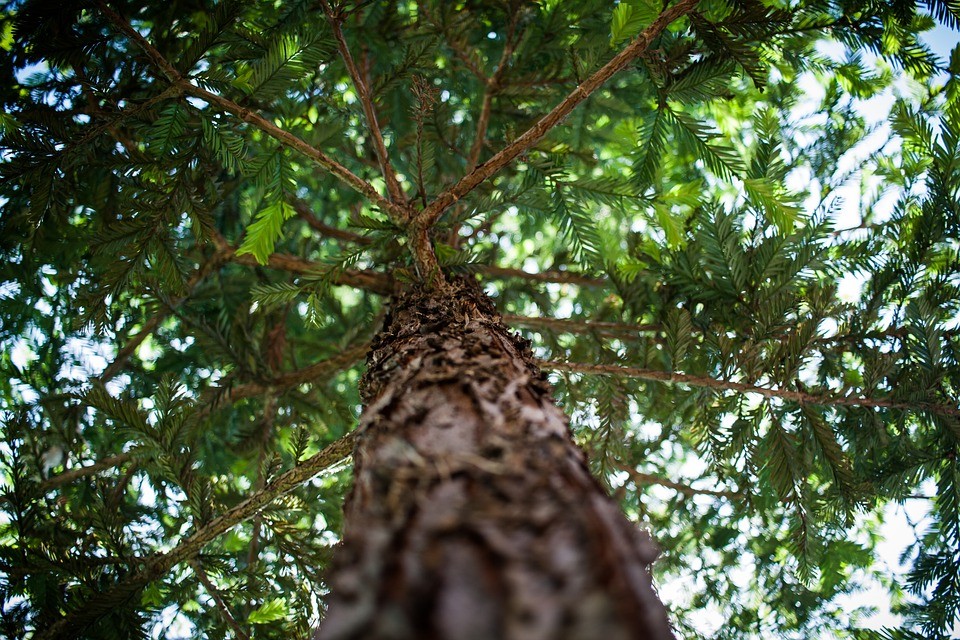
By Paul James
Back in the mid 90s, researchers proposed a new way of planting trees that involved digging a wide, shallow, saucer-shaped planting hole that measured five times the diameter of the tree’s root ball. The idea was that roots would grow more rapidly in the monstrous planting hole, thereby enabling the tree to become established faster. Lots of so-called experts immediately jumped on the bandwagon and praised it as the most important revelation in tree planting since the invention of the shovel. But the question is, Does it really work?
Well, I’m not saying that it doesn’t work. I planted a Shumard oak using that method back in 1996, and it’s doing great. The root ball of the tree was three-feet wide, so I wound up digging a 15-foot diameter planting hole roughly two-feet deep at the center, which took me an entire day. However, I also planted three other trees that same week using a more traditional approach (more on that in a moment) and they’re doing great too.
So what I am saying is that the “new” way of planting a tree is just too much work! And more to the point, it isn’t even necessary!
What then, is the best way to plant a tree? In truth, the planting hole only needs to be a foot or so wider than the root ball. One of the biggest advantages to keeping the hole relatively small (aside from the fact that it’s a much, much easier task) is that the tree will be well anchored in the hole from the start. The more important thing to consider is the planting depth. Keep this thought in mind: You’re planting a tree, not burying it. If a tree is planted too deeply it’ll likely die. That’s why you should always plant a tree above grade, and how much above grade depends on your soil type.
In heavy clay soil (Hello, Broken Arrow and Owasso!) you should leave as much as a third of the root ball above grade. Clay soil holds water, and most trees don’t like wet feet, so planting above grade keeps roots from drowning. In sandy soil (Howdy, Bixby!) you should do likewise because the tree will settle in the soft sand. In most other areas of Green Country, you should leave approximately four to six inches of the root ball above grade.
Adding soil amendments such as compost to the planting hole is rarely necessary, and can actually cause more harm than good because roots will remain in the area of amended soil rather than reach out to the native soil. It’s best to simply let the tree adapt to your native soil. In extremely heavy clay or super sandy soil, it’s okay to amend the soil somewhat, but don’t add more than 25% to the native soil used to backfill the hole. Adding a root stimulator at planting time is a good idea, and a two- to four-inch layer of mulch is a must.
And finally, a word on staking. Unless you live in an open area where the winds come sweeping down the plains, or you’re planting a bare-root tree, staking isn’t necessary. In fact, letting the tree sway in the wind without stakes will result in a stronger trunk.
So grab a shovel and plant a tree. And feel free to thank me later for saving you from hours of unnecessary digging.
February “To-Do” List
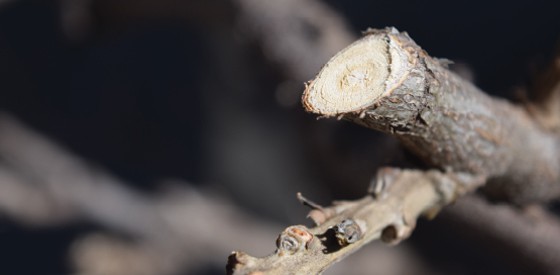
By Paul James
For me, the 2017 gardening season officially began last Sunday. I planted potatoes and onions. I pruned some fruit trees, a few Japanese maples, and several shrubs. I spread five bales of straw in the paths of my veggie gardens. I tidied up my ornamental beds in preparation for planting. And I raked and composted well over a dozen trash cans full of leaves. Then, just as the sun was setting, I sat on the porch with a beverage and admired my accomplishments. (Full disclosure: Later that evening I also took two tabs of Aleve PM.)
As gardeners, we know that sense of satisfaction that comes from getting things done in and around the yard. The big question is, When should we do what? So here’s a rundown of what you might want to get done between now and the end of the month, beginning with a list of what to plant.
Topping the list are trees and shrubs, both evergreen and deciduous. This is a great time to get them in the ground, and with any luck we’ll have plentiful spring rains. Roses (which are of course a shrub, but one worthy of special mention) can also be planted now, along with pansies and all but the tenderest of perennials, and nearly all groundcovers.
Now is the time for cool-season vegetables, although I’ll say at the outset that yes, there’s always the possibility of a hard freeze in March, even April, that could damage crops. So, be prepared to cover if temps drop into the mid-20s. However, cool-season crops by definition love cool temperatures, so I plant mine early, as in now through the end of the month.
The list of cool-season veggies includes asparagus, beets, broccoli, cabbage, carrots, cauliflower, chard, collards, kohlrabi, lettuce, onions, peas, potatoes, radishes, spinach, and turnips. Asparagus is best planted from roots, cole crops (broccoli, cabbage, and cauliflower) from transplants, onions from sets or transplants, potatoes from tubers, and everything else from seed.
Now for a list of things to do other than planting between now and then end of the month, beginning with pruning.
Nearly all deciduous trees and shrubs (including roses) can be pruned this month. The exceptions are those that bloom in early spring – dogwoods, redbuds, Hydrangeas, Viburnums and such. Now is also a good time to cut back ornamental grasses to about six inches above ground.
To get rid of pesky weeds in the lawn, now is the time to apply pre-emergent herbicides to control both grassy and broadleaf weeds.
Adding a two-inch (or more) layer of organic matter to the soil will get new and existing plants off to a good start. Bagged products such as mushroom compost, composted cotton burrs, and even topsoil work great, although I must say that the greatest composted product I’ve come across in years is called Happy Frog, which is made by Fox Farm. I use it as a top dressing on everything that grows.
And last but hardly least, now is the perfect time to fertilize spring-flowering bulbs, even those that are already in flower.
Sure, there are more things to do in the garden, but these are among the most important. Besides, I didn’t want to overwhelm you! And don’t forget that the most important thing you can do in the garden, regardless of the time of year, is to simply enjoy it.
Plants Looking Puny?
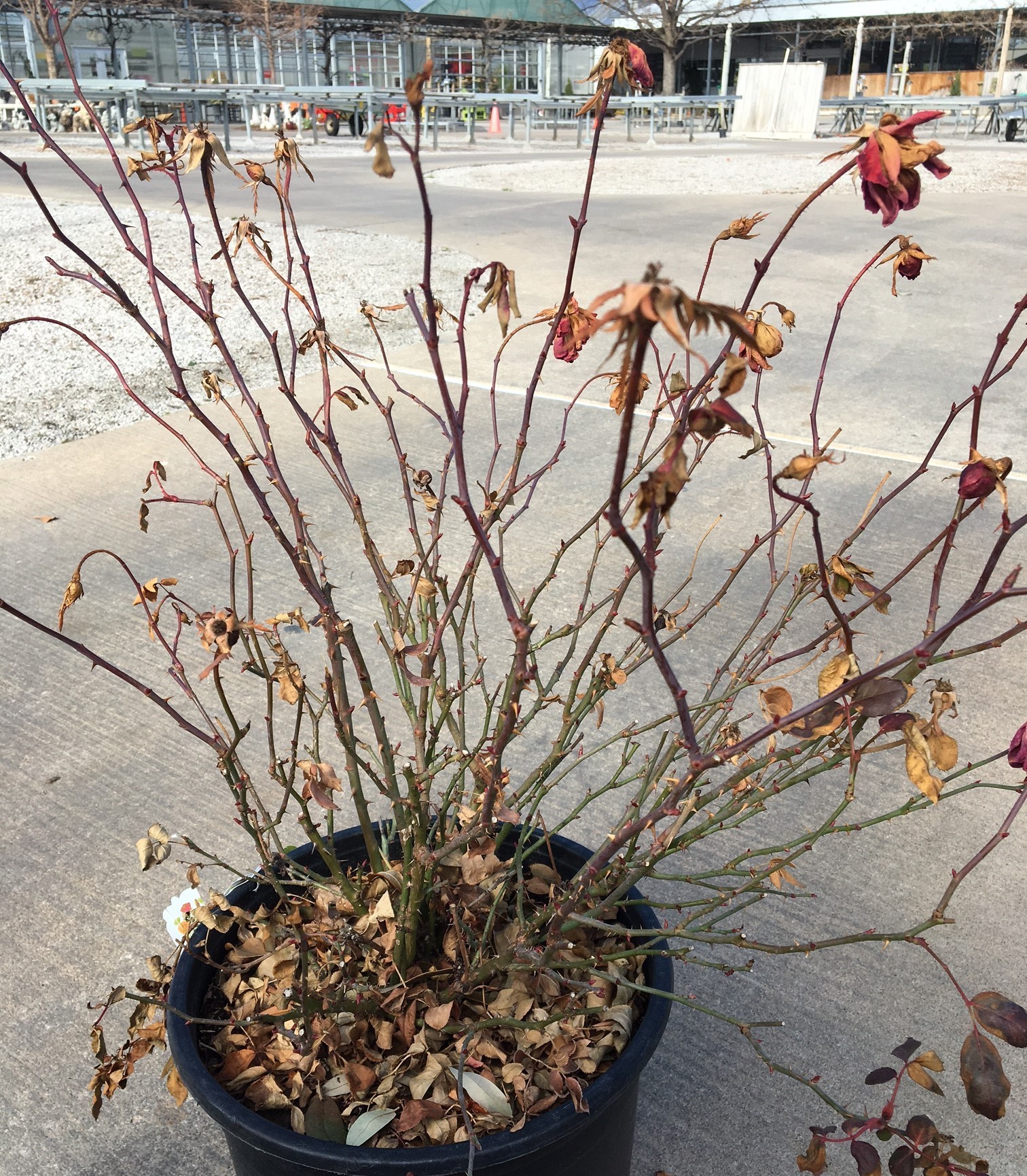
By Paul James
A lot of landscape plants are looking pretty sad right now. In fact, some of them look downright dead. The question is, will they bounce back this spring, or should I dig them up and start thinking about what to plant in their place?
Before I answer that two-part question, let me share with you what I’ve been witnessing on my walks lately. First and foremost, I’ve seen leaves still clinging to a number of deciduous trees, in particular Japanese maples, some oaks, and even roses, which is somewhat odd for this time of year. I’ve seen azaleas that looked great (and green, and in some cases in flower) early in December that now appear as though they’re on their last leg. I’ve seen the tips of boxwoods that look like somebody took a blowtorch to them. I’ve seen Taylor junipers that have gone from green to a weird, dull gray-purple. And Nandinas, well, it’s been a long time since I’ve seen so many crinkly, crunchy leaves on them.
For the most part, these conditions are the result of abrupt weather changes, specifically warmer-than-usual December days followed by temperatures in the single digits. When that happens, plants don’t have the opportunity to smoothly transition physiologically from late fall to winter. And remember, we’ve had several relatively mild winters in a row, so it’s been a long time since we’ve experienced single-digit temps.
Getting back to the questions I posed earlier, let me tackle the second part first: Don’t dig anything up, at least not yet. Remember, the vast majority of plants common to landscapes in this area are dependably hardy. Many of them are able to tolerate temperatures of -20 degrees, and some can handle temps even lower. And a number of plants – crape myrtles for example – may die back to the ground because their top growth isn’t hardy enough, but they’re rootball is, in which case new growth will begin to appear in spring.
And while I’m not a gardening psychic, nor do I have a crystal ball, I think just about every plant that grows – assuming it was hardy in the first place – will bounce back and be just fine come spring. Some may require a bit of cosmetic pruning to get rid of scorched leaves (wait another few weeks before doing that), but that’s a small price to pay. The exceptions would be those plants that didn’t have enough soil moisture (meaning you failed to water!) before the bottom fell out of the thermometer. If that’s the case, you won’t actually know the verdict until late spring or early summer when the plant starts growing (or at least tries to grow) rapidly.
Feel better now?
Coral Bark Maples
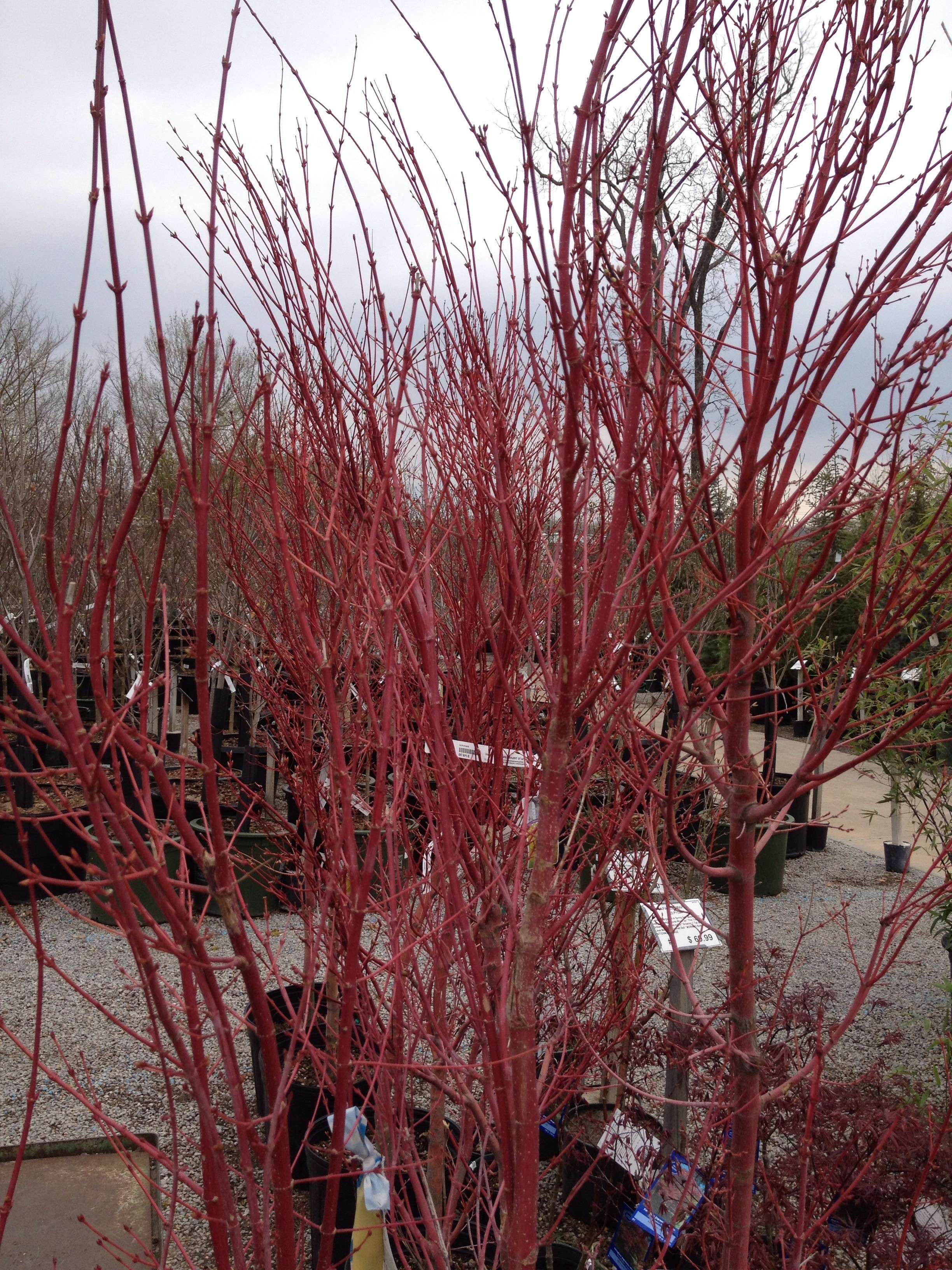
By Paul James
Acer palmatum ‘Sango kaku’, better known as the coral bark maple, has been growing in popularity in recent years, and with good reason: It’s beautiful all year long, even in the dead of winter – as in right now — when its show-stopping, coral-colored trunk and twigs are at their peak.
But the coral bark maple has plenty of other attributes. It stays relatively small, growing to about 12’ in ten years (maybe 25’ at maturity), which makes it ideal for small properties or as a specimen close to the house. And it typically maintains an upright, vase-shape. Its deeply lobed, almost fernlike leaves start out light green in spring, and in fall turn spectacular shades of yellow, reddish-purple, and bronze. Its reddish-purple flowers, though inconspicuous from afar, are beautiful when seen up close. And it does great in containers, where it rarely grows taller than eight feet or so.
Like other Japanese maples, the coral bark grows best in organically rich, slightly acidic, well-drained soils where it receives a few hours of morning light followed by afternoon shade, or dappled light throughout the day. Even in the best of locations, leaves may get scorched in the middle of a hot summer, but consistent moisture and a thick layer of mulch will keep that to a minimum. Pruning isn’t often necessary, but if needed it should be done during the dormant season. Spring or summer pruning will likely cause significant bleeding.
It’s hard to say which Japanese maple is my favorite, but the coral bark is definitely on the short list. Plant one, and I think you’ll agree it’s a tree worth having.
Creature Comforts

By Paul James
Not every bird is lucky enough to find a warm, cozy spot when the weather turns foul. Even those that do find shelter still need food and water to survive. And there’s a genuine payoff for gardeners who tend to their flock: The birds will call your garden home and eat everything from weed seeds to pesky plant pests.
Bird houses are generally thought of as nesting sites, but they provide much needed shelter as well, especially during the winter months. They should be installed roughly six feet off the ground to discourage cats, and face south to southeast so that they warm up quickly when the sun is shining. Birds will gather materials from the wild to build their nests, but you can help them out by placing shredded newspaper, bits of yarn or string, even lint from the clothes dryer near the house, whether on the ground or hanging from tree limbs.
When it comes to food, there are lots of choices, from suet to seed blends to single-seed varieties. Suet is basically fat, and it provides a high-energy boost to hungry birds. Pre-formed suet cakes are great, but you can also ask the butcher for suet and simply wedge it in the crotch of a tree. Birds also love peanut butter, both smooth and creamy, which you can smear on a branch. Seed blends are great for attracting a number of different species, but most birders agree that the best all-round seed is black-oil sunflower. If squirrels are a problem, consider safflower (which they don’t like) or use seed to which hot pepper — which doesn’t bother the birds — has been added. You might also consider buying a squirrel-proof feeder.
And speaking of feeders, the choices are many. Tube feeders are hard to beat, but those made of wood have a more rustic look and are available in a number of different types and styles. They too should be mounted high enough to keep cats away, although there are bird species that prefer to feed off the ground (doves in particular). Placing a bell on your cat’s collar will give the birds advance warning.
It’s tough to keep fresh water available when temps drop below freezing, but an inexpensive heater made specifically for bird feeders can solve that problem quite nicely.
Beyond knowing that you’re providing birds with all the comforts they need to survive the winter, you’ll also experience the joy of having them hang out in your yard. And that’s pretty darn comforting too.
Houseplant Care in Winter
More houseplants bite the dust during winter than any other season, and that’s too bad. But it’s really not all that hard to keep your houseplants healthy and happy this time of year. Just follow these suggestions.
Nearly all houseplants are native to the tropics, where they enjoy warm temperatures and high humidity. In the home this time of year, warm temps are a given, since folks crank their heaters up in the house as the mercury nosedives outdoors. But as you crank the heat, you dry the air, and whereas houseplants prefer humidity levels in the range of 60% to 70%, the humidity in the average house in winter hovers around 15, maybe 20%. And that can be devastating to most houseplants (cacti and succulents excluded).
The trick, then, is to increase the humidity as best you can, and the best way to do that is to mist your plants frequently. As in daily. Or even twice daily. You can also group your plants together and place a humidifier near them, or set the plants on a tray filled with pebbles. Make sure the water level in the tray is slightly below the top layer of pebbles so the pots aren’t submerged in water. (Note: Don’t mist plants with fuzzy leaves, such as African violets.)Also, try to keep your houseplants away from floor or ceiling registers so they don’t get blasted with warm, dry air.
Resist the temptation to water as often as you do during spring and summer. The growth rate of houseplants slows considerably in winter, so they really don’t need to be watered as often. In most cases, you should water only when the top two inches of soil is dry.
And again, because of their slower growth rate, houseplants really don’t need fertilizer this time of year unless they’re in flower. Even then, it’s best to apply the fertilizer at only 25% of the recommended amount.
What houseplants do need, however, is an occasional dusting to remove residues that accumulate on leaf surfaces. A paper towel – either dry or soaked in warm water — works just fine, or you can use products such as Green Glo.
Finally, be on the lookout for pests, especially if your houseplants spent the spring and summer outdoors. The most common invaders are scale and mealy bugs, both of which can be controlled easily with insecticidal soap or products that contain neem.
Poinsettia Pointers
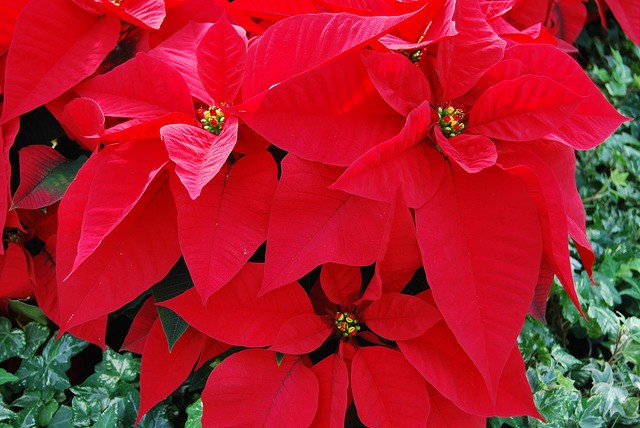
Sales of Poinsettias in the U.S. will top $250 million in the six weeks leading up to Christmas. That’s a lot of green spent on a plant most people toss in the trash after the holidays. But then again, can you imagine Christmas without Poinsettias?
So the goal, then, is to keep your Poinsettias healthy and happy for at least six weeks. And here’s how to do just that.
Try to buy your Poinsettias on a day when temperatures are well above freezing, and make sure they’re wrapped regardless of the temp. Exposure to low temperatures even for a few minutes can permanently damage the plants. And don’t leave your plants in the car while you do more shopping. Depending on the weather, it may be too cold – or perhaps even too hot – inside your car.
Once home, carefully unwrap your Poinsettias and place them in an area that gets roughly six hours of indirect light a day. Most often, that’s an eastern or southern exposure. Keep the plants away from warm or cold drafts from air registers or open doors or windows.
Thankfully, Poinsettias are happy with the same daytime temperatures people are – 60 to 70 degrees during the day, and a bit cooler at night. Temps above 70 degrees will shorten the plant’s lifespan.
Check the soil daily, and water to maintain even soil moisture. If your plants are wrapped in foil, punch holes in the foil so water can drain into a saucer. Discard excess water in the saucer shortly after watering. Keep in mind that soggy soil will lead to root rot.
Do all that, and your Poinsettias should last at least six to eight weeks indoors.
Fall Color
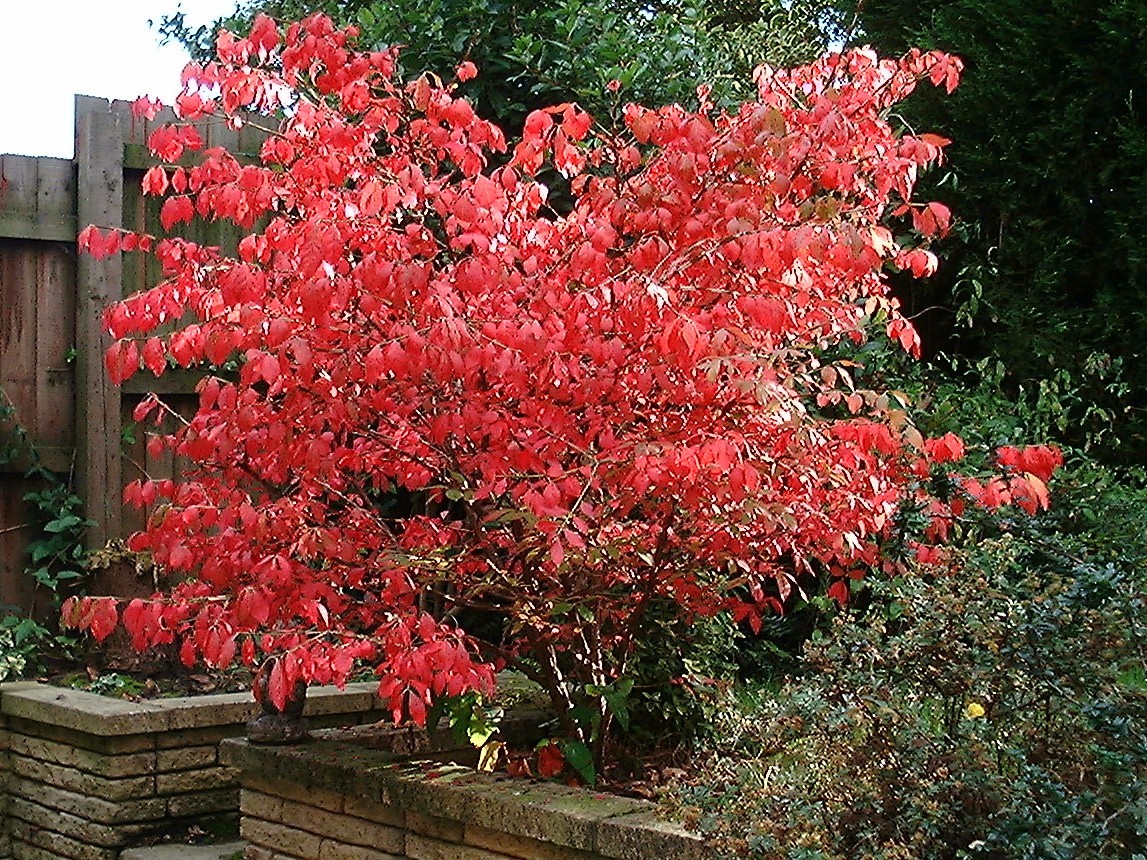
By Paul James
When it comes to gorgeous fall color in the landscape, trees tend to get all the glory. And deservedly so. But there are a number of spectacular shrubs whose fall color rivals even the showiest of trees, and here are a few of my favorites.
Oakleaf Hydrangea – As if its stately form, beautiful flowers, and ease of care weren’t enough, this native shrub also produces amazing fall color that typically lasts for several weeks. What’s more, its dried flowers look great in arrangements. And they’re available in sizes ranging from three-feet tall and wide to twice that.
Euonymus ‘Burning Bush’ – Aptly named, this shrubs practically appears to be on fire in the fall, thanks to its brilliant scarlet leaves. This beauty will grow to about six-feet tall and wide, and is dynamite as a specimen or in a mass planting.
Virburnum ‘Brandywine’ – I’m a huge fan of Viburnums, and this native vies for the most colorful-of-all award with its wine-red fall foliage. As a bonus, it produces breathtaking pink and blue fruit that birds adore. It’ll get five- to six-feet tall and wide.
Virginia Sweetspire – This is my favorite shrub, period. It offers four seasons of interest (including long panicles of scented white flowers in spring), but its fall color of deep red to burgundy is arguably the most interesting of all. And when the leaves finally drop, the red twigs continue to put on a show all winter. Grows to roughly three-feet tall and wide, and can handle a lot of shade and moisture.
Nandina ‘Firepower’ – There was a time when I wasn’t all that keen on Nandinas, but in the past two decades there have been some great introductions. The one that produces the best fall color is ‘Firepower,’ but given enough sun, ‘Burgundy Wine’ and ‘Moonbay’ won’t disappoint either.
Fothergilla ‘Blue Shadow’ – Here’s an underused shrub if ever there was one. Its powder-blue leaves are awesome, as are the sweetly scented flowers in produces in spring. But the big bang comes in fall, when the leaves turn various shades of orange, yellow, and red. It’ll get roughly five-feet tall and wide, and it’ll never disappoint.
Chokeberry – This shrub’s glossy-green foliage turns a jaw-dropping red in fall, and it produces dark purple, nutrient-rich berries that birds – and people – find hard to resist. Expect it to reach five- or six-feet tall and four-feet wide.
Buckthorn ‘Fine Line’ – I love this plant. It’s very columnar – six-feet tall by two-feet wide — making it ideal for tight spaces or as an accent plant and it looks great in containers. Fall color is a bright yellow that really stands out no matter where you plant it.
Blueberries – Surprised to find this edible delight on my list? Well guess what, blueberries are extremely showy in fall, which is why I suggest they be planted in ornamental beds. And there are several sizes to choose from, including dwarfs. So take your pick!
More Terrific Trees
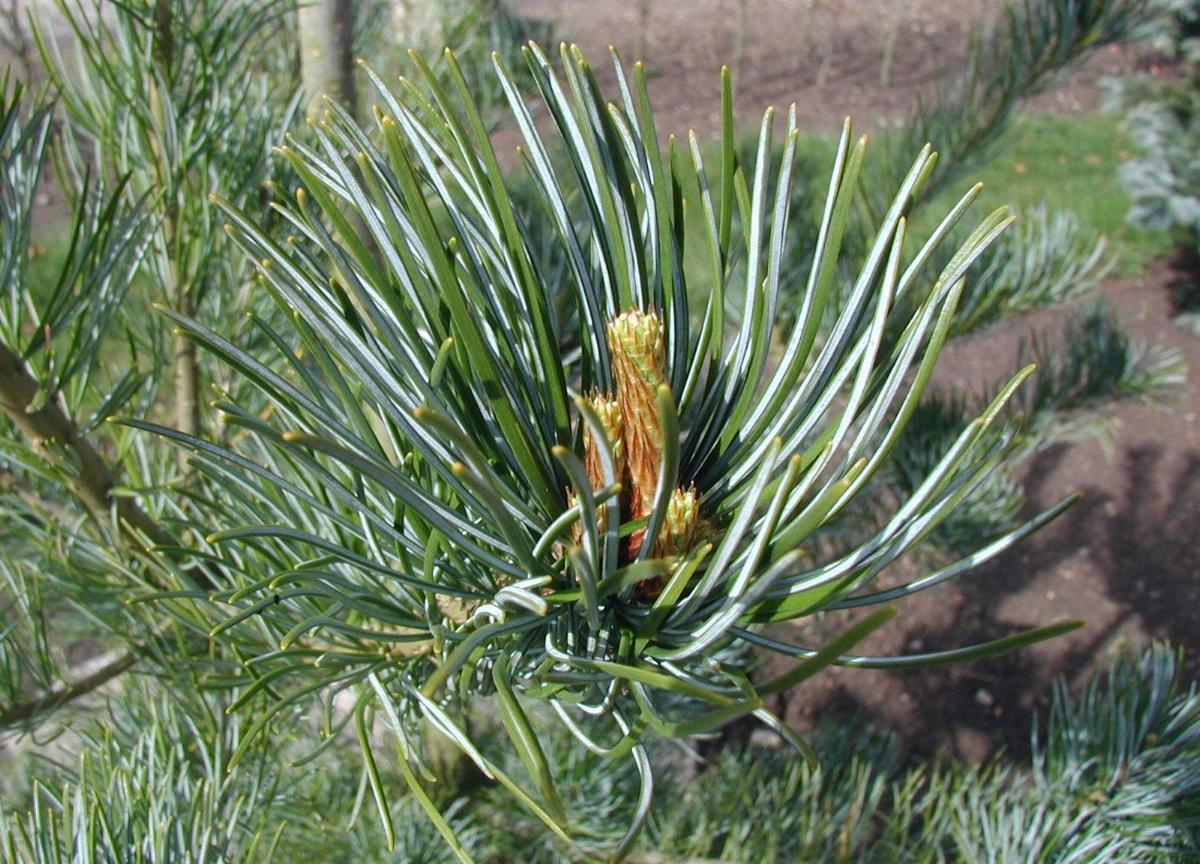
By Paul James
In my final installment of terrific trees, I’m gonna go out on a limb and focus on several not-so-well-known trees, all of which are white pines. But before I get started, let me just say that these trees aren’t for everybody. Nor are they right for all areas of Green Country. However, if you’ve got relatively rich, well-drained soil that’s slightly acidic – or you’re willing to create those conditions – then you owe it to yourself to consider them, because by any definition, they’re terrific.
Pinus strobus ‘ Louie’ is one of the most beautiful white pines I’ve ever seen. Its needles are soft and wispy, and its golden-yellow needles are drop-dead gorgeous, especially in the middle of winter. ‘Louie’ grows in a dense, pyramidal form, and only gets maybe ten-feet tall and half as wide. ‘Louie’ does best in morning sun followed by afternoon shade, but it will also grow well in areas that receive dappled light all day.
Another great choice is ‘Billow,’ a dwarf, globe-shaped white pine with long, blue-green needles. This baby only grows to about three-feet tall and wide – and slowly at that — making it ideal for small gardens, courtyards, or even containers. Interestingly, although this is still considered a conifer, so far not a single plant has been known to produce cones. This is a relatively rare selection, and worthy of inclusion in any setting.
‘Angel Falls’ is a striking, weeping white pine with extremely long, blue-green needles and branches that cascade all the way to the ground. Growing to about ten-feet tall and only four-feet wide, this will make a statement in any landscape. Give this beauty at least a half day of sun or dappled light, and it’ll slowly but surely become one of your all-time favorite plants.
Pinus parviflora includes the Japanese white pines, and among the best for this area are ‘Blauer Engel’ (or if you prefer, ‘Blue Angel’), which grows to about six-feet tall and three-feet wide; ‘Glauca Brevifolia (ten-feet tall and wide); and the stunning ‘Fukuzumi,’ an irregularly shaped, shrub-like form of Japanese white pine with a wind-swept look and twisted, silvery-blue needles.
Yes, there are more choices out there, but for those of you who are looking for something a bit unusual, these are hard to beat. They’re also in short supply, so get ‘em while they last.
Three More Terrific Trees
By Paul James
Last week I discussed three of the best trees for this area – Chinese Pistache, Shumard Oak, and Lacebark Elm. Now it’s time for three more that perhaps aren’t as well known, but are nevertheless great choices, especially if you’re looking for something a bit more unusual.
Topping the list is the Black Gum, known throughout much of the southeast (where it is native) by the more appealing name, Tupelo. Regardless what you call it, this is a fantastic tree. It typically grows to around 30-feet tall and 20-feet wide (although it can get bigger in time), is tolerant of clay soils, and thrives in wet soils as well. Interestingly, however, it will adapt to dry soils if watered regularly when young, and in time will become quite drought tolerant.
Spring flowers aren’t especially showy, but they are a fantastic source of nectar for bees (Tupelo honey, anyone?). And as many as 90 different bird species enjoy the fruits that follow. As the tree matures, its bark develops deep furrows that resemble alligator skin. Green leaves turn a brilliant scarlet in fall, earlier than most other trees.
And speaking of color, the variety ‘Wildfire’ produces ruby-colored leaves in early spring, which then turn bronze, and finally green in summer before turning fiery red in fall. Is that cool or what?
Next up on the hit parade is the Shantung Maple, a tree that definitely deserves to be planted more. The Shantung is relatively small at maturity, topping out at around 20-feet tall by 15-feet wide, which makes it ideal for smaller yards. Although native to China and Korea, it’s easily grown here in Green Country provided it’s planted in well-drained soil in sun to part shade.
The five-lobed leaves of this maple are bright green in spring and summer, and in fall they produce a kaleidoscope of colors ranging from yellow to orange to purplish to red. And finally, unlike most maples which have smooth bark, the Shantung’s bark resembles the skin of a cantaloupe. What a great tree!
And finally, there’s the Bald Cypress, which has been a favorite of mine for decades. A deciduous conifer, the Bald Cypress is native to swampy areas, including southern Oklahoma, so it can handle being planted in a wet spot. But like the Black Gum, it will adapt to dry areas as well. There are several varieties of Bald Cypress available these days, from the species – which can grow to 80 feet or more – to those that max out at 50 feet or so. There’s even a dwarf version called ‘Peve Minaret’ that only grows to about 12 feet, and there’s a stunning, cascading variety call ‘Falling Waters’ that grows to roughly 12 feet by 8 feet and produces pendulous branches that bend all the way to ground.
I’m going to select three more trees for next week’s post, so stay tuned. In the meantime, feel free to add to the urban forest by planting any of the six trees I’ve already described. And in case you’re wondering, When is the best time to plant a tree? The answer is, now.
Three Tough and Terrific Trees
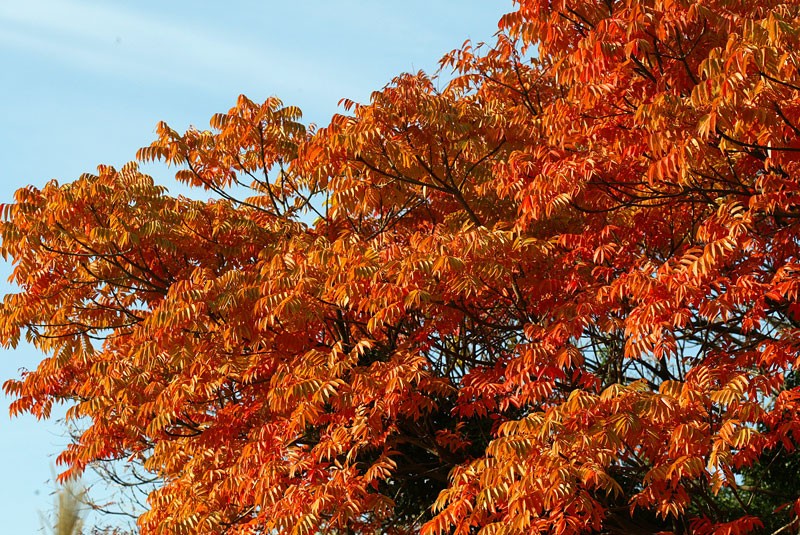
By Paul James
Here in our neck of the woods, we have dozens of great trees to choose from, both deciduous and evergreen. But there are three in particular that are as close to foolproof as you can get because they tolerate an incredibly wide range of soil conditions, are relatively pest and disease free, and are tough as nails. Oh and on top of all that, they’re beautiful.
First up is the Chinese Pistache (pictured above). Yes, it’s related to the tree that produces pistachio nuts, but unfortunately this one doesn’t produce those tasty treats. (Darn!) Chinese Pistache grows at a medium clip, and typically tops out at around 25-feet high and wide. It can get taller – up to 40 feet or more – but that’s the exception. Both male and female trees produce green panicles of flowers; females also produce small, inedible fruits that ripen in fall. Dark green leaves turn shades of yellow, orange, and red in fall, and as it matures, its gray-brown bark often peels away to reveal a salmon-colored inner bark.
Although it’s native to China, Taiwan, and the Philippines, this tree loves Oklahoma. In fact, I wouldn’t be surprised if it naturalizes here some day.
Next is the Shumard Oak, one of the best red oaks ever for Green Country. It’s a pretty fast grower when young, and generally grows to about 40-feet tall. Given plenty of room, it can ultimately reach 60, even 80 feet or more. It maintains a pyramidal shape for many years, then spreads to form a broad, open crown. Its shiny, dark green leaves turn a reddish orange in fall. This tree is native to our area, in particular moist locations in low spots and along streams, lakes, and swamps. Thankfully, however, it adapts quite nicely to dry sites.
And last but hardly least is the Lacebark Elm. Another Chinese native that is perfectly at home in Oklahoma, this baby will grow to about 40 to 50 feet in as many years, but generally hovers around 25 to 30 feet in most landscapes. It’s a quick grower with small green leaves that turn yellow in fall. My favorite feature of this tree is its exfoliating or peeling bark, which flakes to reveal patches of gray, cream, orange, and brown.
Of course, there are lots of other trees to choose from, and I’ll feature three lesser-known choices next week. In the meantime, remember: If you’ve been contemplating a new tree on your property, the time to plant is now.
The Secret to Successful Gardening
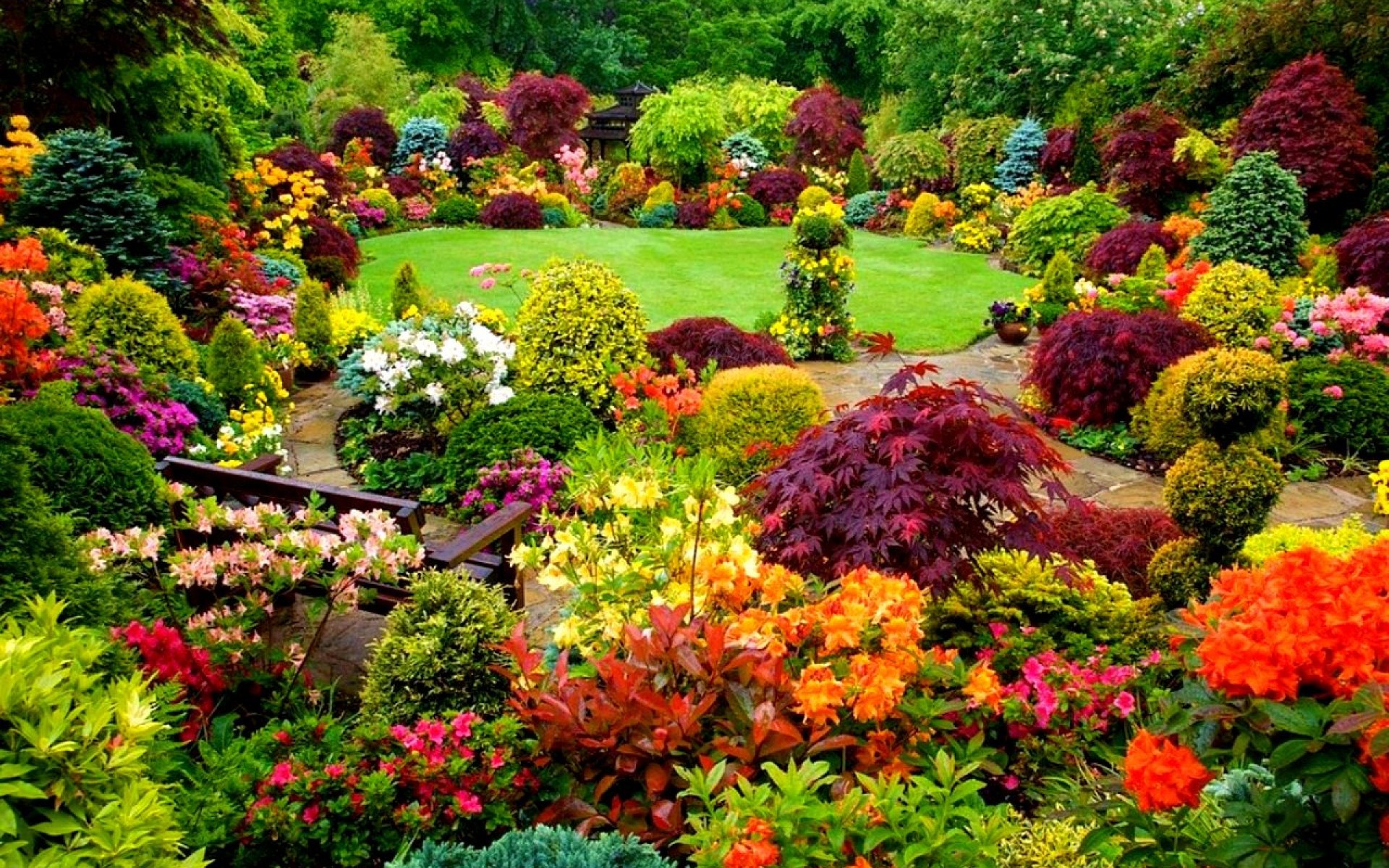
By Paul James
Imagine being able to add something to your garden that makes plants far less susceptible to insects and diseases, provides essential nutrients and micronutrients, improves soil structure and water retention, activates beneficial soil microbes, and basically provides the perfect growing conditions for anything and everything you grow. Now imagine that “something” is free.
I’m talking about compost, the secret to successful gardening if ever there was one. And I can say with absolute certainty that if you’ll routinely add compost to your trees, shrubs, annuals, perennials, vegetables – even plants in containers – you’ll discover a real difference in the health of your plants. You’ll discover that you can grow plants with less fertilizer — because compost is the perfect food for plants — and fewer pesticides — because genuinely healthy plants have the ability to resist pests and diseases. You’ll discover that even heavy, compacted soils become lighter and looser. You’ll discover that you’ll water less often. And you’ll discover that your once sterile soil is teaming with all sorts of critters, especially earthworms.
Still not convinced? Then take a walk in the woods. Notice how healthy everything is, from the trees above to the shrubs and thickets below to the grasses and flowers on the forest floor. Then notice the accumulation of leaf litter and other organic matter on the ground. That’s compost, plain and simple. And that’s nature’s way of keeping everything in perfect harmony.
You can mimic nature’s way by purchasing composted products or by starting a compost pile at home. And to learn how to do just that, join me this Saturday morning at 10:00 for a free seminar titled “Compost is King.” Please register in the Events tab.
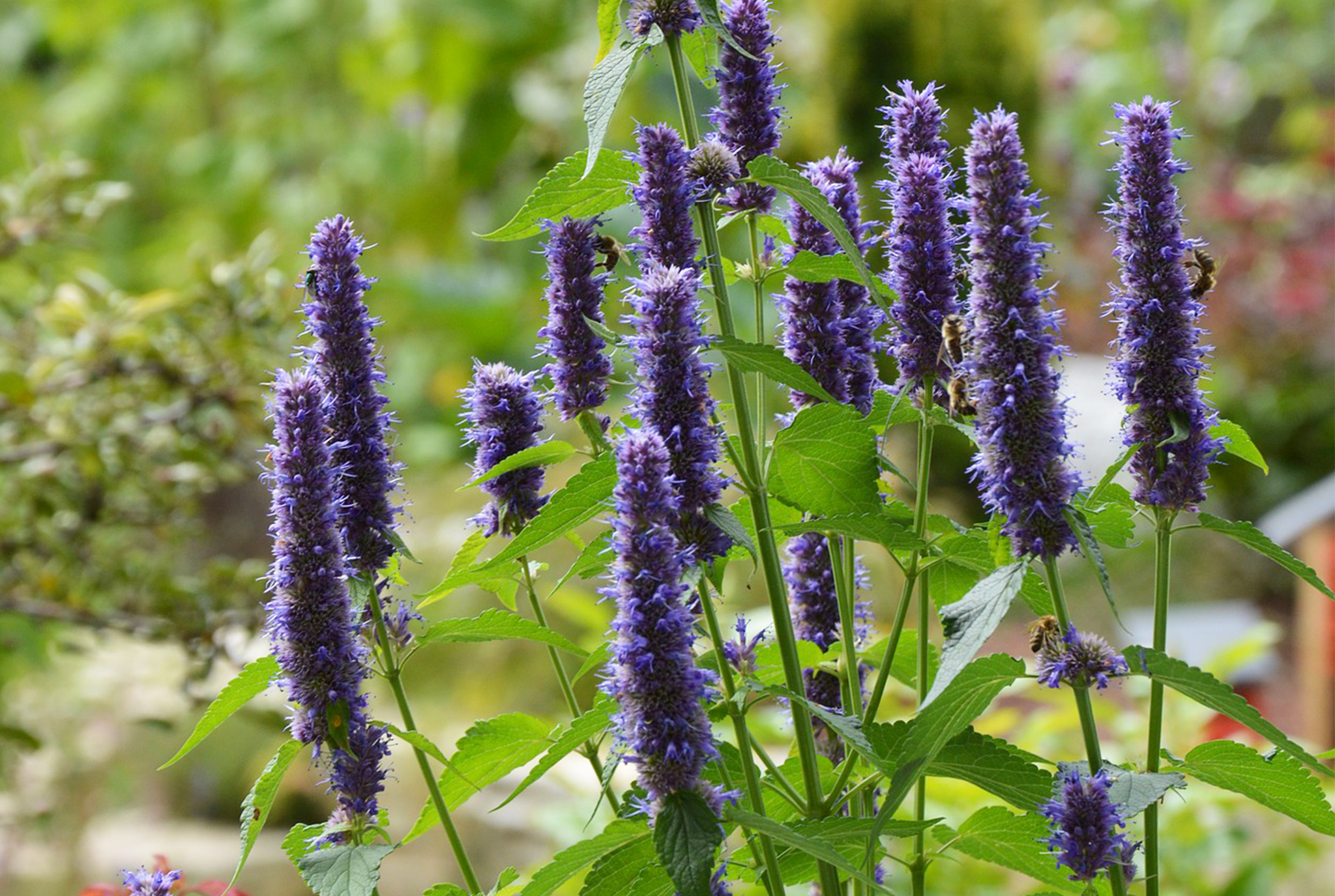
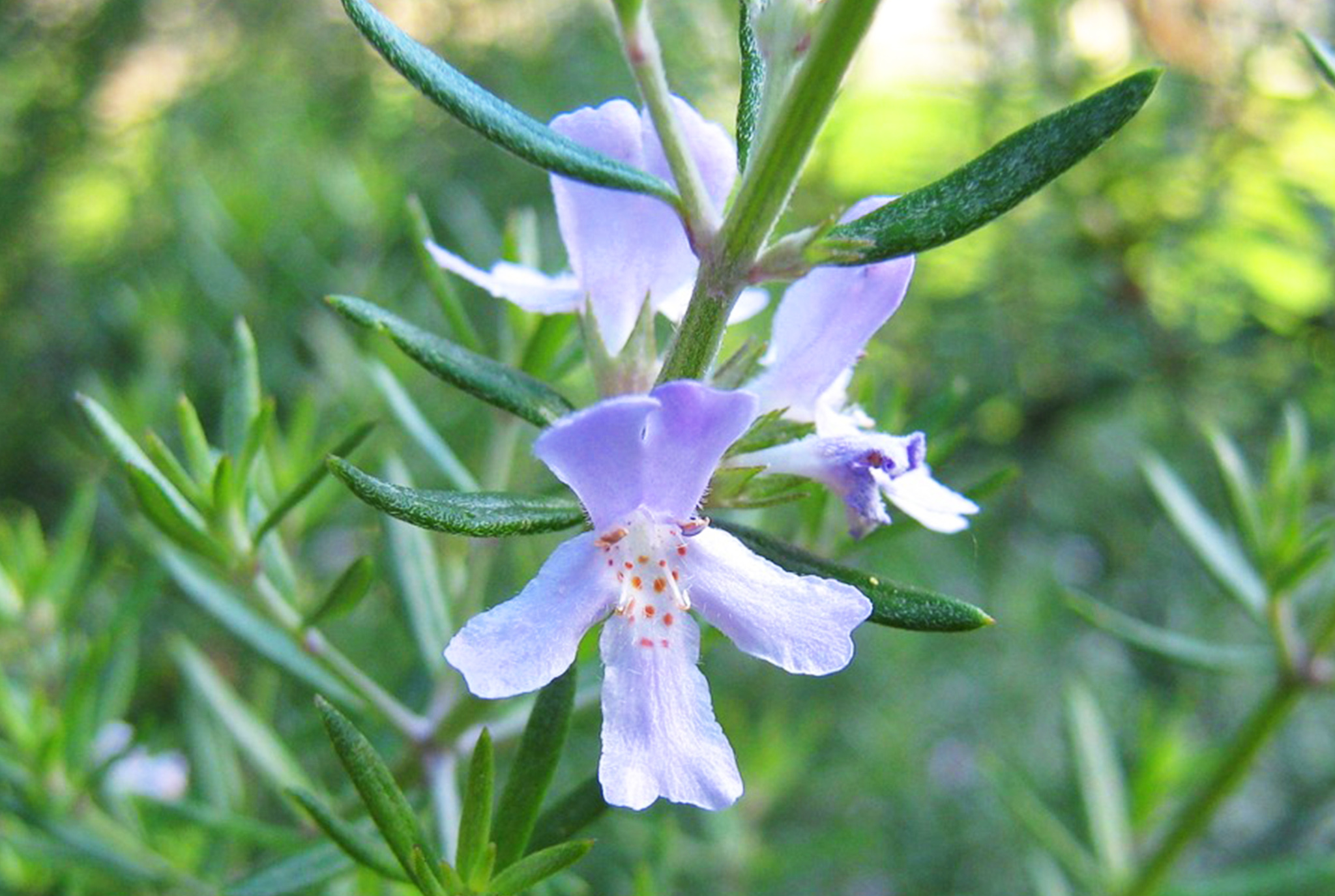

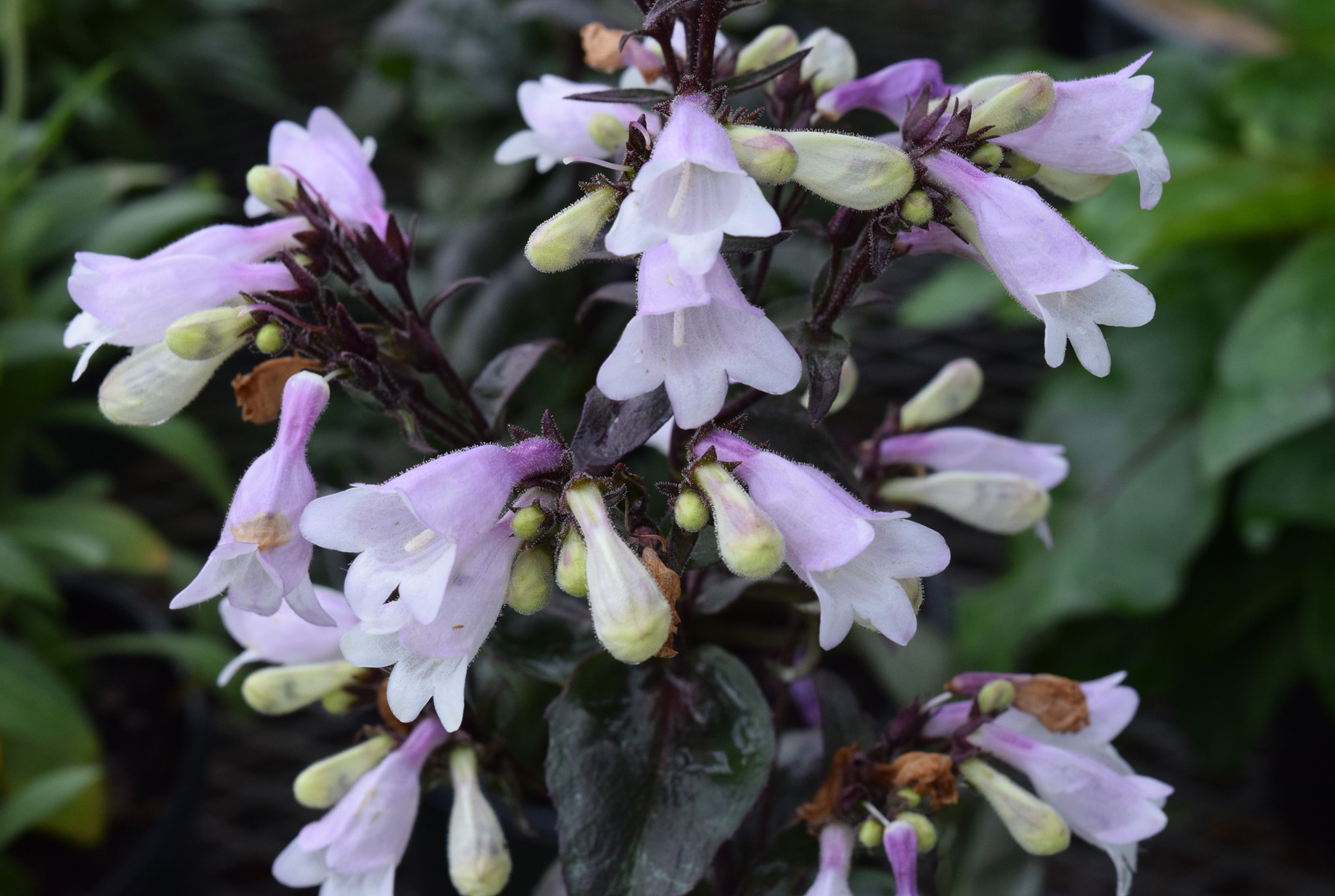
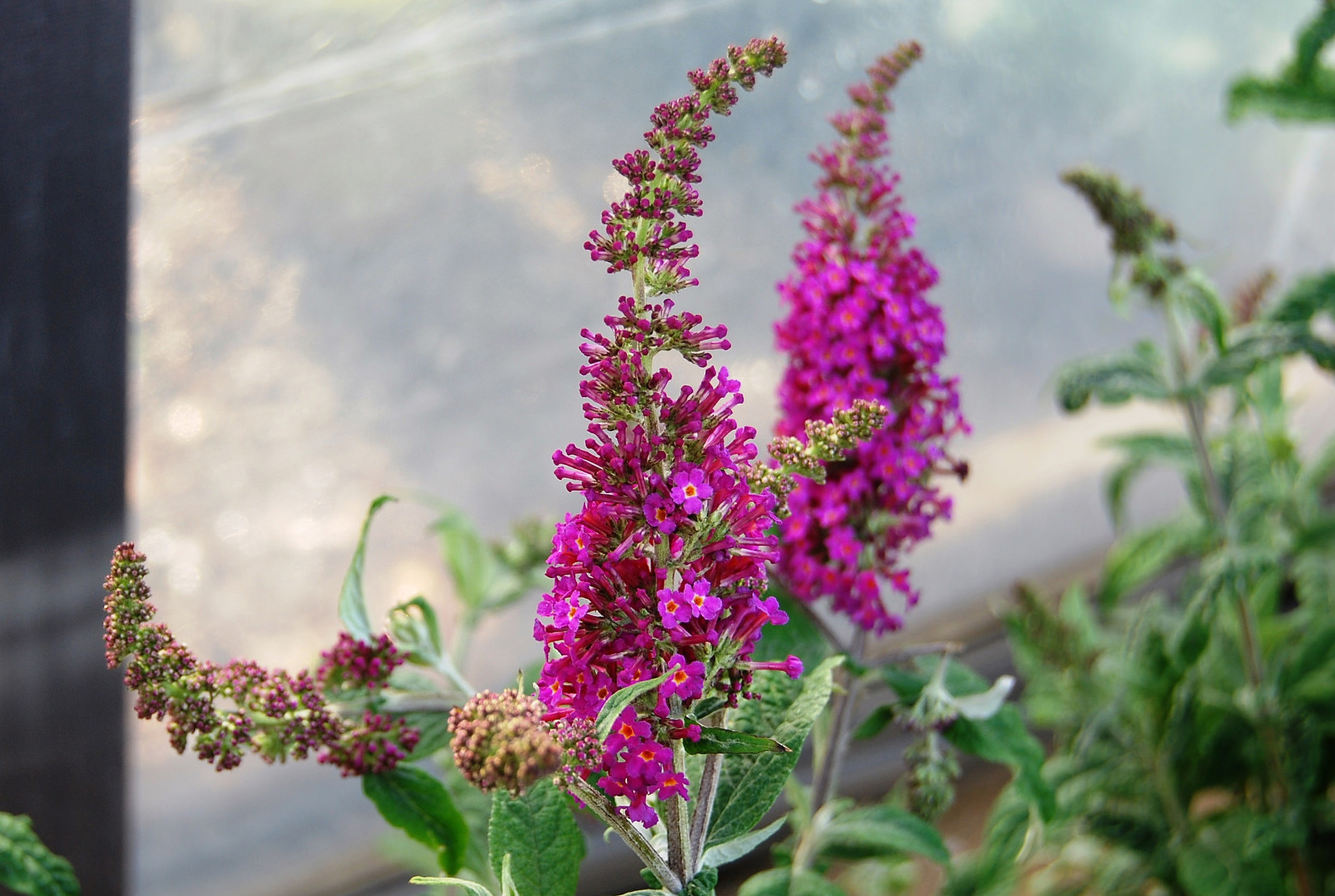


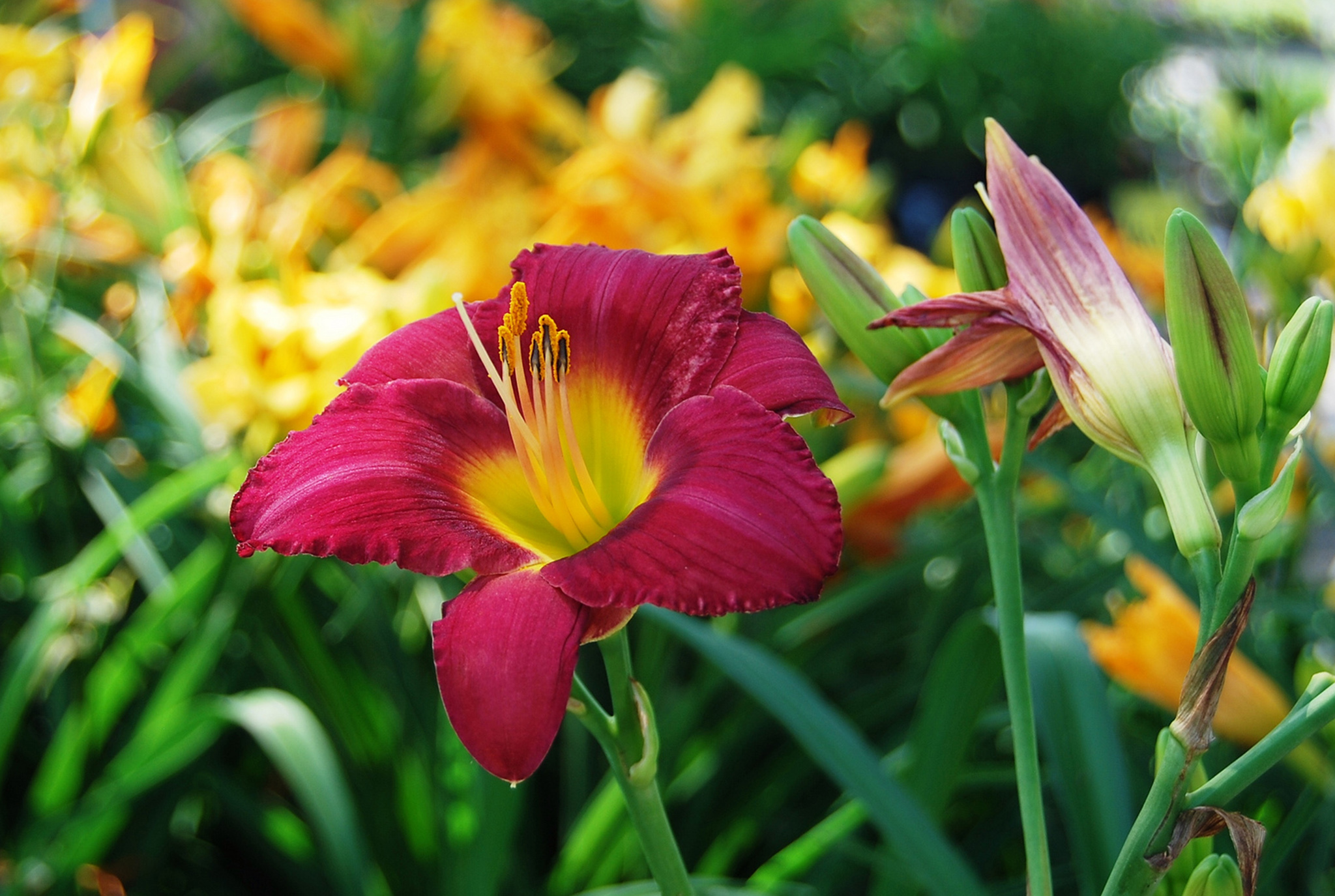







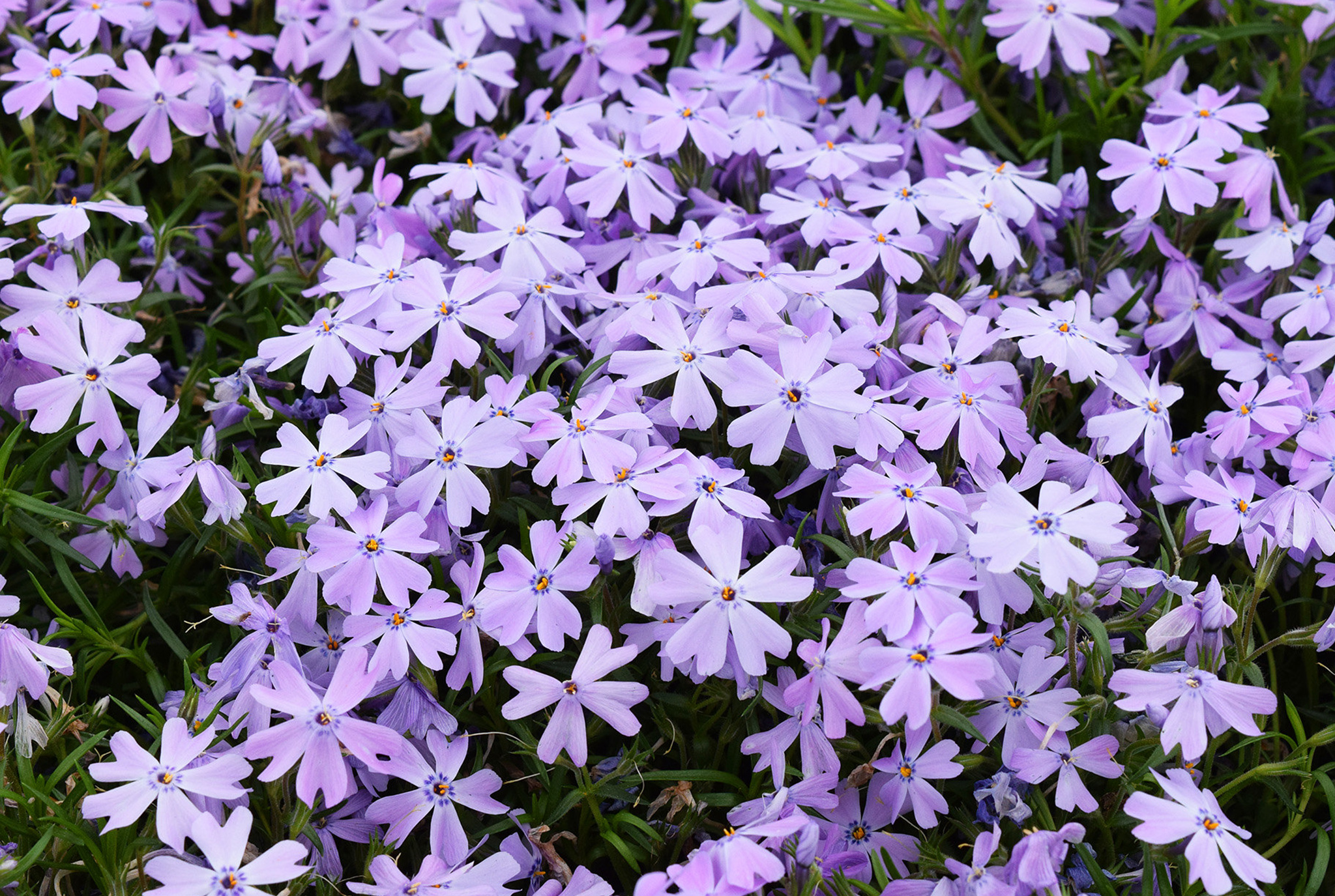
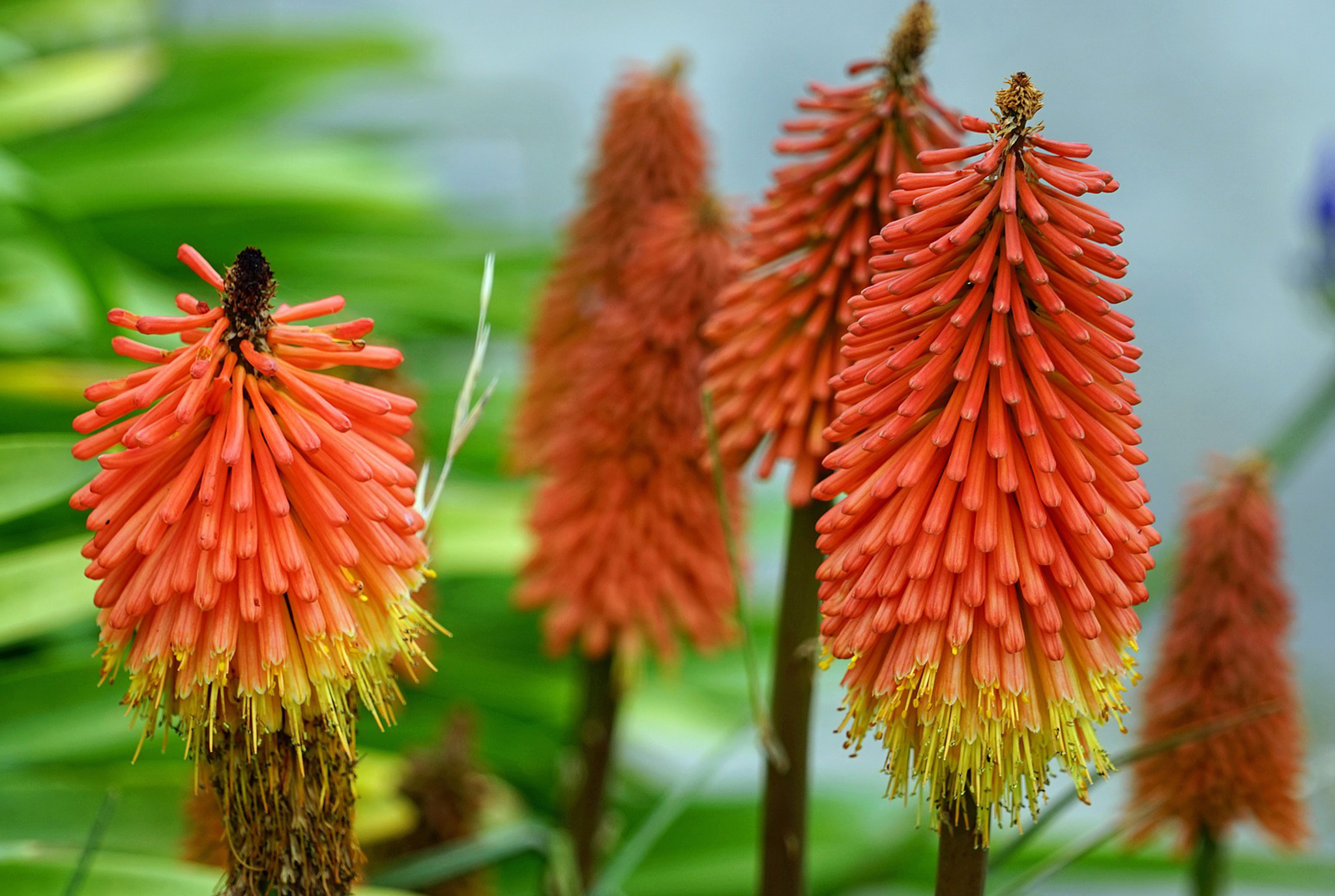


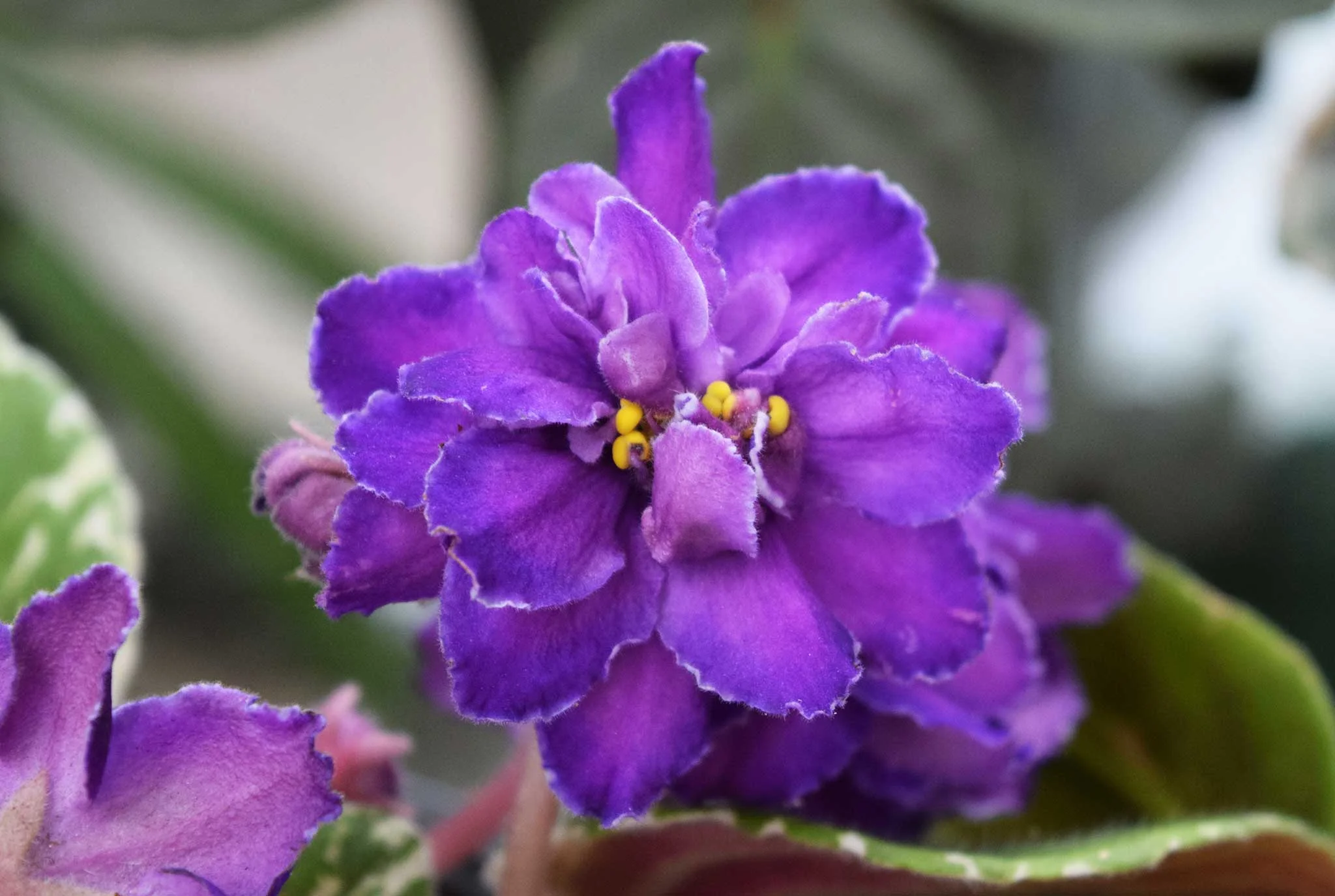




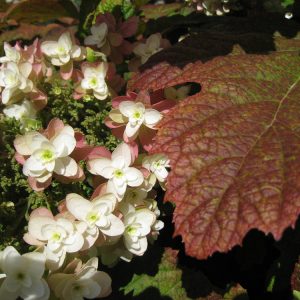
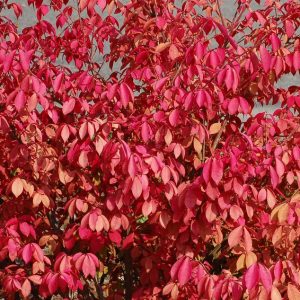
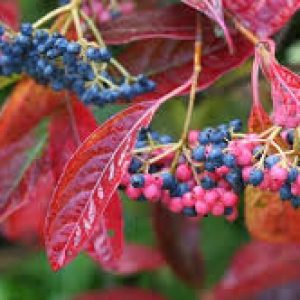
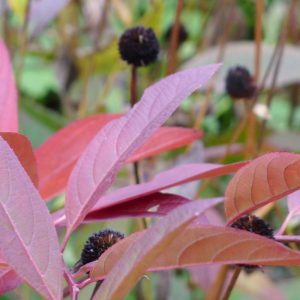
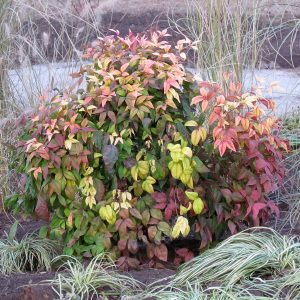
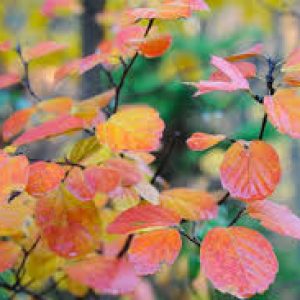
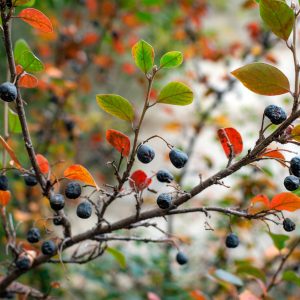
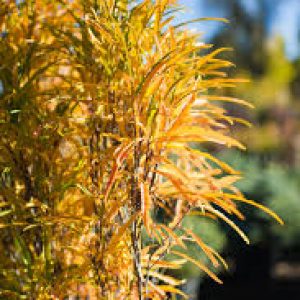
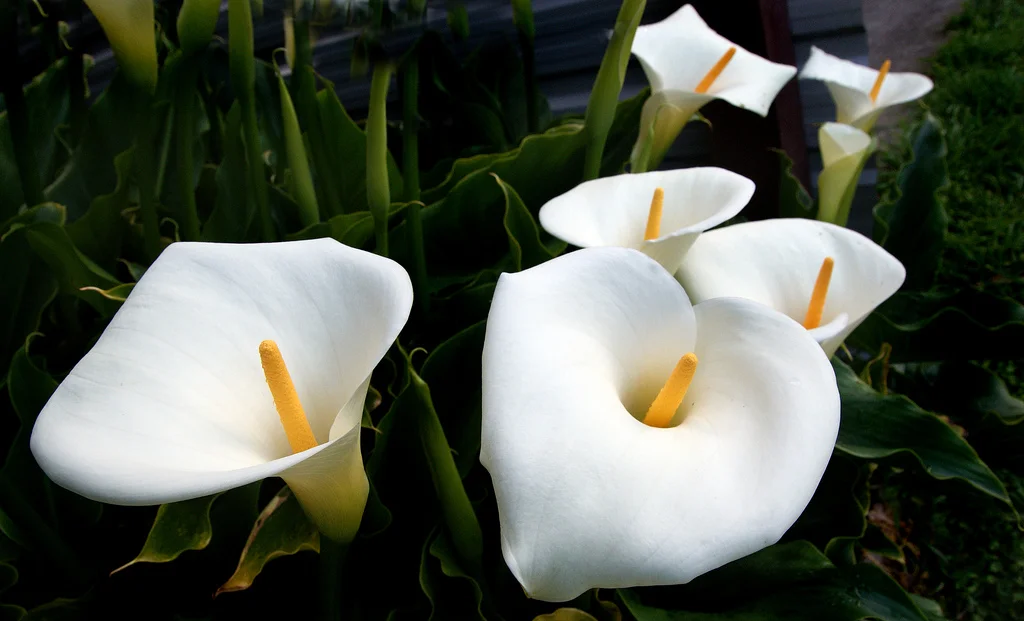
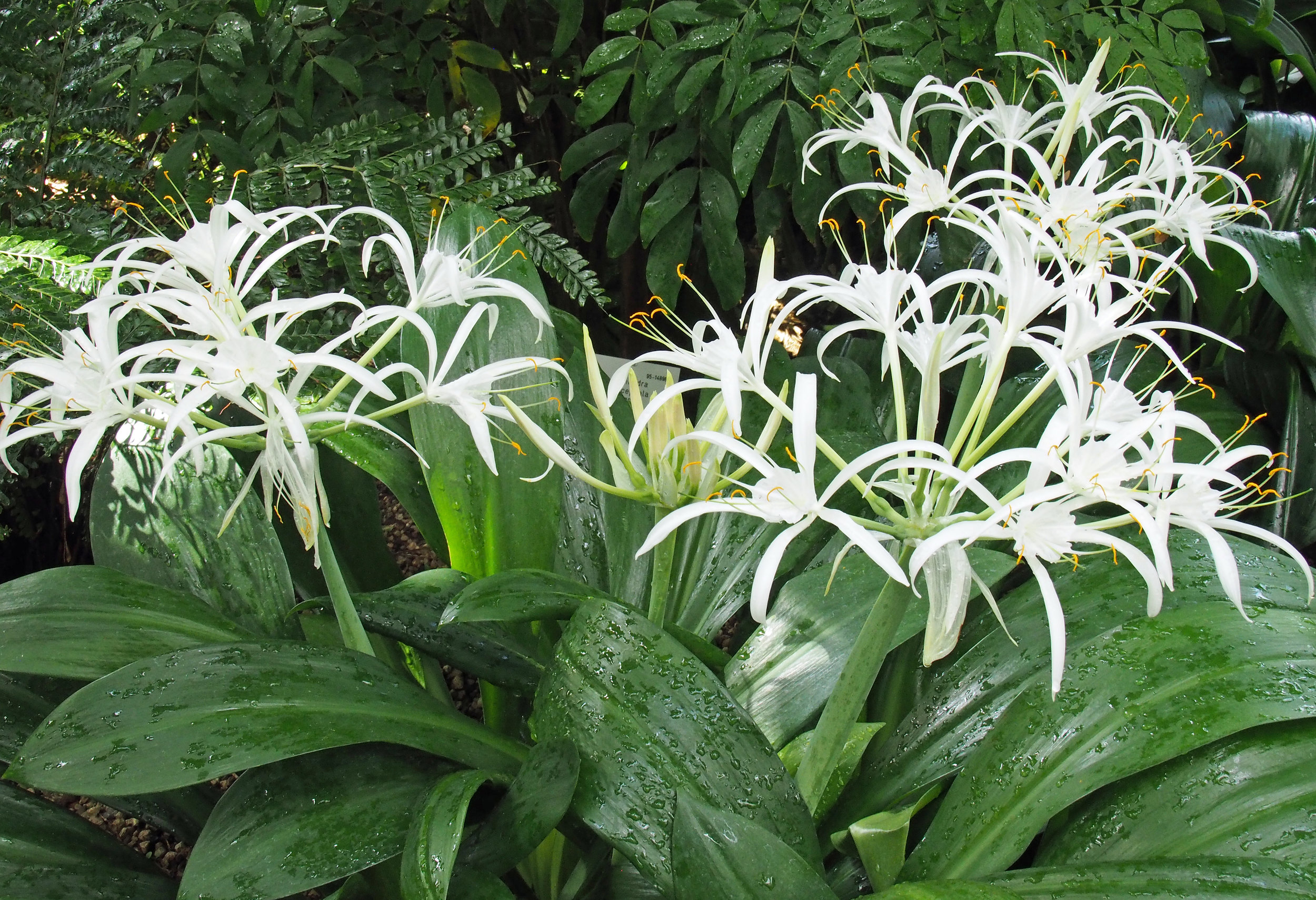


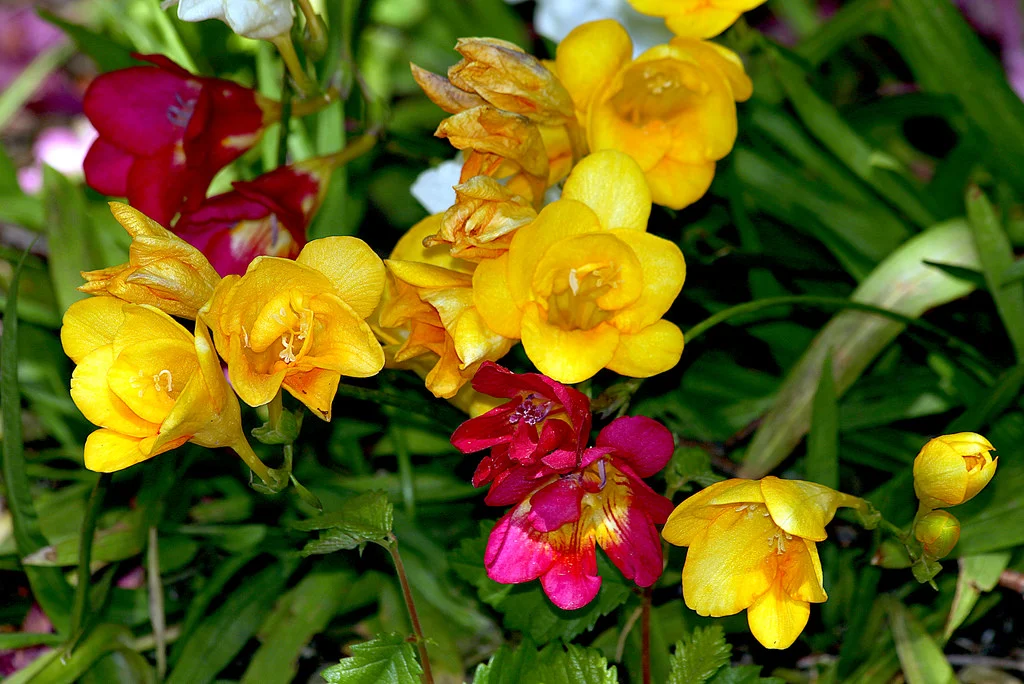


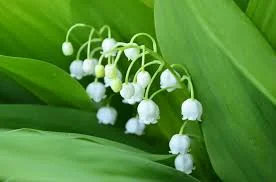








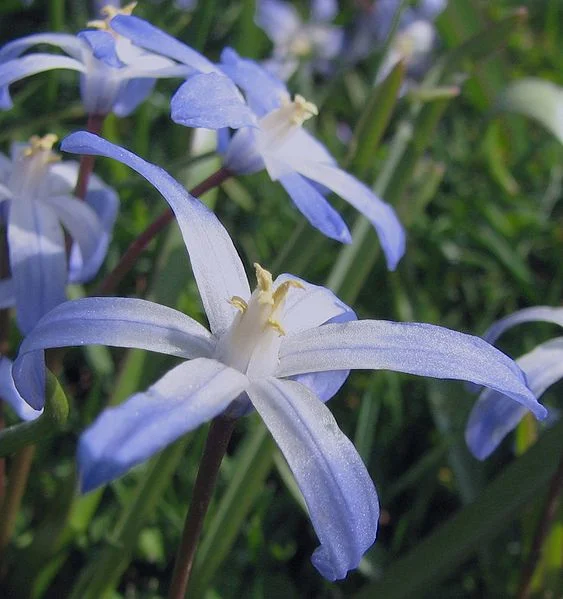


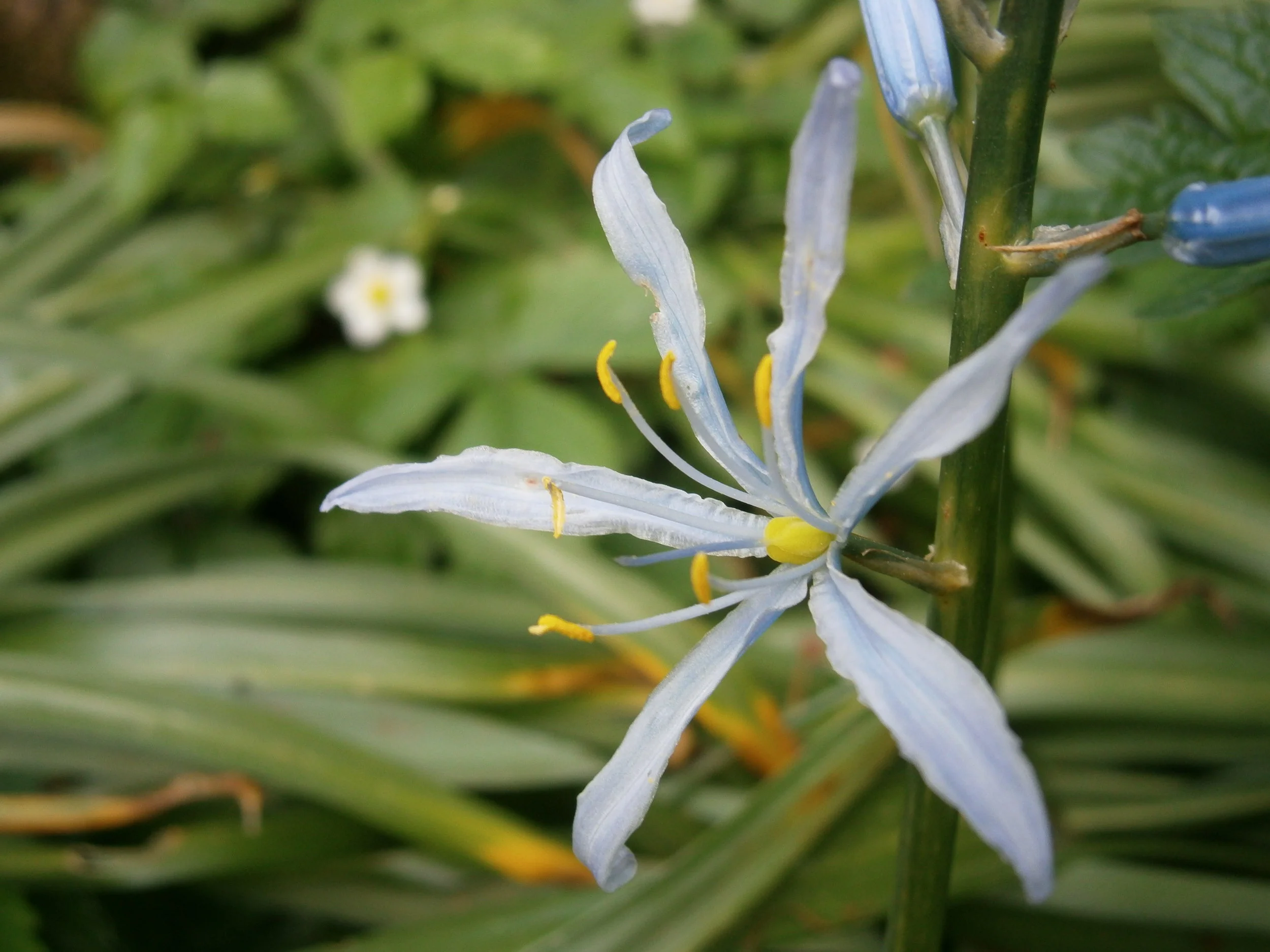
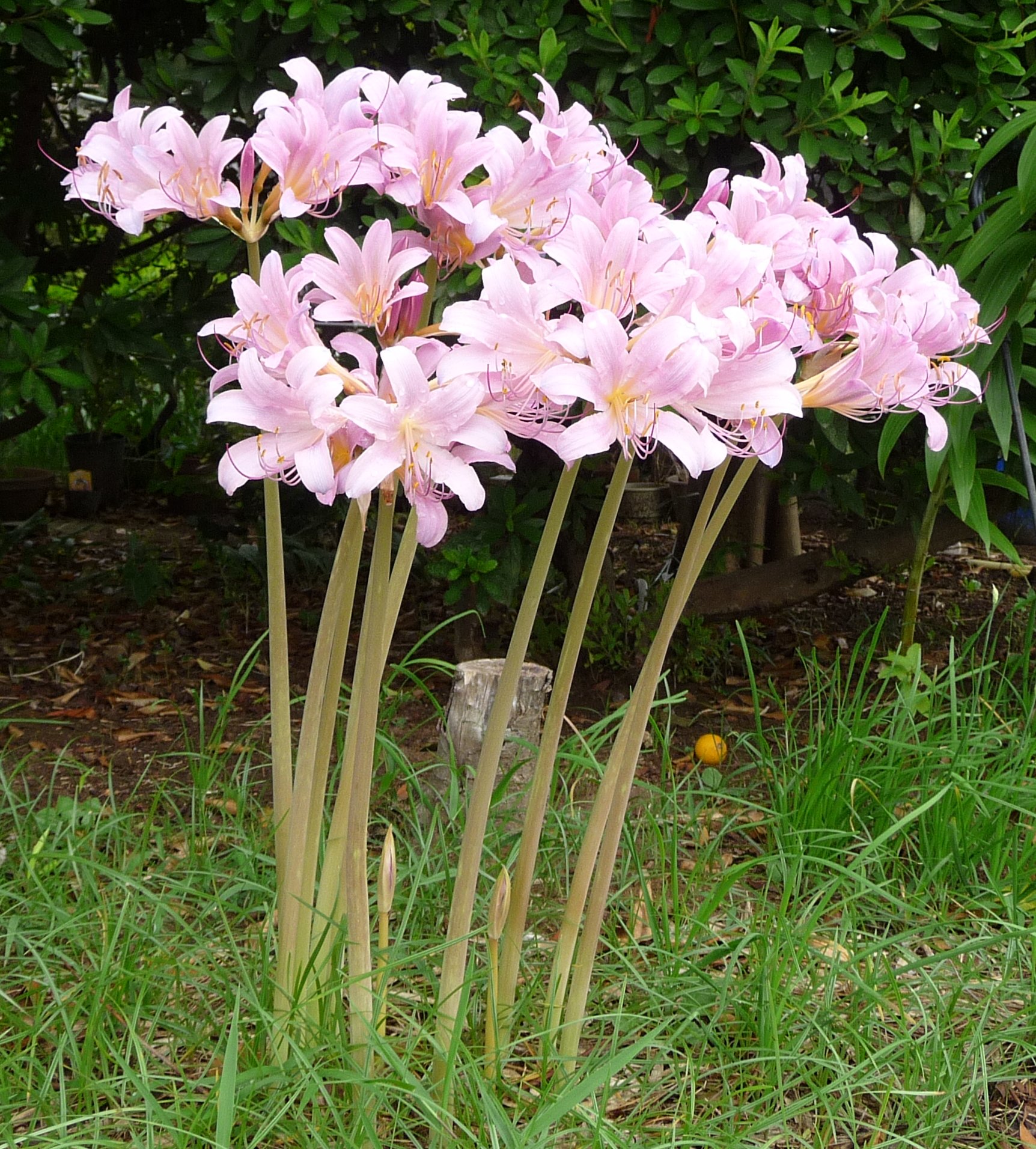


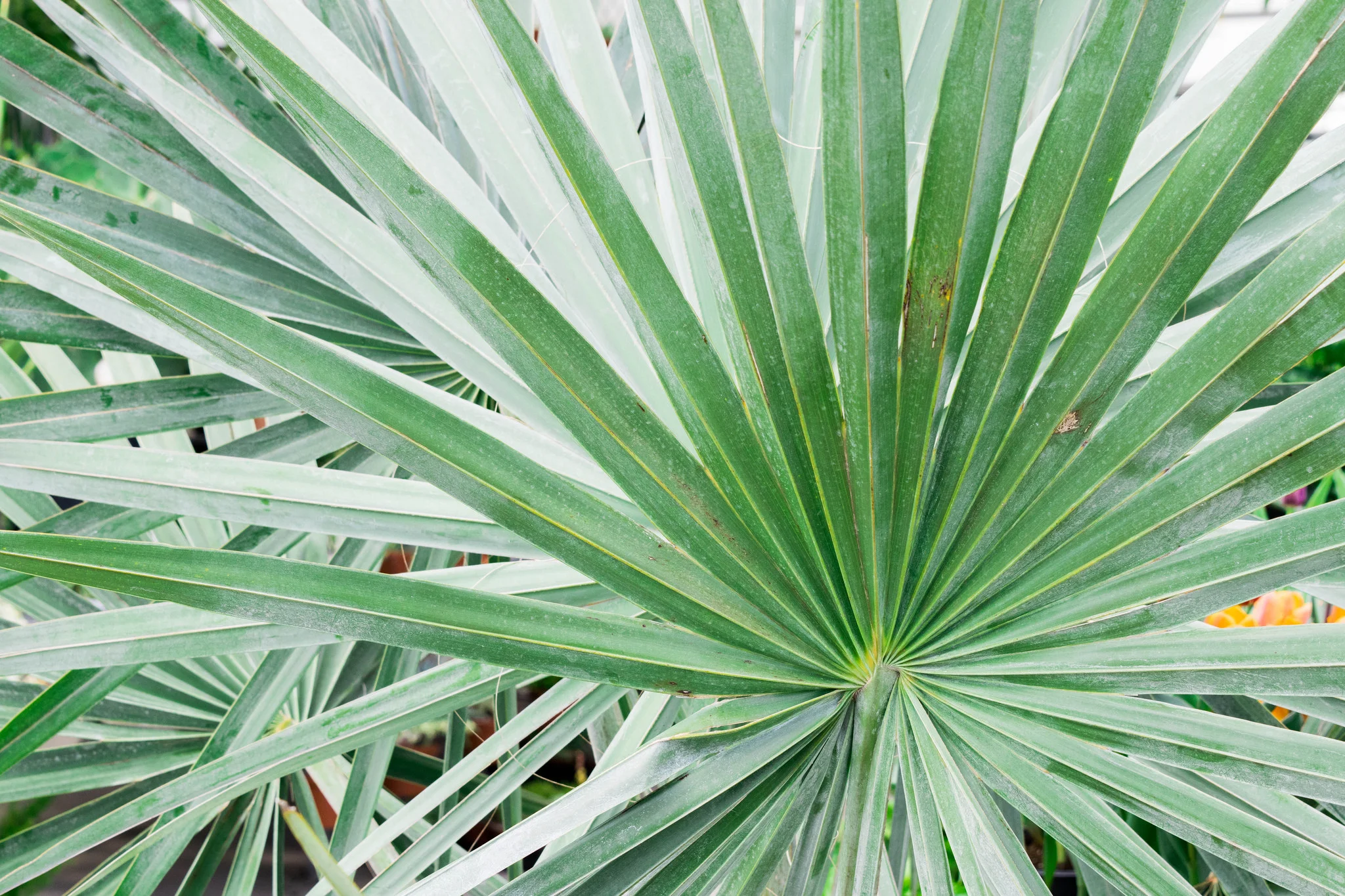











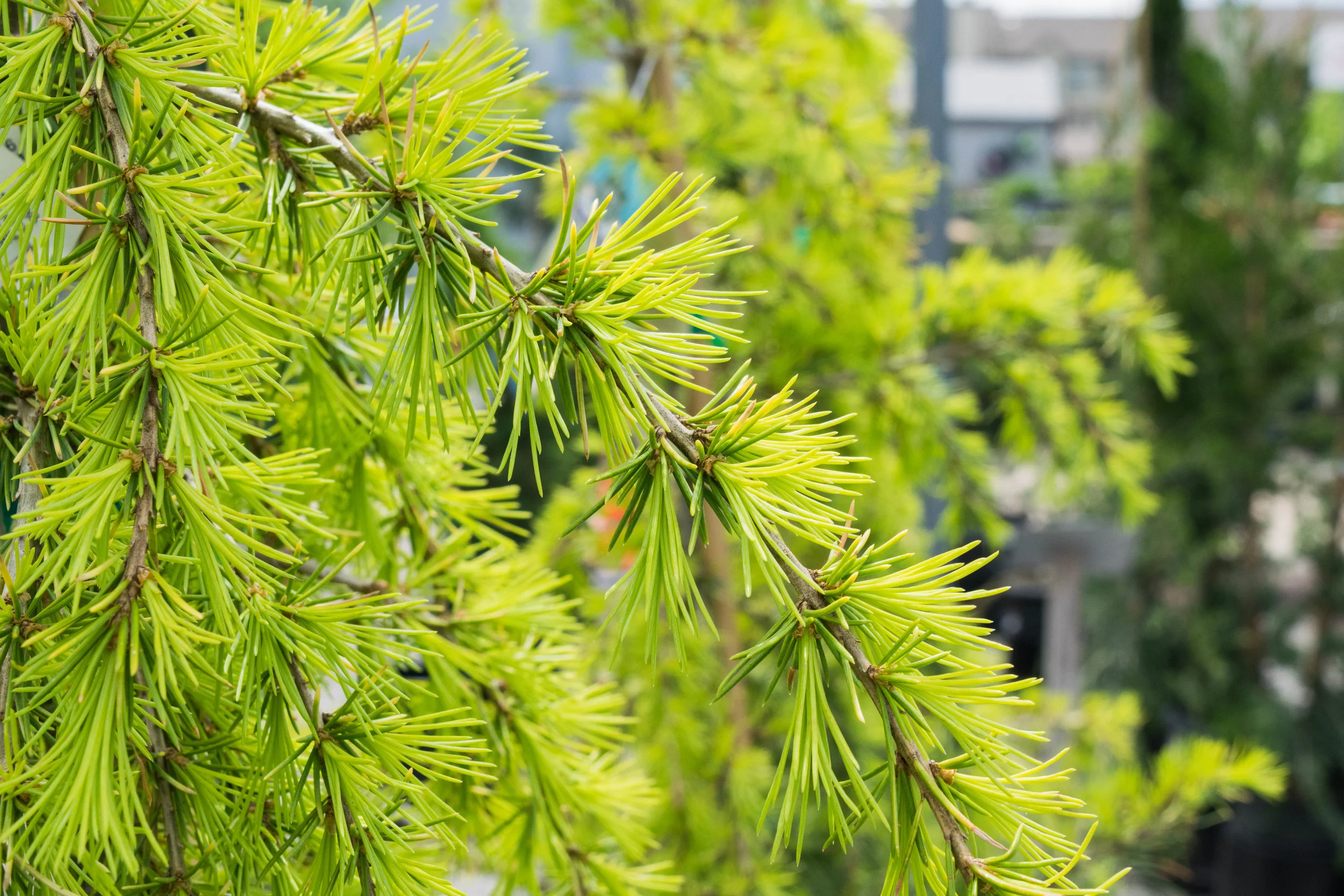

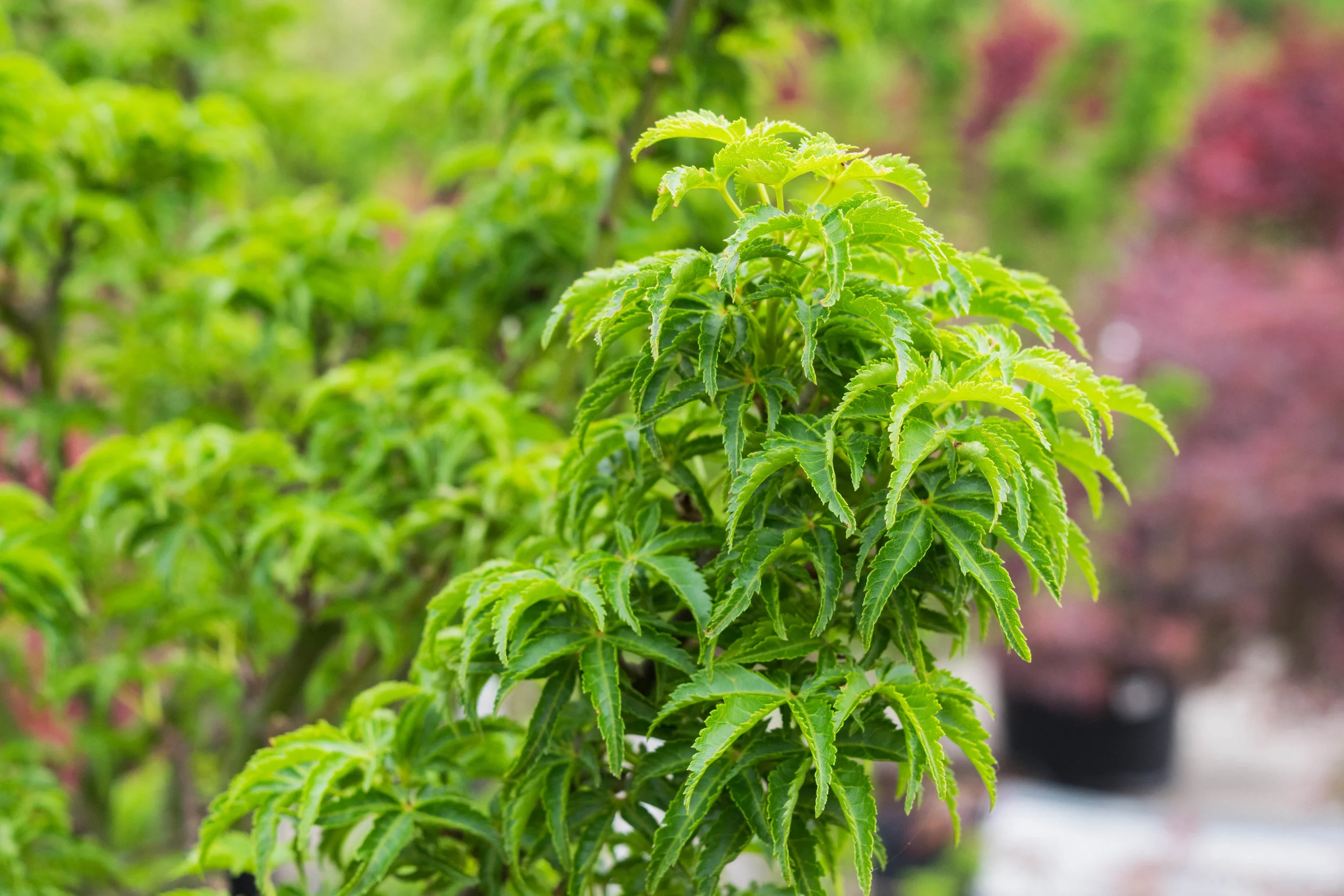
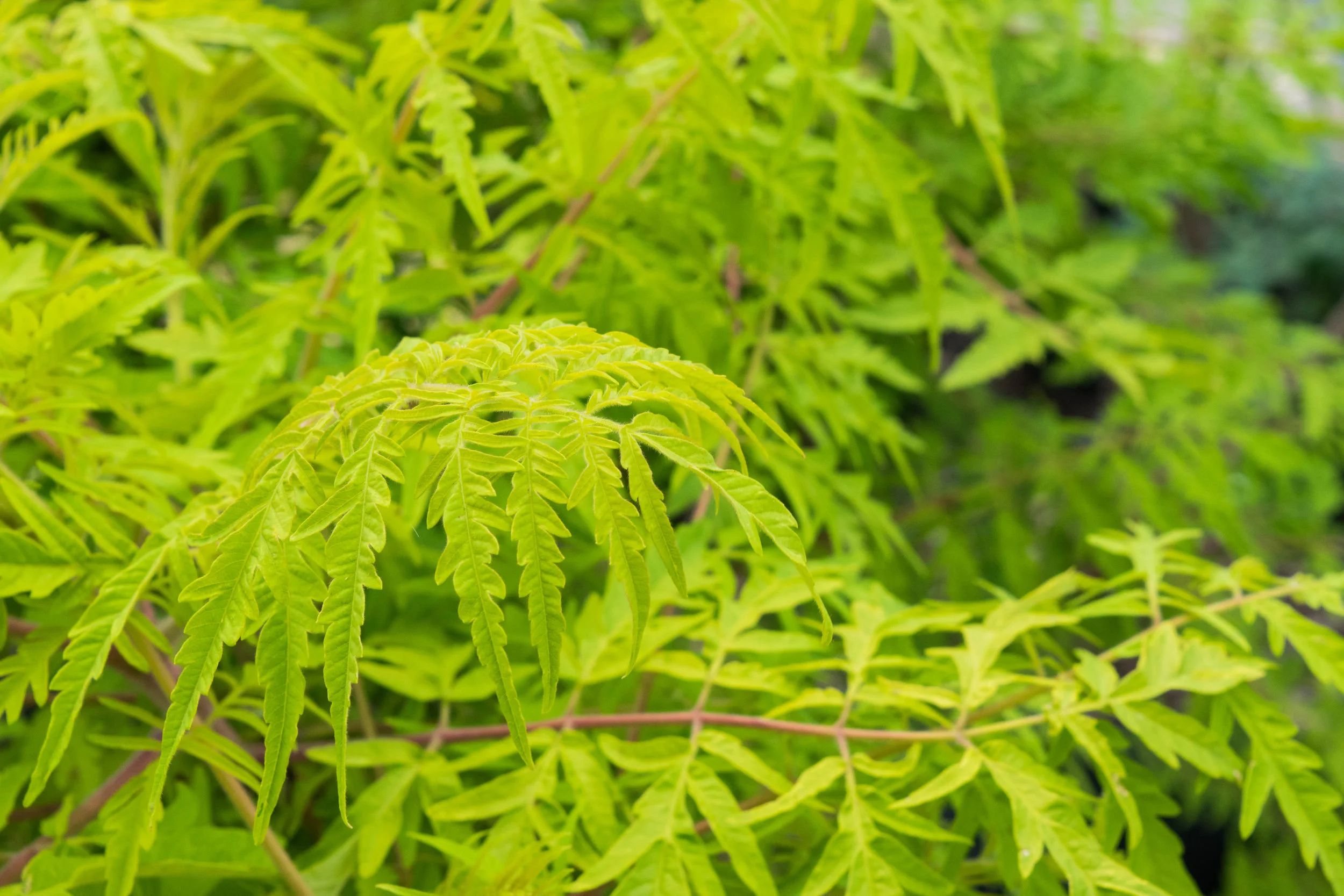

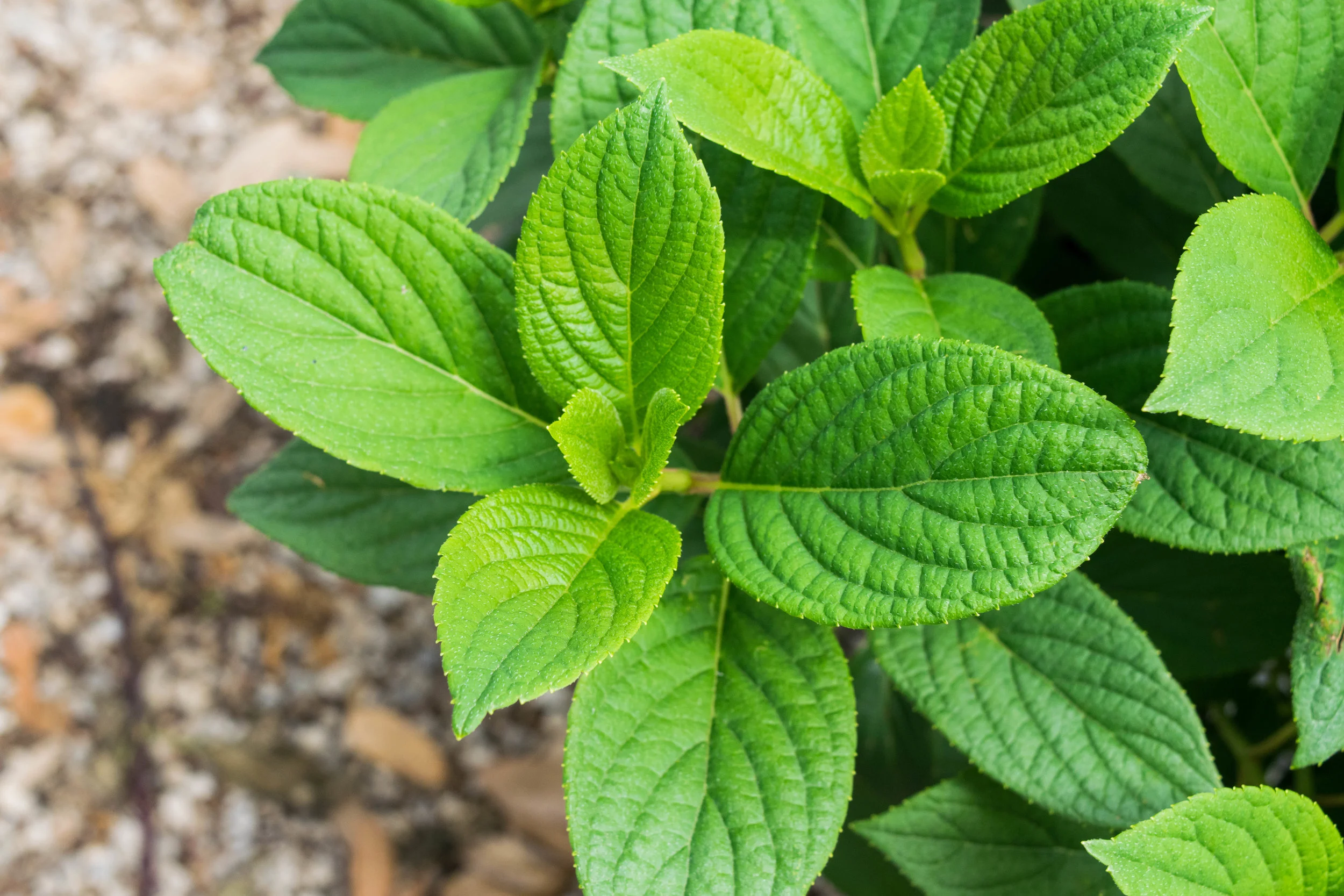
Related to Gladiolus, but different enough to deserve their own name, even if it is a mouthful. White, hauntingly fragrant flowers appear above graceful, sword-like foliage. Plant in full sun.